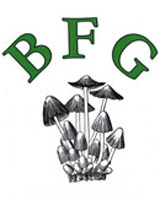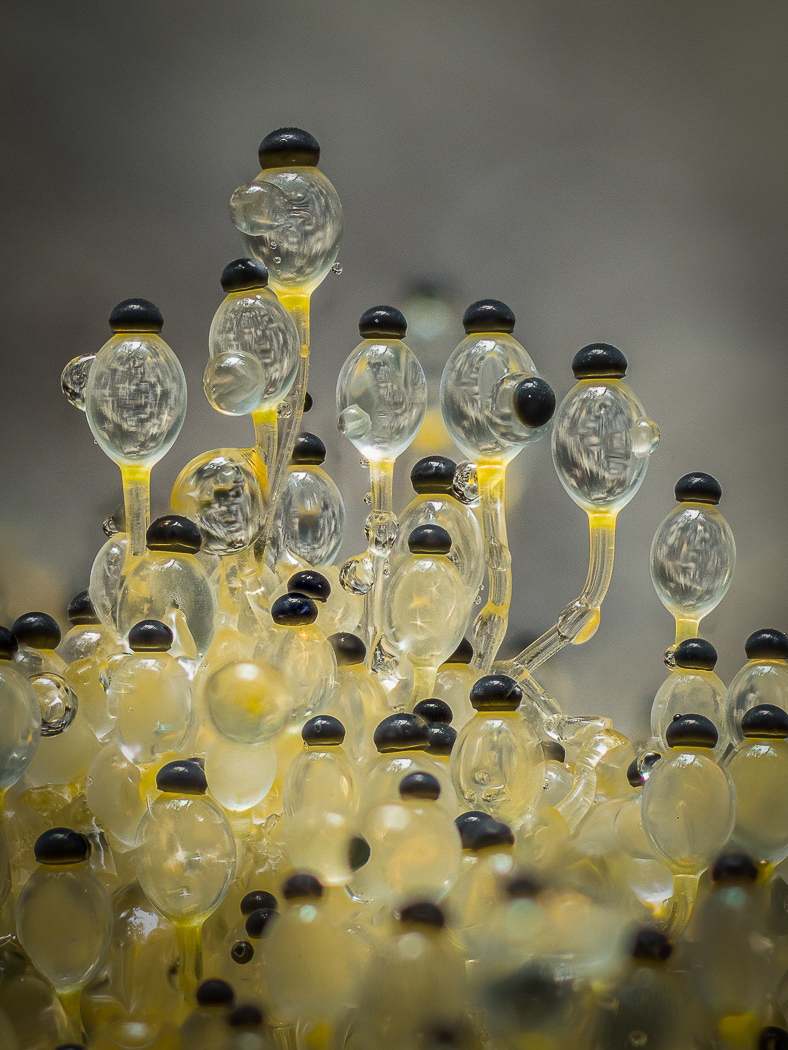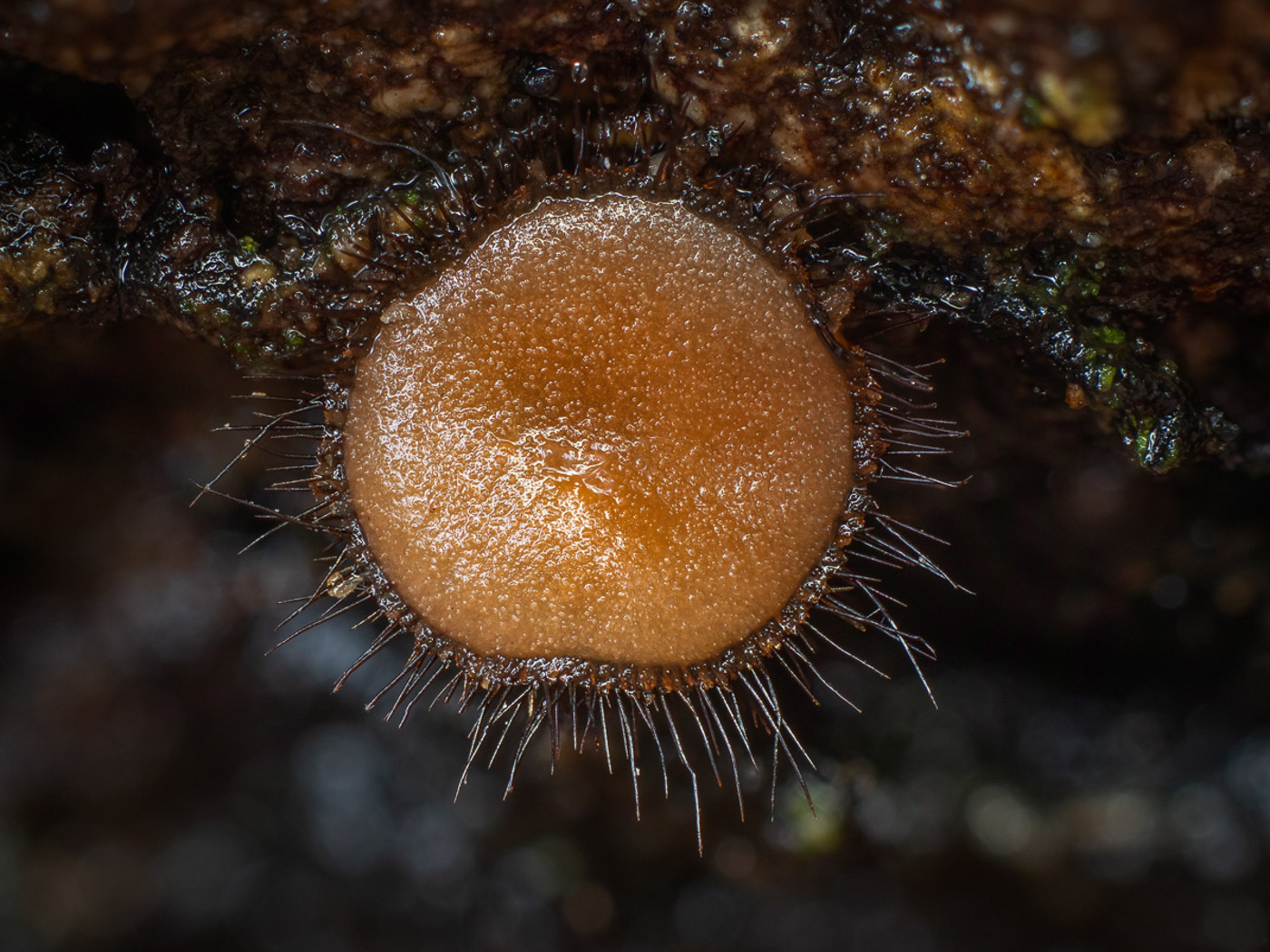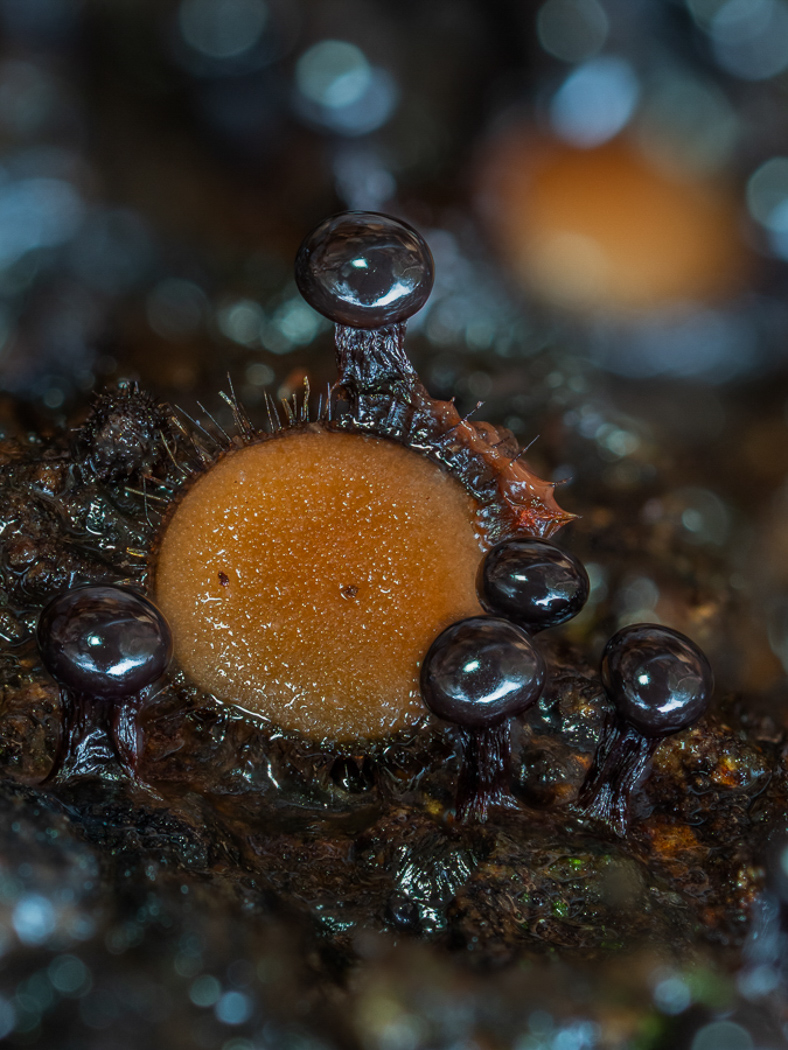A
|
|
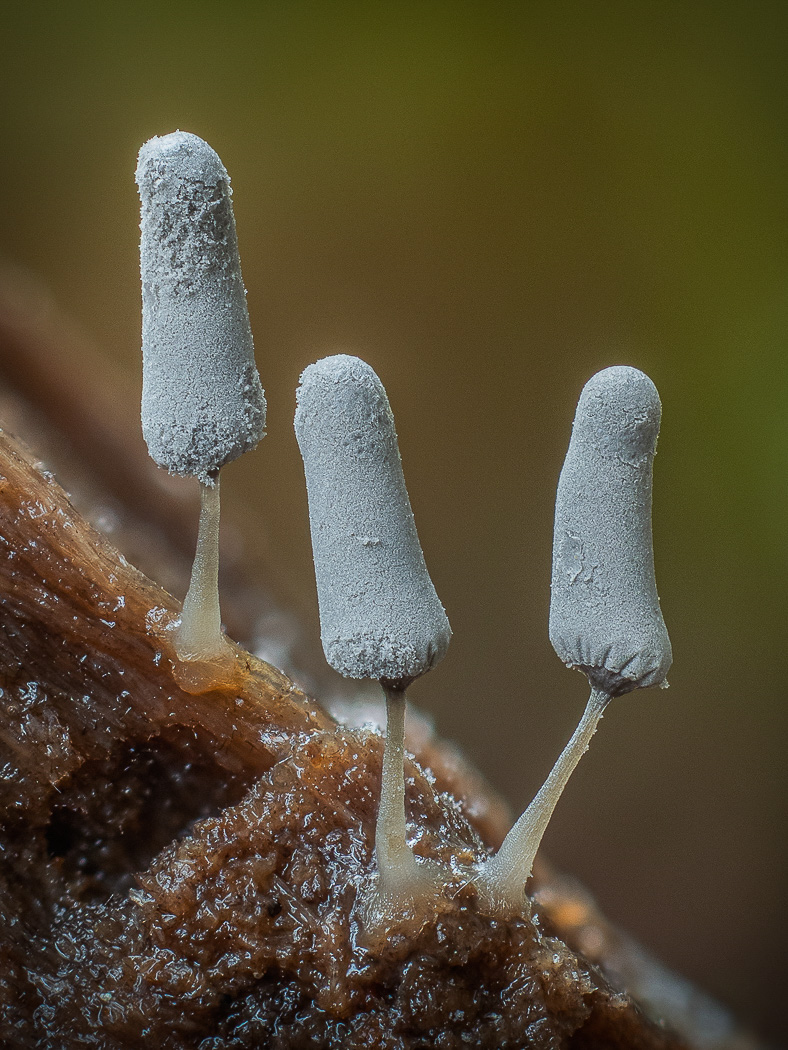
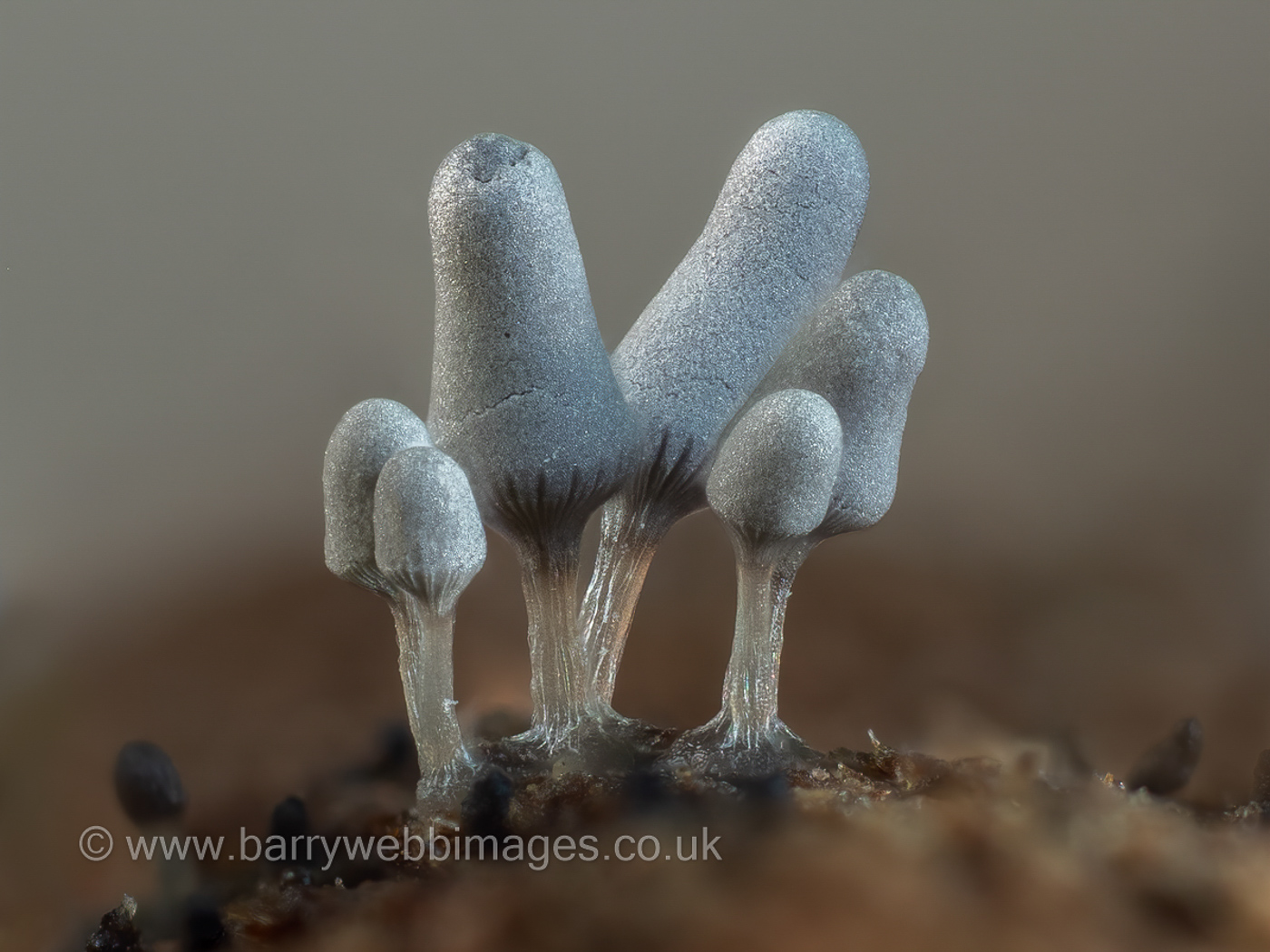
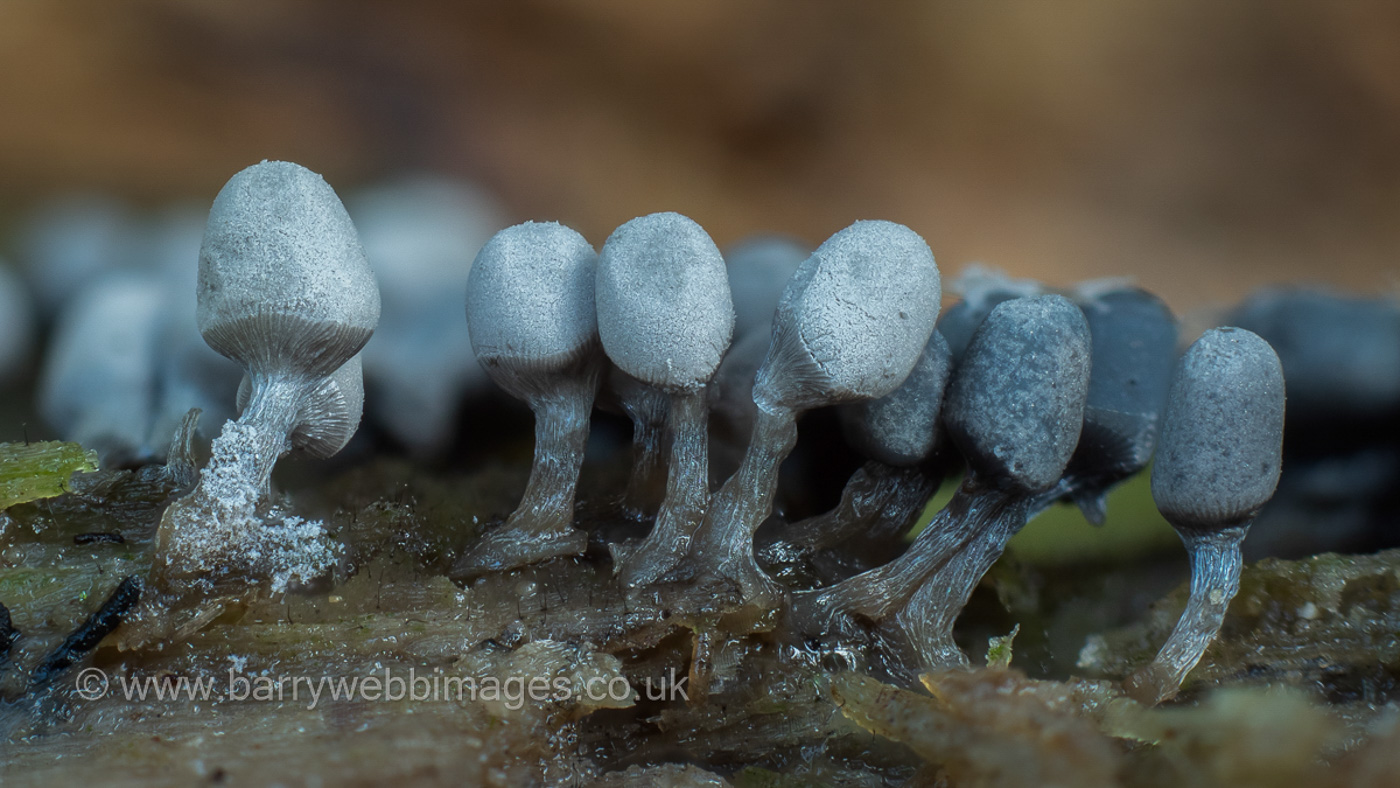
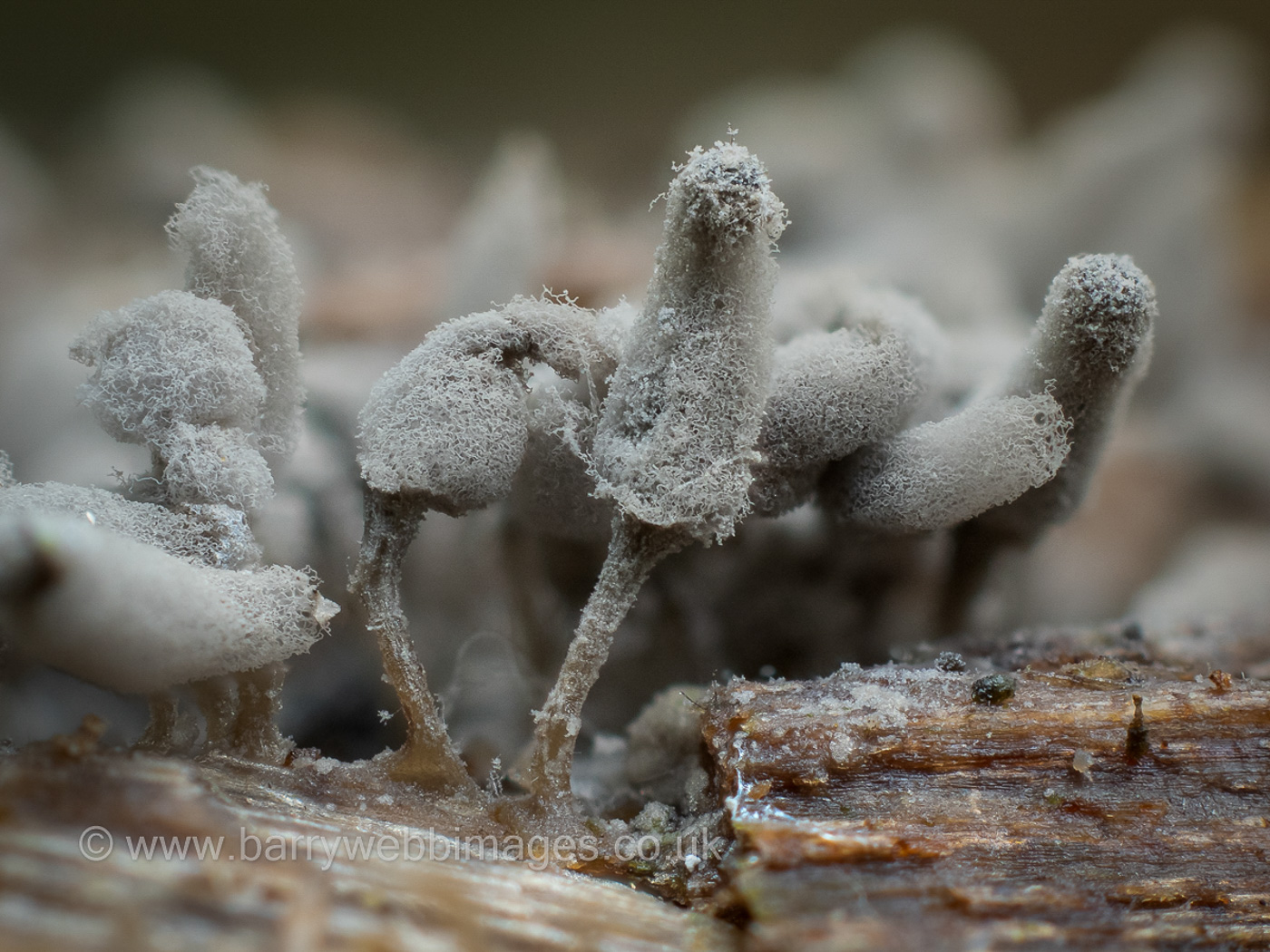 |
Arcyria cinerea (a Slime Mould with no common name)
Aug 19, 2020. Barry found this quite common species in Burnham Beeches on fallen Birch. Arcyria is an attractive and distinctive genus, producing sporangia shaped like tiny loofahs on stalks though their plasmodium - mostly patches of white sticky blobs like many slime mould genera - gives away nothing of its final shape once it matures. This particular species is unique within the genus being off white to pale grey when mature - hence its species name and making it an easy one to recognise in the field. Photo 2 is of a collection made at the same site the following year (10.06.2021). Photos 3 and 4 are of collections made at Bernwood Forest (29.08 2021) showing both immature and mature examples.
|
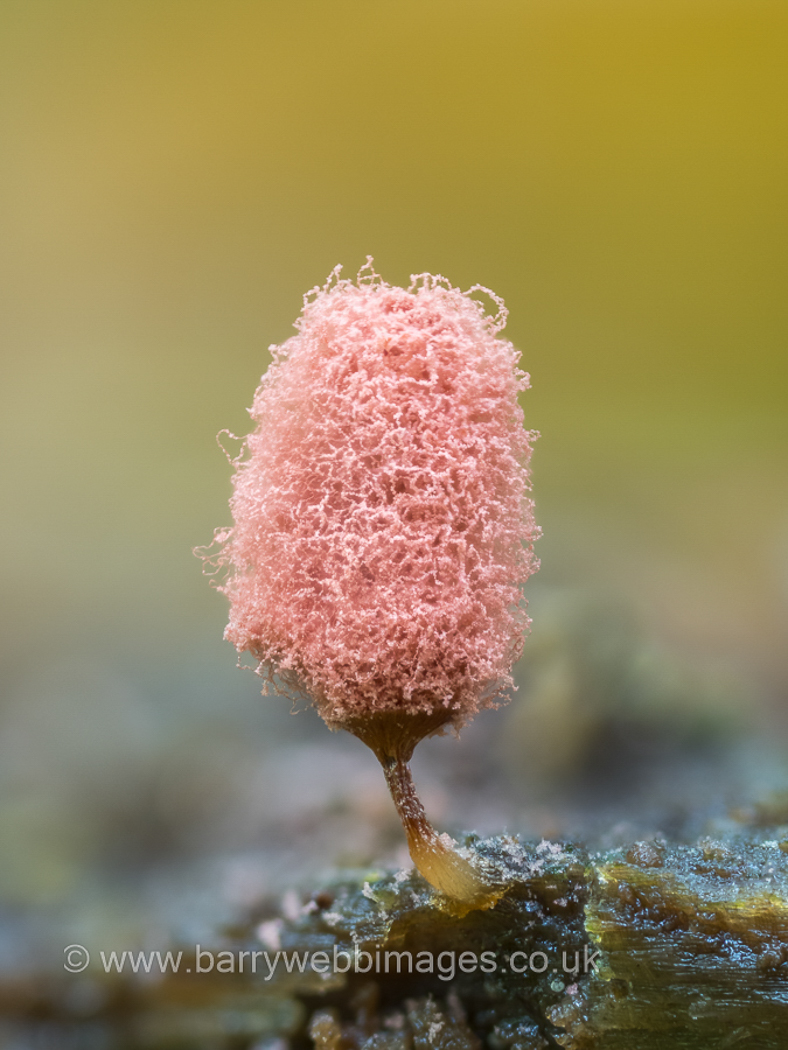
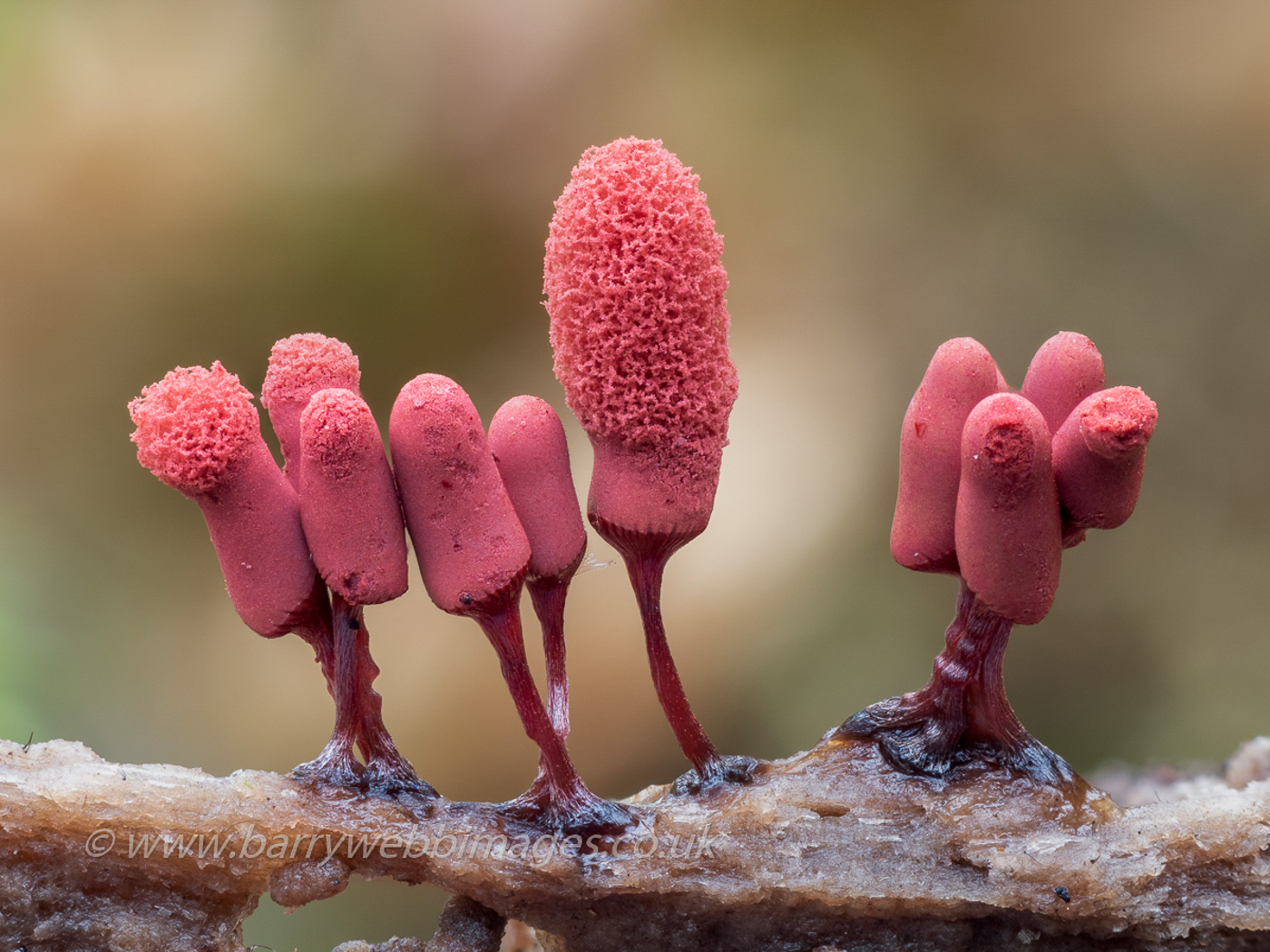
|
Arcyria denudata (a Slime Mould with no common name)
Jul 26, 2023. In Burnham Beeches Barry Webb found this little beauty on some very wet soggy rotten wood. The species is quite common if you know where to look and are prepared to search for tiny things with a x 10 lens and a torch!
Oct 12, 2020. This stunning photo was taken by Barry Webb of a collection on fallen Beech in Burnham Beeches. Like most Slime Moulds, this species starts out as a cluster of slimy white blobs (the plasmodium stage) when identification even to genus is not possible. As it matures it dries off and forms these remarkable miniature 'loofahs' on shiny red stalks, the whole being 6 mms high at most! There are quite a few species of Arcyria, some rare, some common as is this one, but none are quite so eye-catching. Note how the stalk develops into a cup which supports the spore mass column, seen here in various stages of maturity.
|
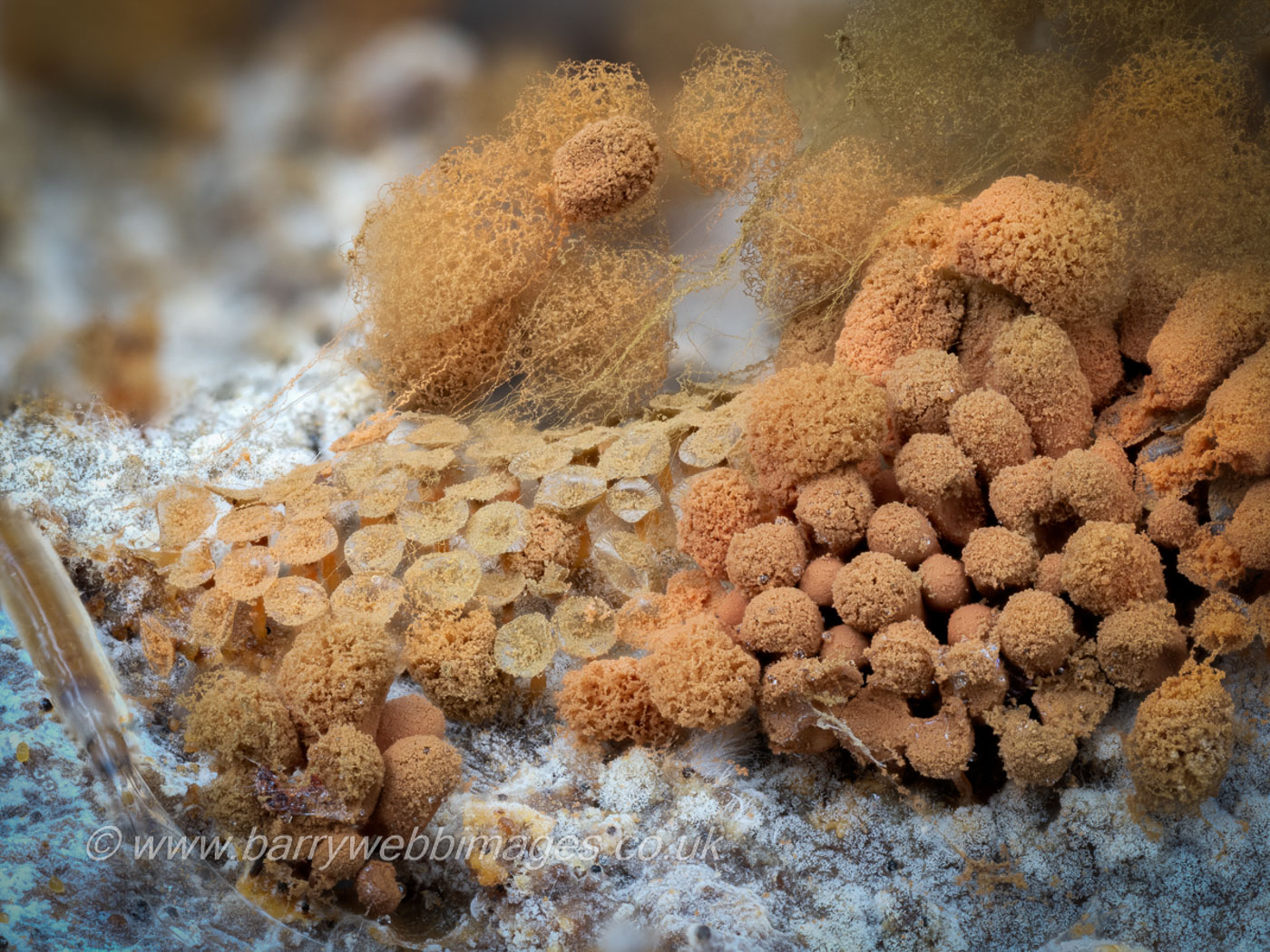
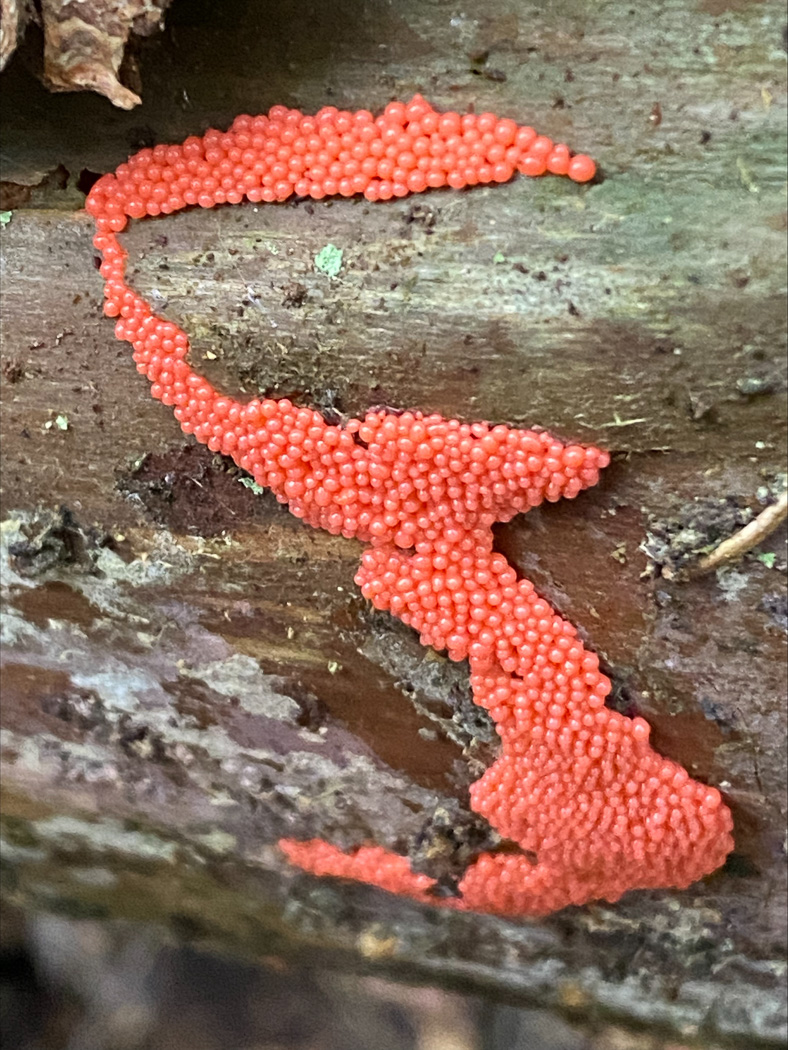
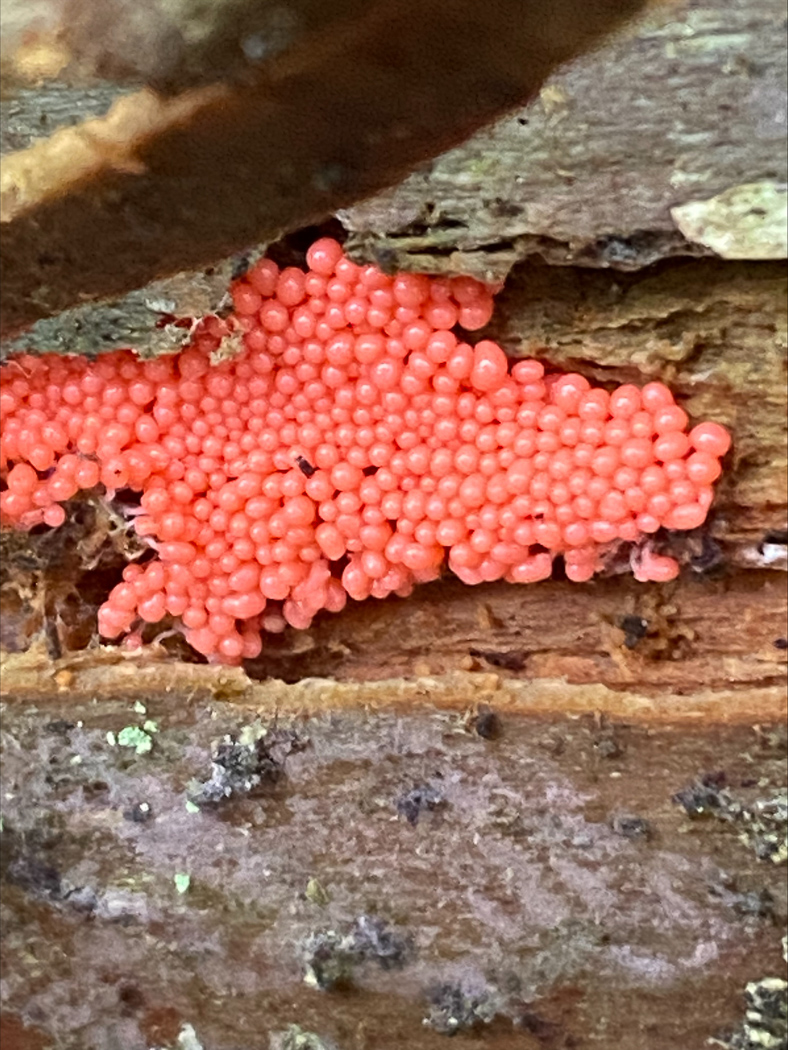
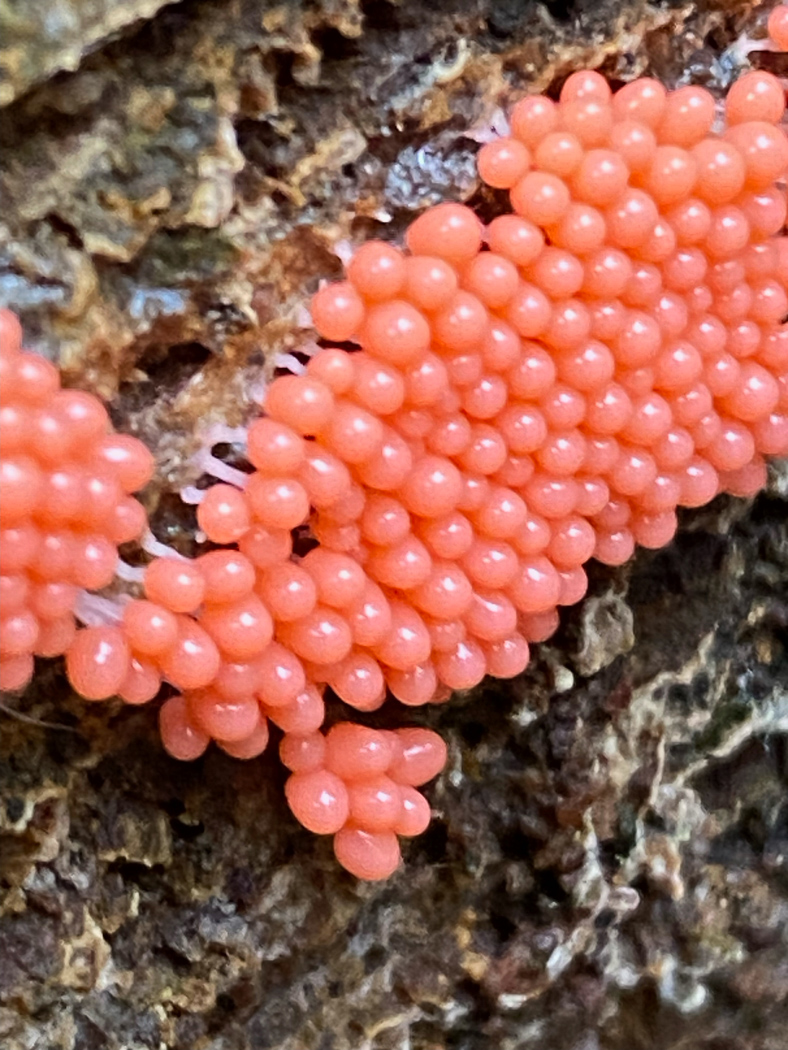
 |
Arcyria ferruginea (a slime mould with no common name)
Mar 13, 2024. The previous day a small group of us found a few fungi at Burnham Beeches, one being this Slime Mould to which Barry Webb returned today to check its identity and take his photo. This is a good example of the mature stage of the genus Arcyria (when not slimy at all!) showing in the background the fine mesh of fluffy 'elaters' which form the protective framework containing the spores which here have almost entirely blown away. Note also the now empty cups - all that is left of the entire sporangia (fruiting body) once the rest has blown away.
Dec 1, 2023. Chris Grimbly found this impressive large colony (still at the plasmodium stage) on damp rotten deciduous wood in Bernwood Forest. He obtained a possible ID by posting his photos on a facebook page, the ID later supported by Barry Webb when Penny asked for his opinion also. Few slime moulds can be safely identified when at this stage of development but it appears that the pink colour of this species makes it one of them, though it is somewhat similar to the much more common Trichia decipiens which, however, tends to form smaller colonies and is bright orange at this stage rather than pink as here (though as it matures and starts to dry off the bright pink fades to more orange beige - photo 4 was taken a couple of days later). Both tend to have white stems also. This is a new entry for Finds.
|
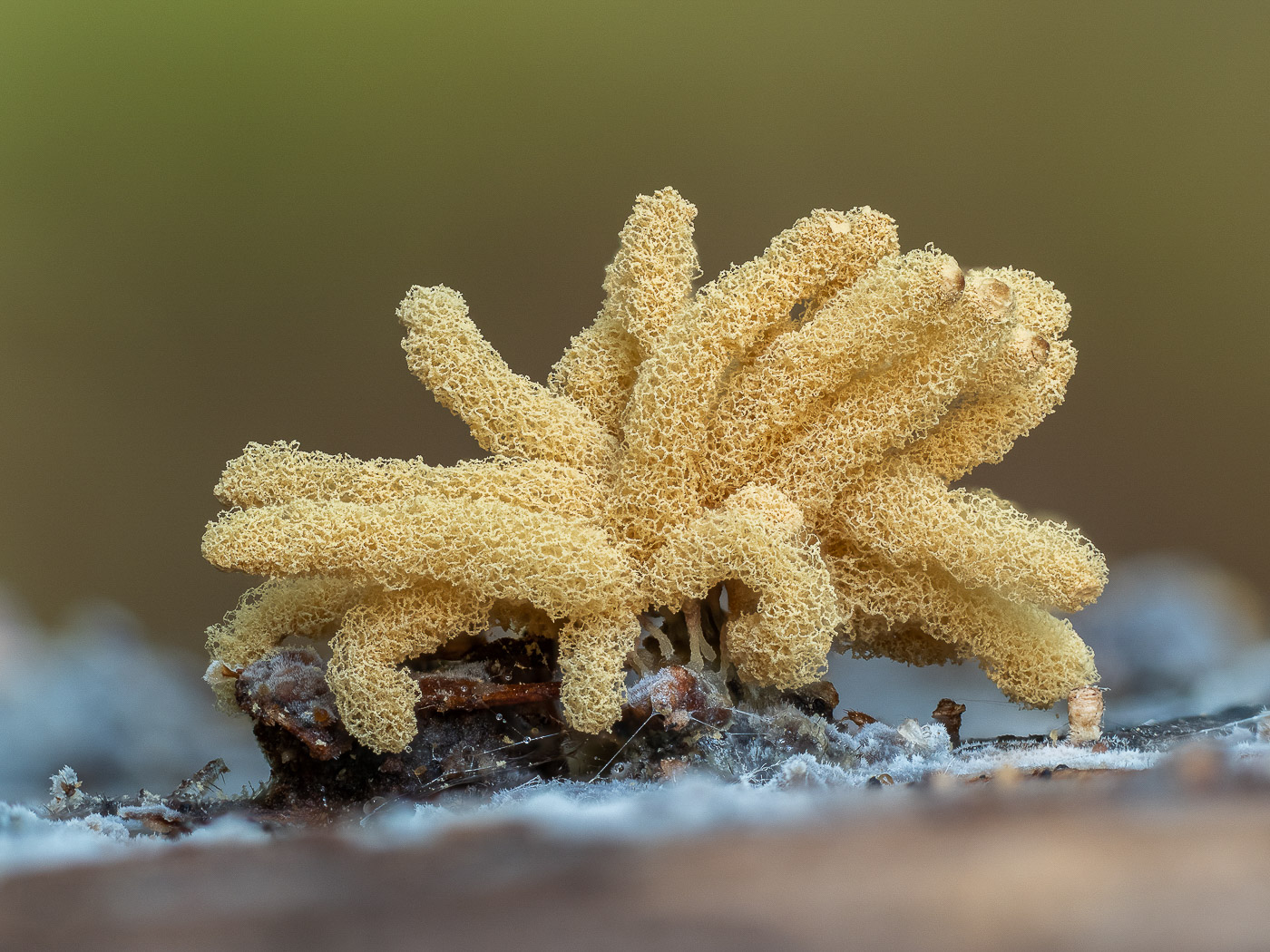 |
Arcyria obvelata (a Slime Mould with no common name)
Aug 1, 2020. Barry found this quite common species in Burnham Beeches on rotten Beech, though we have only two previous county records. It is an easy one to recognise when mature being alone amongst species of Arcyria in having a somewhat drooping shape, a rather loose mesh and a very short stalk, the cream yellow colour is another distinctive feature though one or two other species can also be this colour (but not this shape).
|
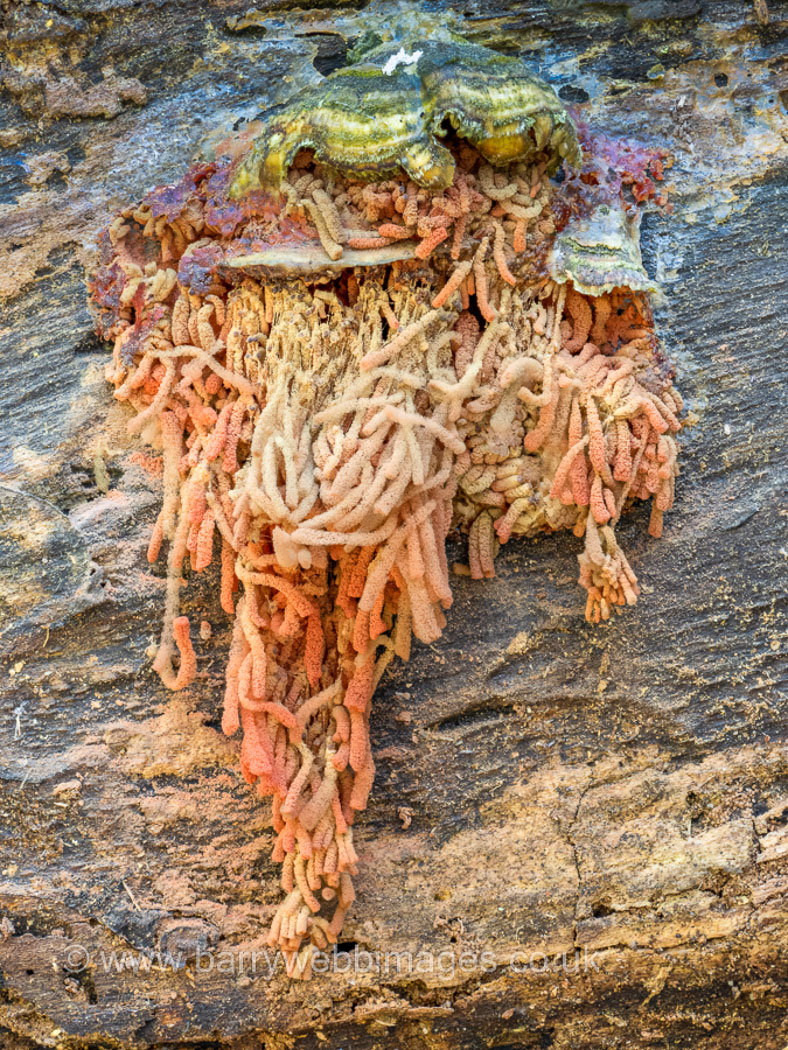 |
Arcyria oerstedii (a rare Slime Mould with no common name) 
Apr 29, 2023. At Burnham Beeches prior to our BFG Walk Barry Webb found this somewhat drooping species on some damp bare fallen wood. He suspected right away that it was unusual as the only other Arcyria known to droop, A. obvelata - a fairly common species he knows well, is yellow with no pink as seen here. Myxo guru Edvin Johanessen, when consulted and on seeing the photo, suggested it might be A. oerstedii which Barry then confirmed by checking the microscopic details. This is new to the county with only 60 UK records on FRDBI but was identified too late to make Penny's Burnham Beeches report, hence its inclusion here.
|
B
|
|

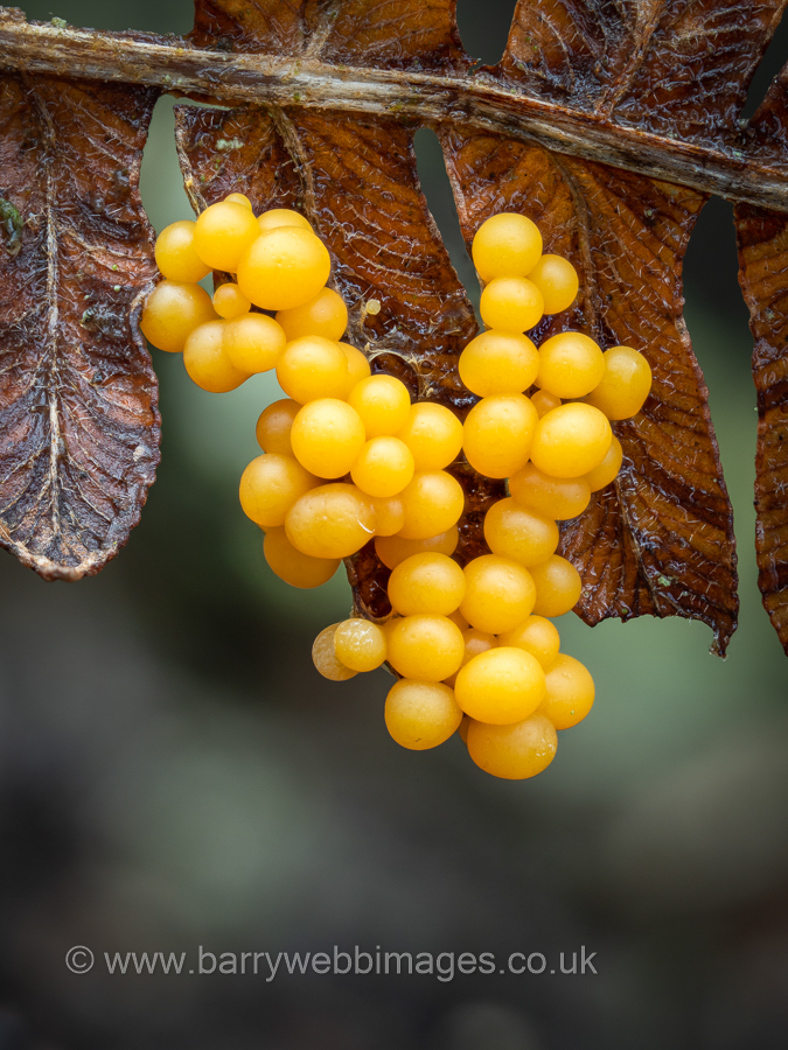
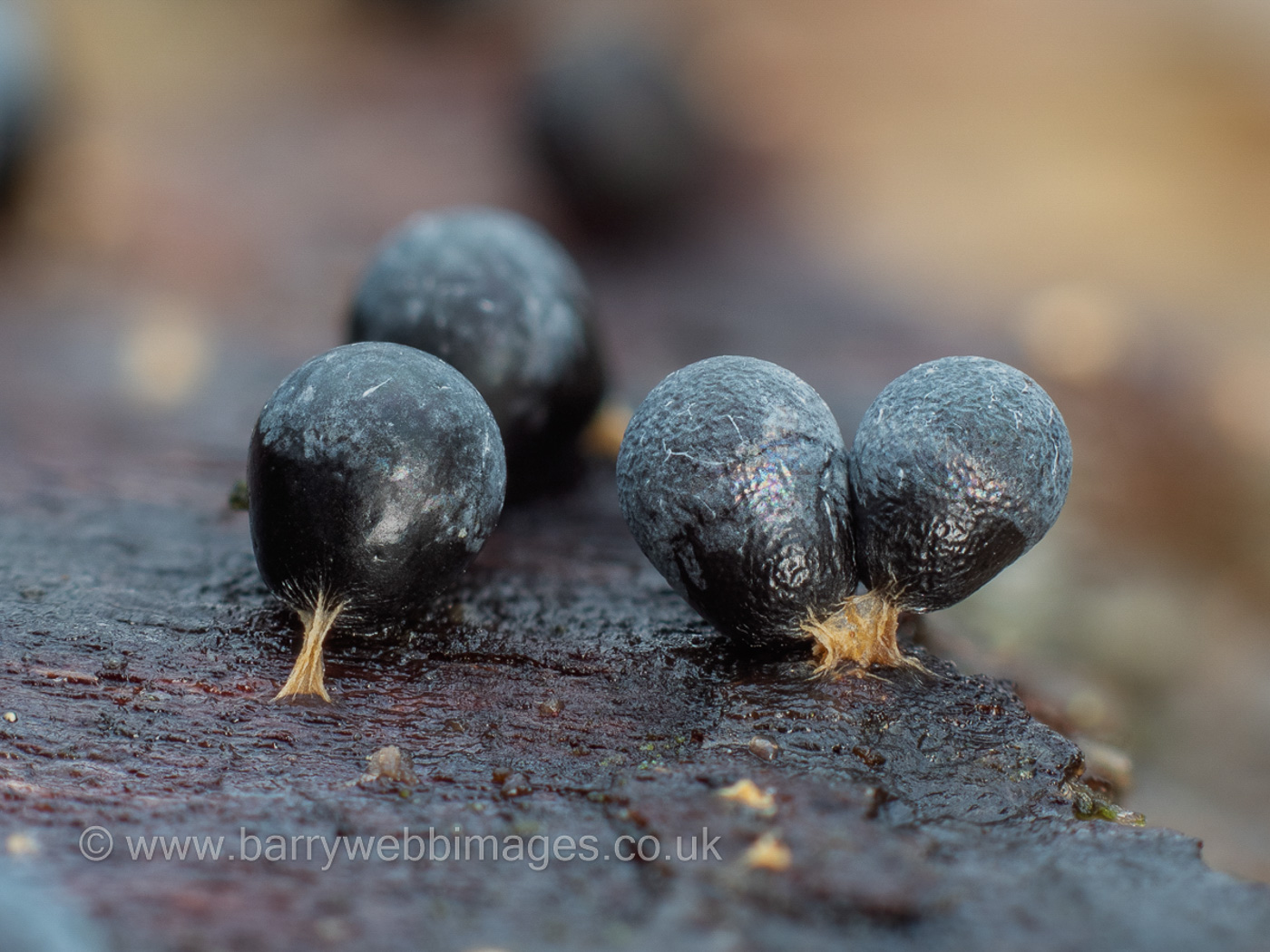 |
Badhamia utricularis (a slime Mould with no common name)
Dec 30, 2021. In Hodgemoor Woods Barry and Gill Webb found a pile of cut up lichen-covered Birch branches which provided them with two species of slime mould, this being one of them. Photo 1 shows the jelly-like plasmodium stage (plus a tiny Lycogala terrestre just developing); photo 2 is the same species further developed; photo 3 is of fully developed material. We have just 4 previous county records, the last being Barry's from Penn Wood in 2020.
|
C
|
|
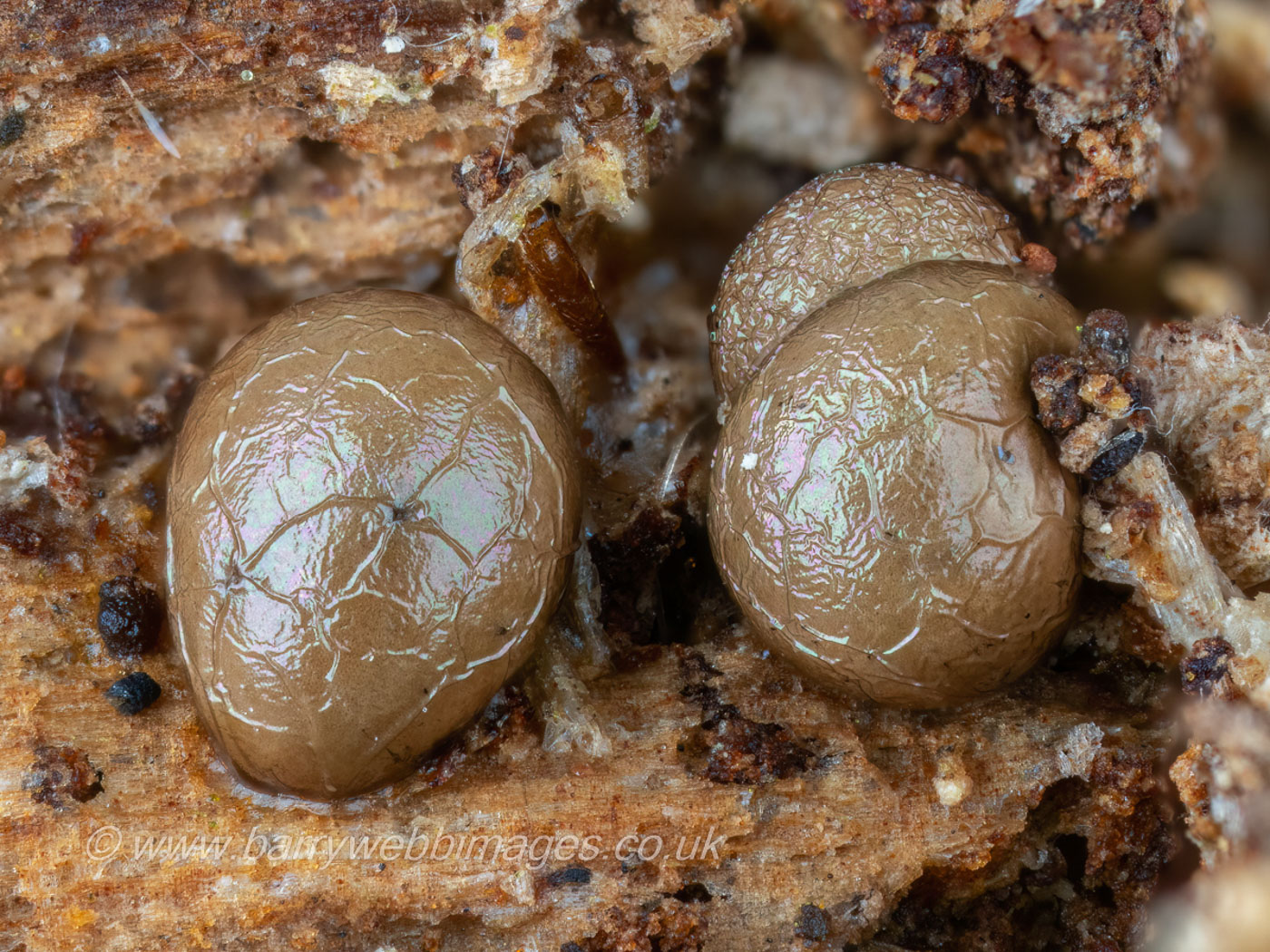
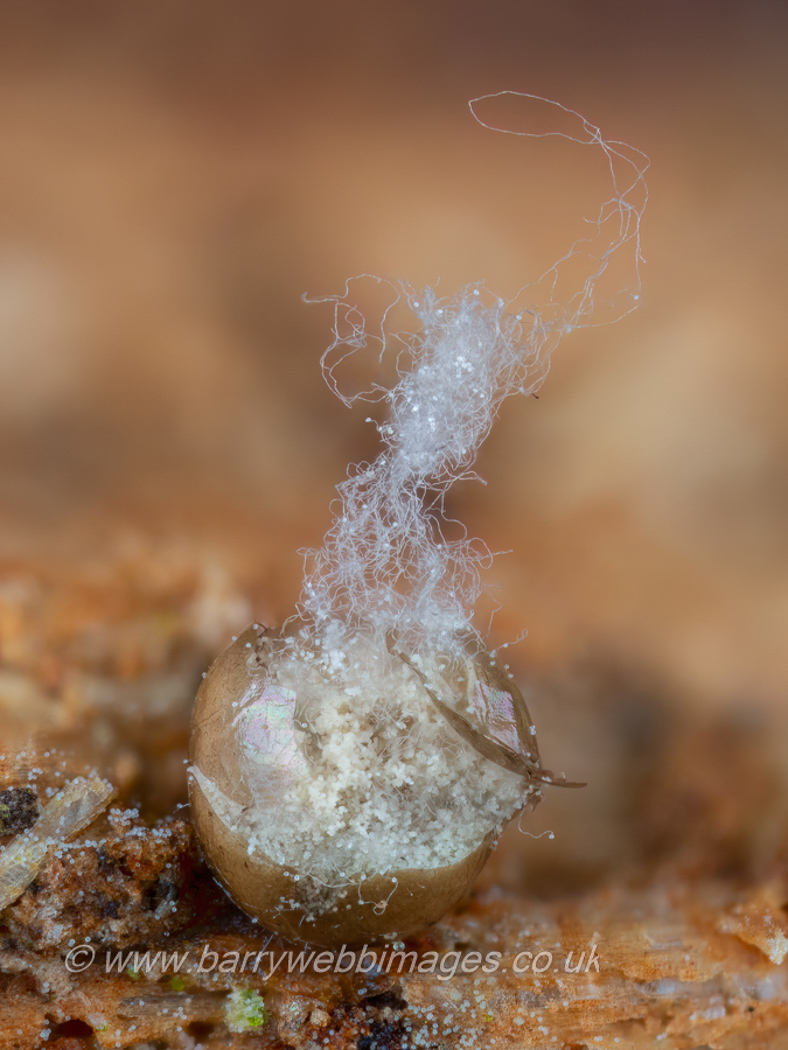 |
Calomyxa metallica (an unusual slime mould with no English name)
Mar 24, 2024. Whilst on our BFG walk at Rushbeds Wood Barry Webb collected a slime mould unfamiliar to him and was unable to identify it later. He hung on to it and a few weeks later investigated it a bit further, putting his photos on to the slime mould facebook page for help. Back came the name from both John Holden and Edvin Johannesen (both recognised specialists) and comparing other images online etc this ID looks extremely likely. Not a rarity with over 100 FRDBI entries, it is however new to the county.
|
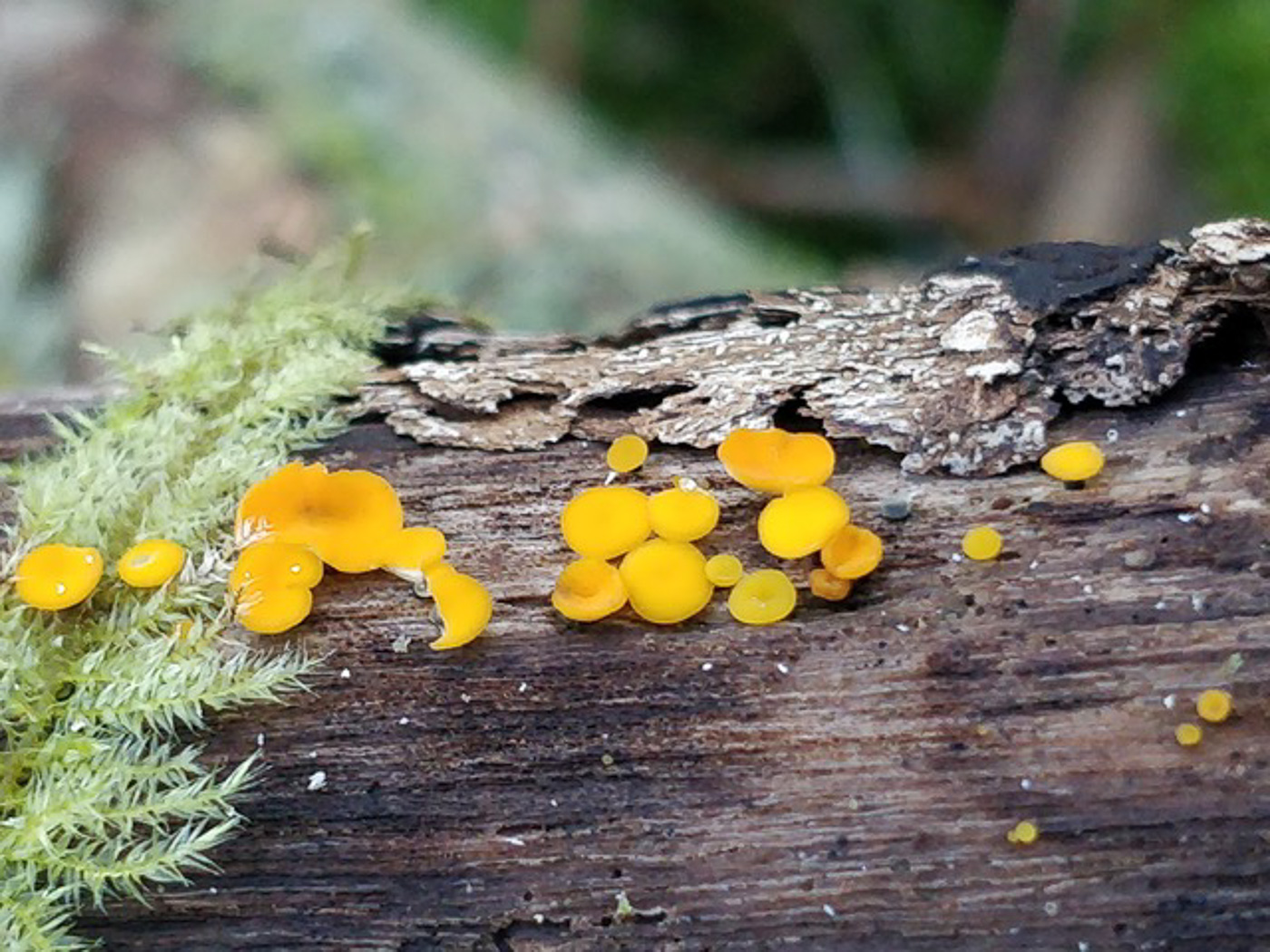
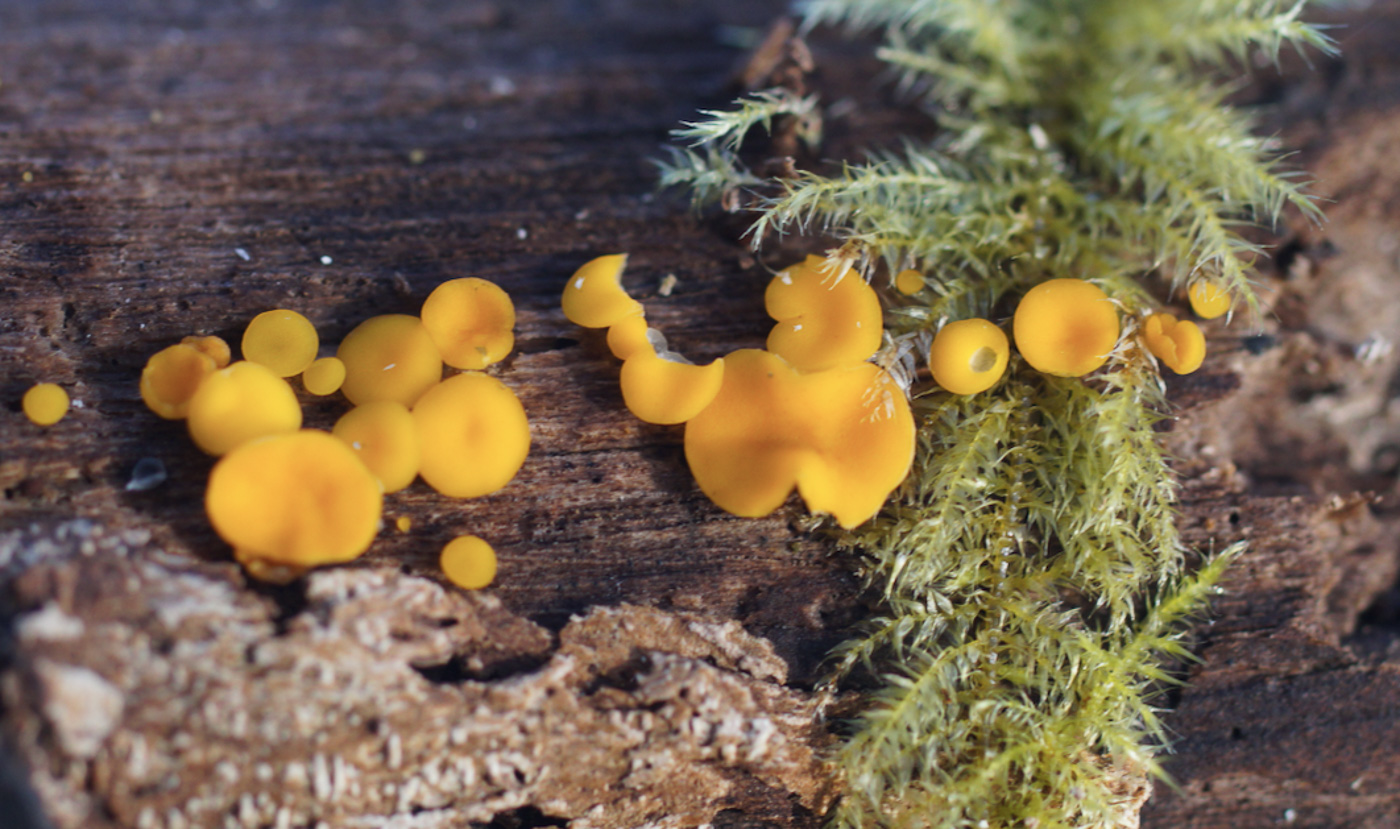
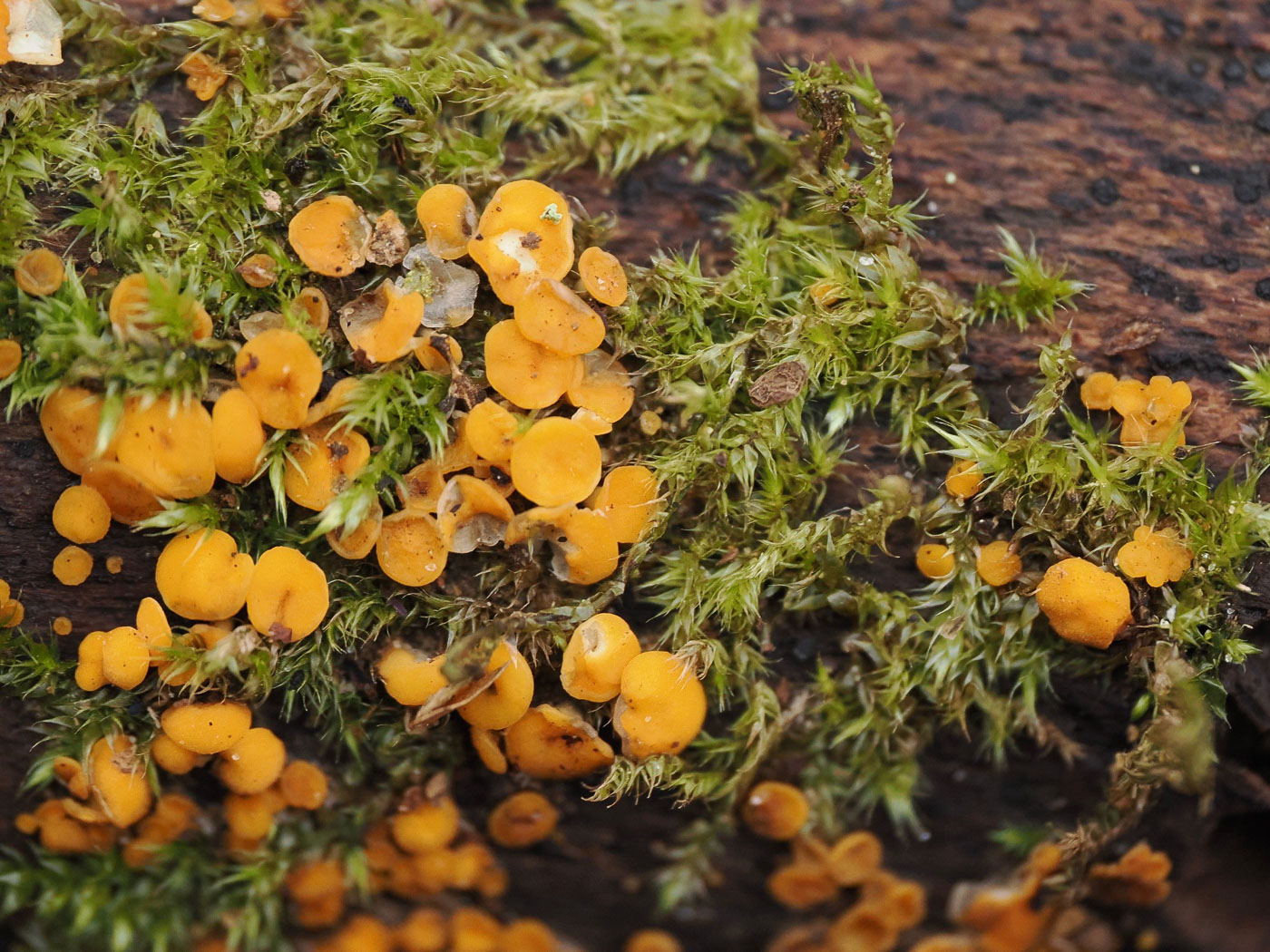
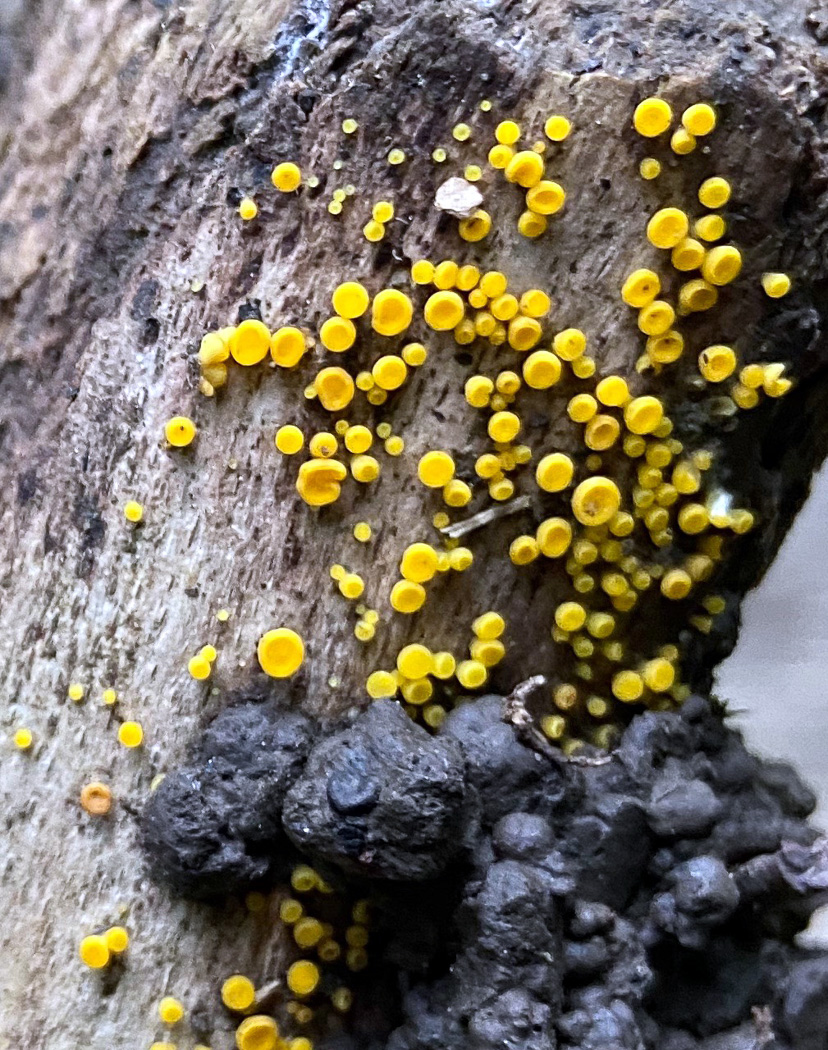 |
Calycina citrina (Lemon Disco) 
Jan 12, 2024. In Salden Wood Bob Simpson noticed this colony of tiny yellow discs on a deciduous log and sent photo 1 to Penny for identification. She emailed him a copy of the microscopic details to check but suspected it would be this very common species, better known under its previous genus name Bisporella. A day later Claire Williams found what she thought was this same species in Downley Common (photo 2 - though not checked microscopically). Two days later Bob then collected further material (photo 3) which he checked and which matched microscopically, confirming the ID.
NAME CHANGED from Bisporella citrina
Sep 11, 2020. Sarah Ebdon found this colony of tiny cups on rotting fallen deciduous wood in Kings Wood, Tylers Green. Quite a common ascomycete, each cup is no more than 3 mm across but despite its size, because of its bright colour and habit of forming large closely-knit clusters it it often easy to spot from a distance.
|
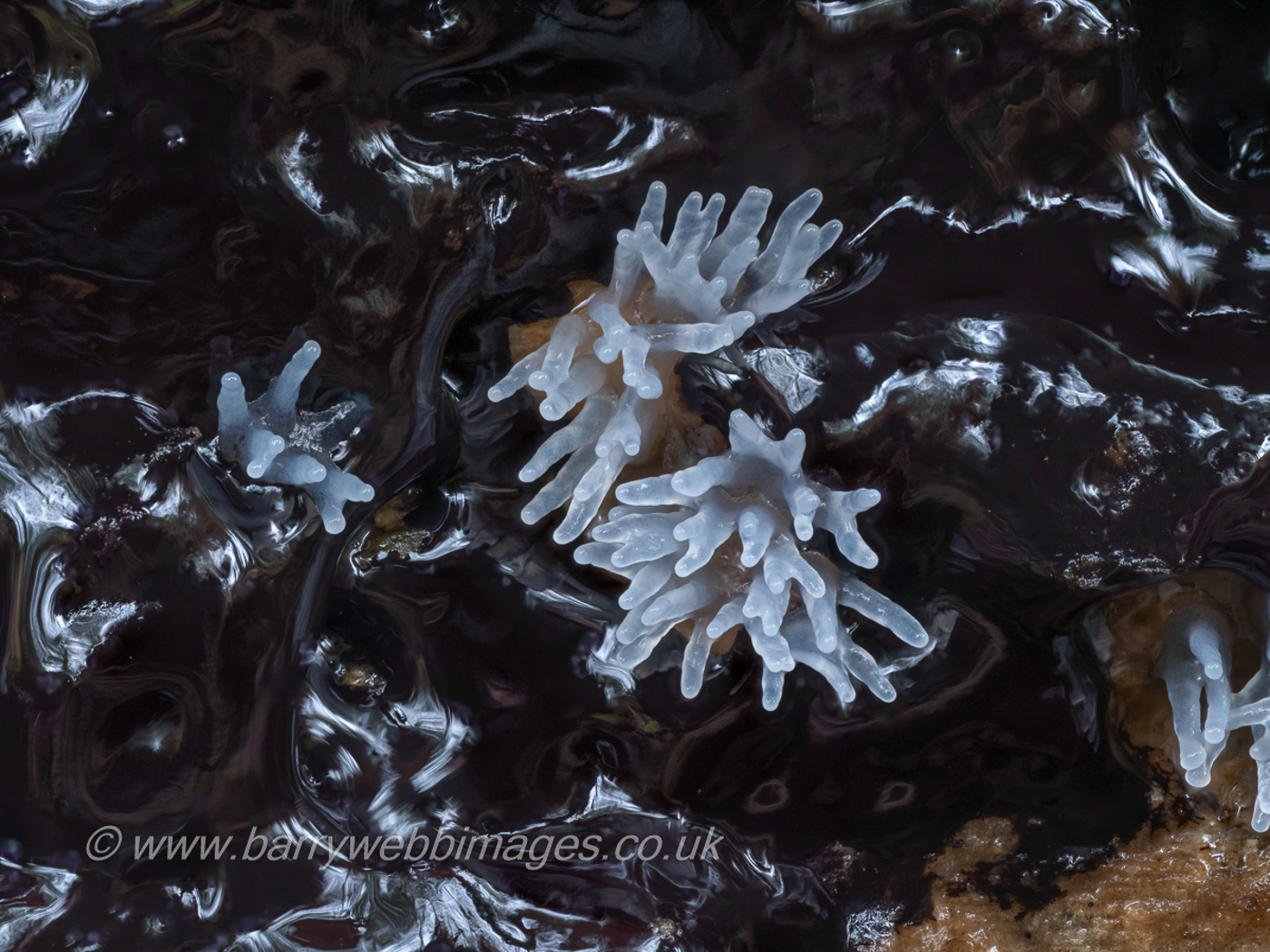
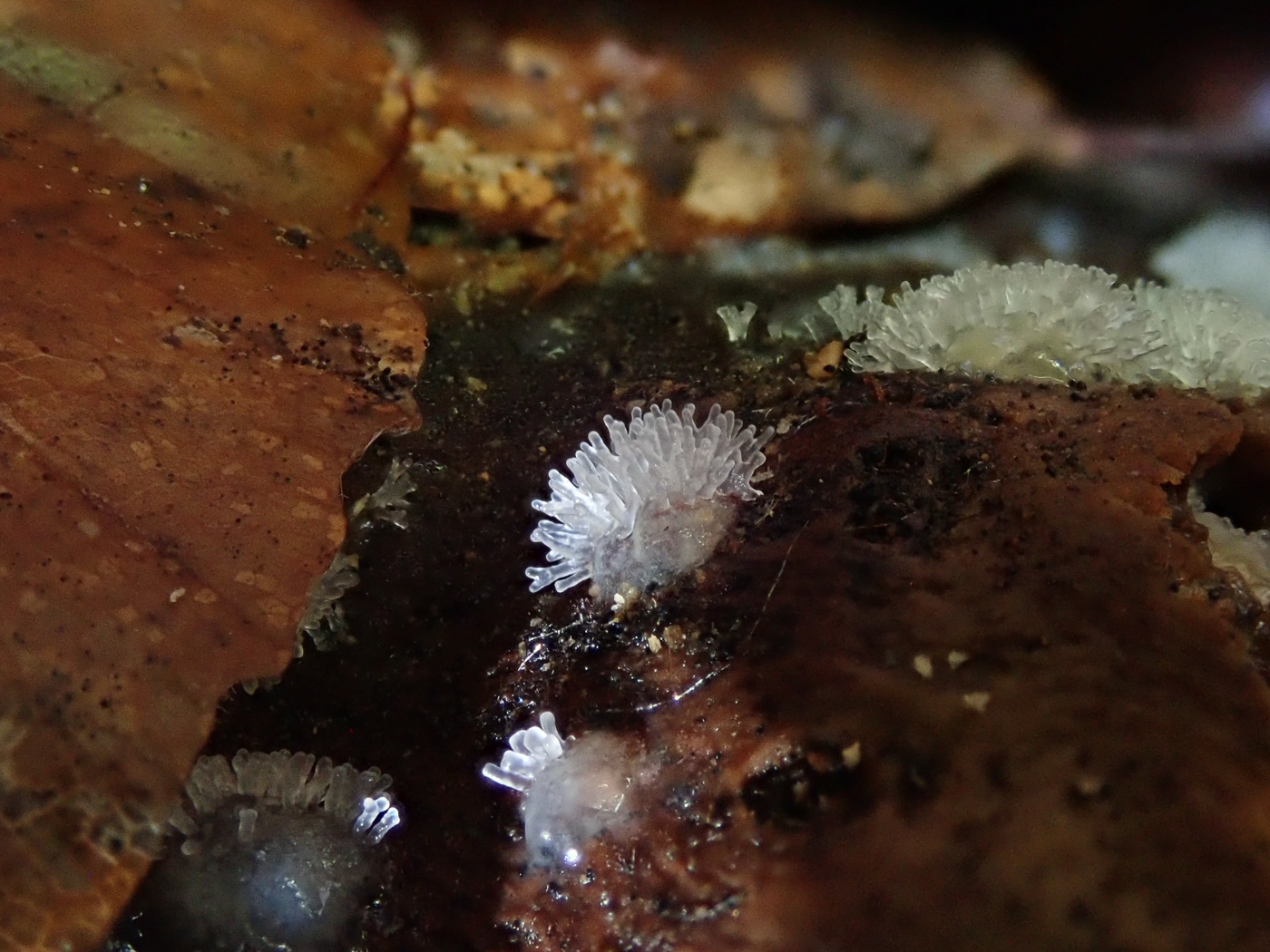
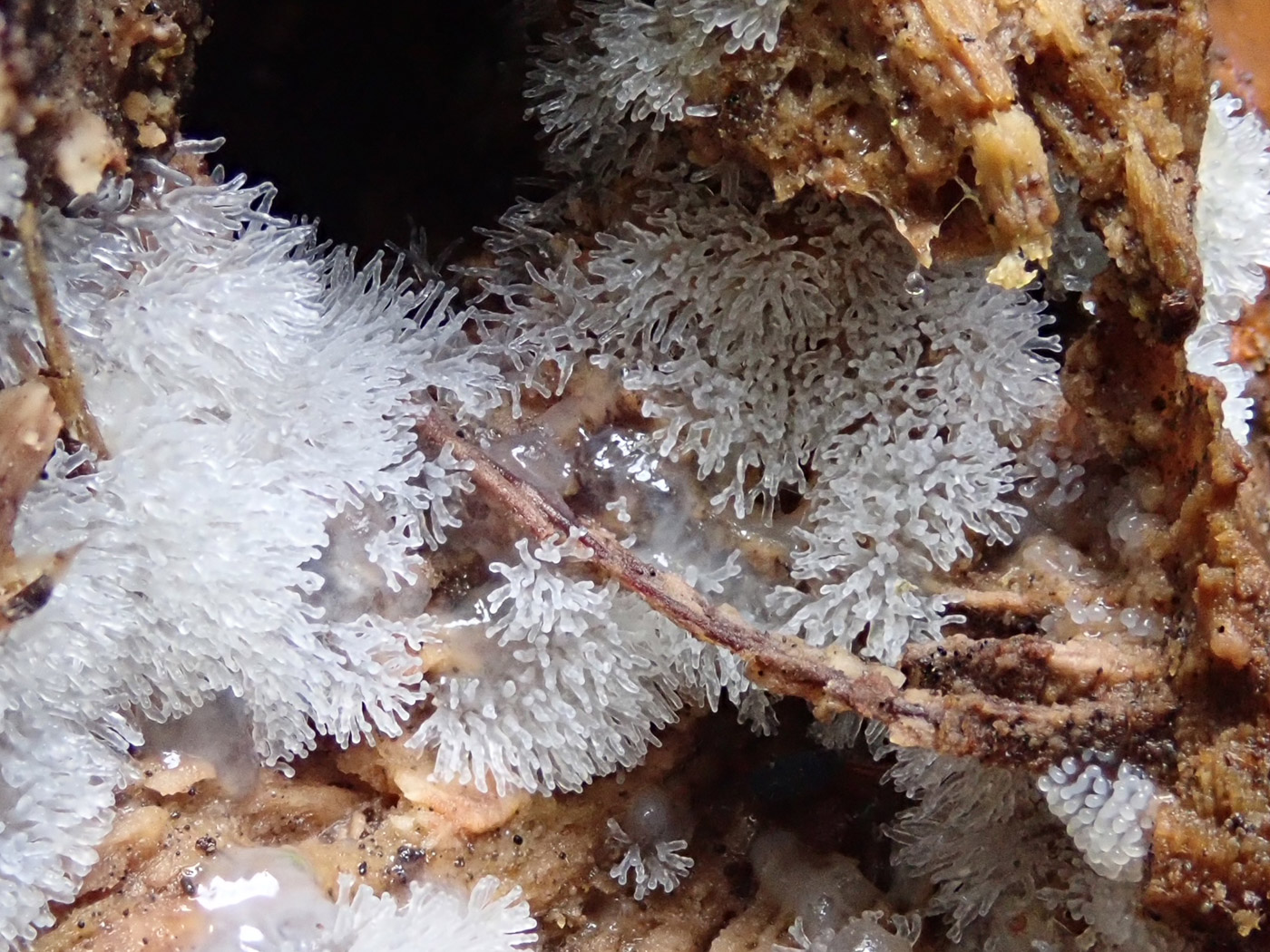
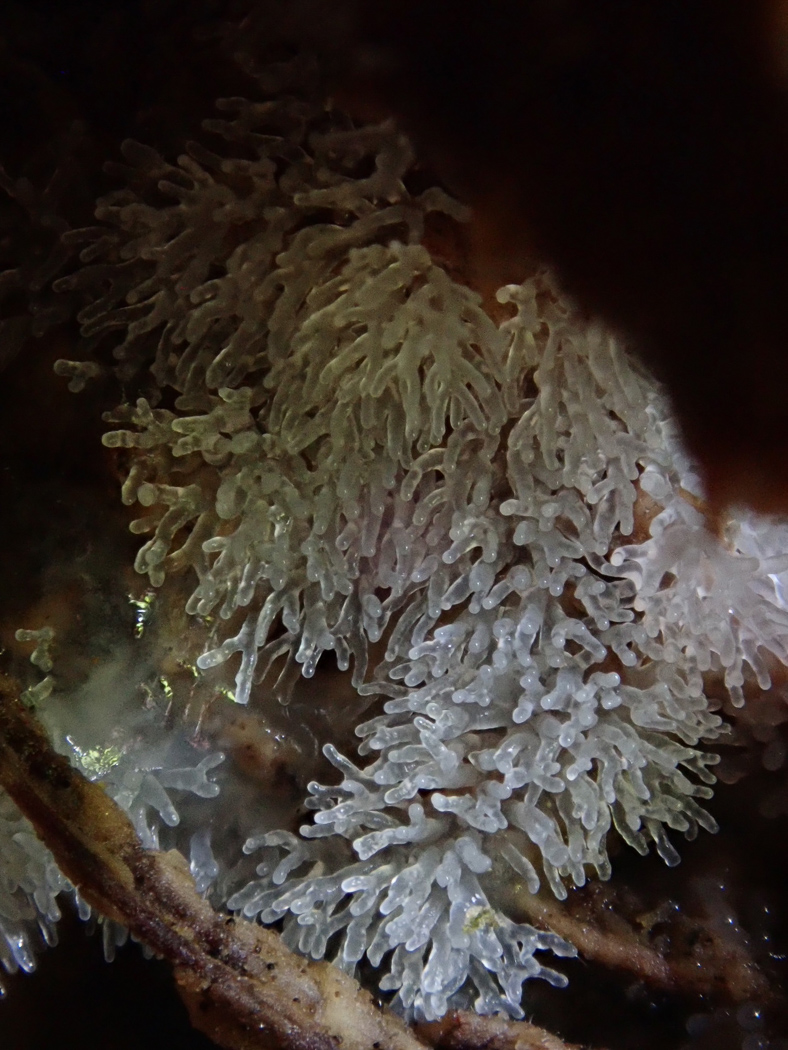
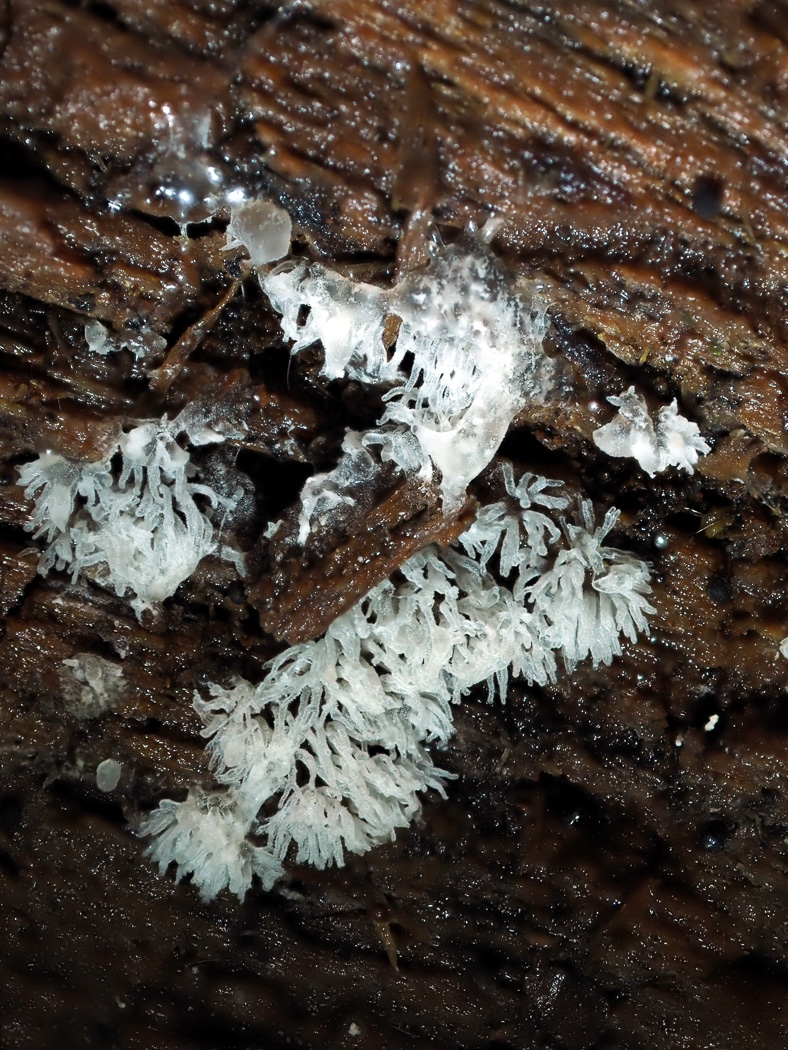
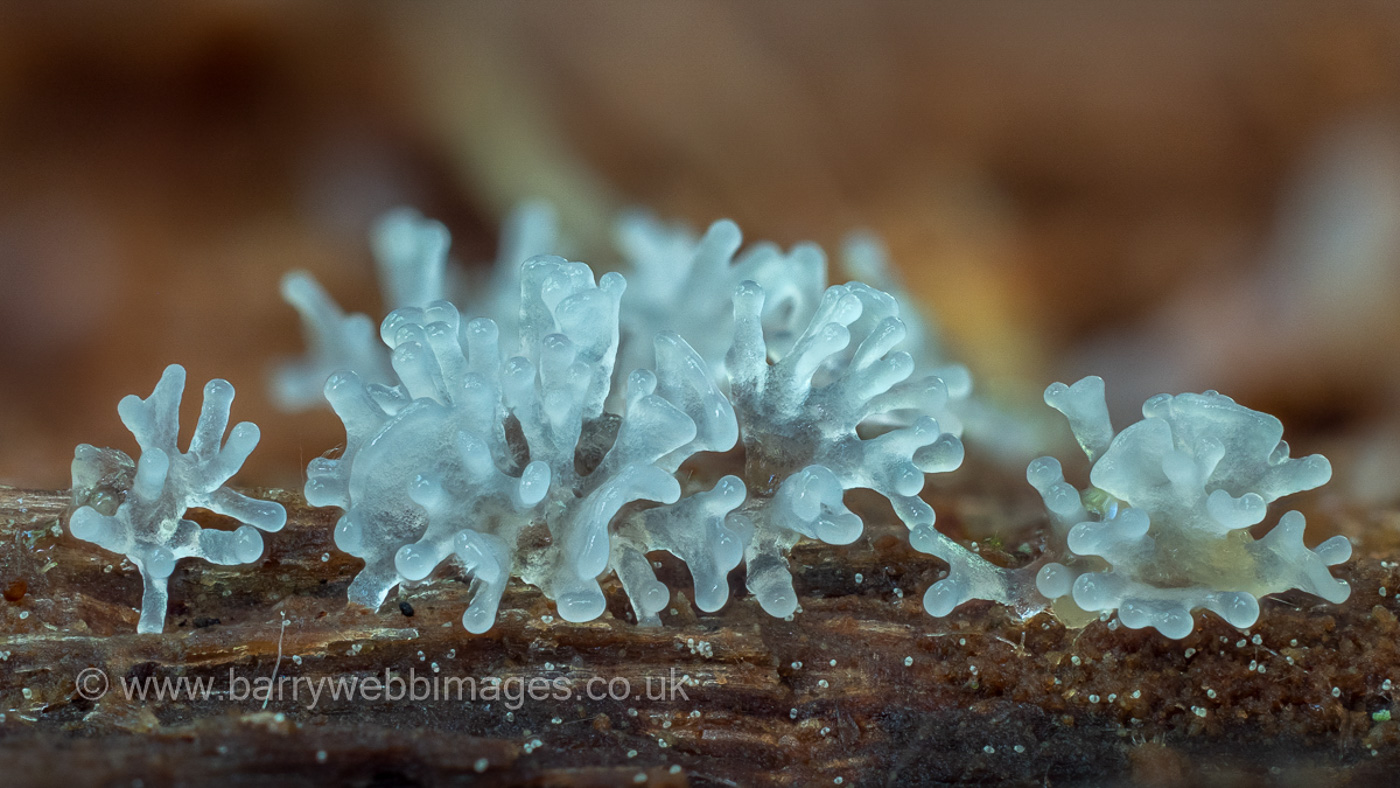
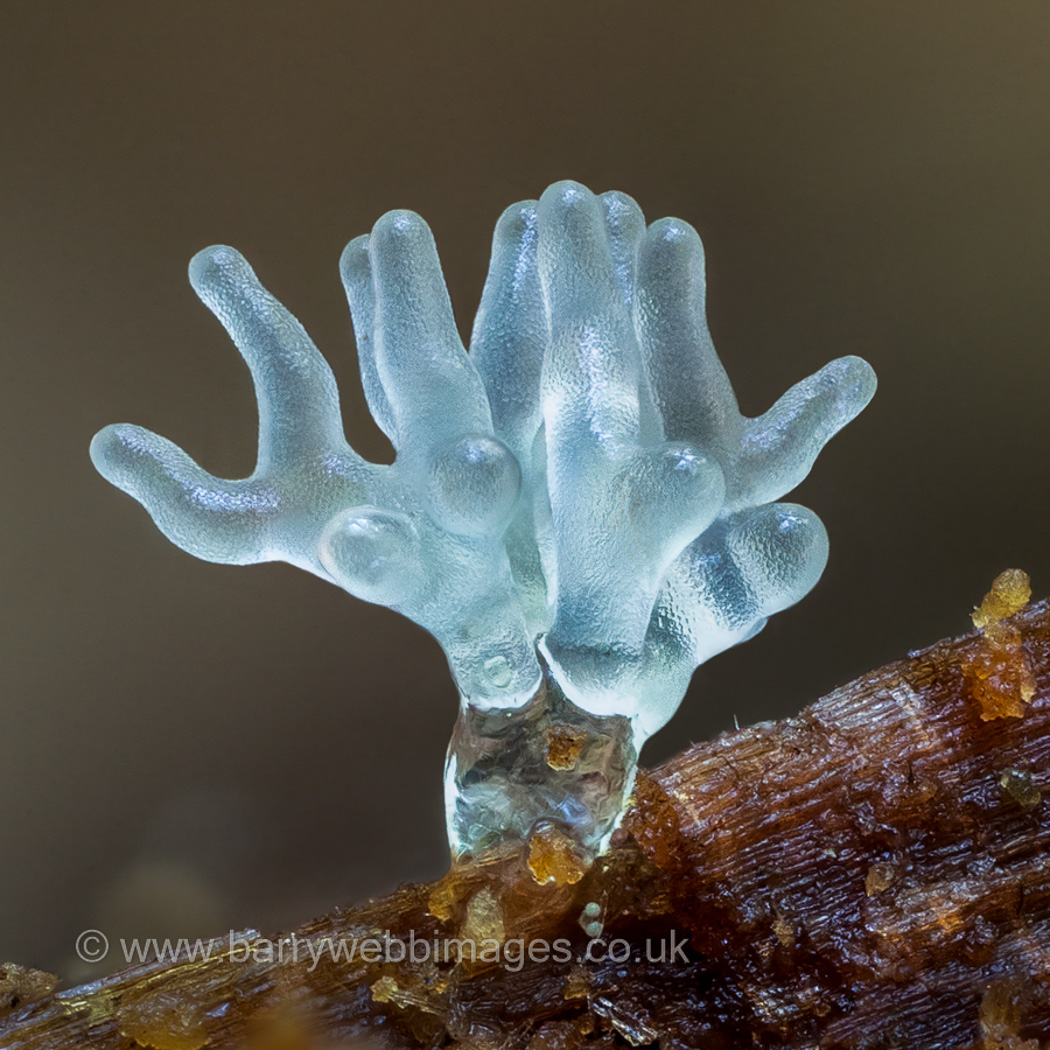
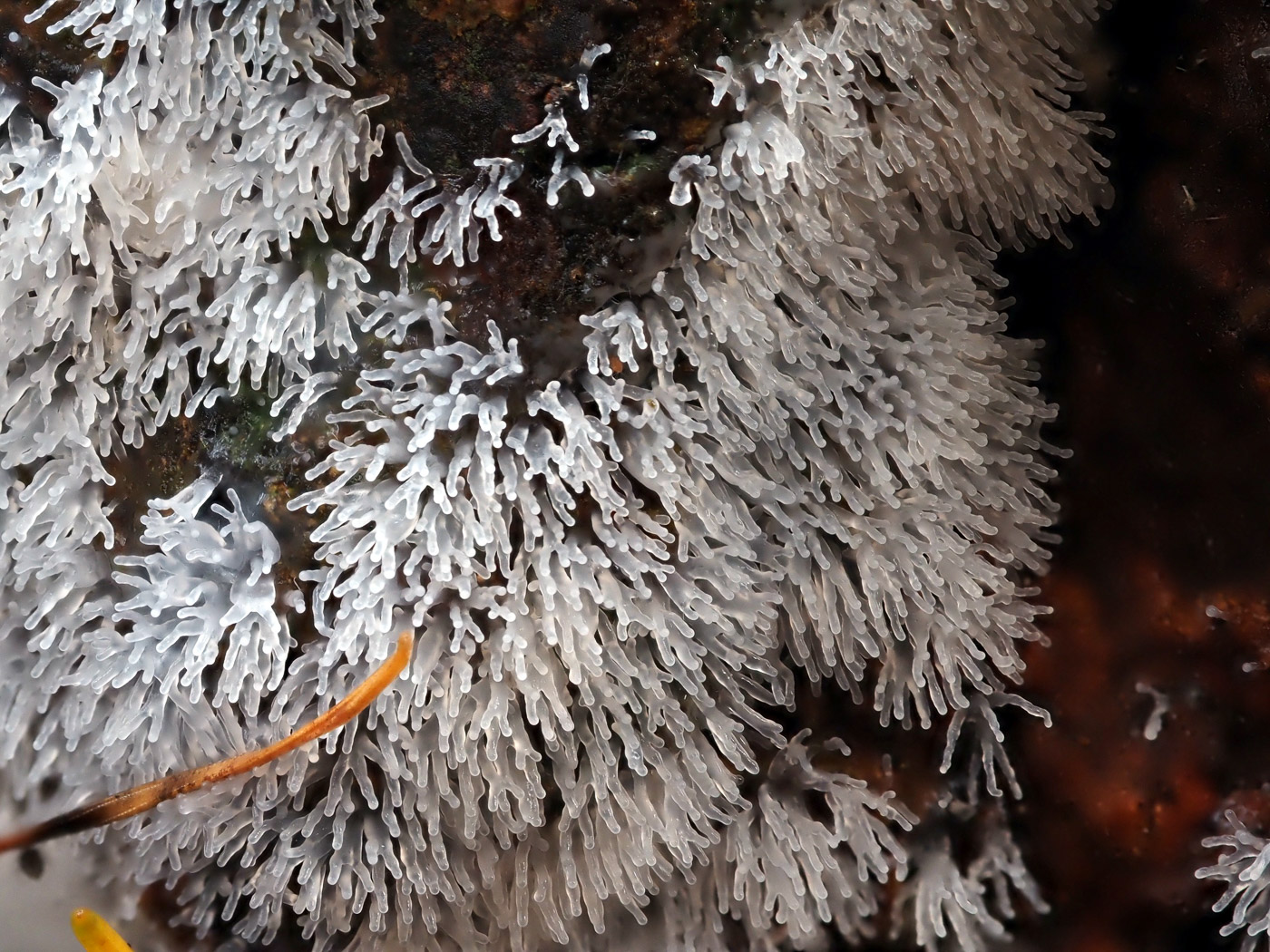
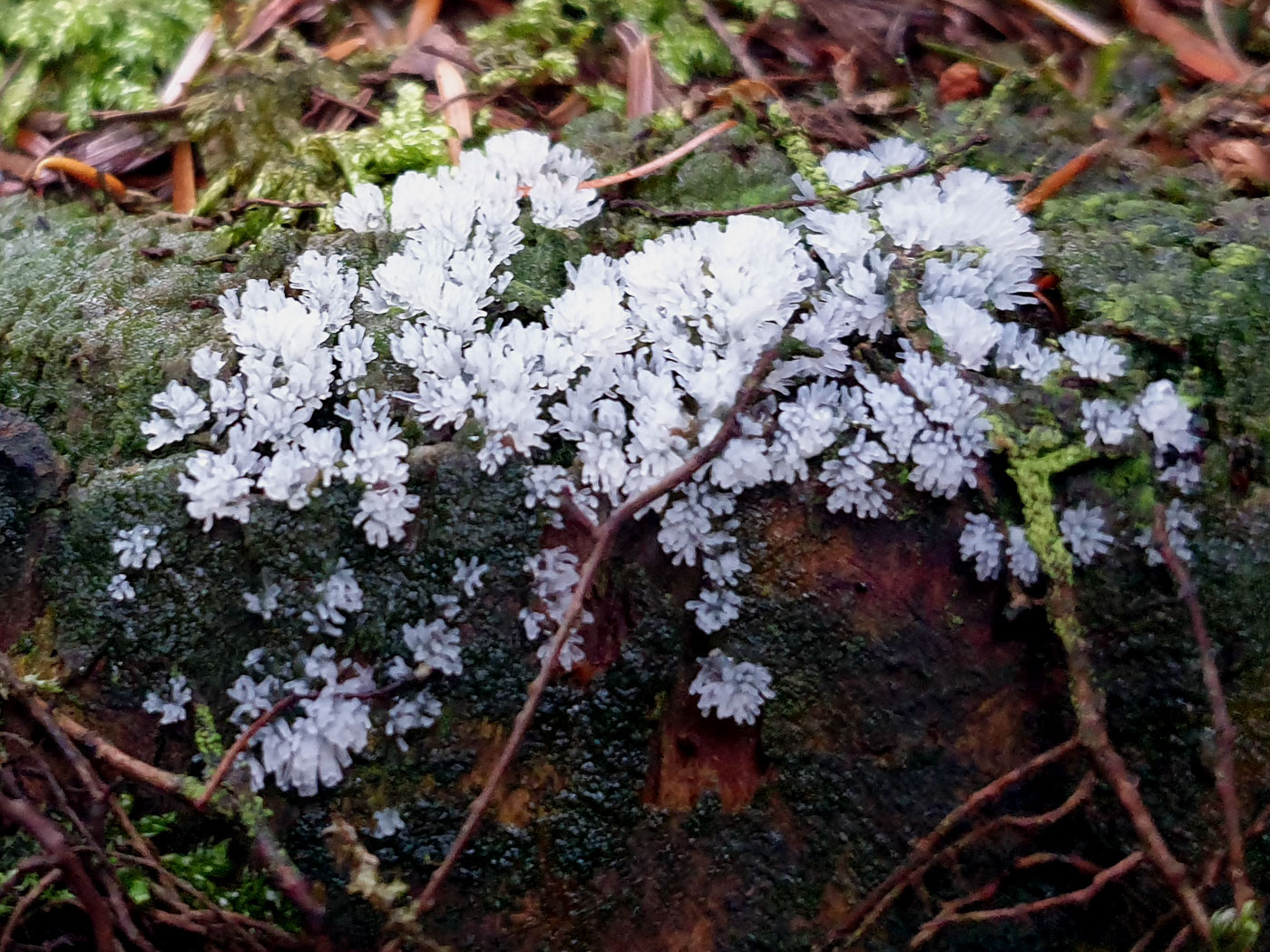
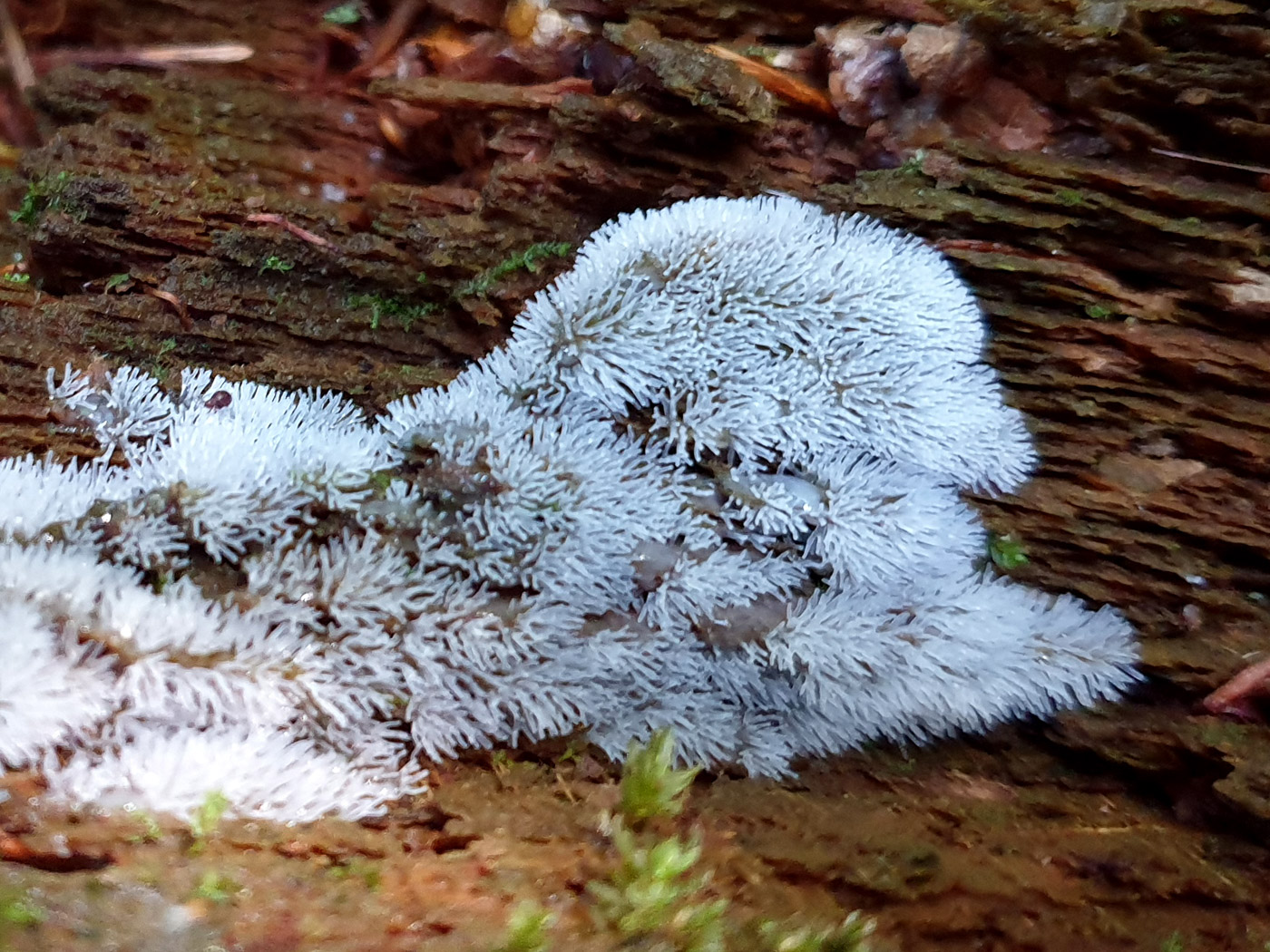
|
Ceratiomyxa fruticulosa (Coral Slime)
Mar 13, 2024. The previous day a small group of us found a few fungi at Burnham Beeches, one being this Slime Mould to which Barry Webb returned today to check its identity and take his photo. This is a good example of the mature stage of the genus Arcyria (when not slimy at all!) showing in the background the fine mesh of fluffy 'elaters' which form the protective framework containing the spores which here have almost entirely blown away. Note also the now empty cups - all that is left of the entire sporangia (fruiting body) once the rest has blown away.
Jul 13, 2023. On a damp log pile in Naphill Common Sarah Ebdon spotted various different slime moulds, the most photogenic and also nameable being this one - many are unnameable until fully mature and few have common names. This stunningly beautiful species is very common on both deciduous and coniferous fallen wood / stumps when suitably damp though is often missed and one needs a x10 lens to see the detail in the field owing to its tiny size.
Jul 12, 2021. In Downley Wood Claire Williams found this pretty and quite common Slime Mould on rotting wood. It favours old conifer stumps but also occurs on other woods which are suitably damp and decaying. See more photos of this amongst Barry Webb's Slime Mould photos.
May 31, 2021. Barry Webb took these beautiful photos of this tiny but quite common Slime Mould on a damp Pine stump in Burnham Beeches. The individual delicate watery white branches are usually less than 5mm high and a handlens is needed to appreciate their beauty. It can form quite large clusters up to 10 cm across, most commonly on conifer stumps but sometimes on other woods.
Nov 6, 2020. Though we have photos of this species dated Oct 18, it is much in evidence again at the moment and worth looking out for particularly on rotting woody conifer stumps or remains. Claire Williams found this beautiful delicate cluster of tiny white tendrils in Penn Wood.
Oct 18, 2020. Justin Warhurst found this tiny and very pretty Myxomycete (Slime Mould) on rotting wood in Penn Wood. Quite a common species often to be seen in colonies on bare conifer stumps, it can be found on other fallen wood if sufficiently damp. Each fingerlike tendril is less than 5 mm high and photo 2 is of a more more developed colony. Slime Moulds are now known to belong to a Kingdom of their own but share some features with fungi and therefore are usually treated as honorary fungi, being recorded by mycologists.
|
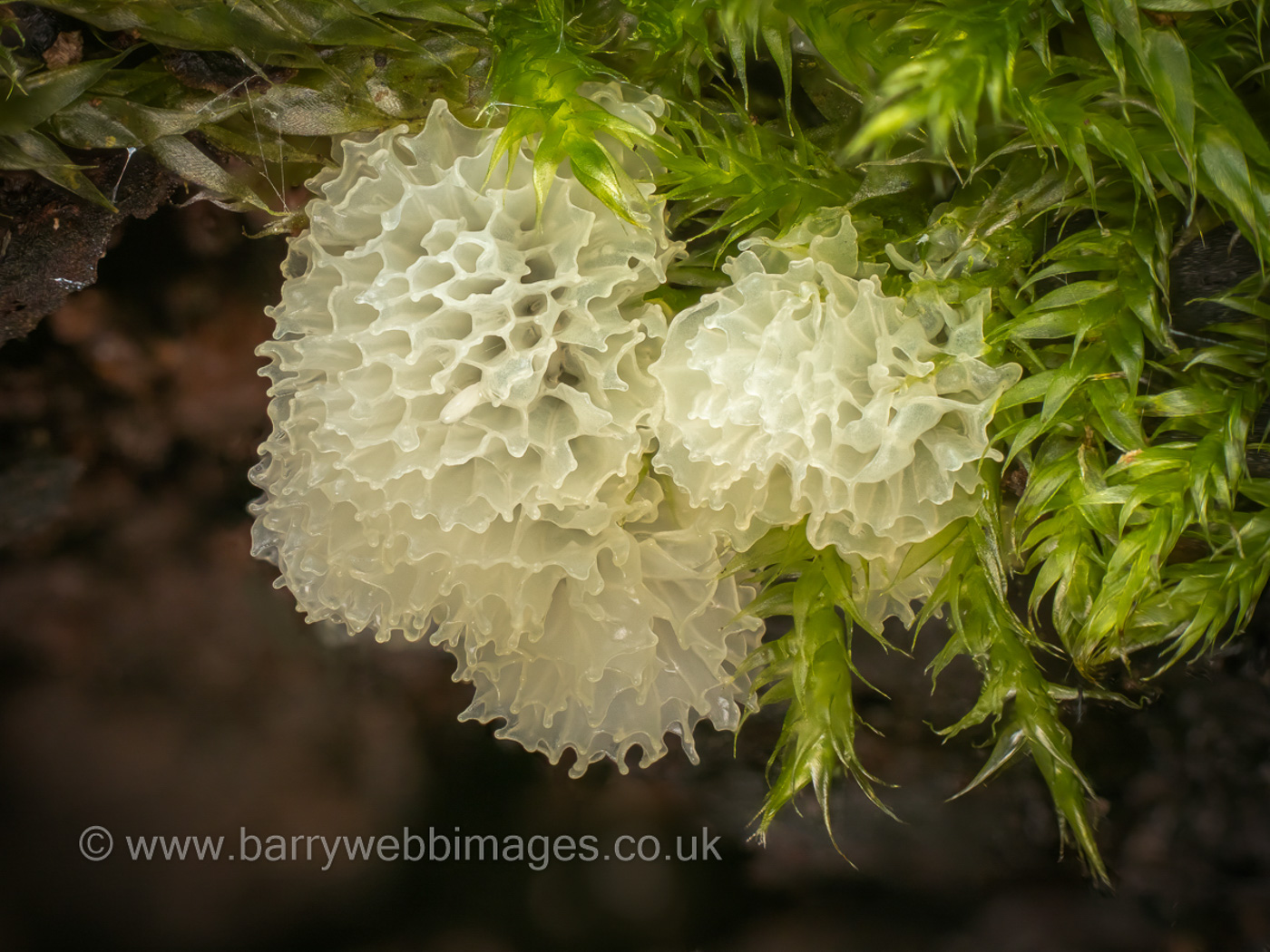 |
Ceratiomyxa porioides (a slime mould with no common name)
Aug 29, 2020. In Bernwood Forest on our first BFG walk of the year Gill Ferguson noticed some tiny white domes on rotten fallen Pine. Both she and Barry recognised it as this rare species, closely related to the common C. fruticulosa (see above) and until recently considered a variety of that species. Its delicate frilly poroid surface is remarkable. The species has only a few British records, one previously from Bucks, but apparently it is now spreading here and gradually becoming less rare.
|
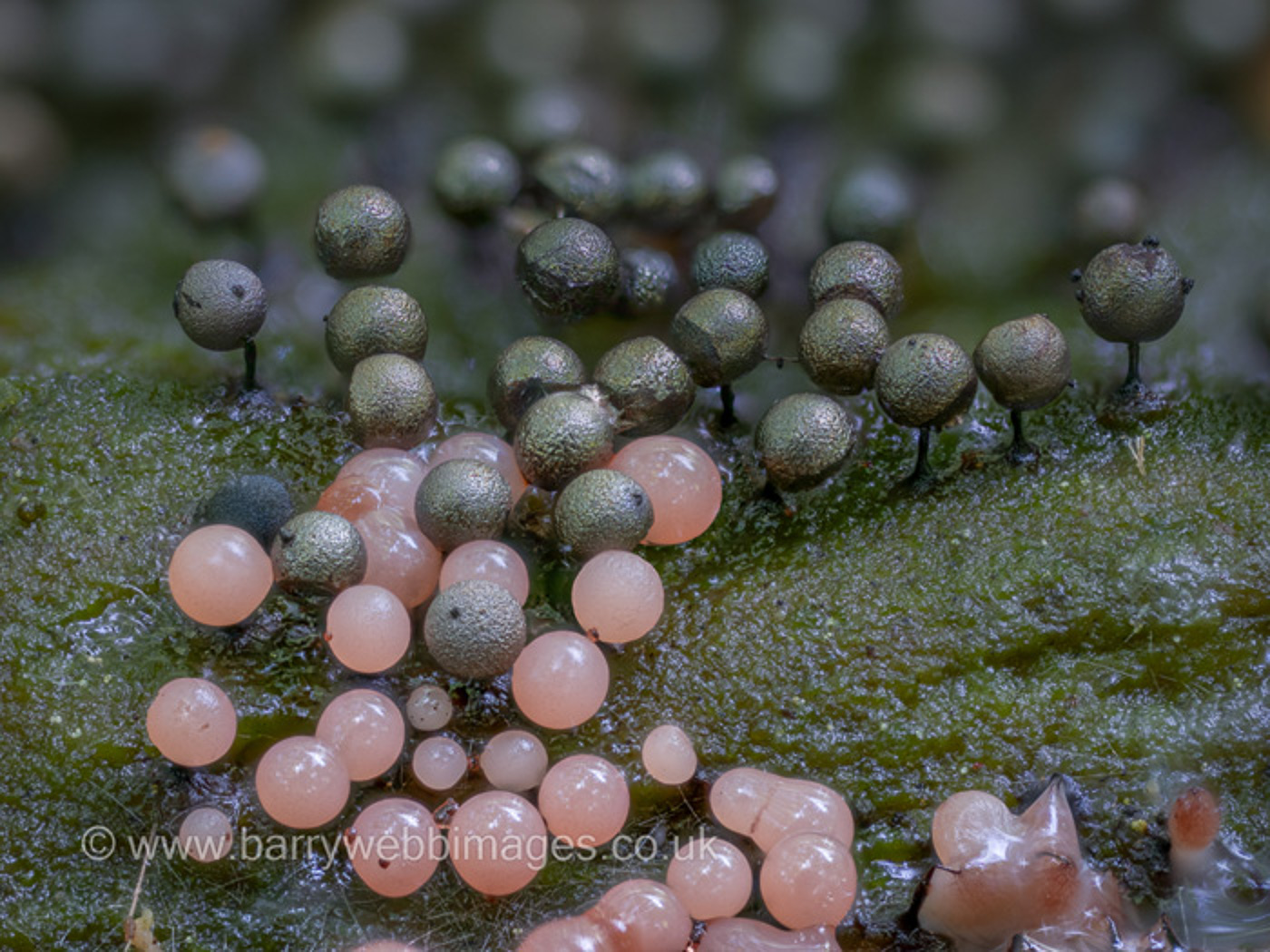
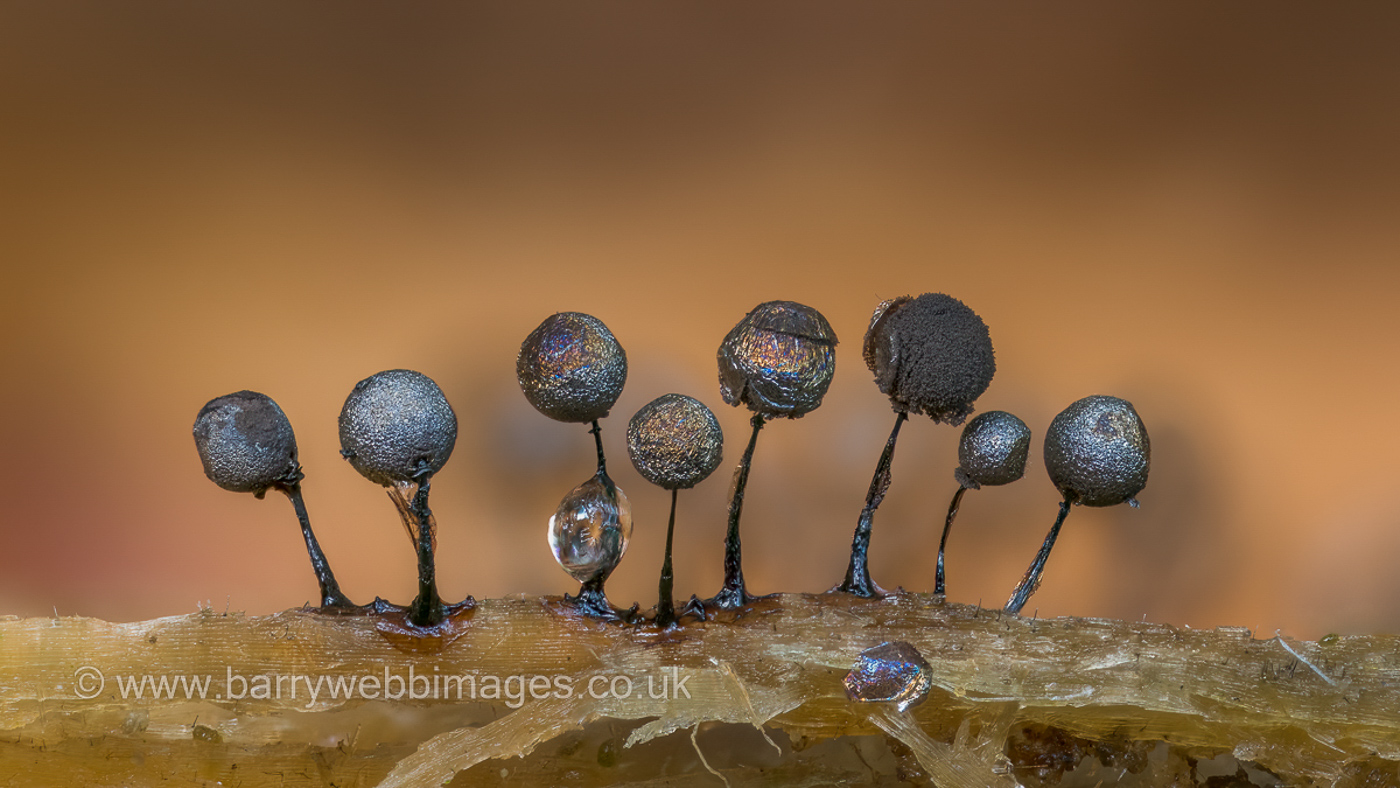
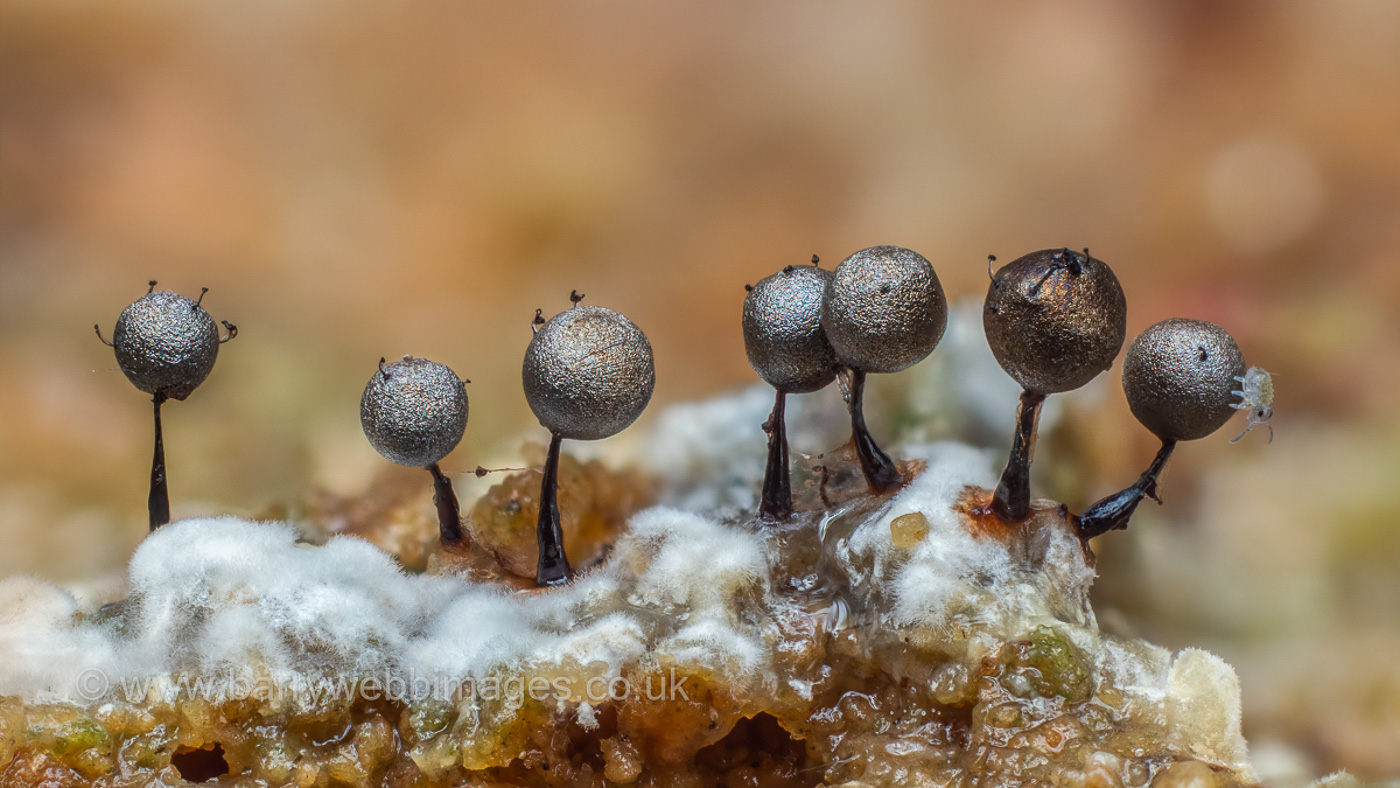
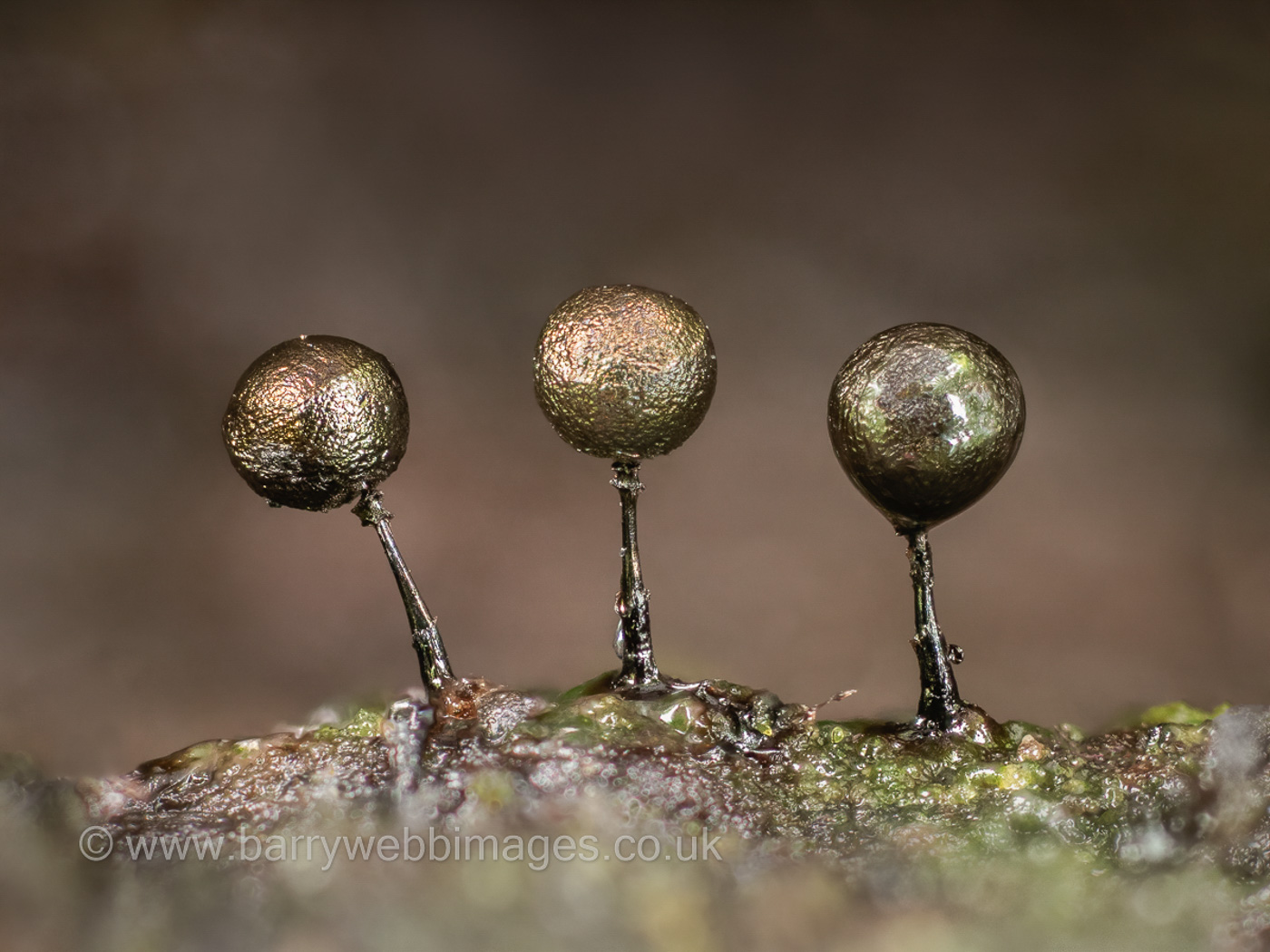
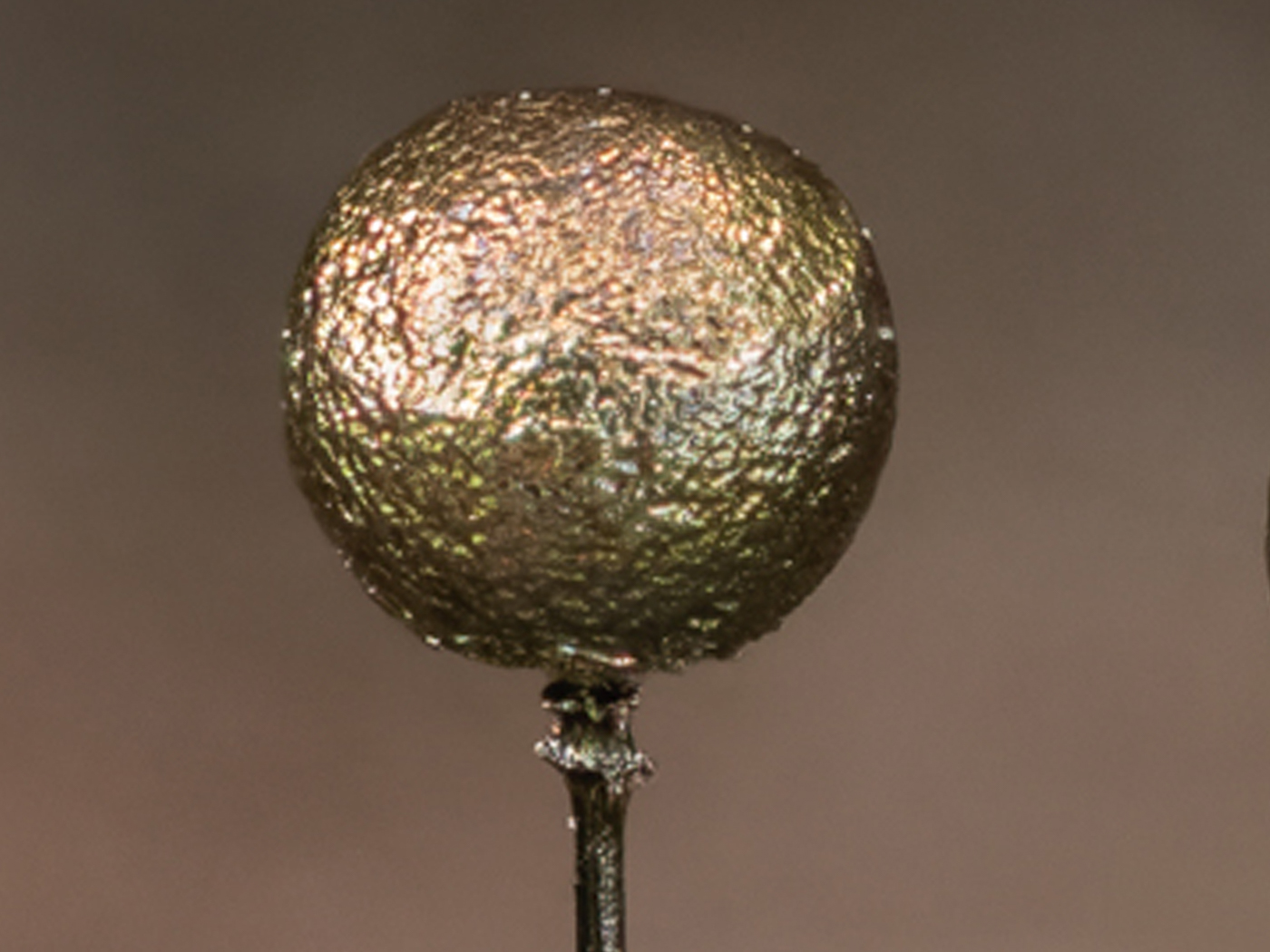 |
Collaria arcyrionema (a Slime Mould with no common name)
Jul 21, 2023. In Burnham Beeches Barry Webb had a field day together with Gill Ferguson and Stephen Plummer, finding 20 different species of Slime Mould including this one on rotten wood. Members of this genus are notable for their iridescent glinting colours as they mature, and this delightful photo conveniently shows the species at two different and equally beautiful stages. They may look as big as puffballs here but in fact are less than 2.5mm high! This is a new species for Finds.
Jul 10, 2023. At Burnham Beeches on the same Pine stump where he's found it in two previous years, Barry Webb spotted a row of this tiny iridescent species, each individual no more than 3 mm high. The species within the genus Lamproderma which form a tiny collar just underneath the globe are now moved into the genus Collaria.
Jul 6, 2021. On fallen rotting Pine in Burnham Beeches Barry Webb found this pretty little sparkling species, a rare find which is new not only to the site but also to the county. This genus, four species of which are British, is split off from the similar Lamproderma on account of the small skirtlike collar which remains at the base of the sporangium (fruiting head - see photo 3) The iridescent heads are at first silvery, then become more bronze in colour. Photo 2 (taken of a collection found 6 days later in the same area on a different Pine) is more mature and thus bronze. Bear in mind that the entire sporocarp is at most 2.5 mm high!
|
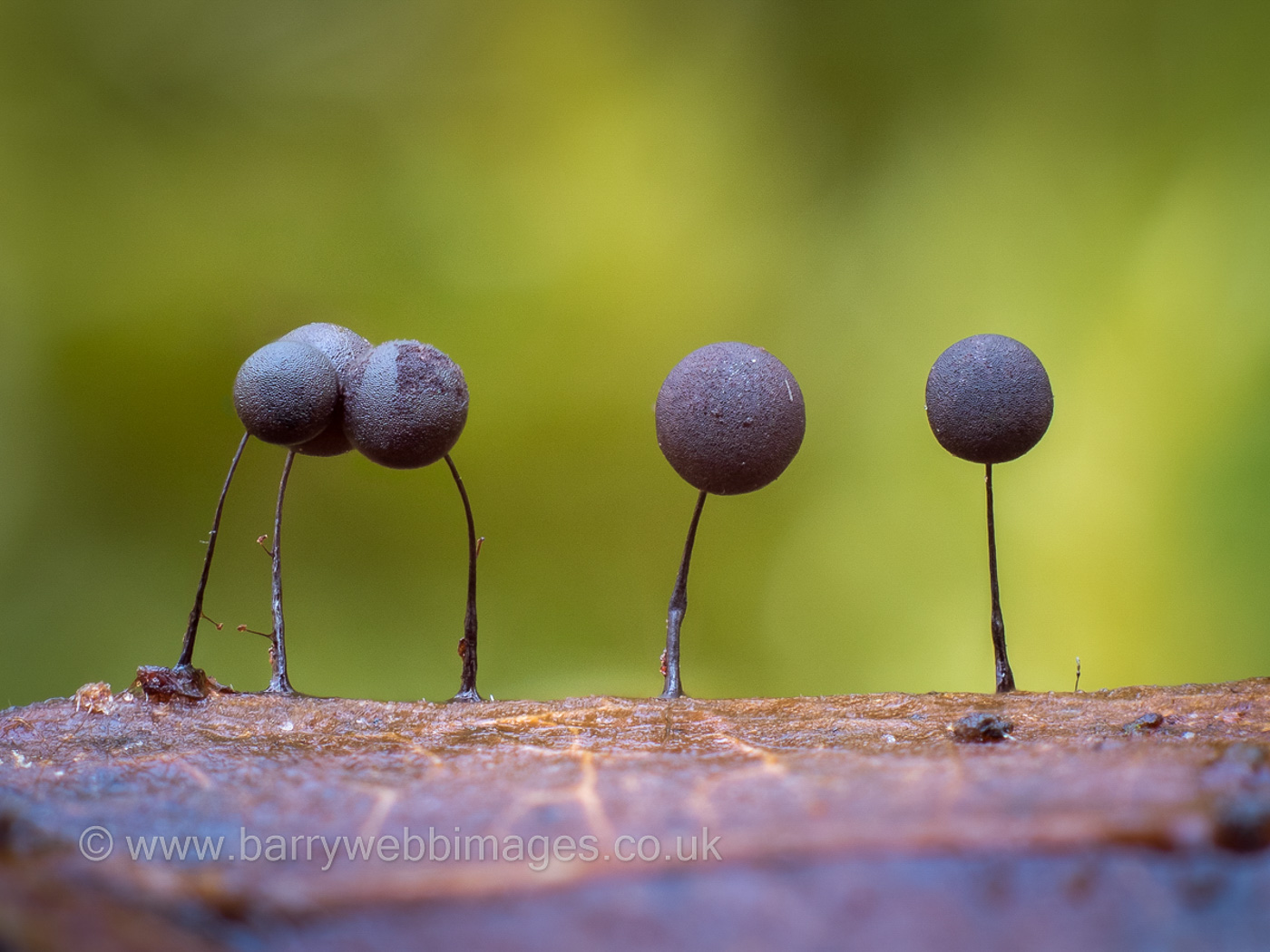
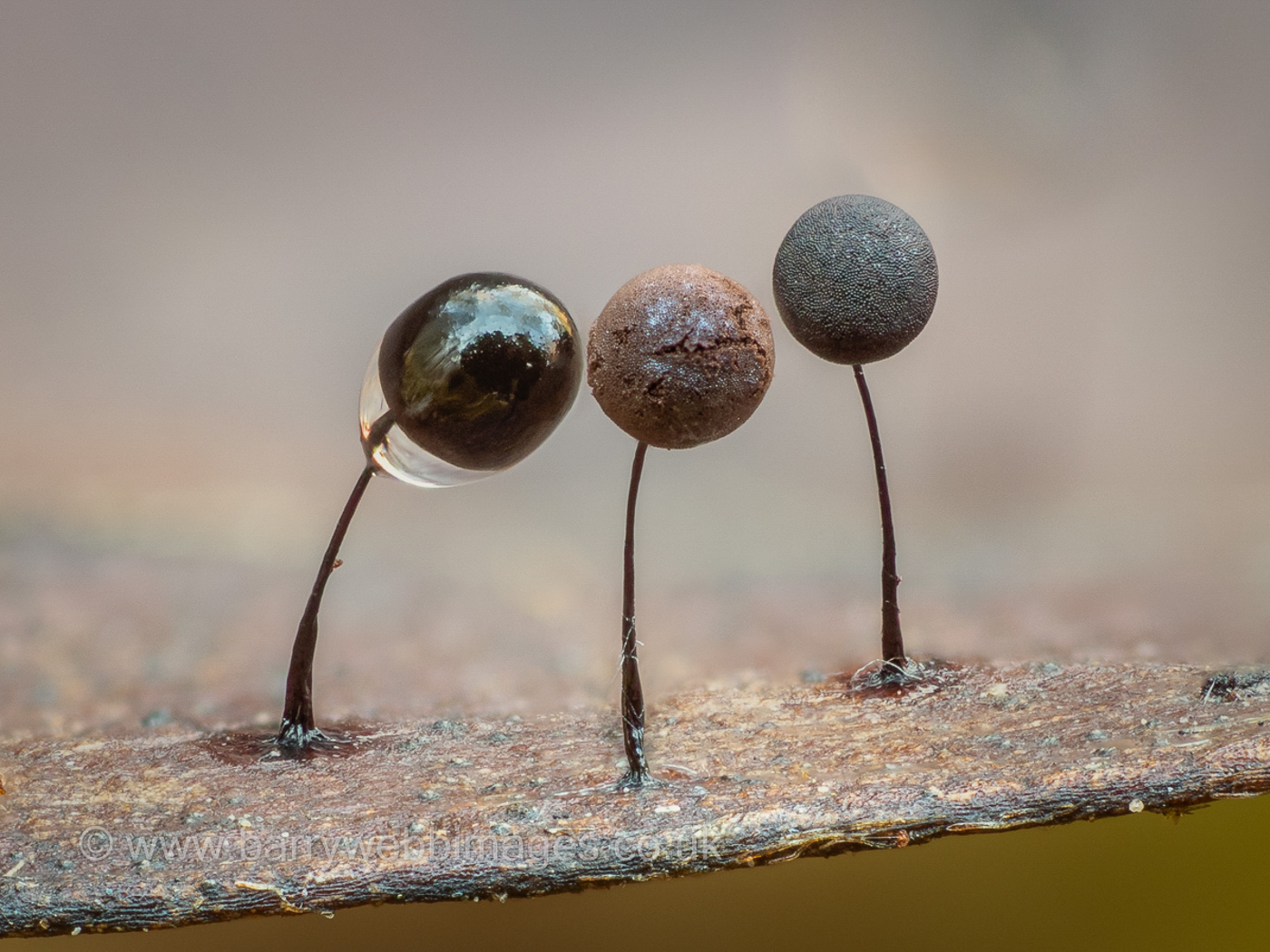 |
Collaria (= Comatricha) lurida (a slime mould with no common name)
Mar 29, 2021. Barry Webb found this very rare Myxomycete in Burnham Beeches on Holly and Beech leaves in a woodchip pile. The species is, however, extremely similar to the much less rare C. elegans, so Penny was a bit sceptical about this determination (made from Barry's excellent photos by a Myxomycete expert online) until Barry said he'd been asked to include a photo of a specimen with the spore mass blown away, revealing the distinctive shape of the columella within (like the skeleton) as well as the collar which forms beneath. The two species are easily separated by their individually shaped columellas, also C. lurida occurs on deciduous leaves, particularly Holly as here, whereas C. elegans occurs on conifer wood - not present in this woodchip pile. Case closed! Not only is this a notable find for the county but there are very few UK records of this species.
|
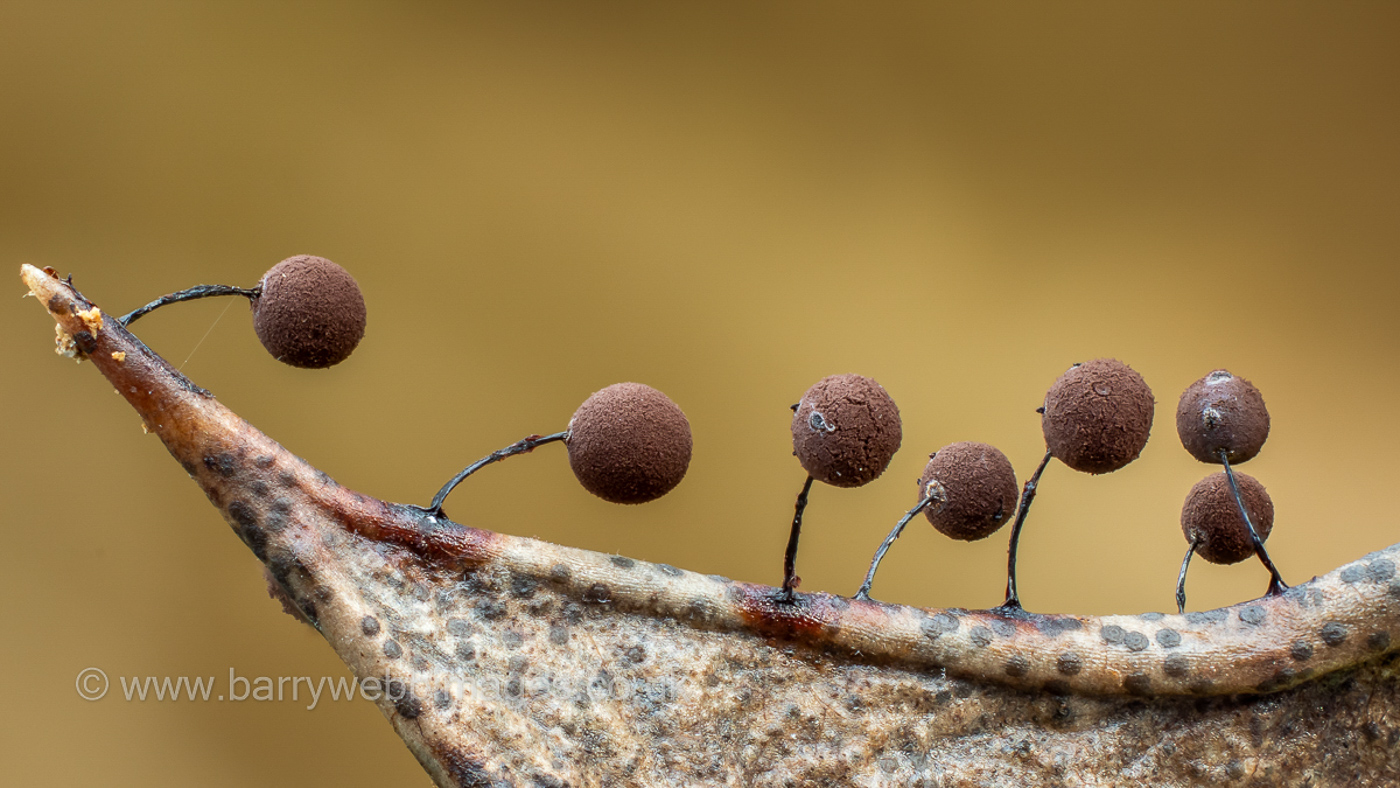
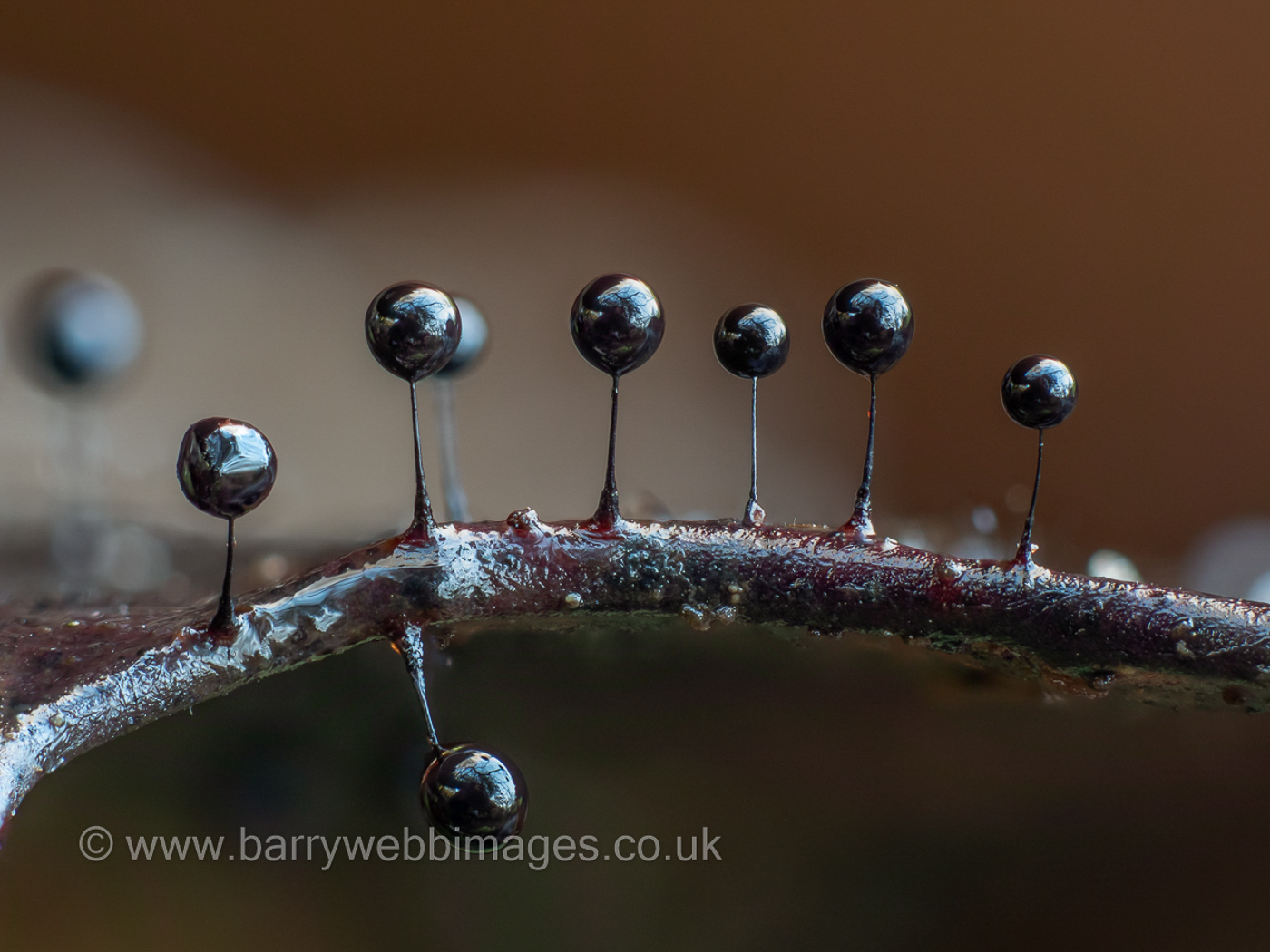
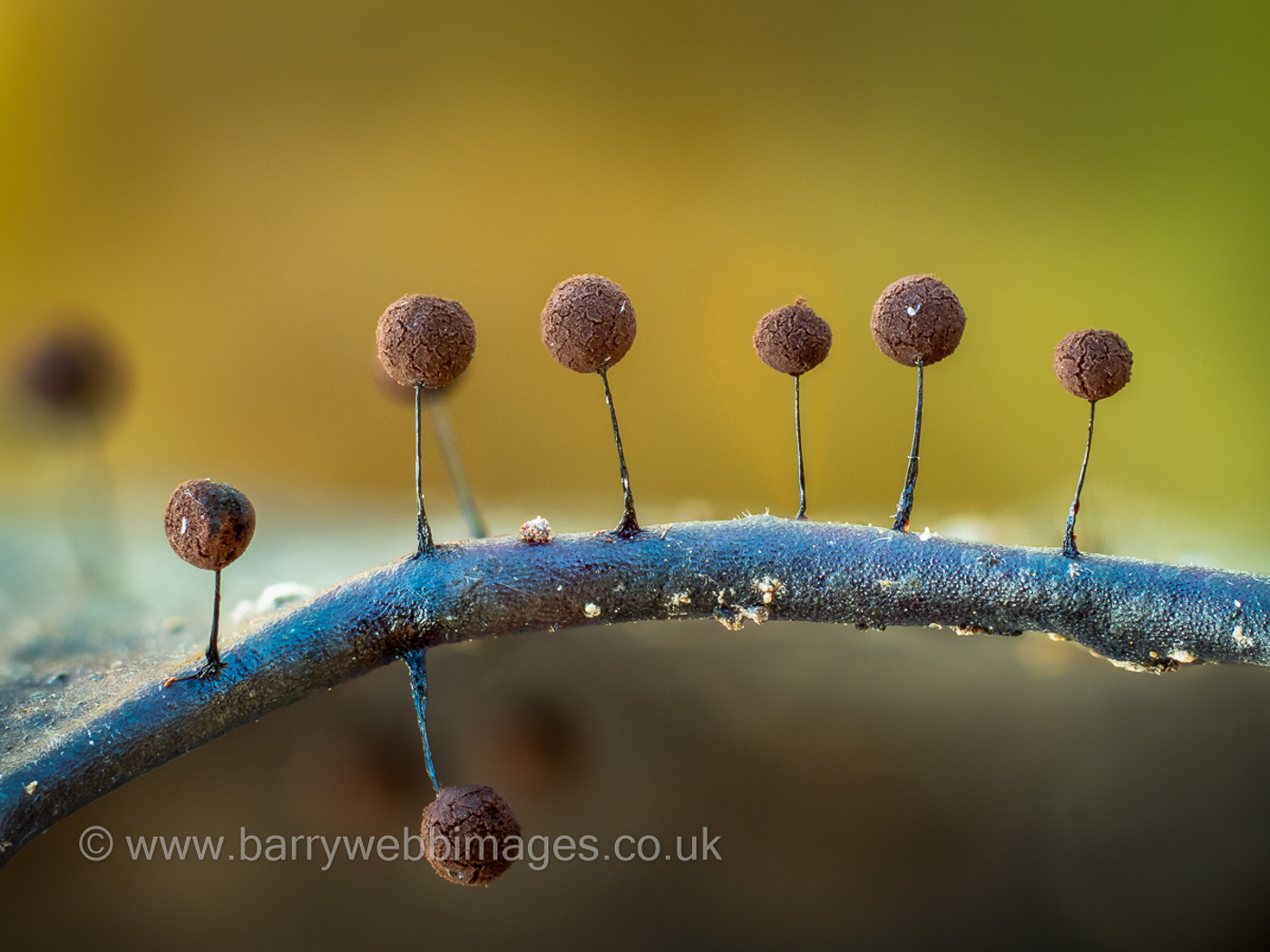 |
Collaria rubens (a rare Slime Mould with no common name)
Jan 6, 2022. In Hodgemoor Woods Barry Webb found no less than six different species (all slime moulds except for Marasmius hudsonii) within one foot of each other under a Holly bush when looking for the Marasmius. C. rubens was the most interesting of them but he was unsure of its identification until Myxo expert Edvin Johannesen confirmed it from Barry's exquisite photos. He then found this rare species again in Naphill Common a week later. Photo1 (Hodgemoor) shows the tiny collar just under the sporangia typical of the species. Photos 2 and 3 (Naphill) show both immature and mature specimens. The species is described as occurring in leaf litter, especially Ivy and Holly as here. This is yet another Slime Mould new to the county. (For more examples of the genus go to Barry's separate page on Finds.)
|
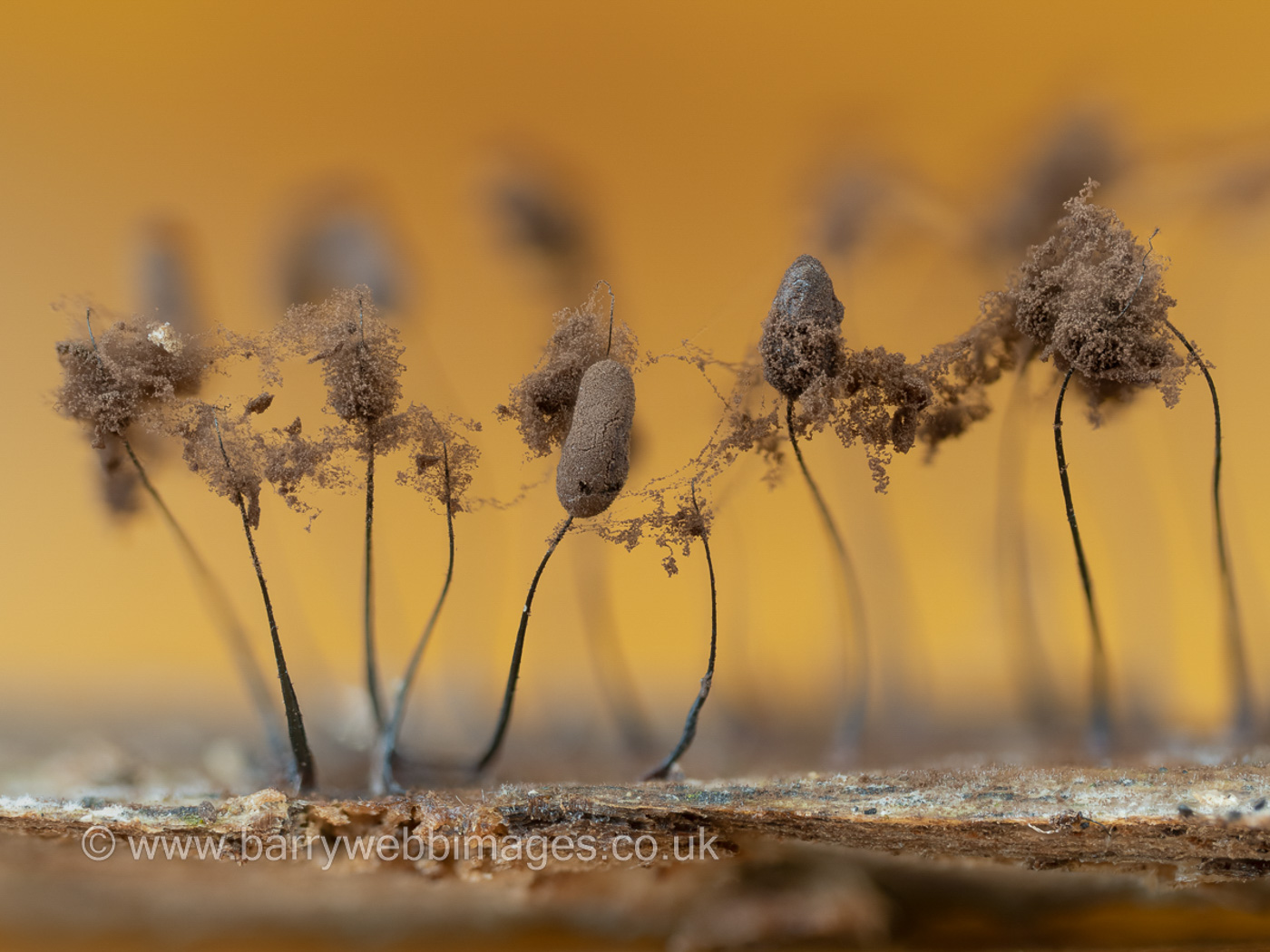 |
Comatricha alta (a slime mould with no common name)
Dec 5, 2023. In Burnham Beeches on a large fallen rotten Beech Barry Webb found this delicate, tiny and rare species which was identified for him from his photo by Myxomycete expert Edvin Johannesen. The photo shows sporangia in various stages of development, each organism less than 5mm tall. This is new to the county as well as to Finds.
|
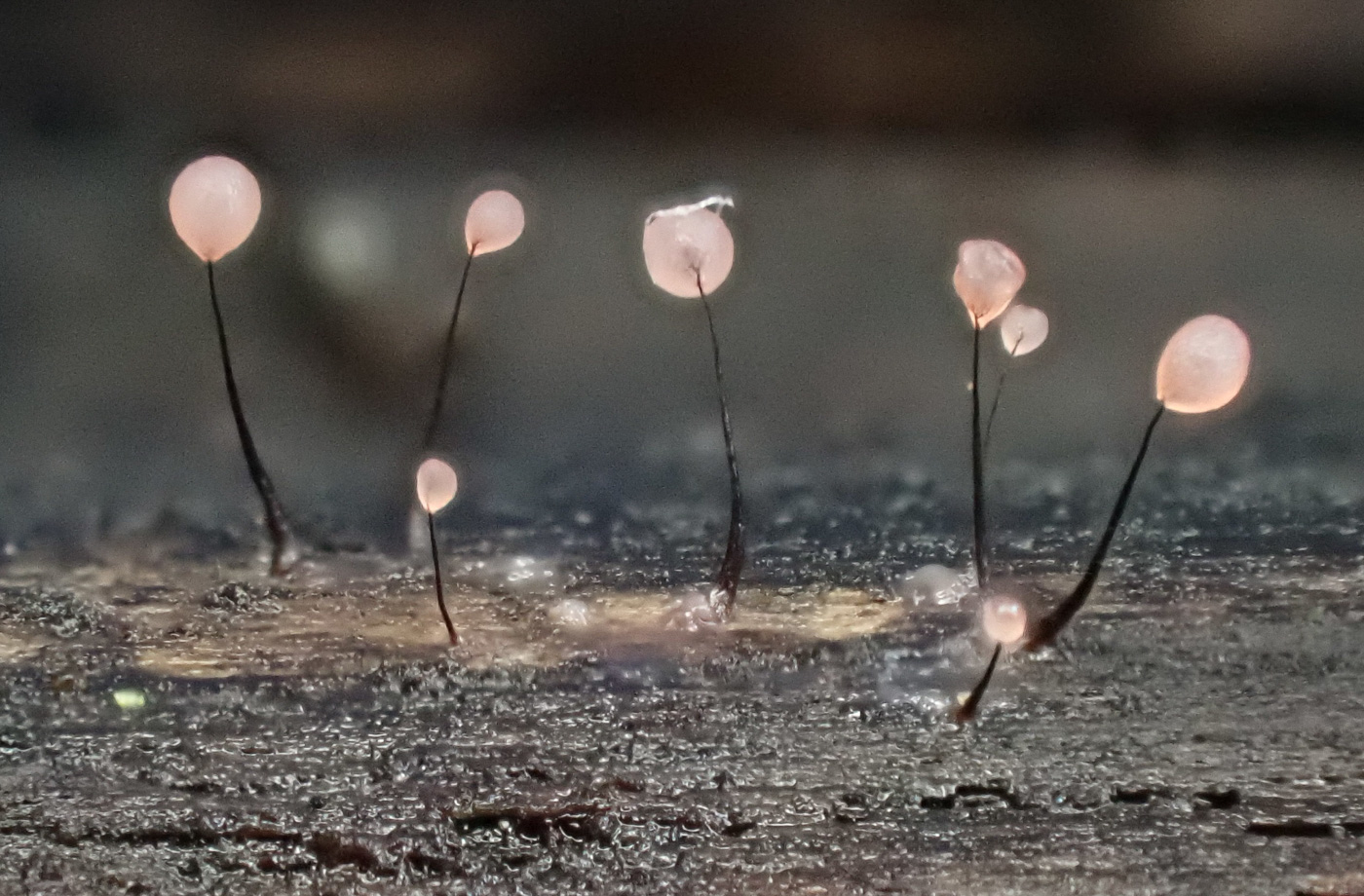
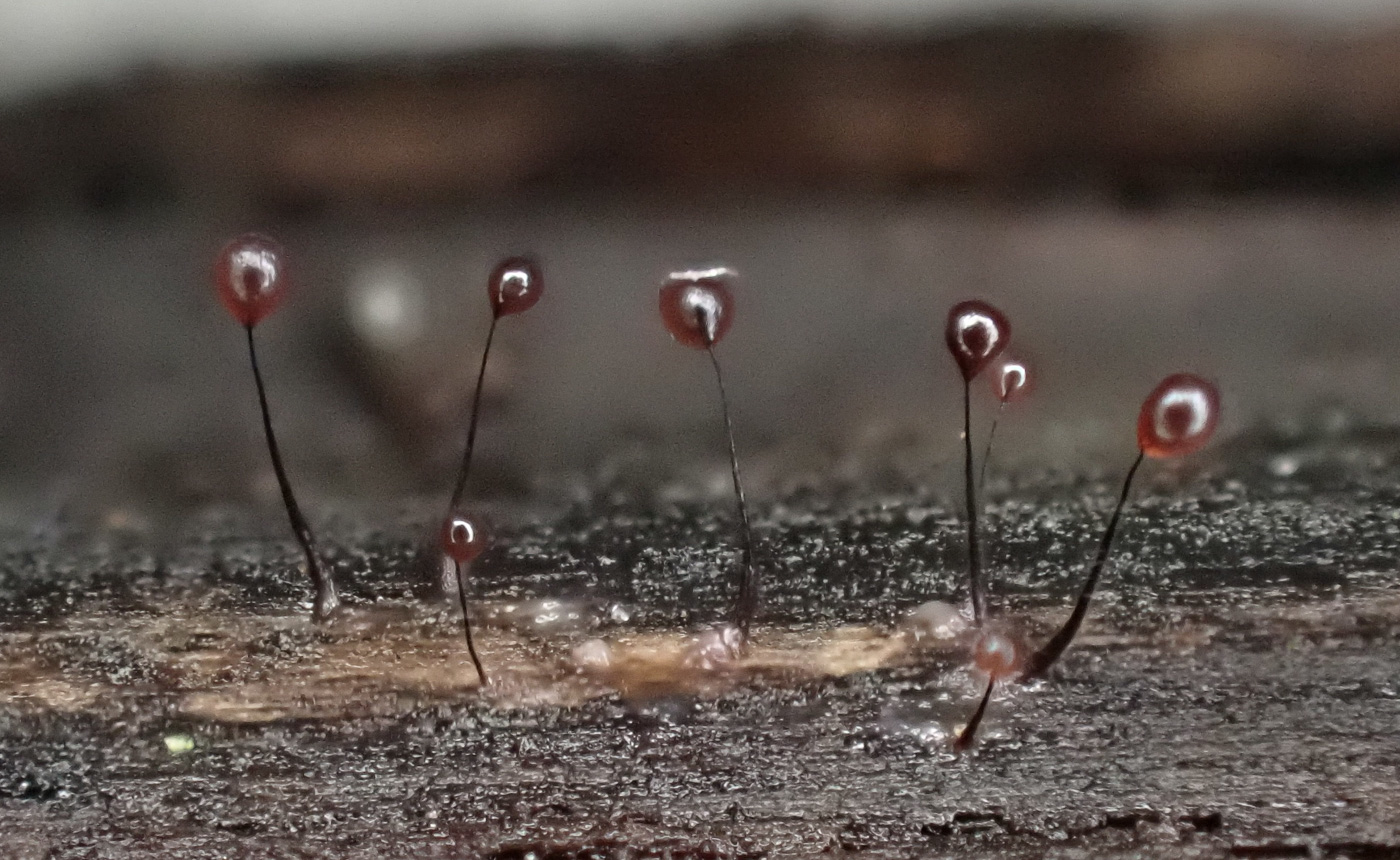
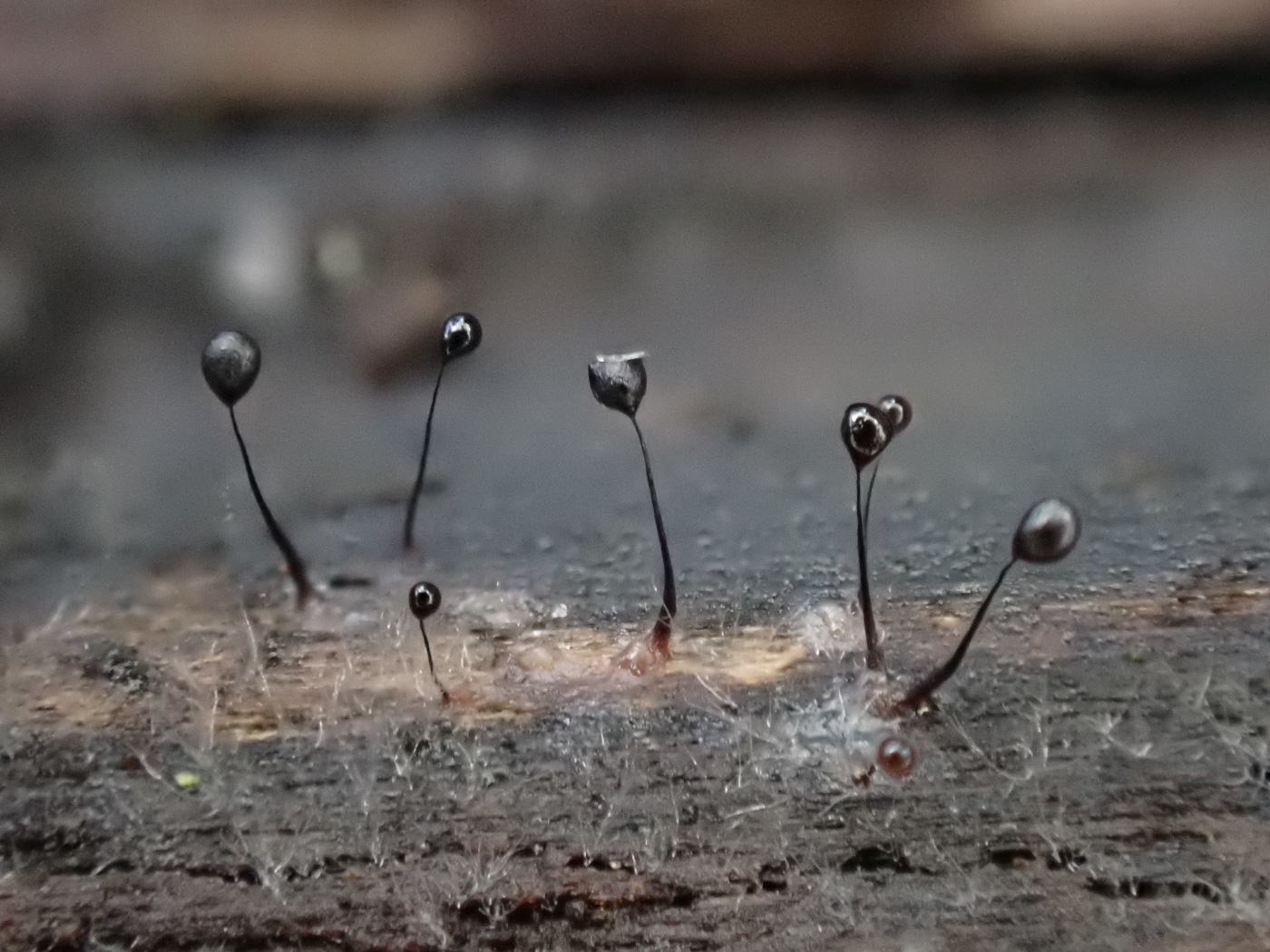 |
Comatricha nigra (a slime mould with no common name)
Nov 12, 2022. In Rushbeds Wood on our BFG Walk Stephen Plummer spied this tiny slime mould on a damp bare stick. It was still at the immature pink-headed stage, so he took it home taking a shot straight away, another that evening, then a third the following morning when the tiny heads had matured to black, hence images of all three colour stages seen here. This is a first for Finds though there is a superb image of the pink stage on Barry's separate slime moulds page on Finds.
|
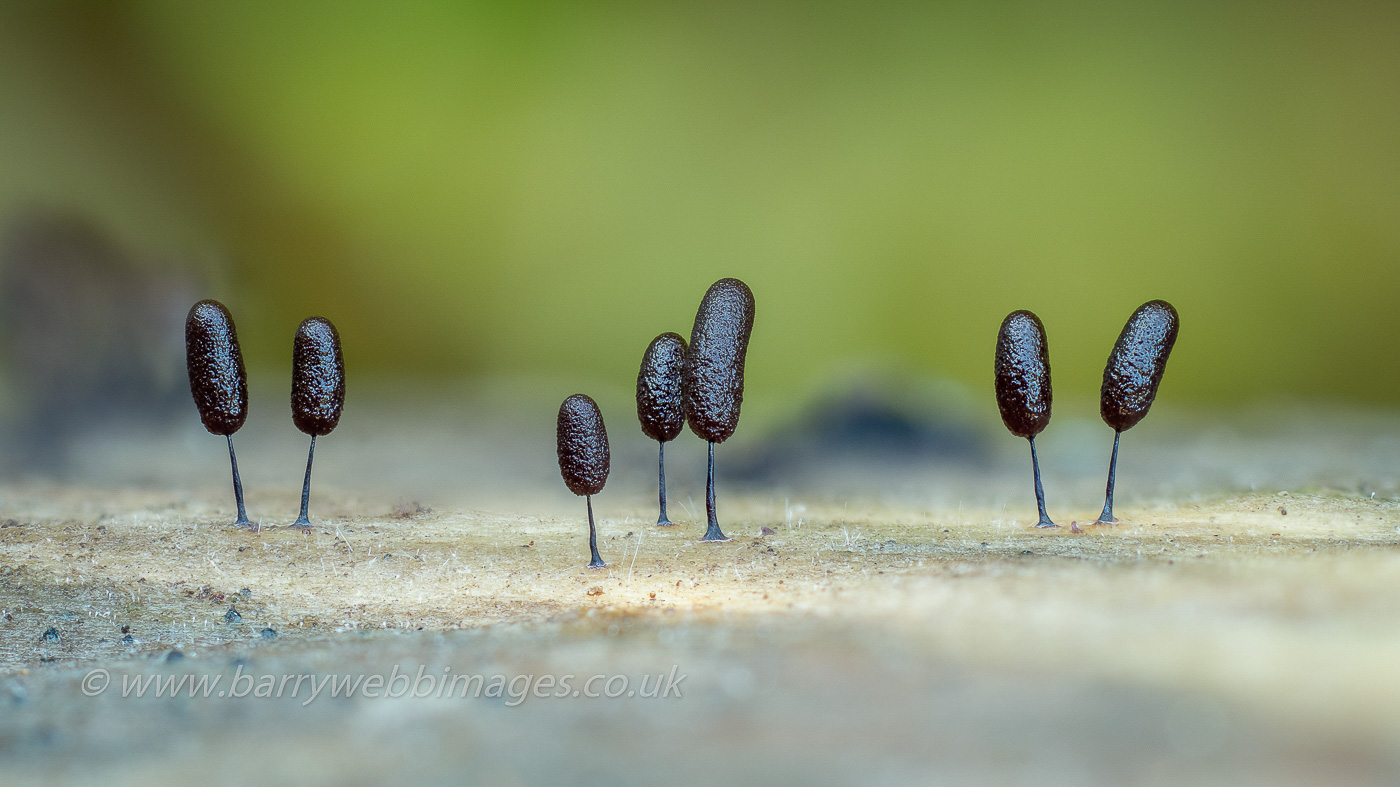 |
Comatricha pulchella or anomala? (a Slime Mould with no common name)
A beautiful photo, by Barry Webb, of a species which, however, needs confirmation using a microscope which was unfortunately not able to be carried out here.
|
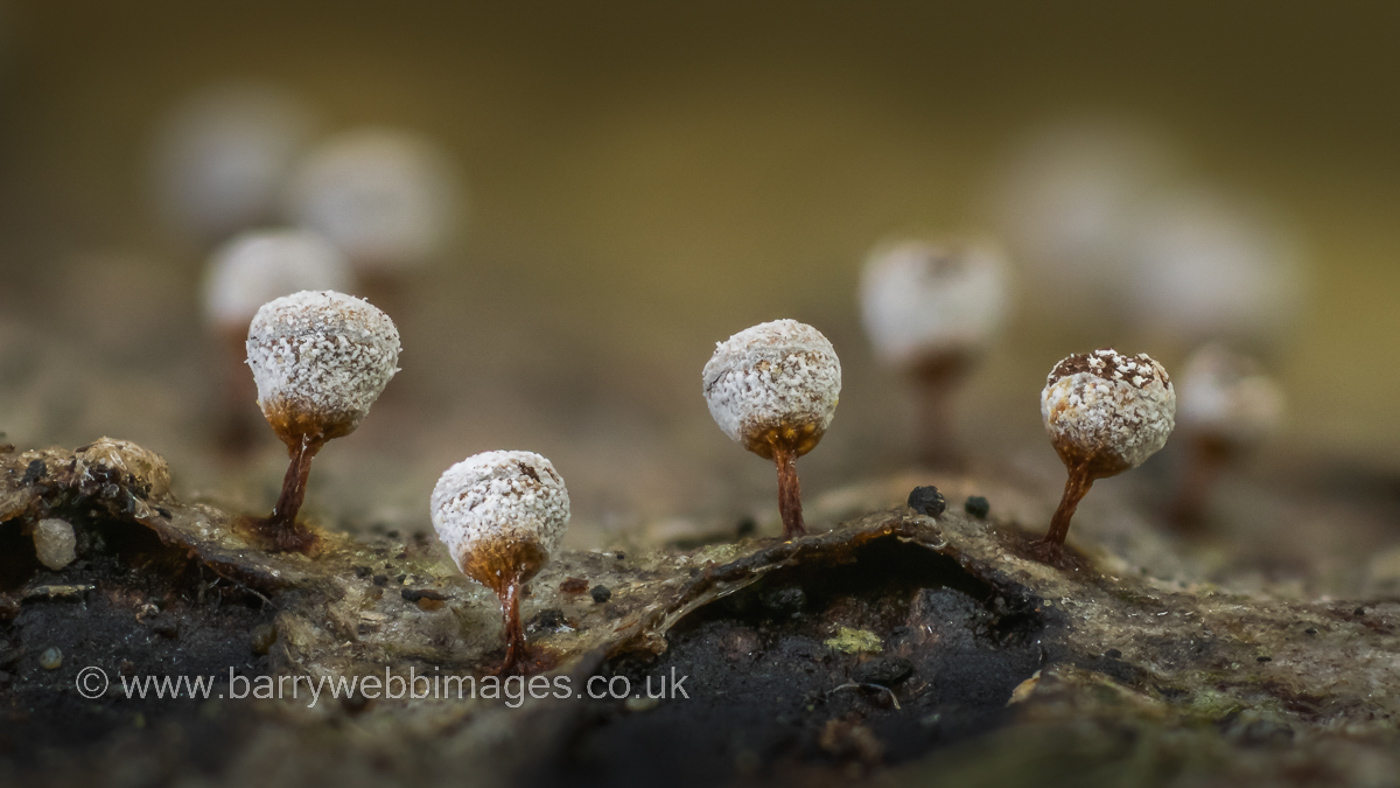 |
Craterium leucocephalum (a Slime Mould with no common name)
Nov 10, 2022. In Round Spring Wood, Dancersend, Barry Webb was delighted when Stephen Plummer found these tiny forms on wood because it was a species he'd never encountered before. The species is relatively rare and we have just one previous county record made by Myxomycete guru Bruce Ing in 1991 from Salcey Forest. As most of that area is in fact in Northants it is tempting to count this a a first for the county! It is certainly a first for Finds. The photo is, of course, Barry's.
|
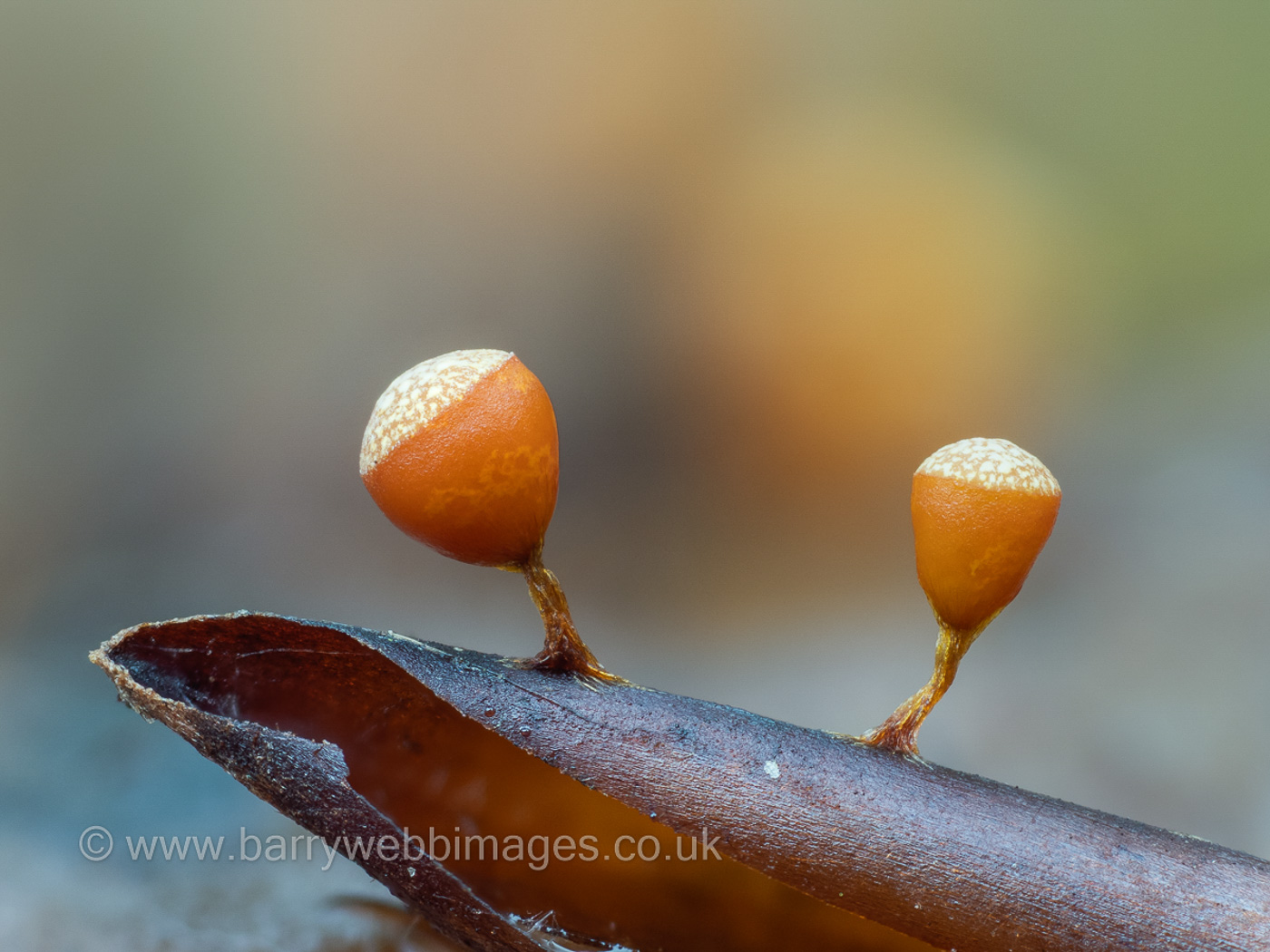
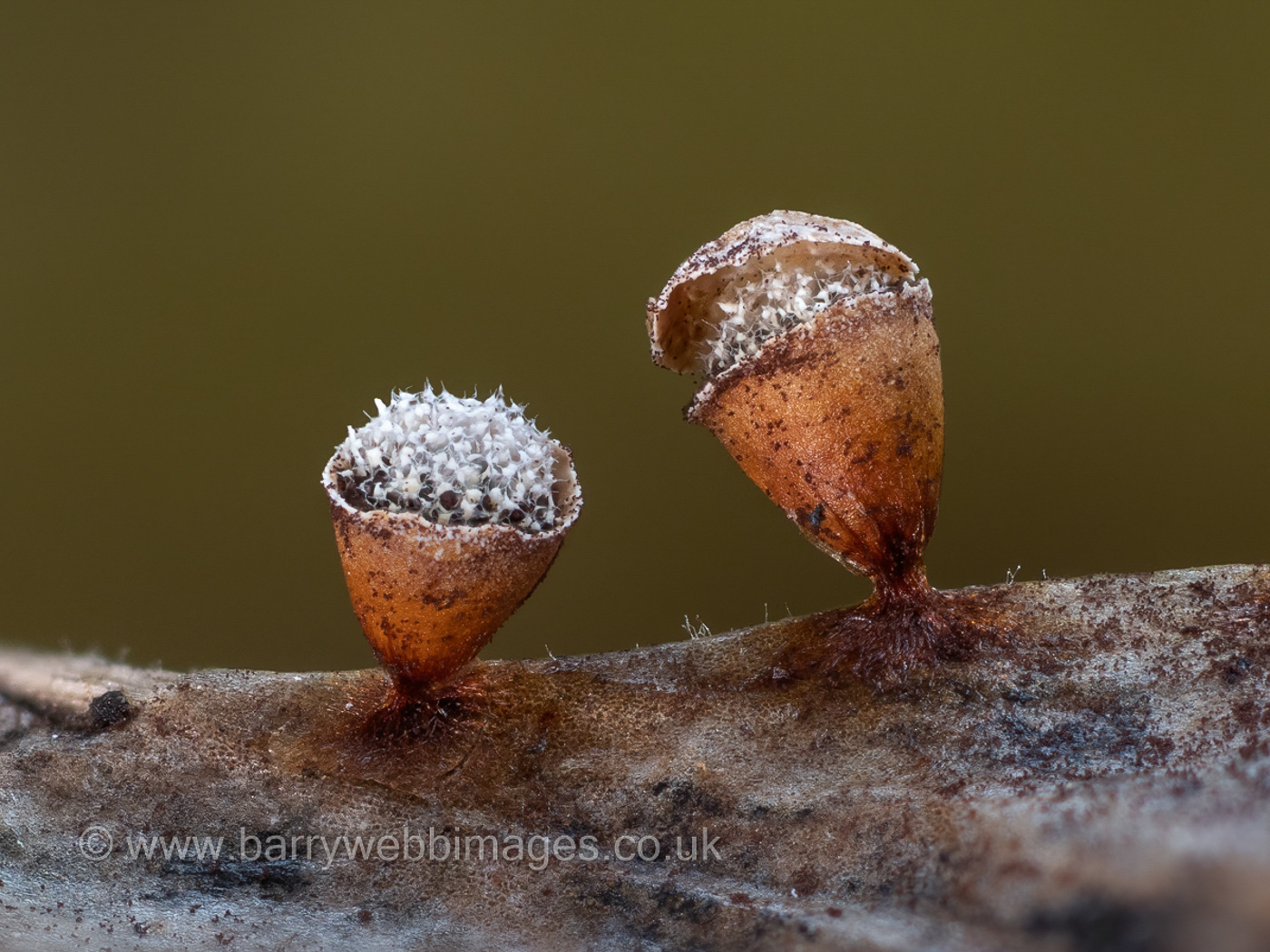 |
Craterium minutum (a slime mould with no common name)
Mar 14, 2021. Barry Webb found these tiny little beauties in Burnham Beeches on a woodchip pile. These miniscule wine goblets are only about 1 mm high, each initially covered by a flat lid which in the RH sporangium in photo 2 can be seen just lifting off to reveal the spore mass beneath. This is a distinctive species, its shape together with the ochre colour and lid making it recognisable in the field. We have just two previous county records though this appears to be a first for Burnham Beeches.
|
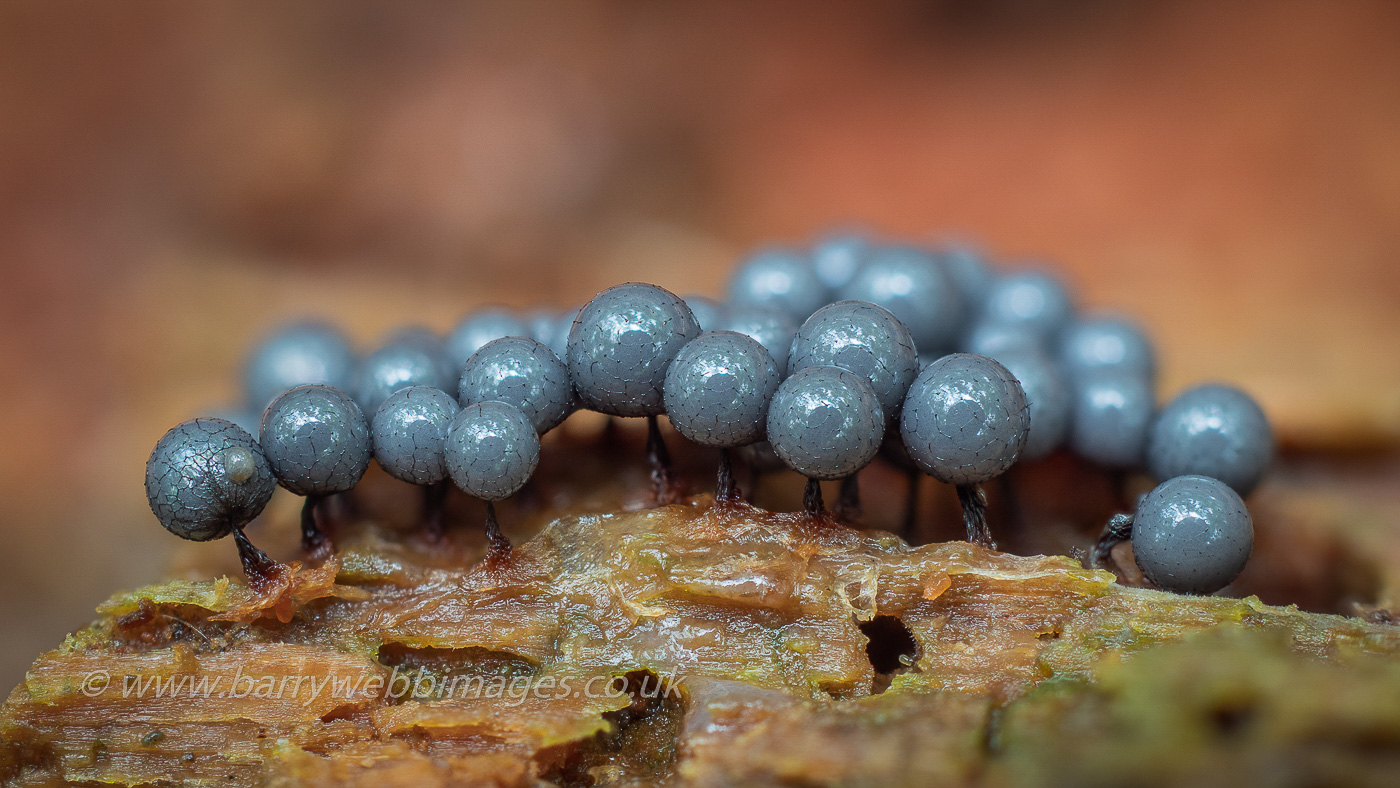
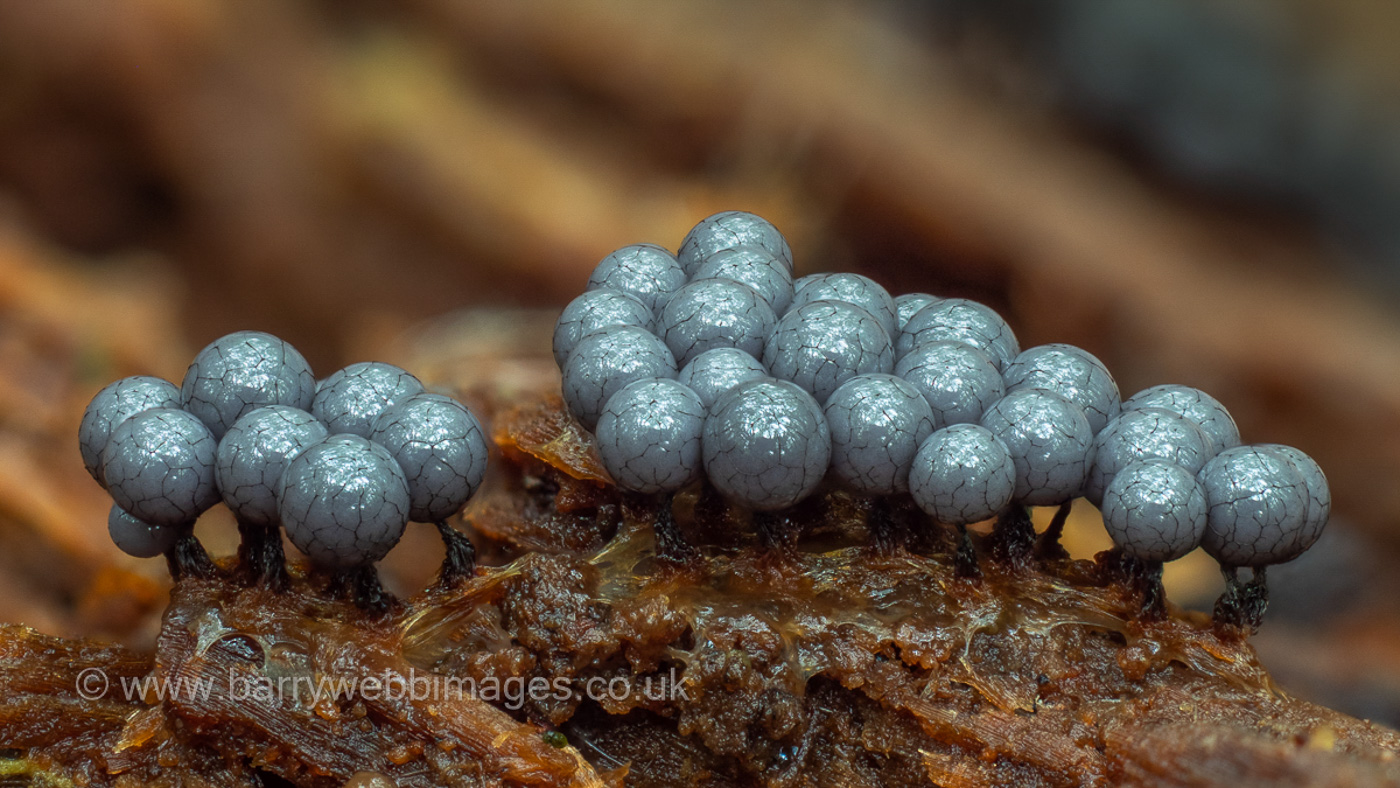
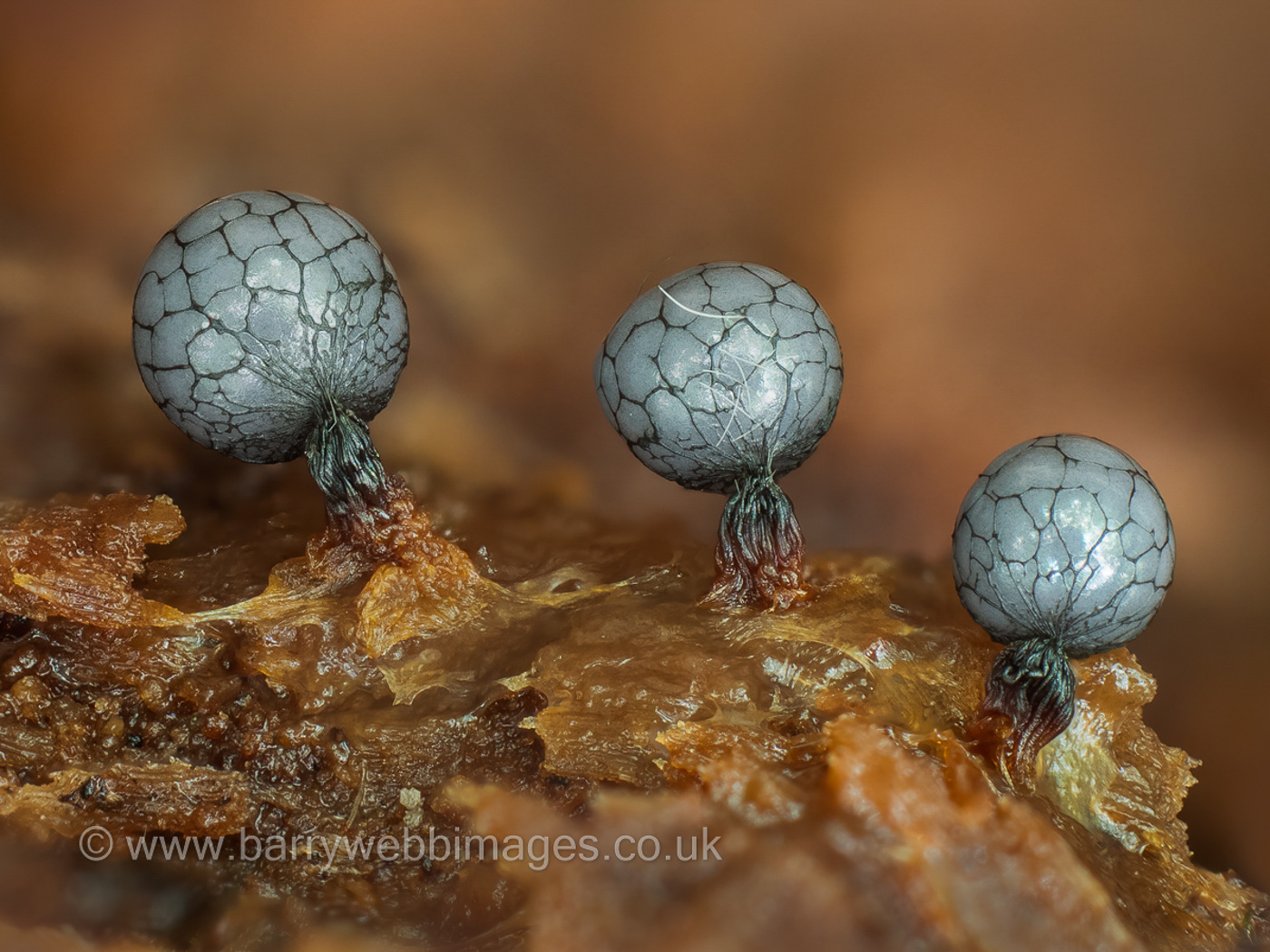
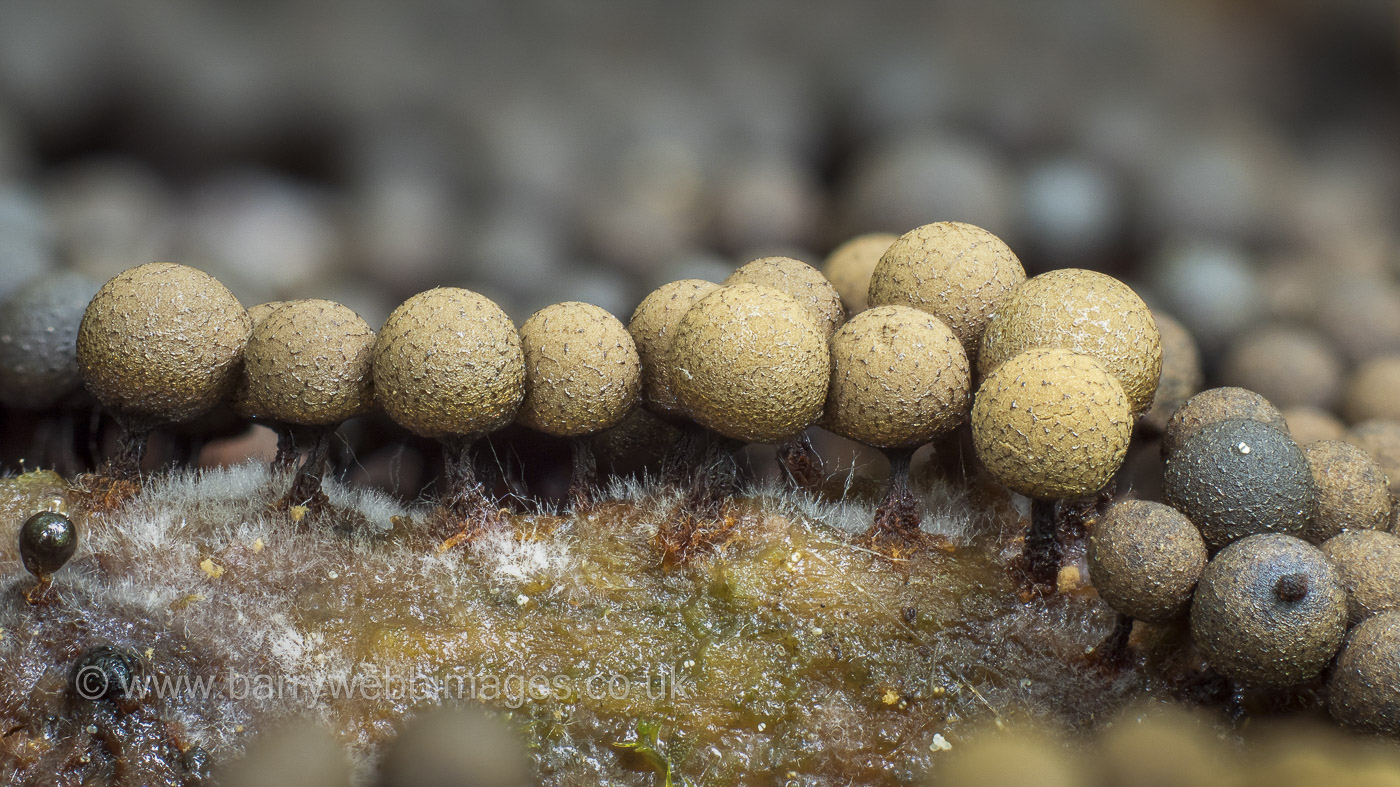
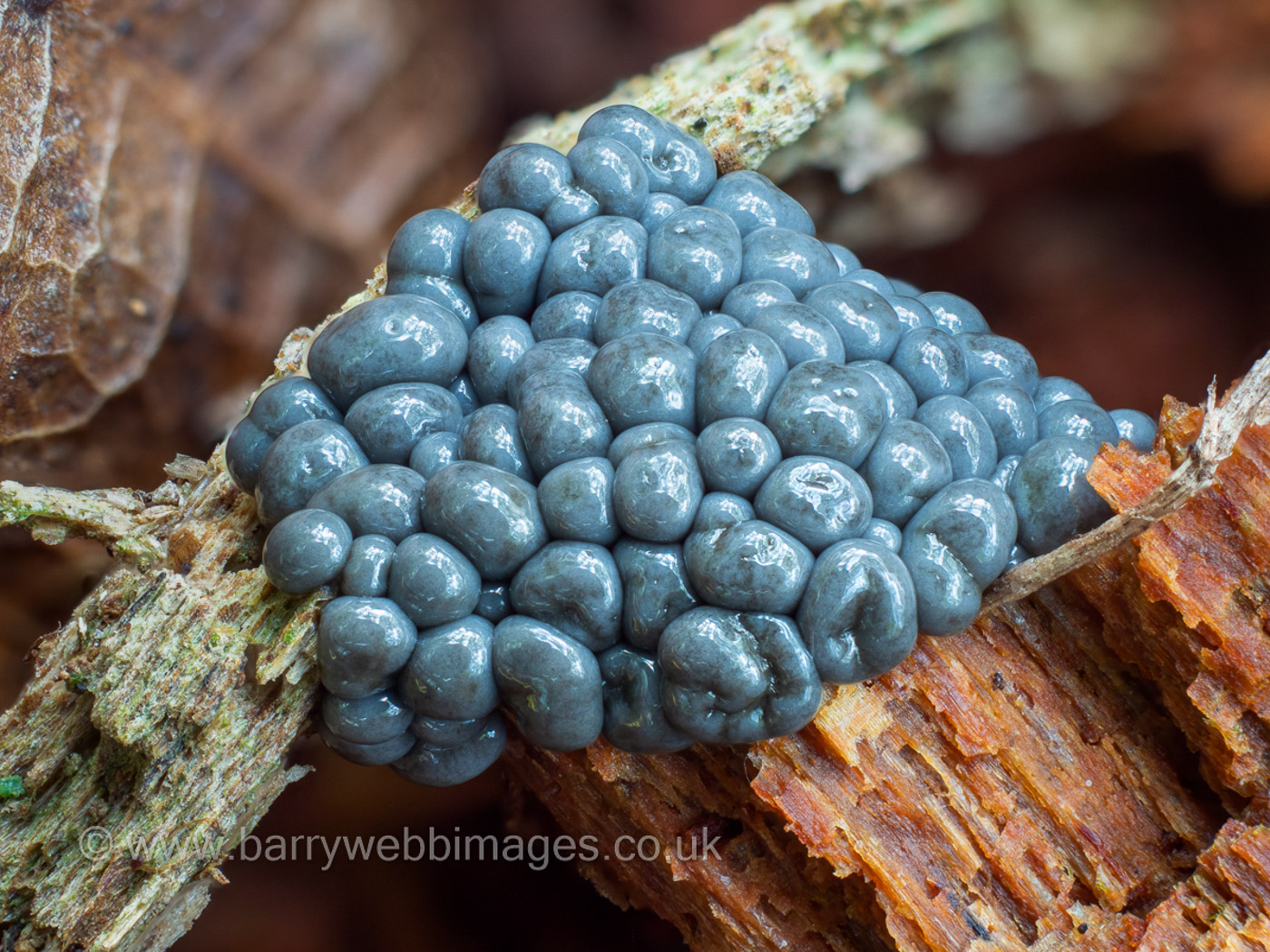
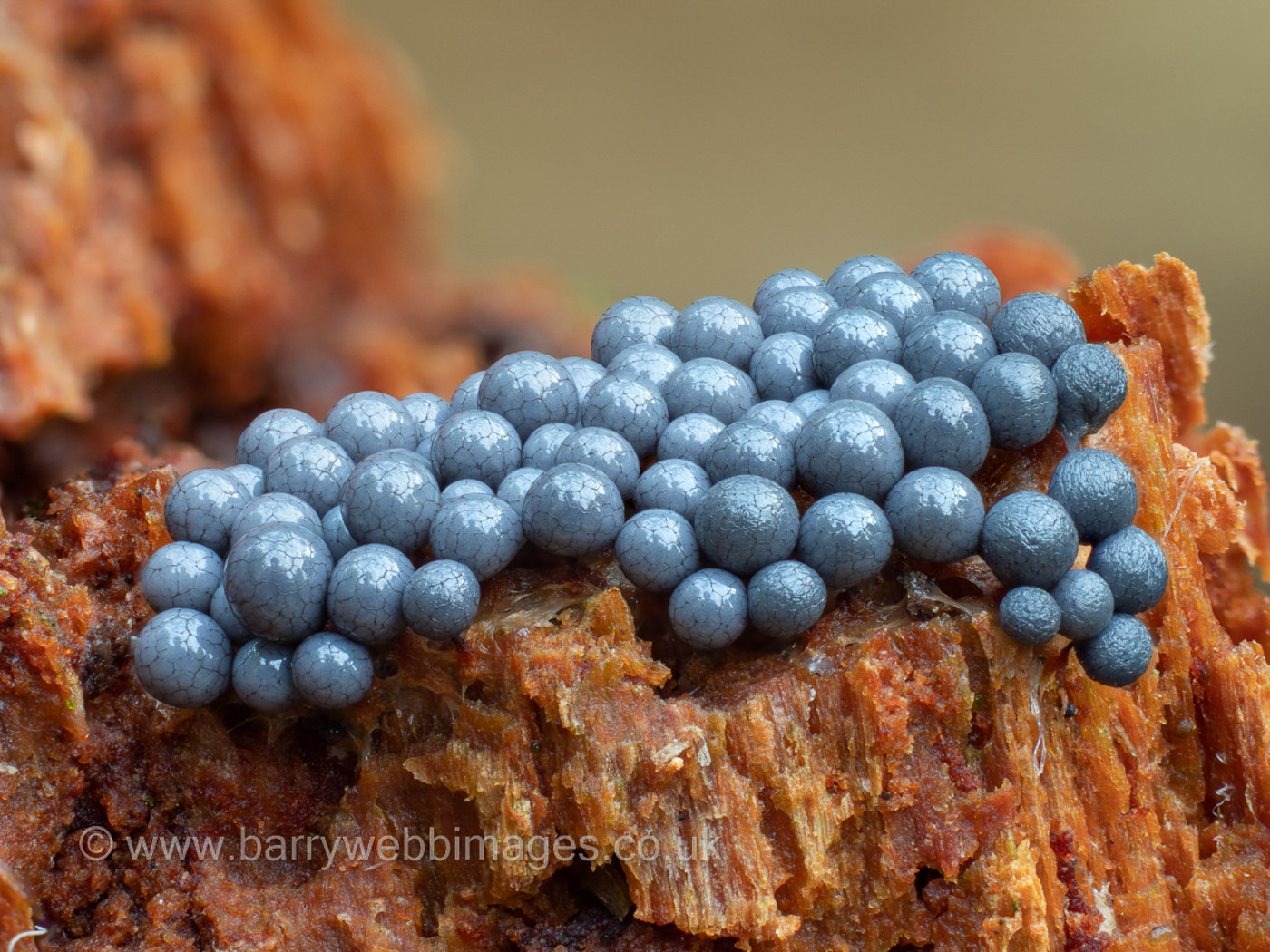
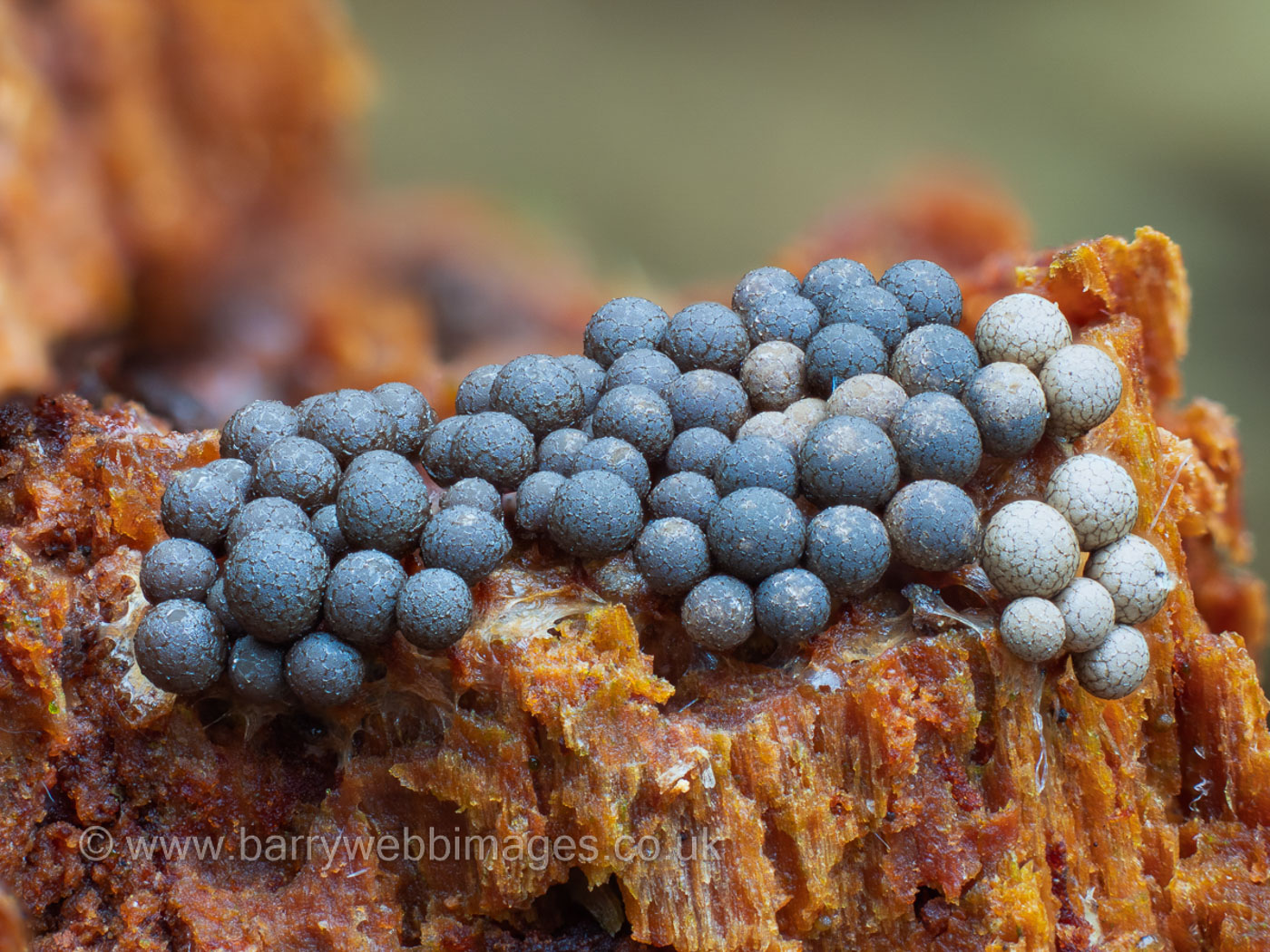
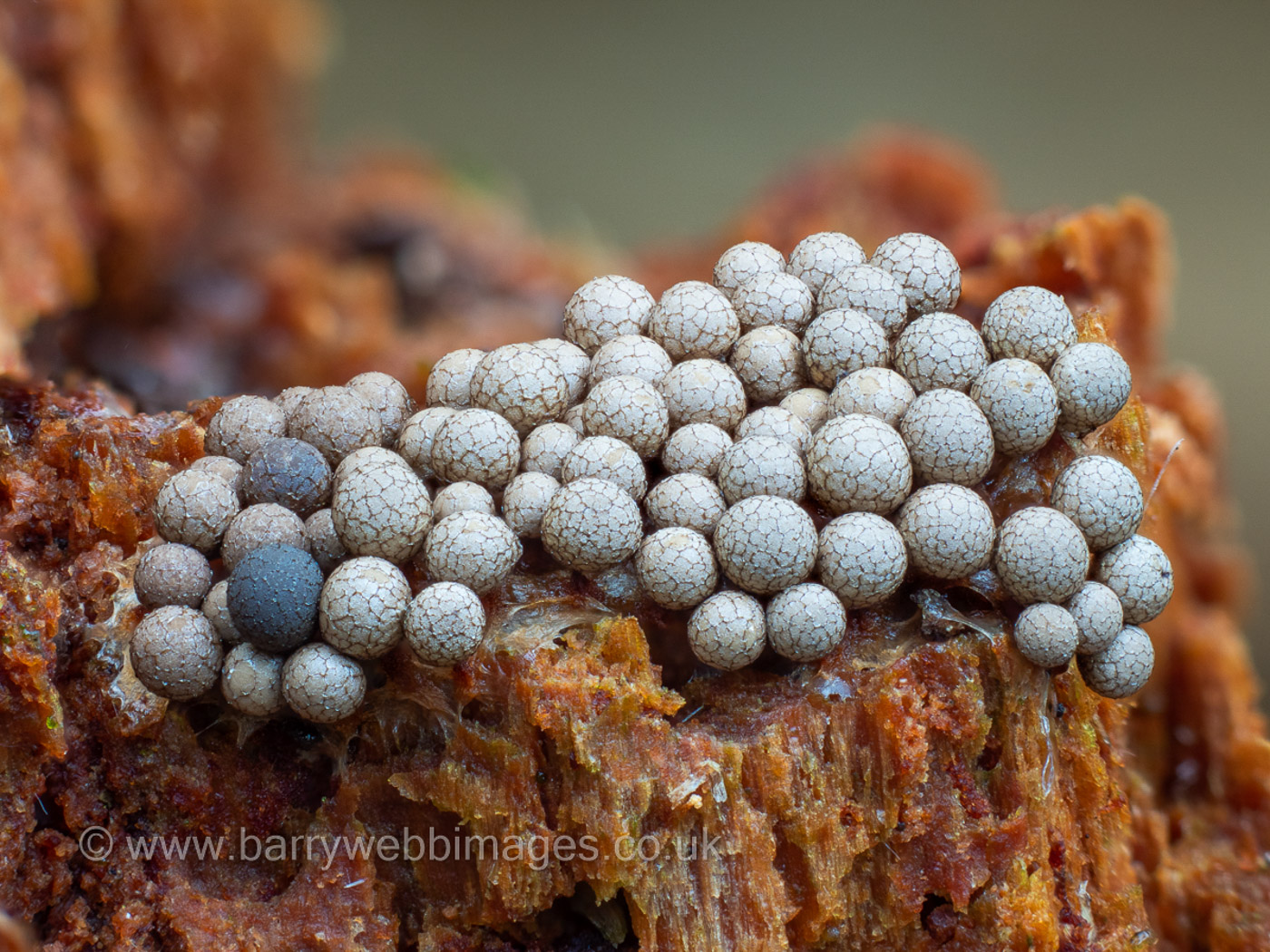 |
Cribraria argillacea (a slime mould with no common name)
Sep 7, 2020. In Burnham Beeches Barry found this cluster (photo 1) just developing from its plasmodium on rotting Birch and typically slate blue and shiny. Photos 2 and 3 are slightly further developed with a more complete network visible on the sporangia; photo 4 shows the mature ochraceous to clay sporangia, hence the species name meaning clay coloured. The species is characterised by having very short stalks and forming large closely packed colonies. We have just three previous records in the county but this was a first for the Beeches, with subsequent collections from the same site dated 02.08.2021 for photos 2 and 3 on rotting Pine, 09.06.2021 for photo 4 on rotting Birch. Photos 5-8 were all taken at the same time from a colony found at Stoke Common (18.09.2021) where also new to the site. and again showing the development from plasmodium (typically slate blue grey) to almost mature.
|
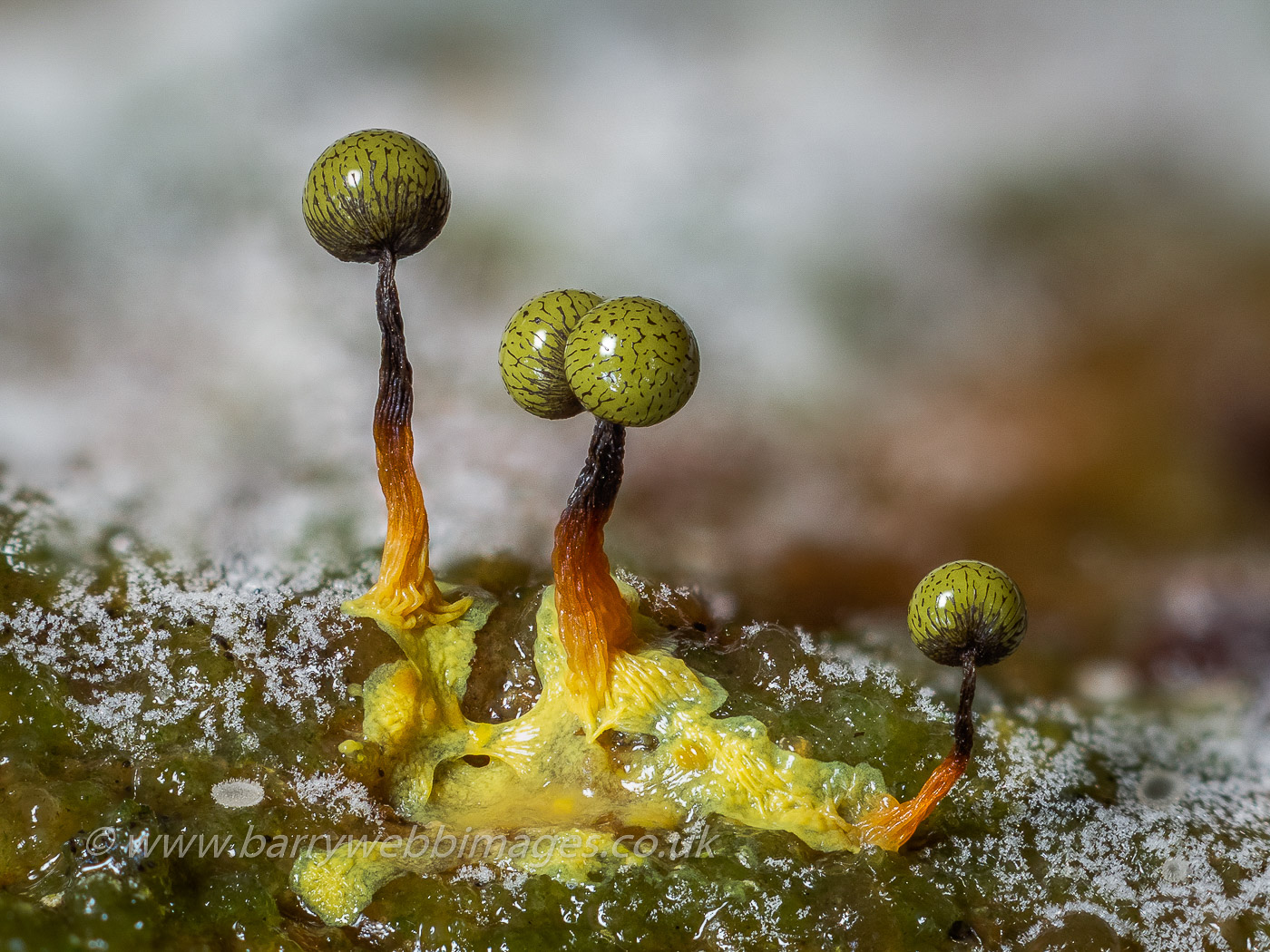
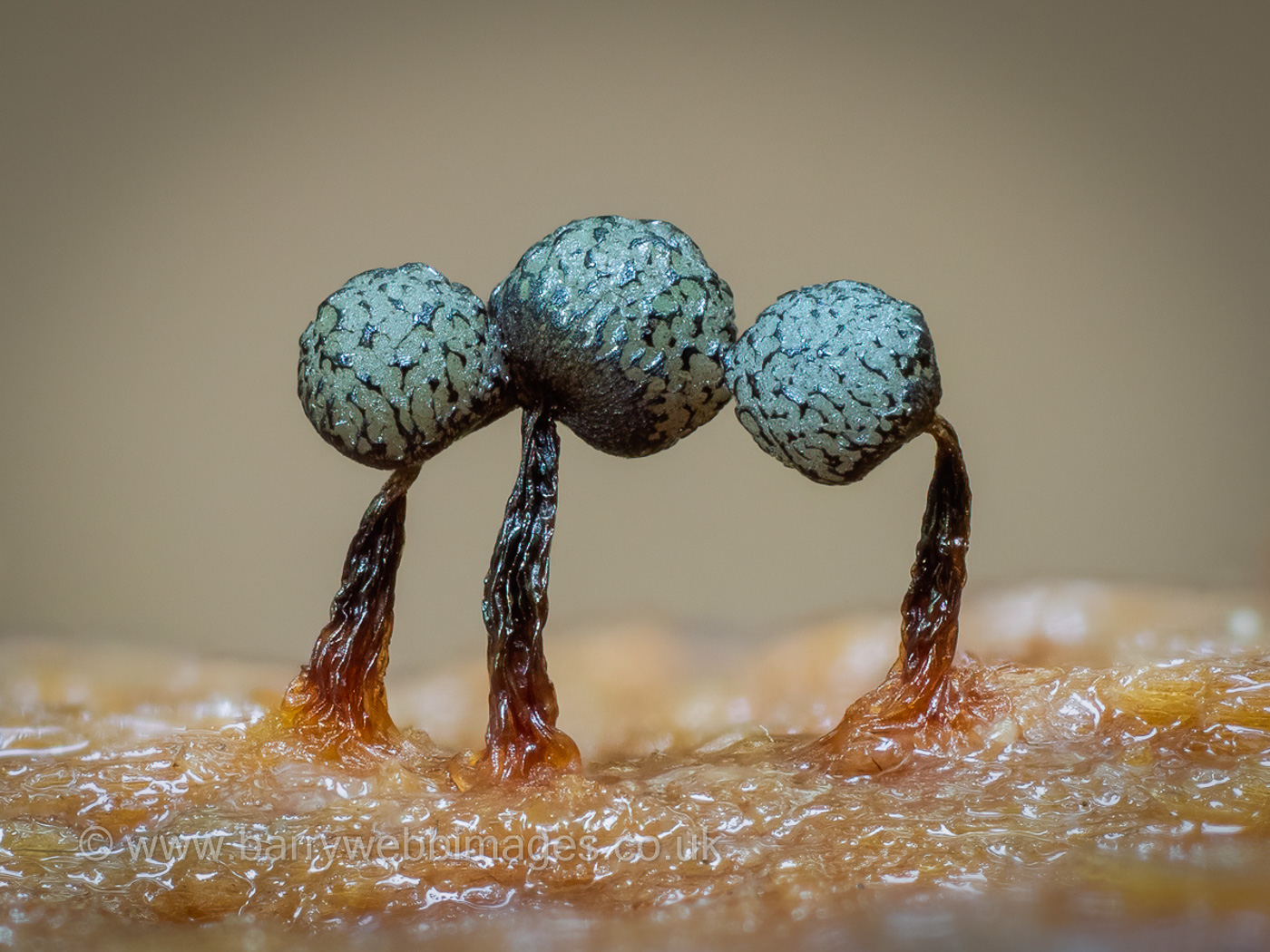
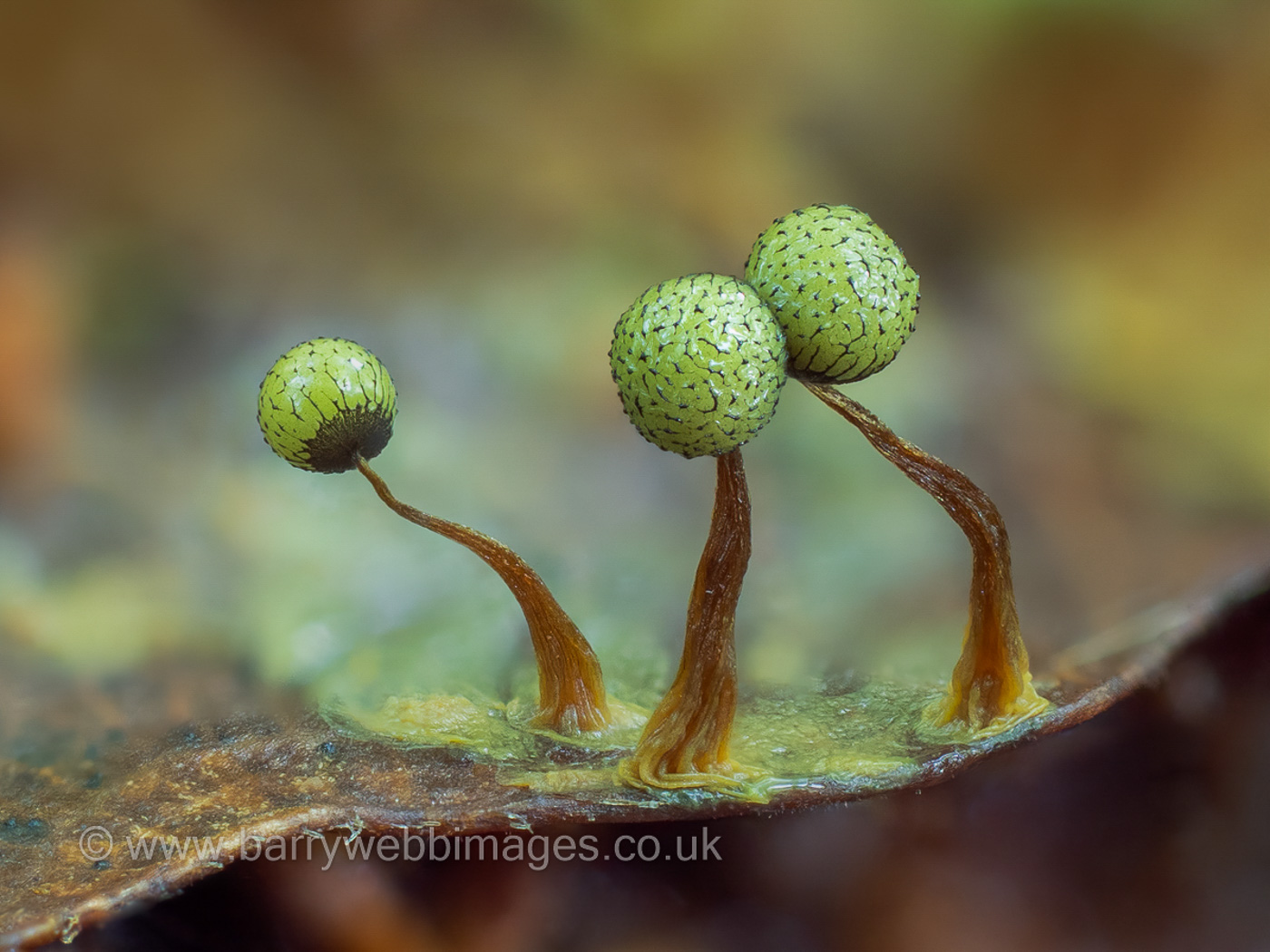
 |
Cribraria aurantiaca (a Slime Mould with no common name)
Aug 28, 2020. In Burnham Beeches on fallen rotting Birch Barry found these exquisite little specimens of what is described as a common species though we appear to have no previous county records. The markedly tapering bright reddish brown stalk is typical, also the bright green plasmodium which can persist at the base. The round sporangia develop through green to blue then eventually ochre orange when mature, retaining this amazing meshlike network which characterises the genus (like a crib or cradle?). The whole is only 2 mm tall. Subsequent photos are of collections made the following year at the same site, the stunning blue specimens found on 19.06.2021, the green specimens on 22.07.2021, and more mature material on 02.08.2021 on rotting Pine.
|
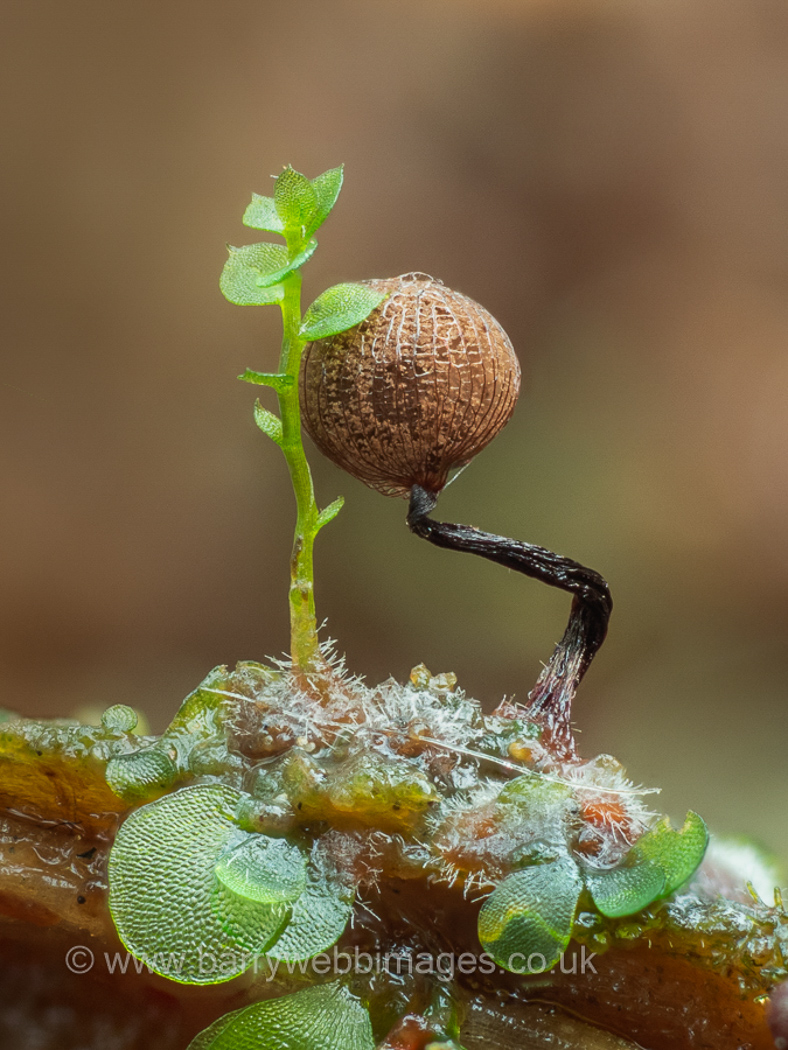
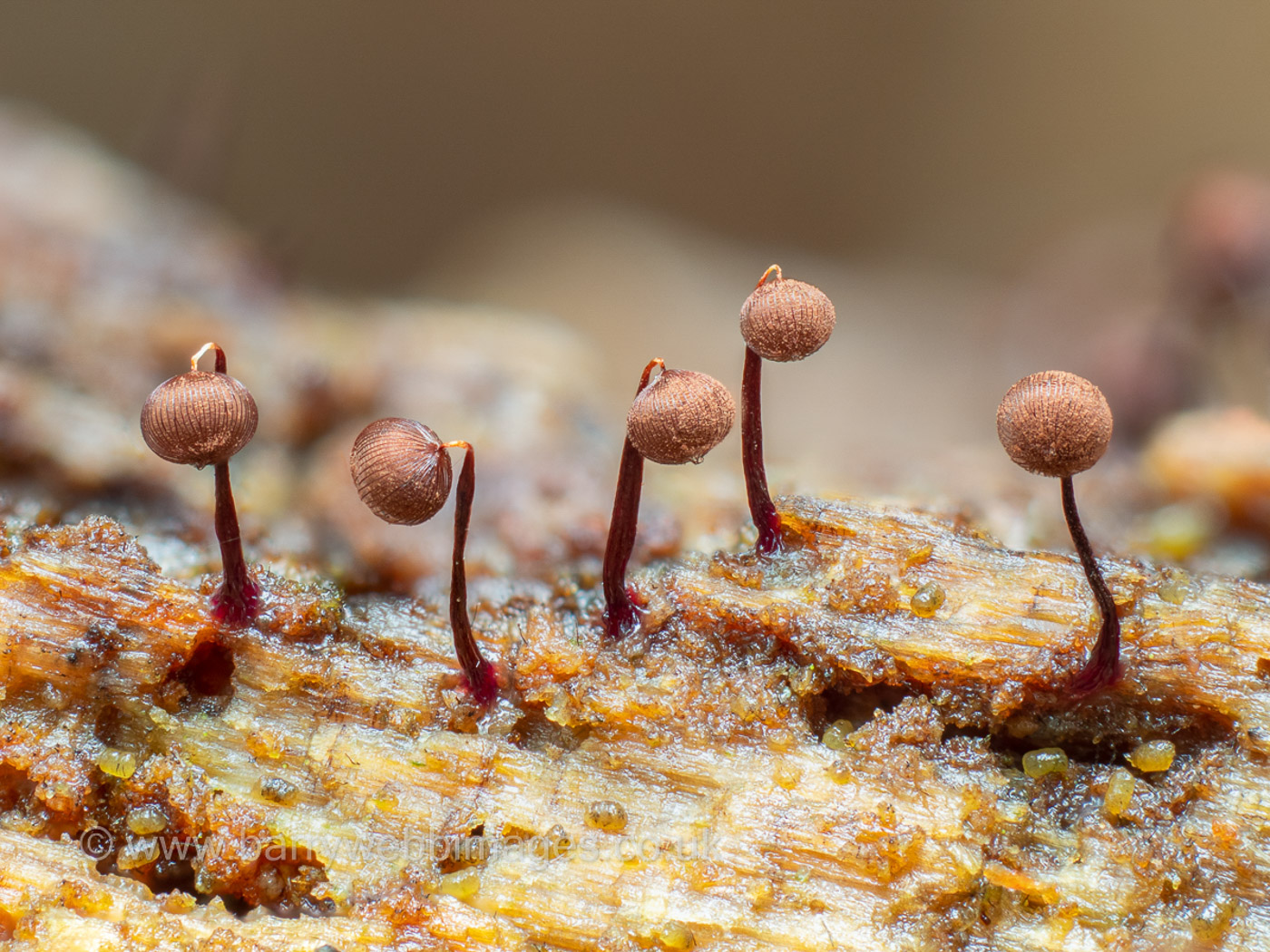
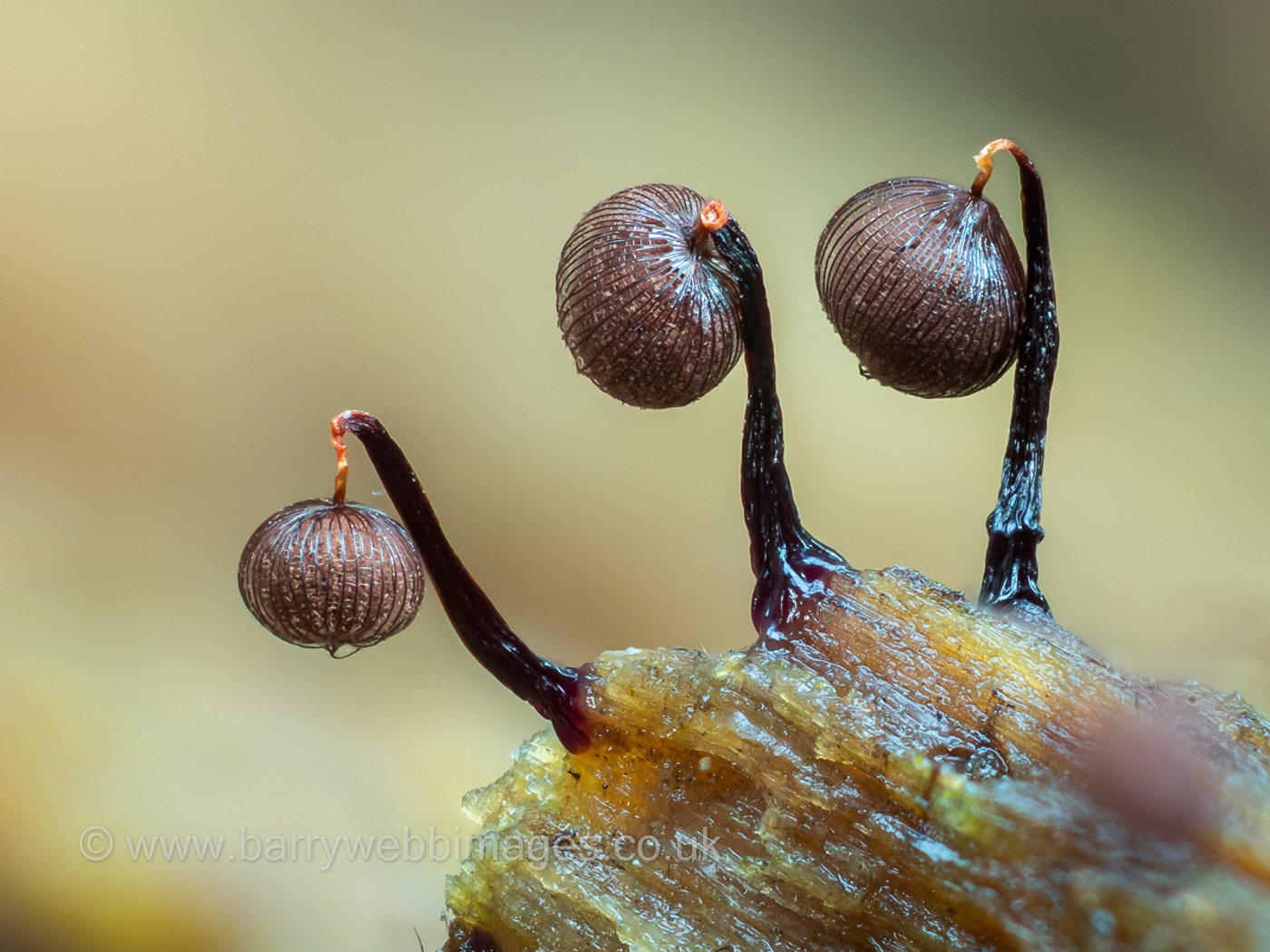 |
Cribraria cancellata (a Slime Mould with no common name)
Jul 6, 2021. In Burnham Beeches on rotting fallen Pine Barry found this tiny but beautiful species which was new to the site and with just one previous county record - notably found by the distinguished Myxomycete specialist Bruce Ing from Salcey Forest, 1991. All species in the genus have this amazing meshlike network surrounding the head, particularly marked in this species which, however, lacks a 'cup' at the base of the mesh though present in most species. It has purple black plasmodium and a long dark tapering stalk when developed as seen in photo 1. Photos 2 and 3 were found at Stoke Common (18.09.2021), also new to the site there.
|
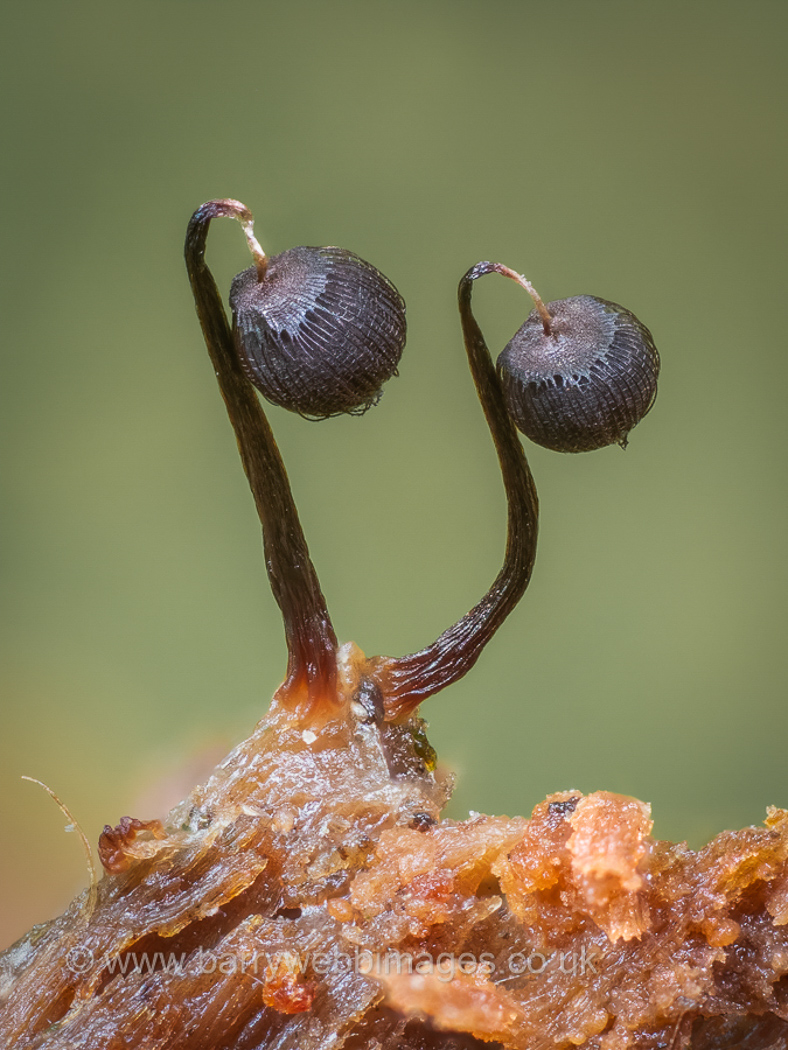
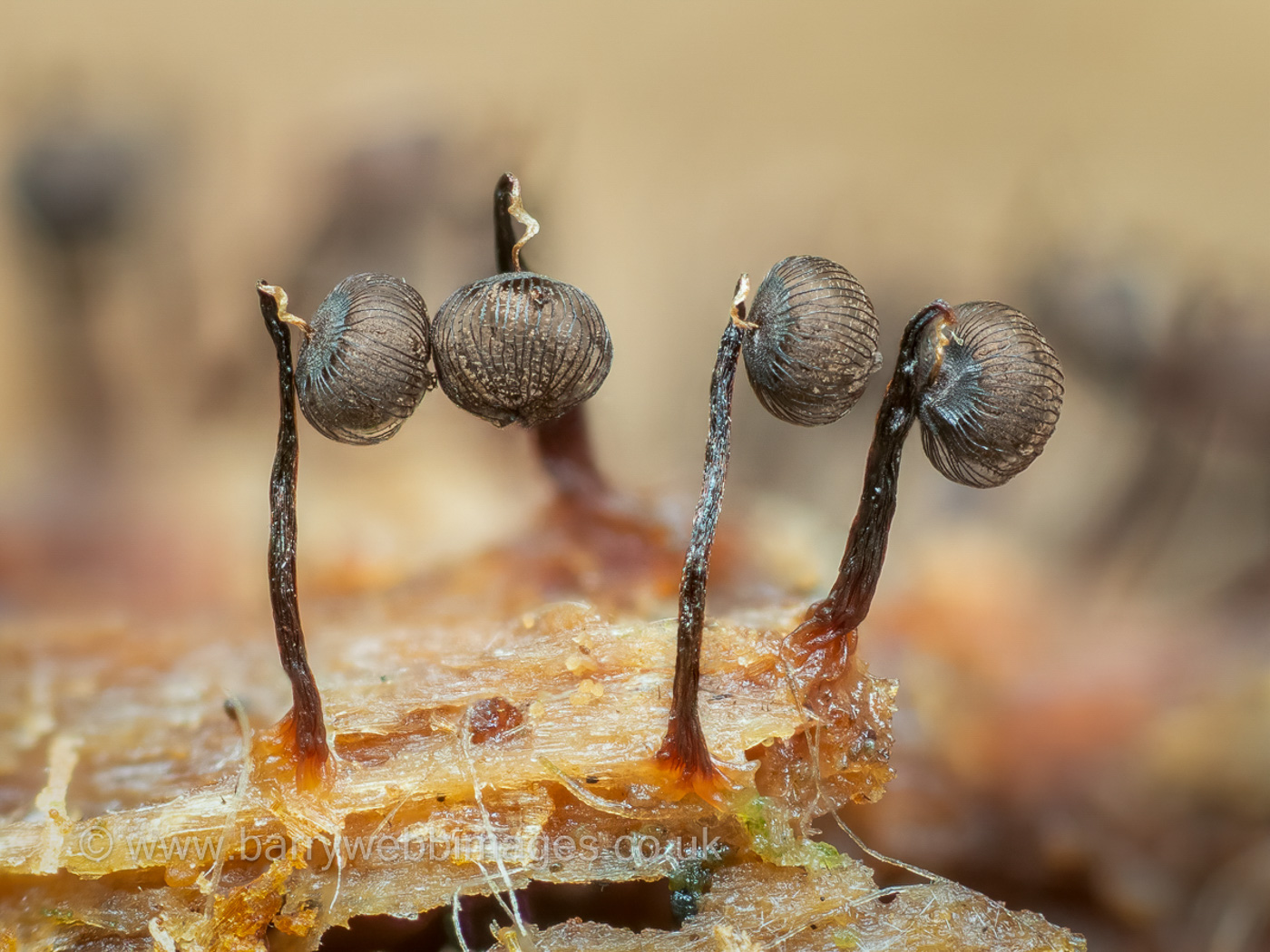
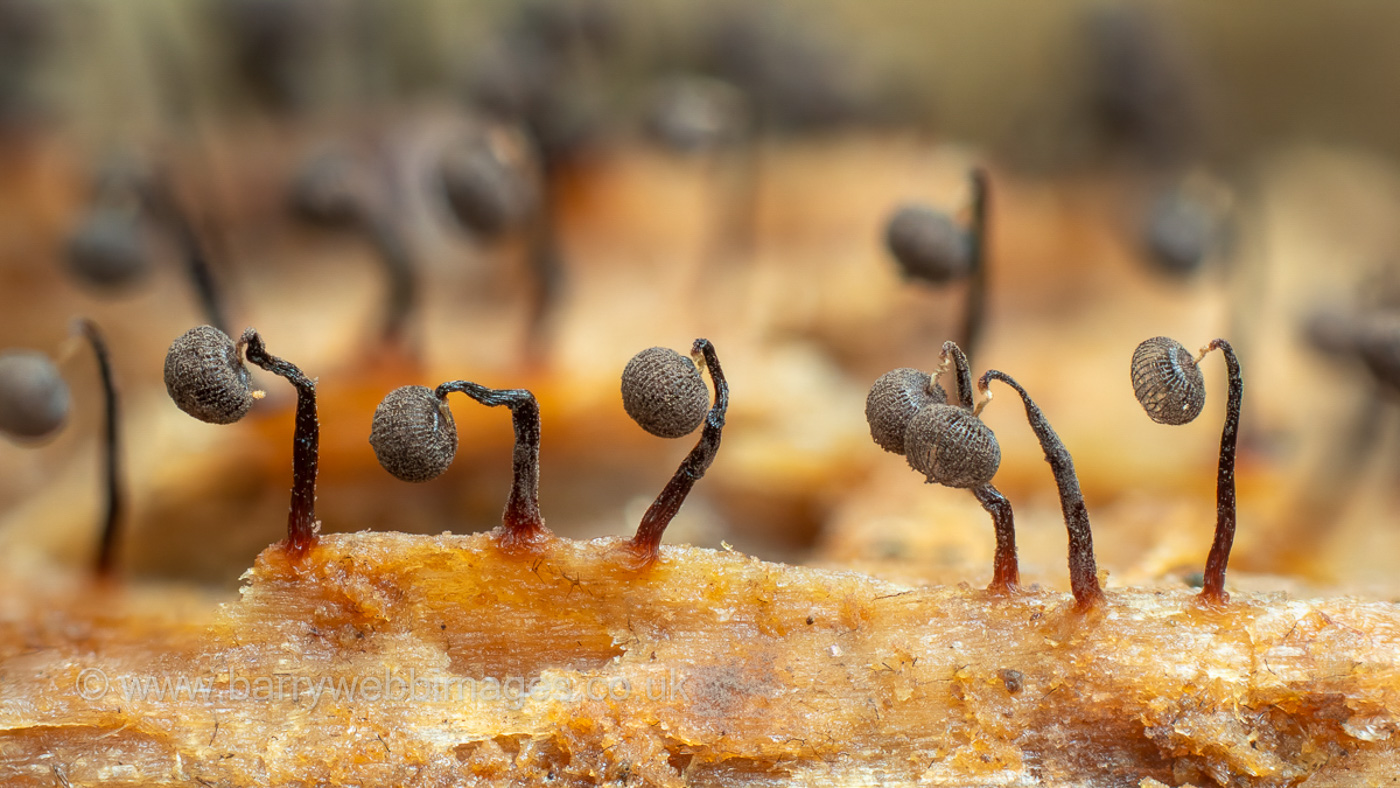
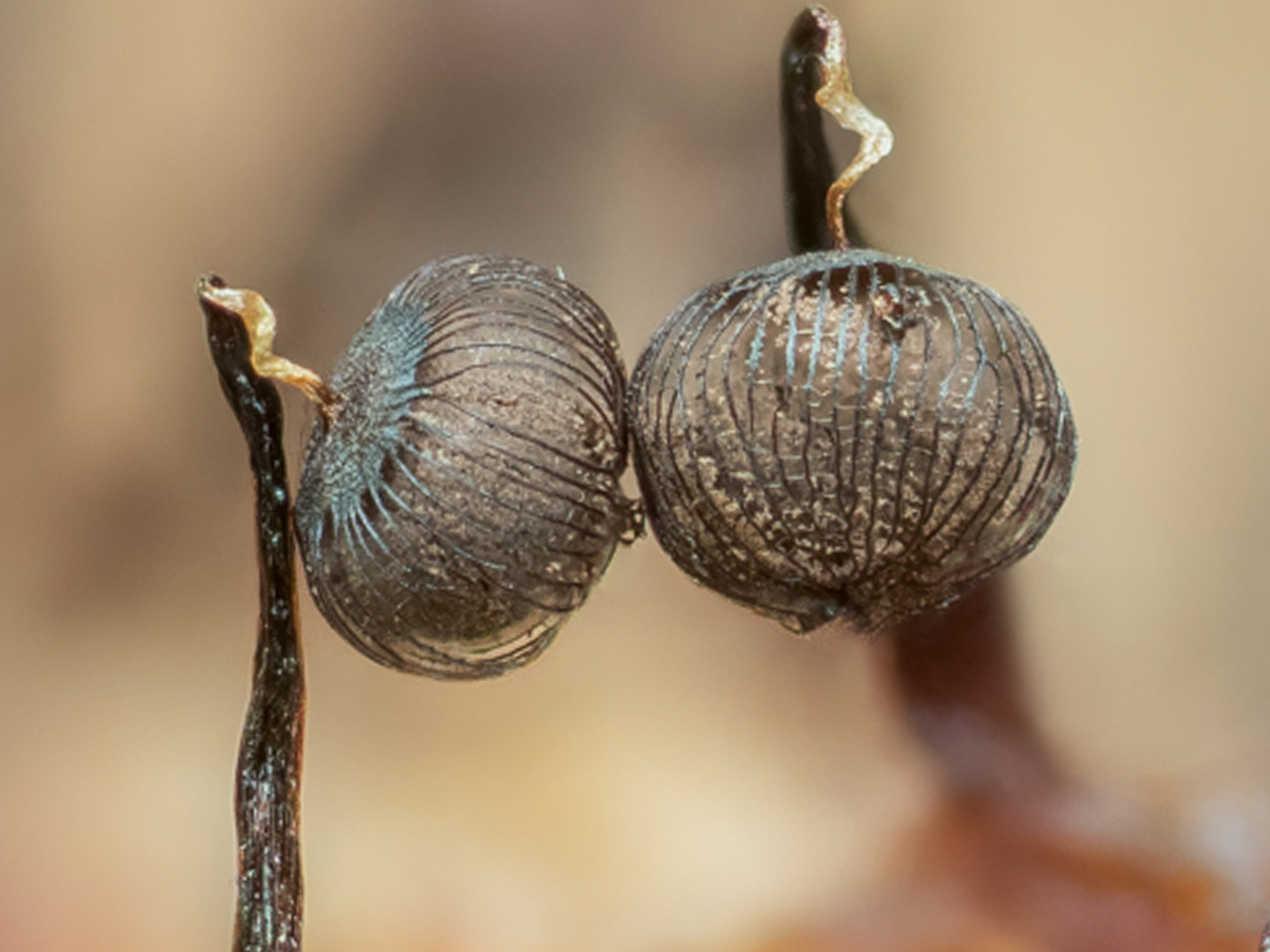 |
Cribraria cancellata var. fusca (a Slime Mould with no common name)
Aug 13, 2021. In Penn Wood on fallen Pine Barry found this rare species, new to the county and with not many British records though the type species (see just above) is apparently more common. Photo 3 is of a further collection from Burnham Beeches found three days later by Barry, also on Pine. This variety differs from the type by having a well marked cup at the base of the sporangia (lacking in the type). Both species have many longditudinal ribs around the sporangia linked by ladder-like threads, seen in the detailed photo 4. Bear in mind that each individual fruiting body is no more than 3mm high and the heads no more than 0.7mm in diameter!
|
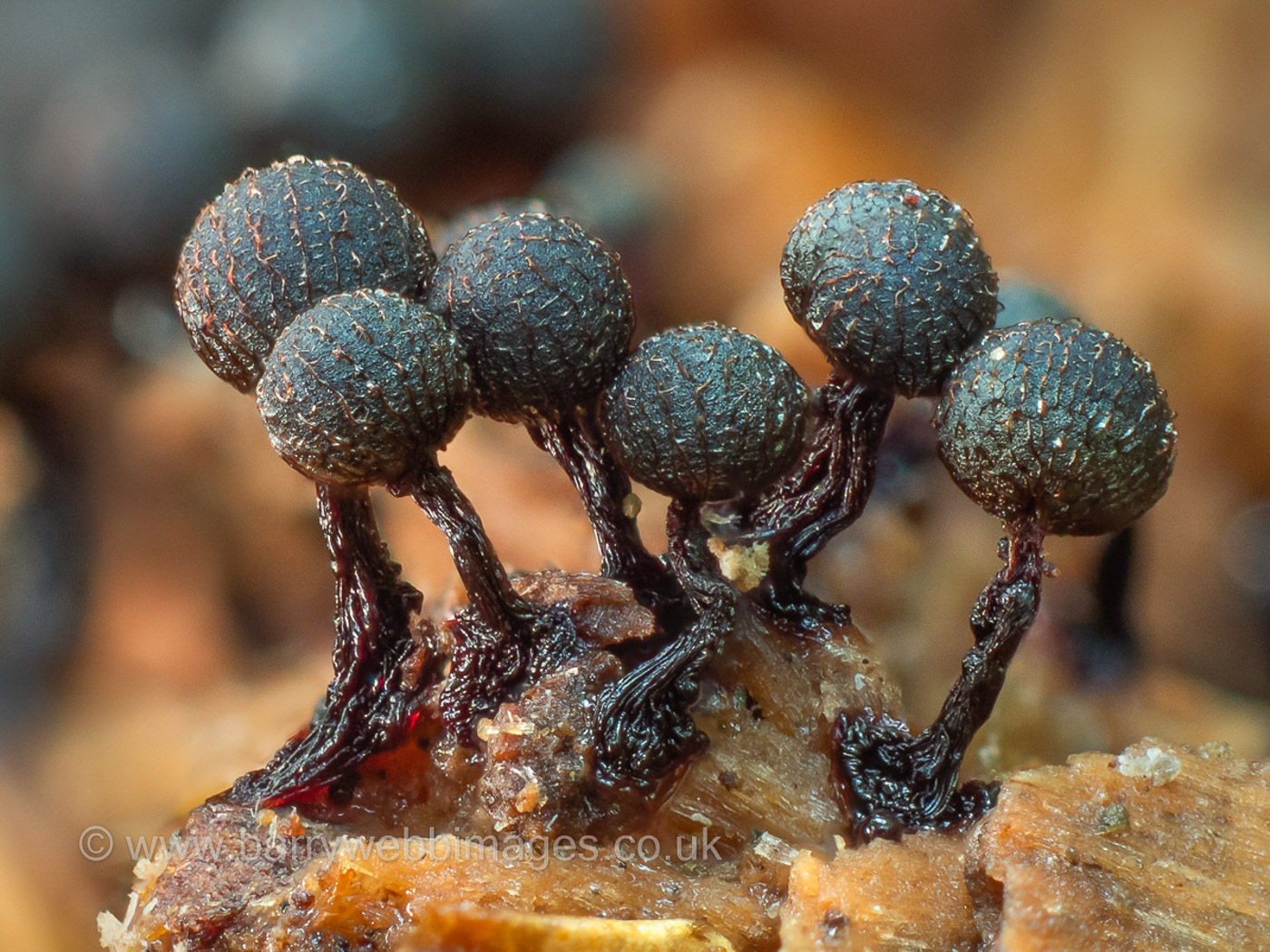
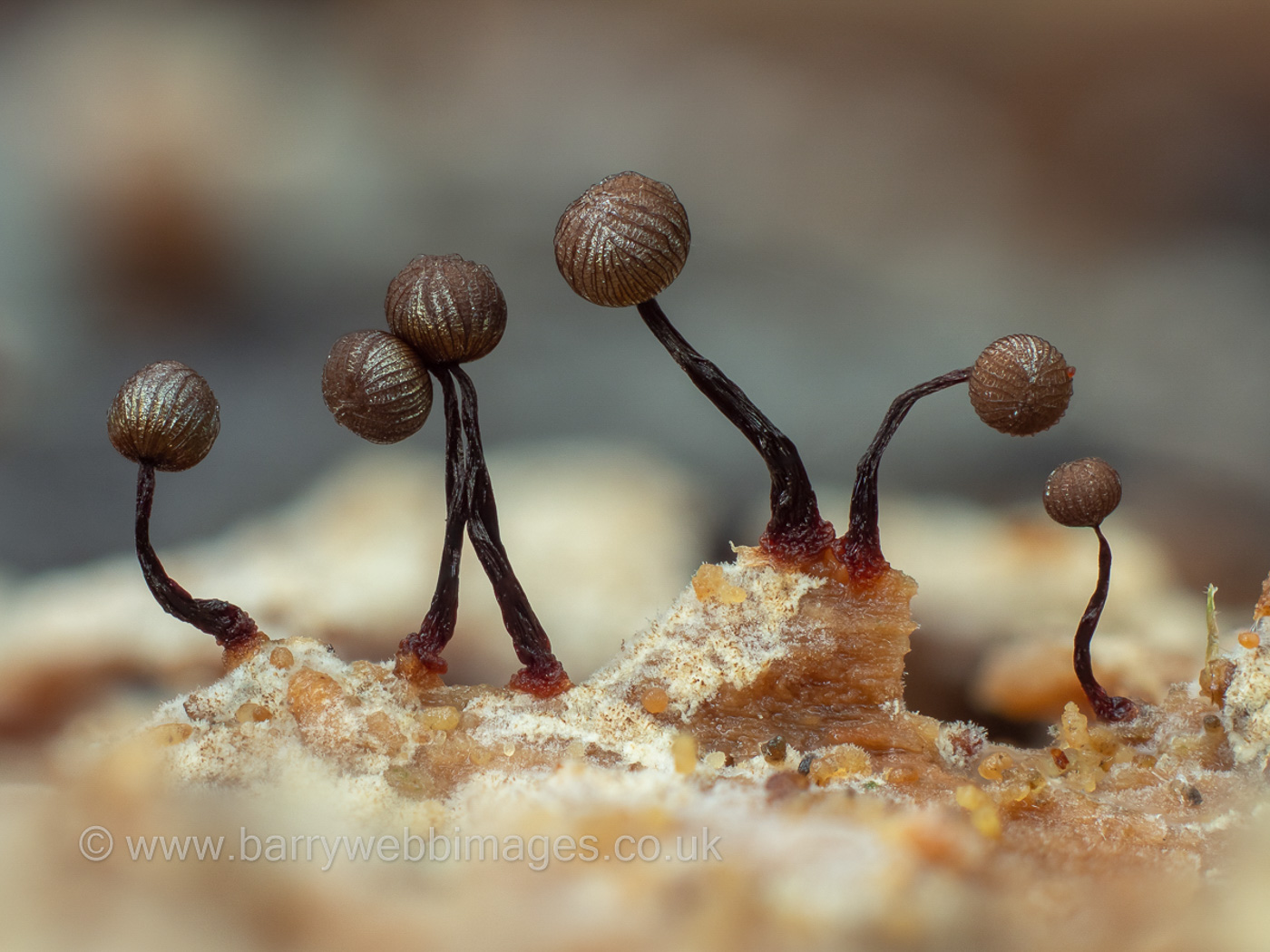
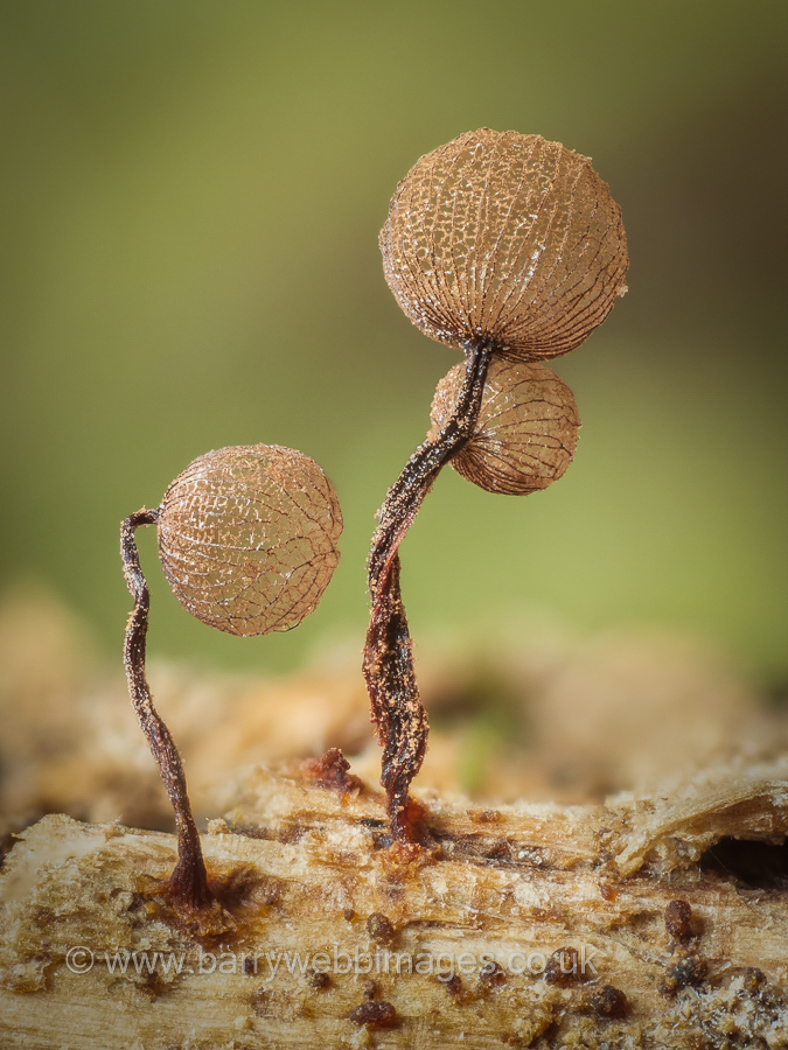 |
Cribraria mirabilis (a slime mould with no common name)
Aug 16, 2021. On rotten fallen Pine in Burnham Beeches Barry found this beautiful and rare species, one with under 10 national records and new to the county. (The identification was verified online from these photos by Norwegian expert Edvin Johanssen.) Only up to 1.5 mm tall and 0.8mm wide, it is similar to C. cancellata in lacking a cup and having a cage of longditudinal ribs but is irridescent in early stages. The three photos show it immature, maturing and finally mature. (There seems to be some confusion over previous records, Edvin informing Barry that the last record was UK expert Bruce Ing's from Bucks in 1968. However, our national database shows that record was from Scotland with others after it, none from Bucks.)
|
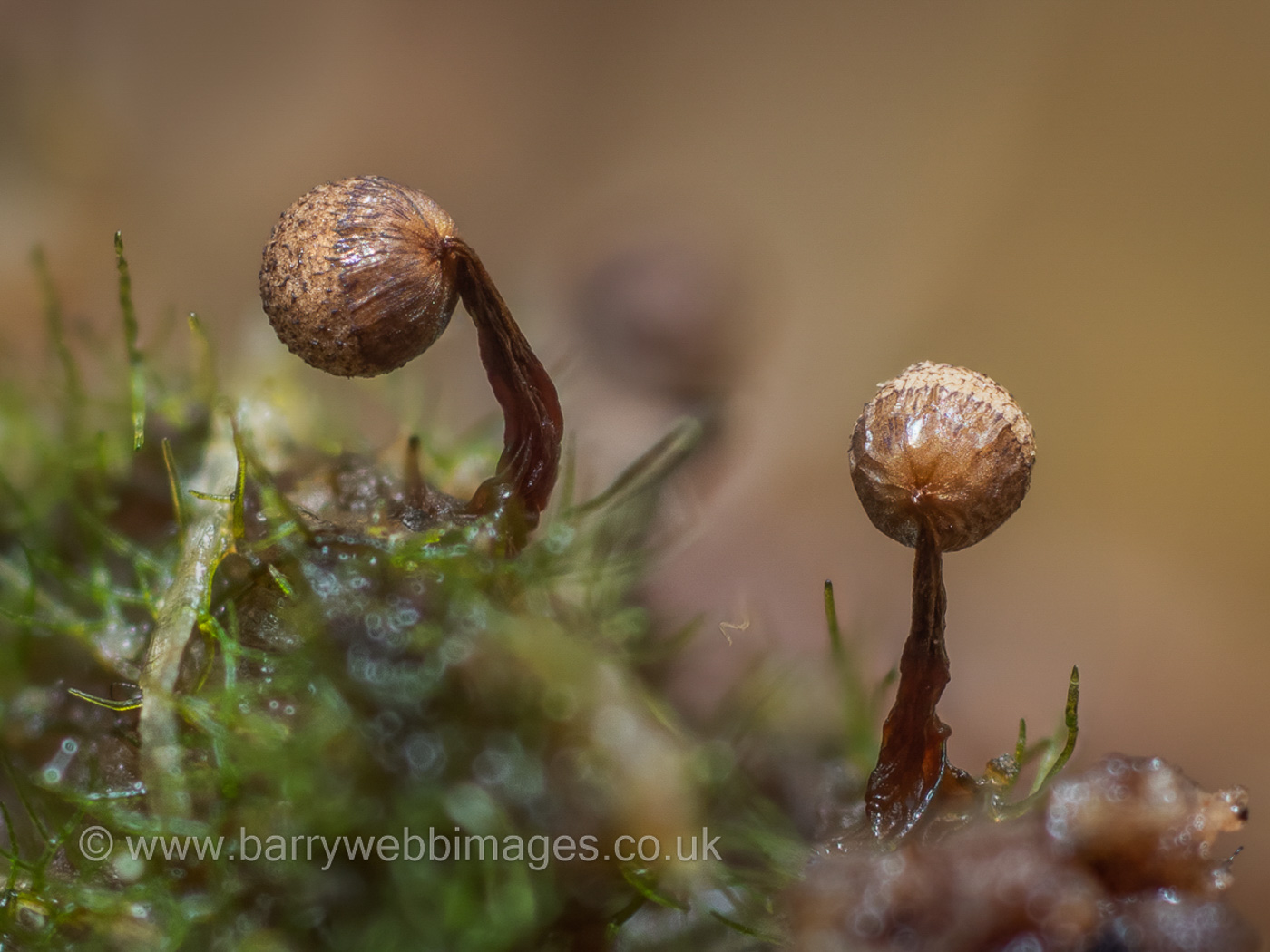
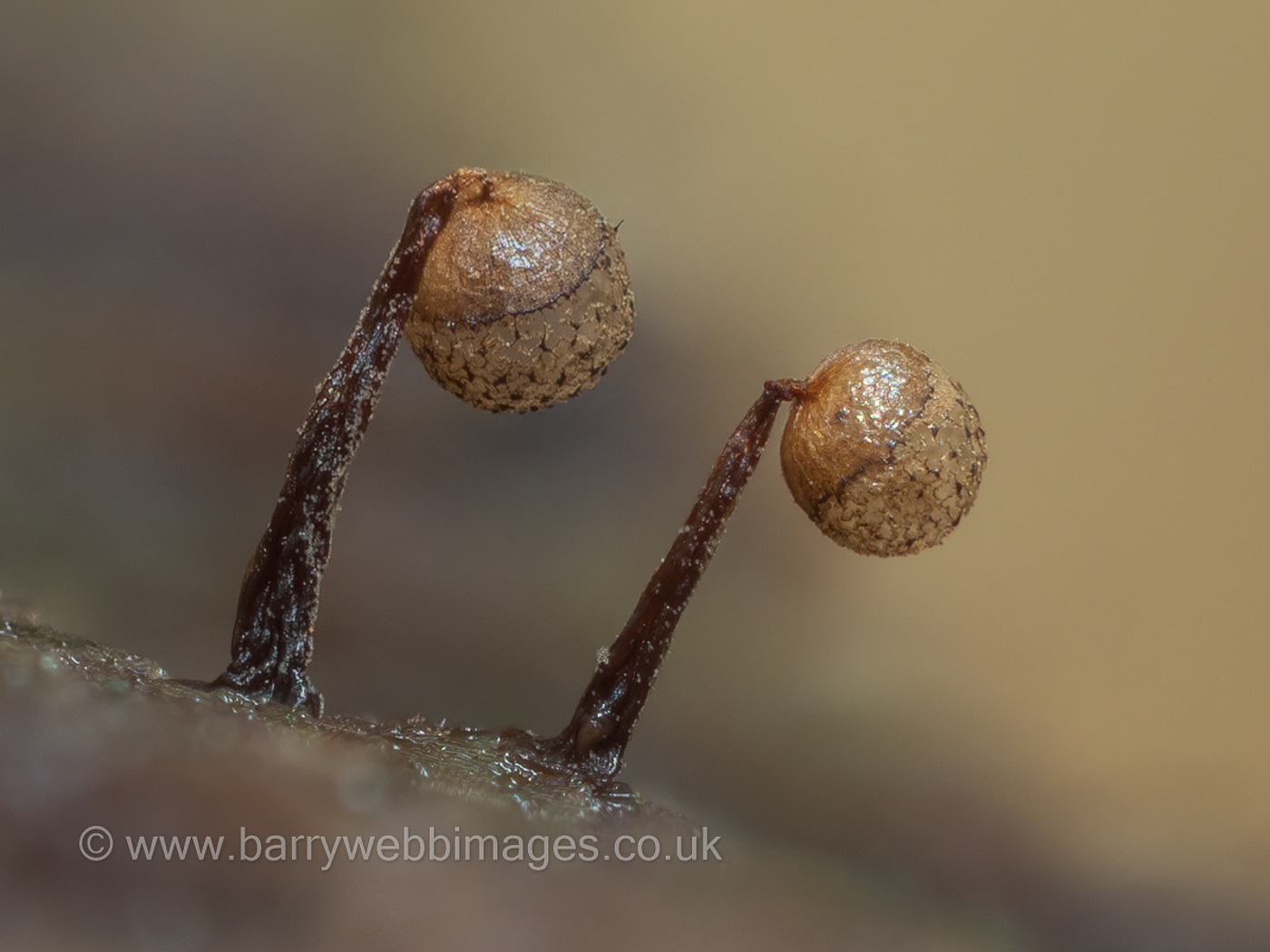 |
Cribraria persoonia Cribraria persoonia
Aug 18, 2021. In Burnham Beeches on fallen Pine Barry found this species, new to the county and with not many British records despite being described as common in the literature. The initial determination, made online from the photos, is now verified by Penny having examined the material. This is another tiny and delicate species no more than 1.5 mm high with a tapering brown stalk and having a wrinkled cup at the base of the sporangia which is about a third of the whole.
|
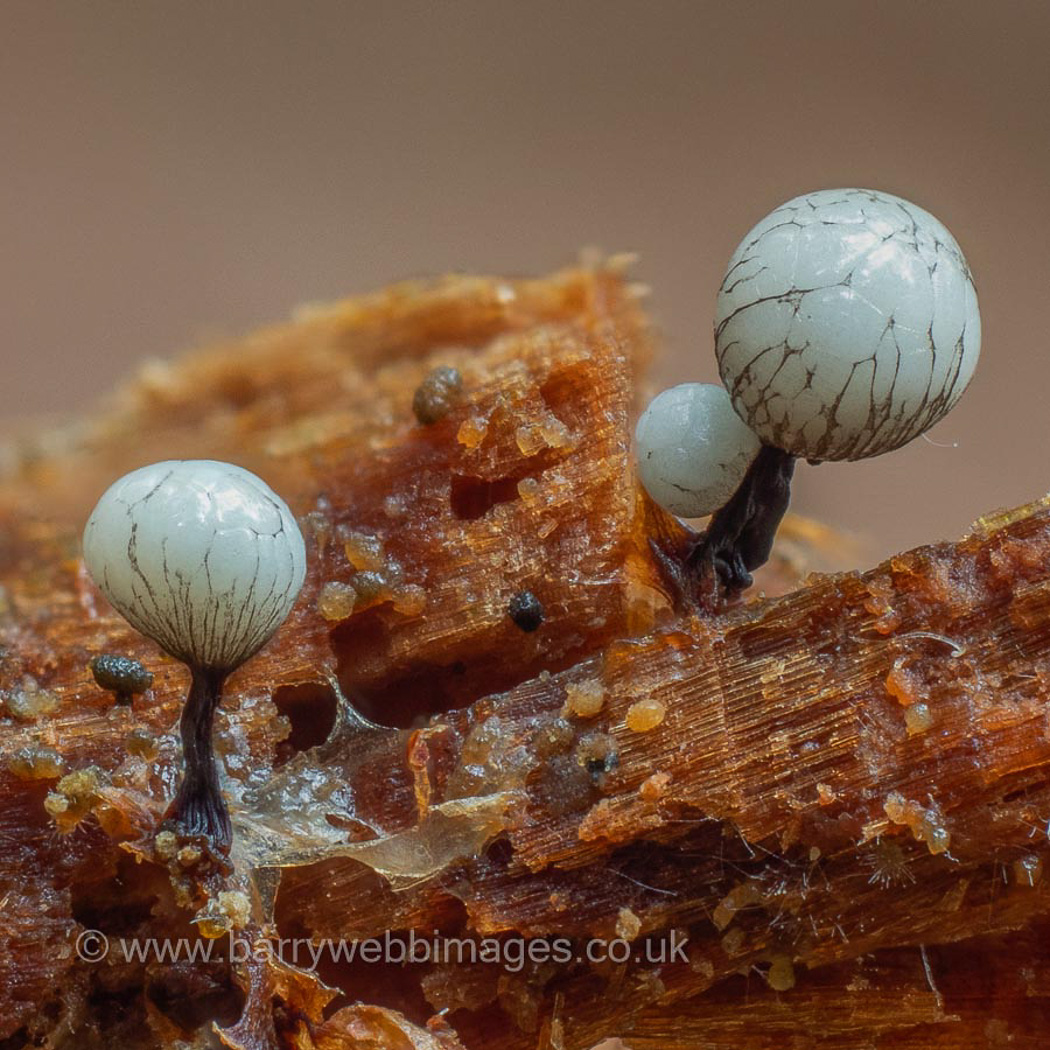
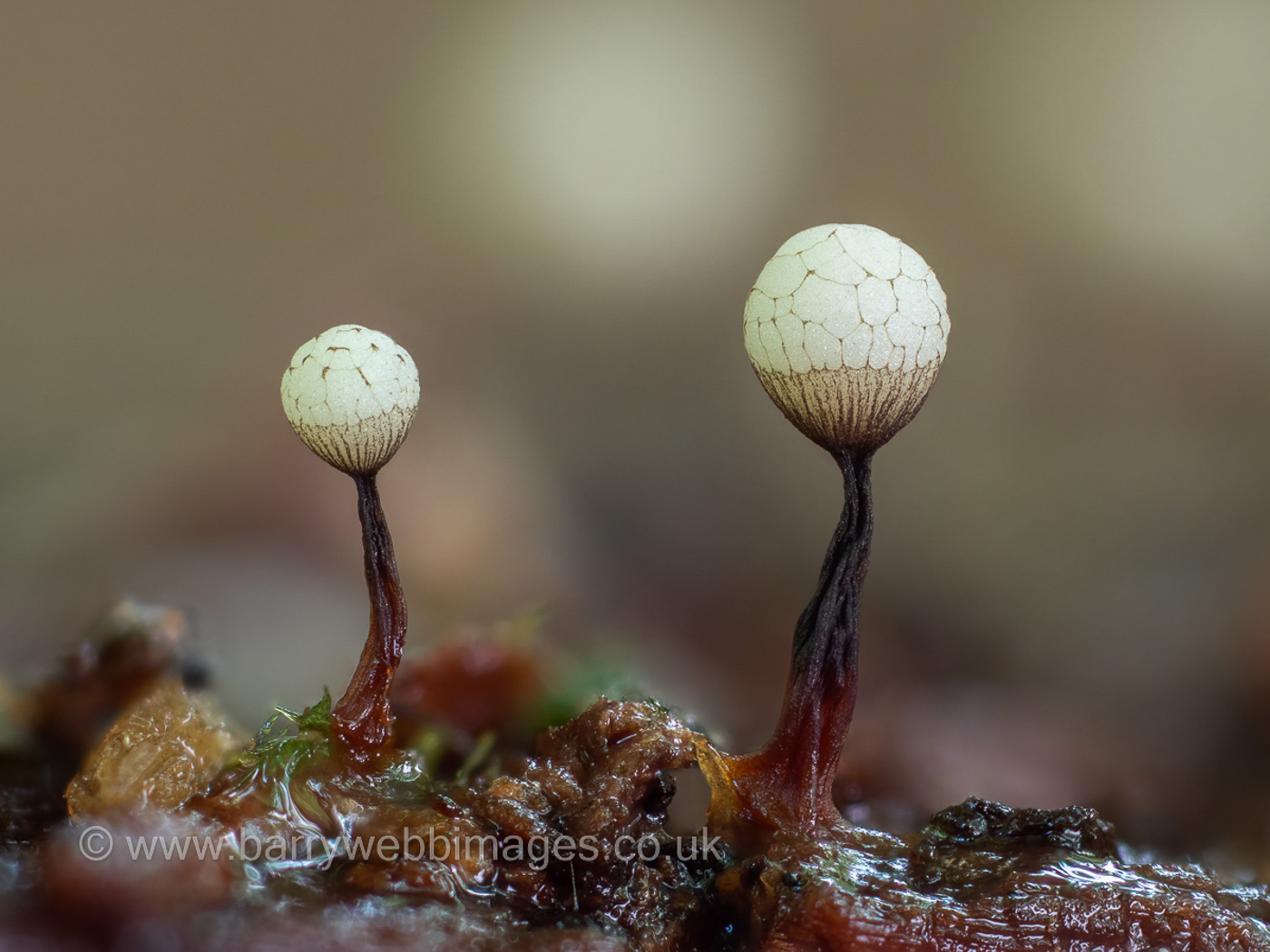
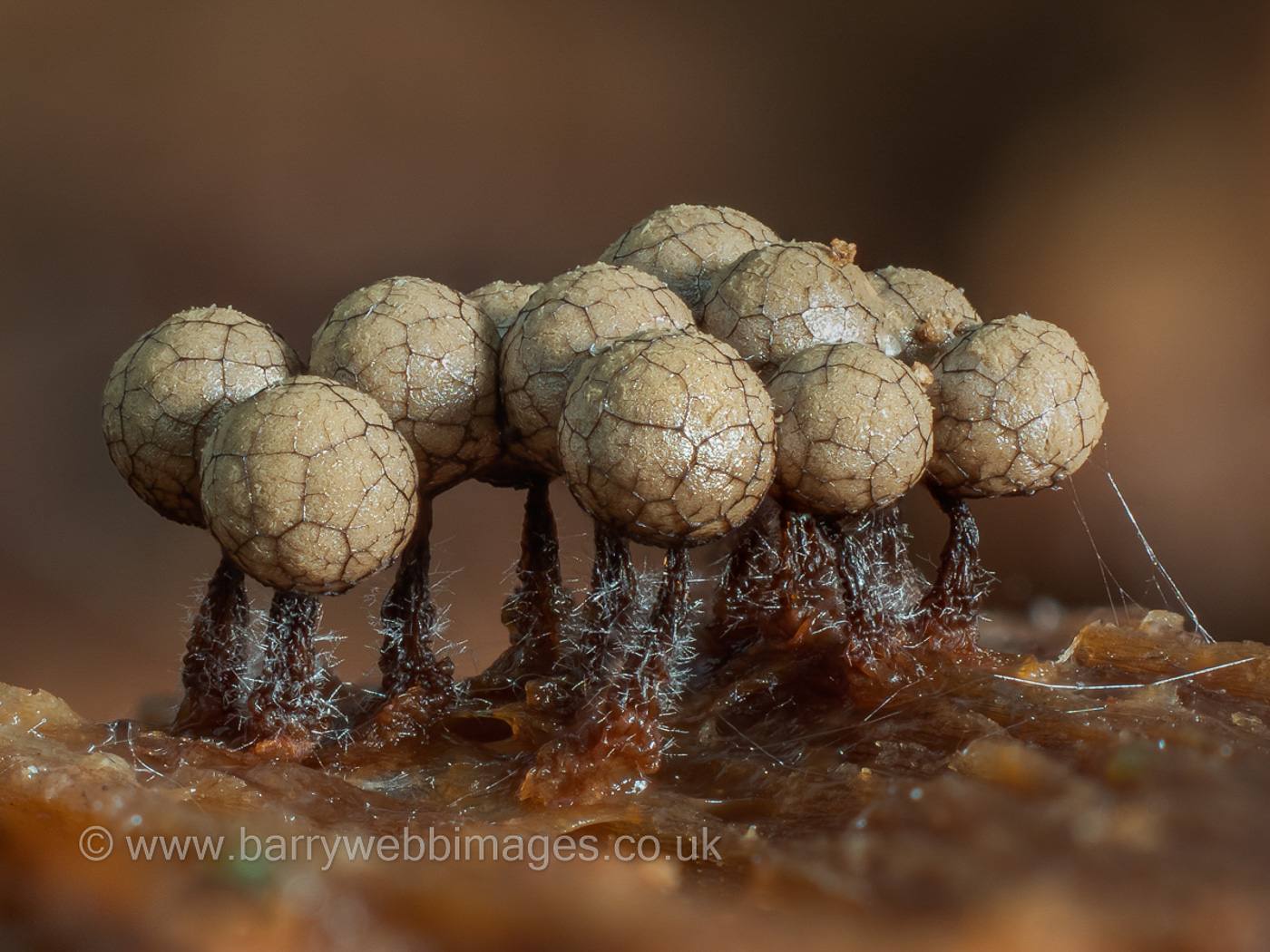
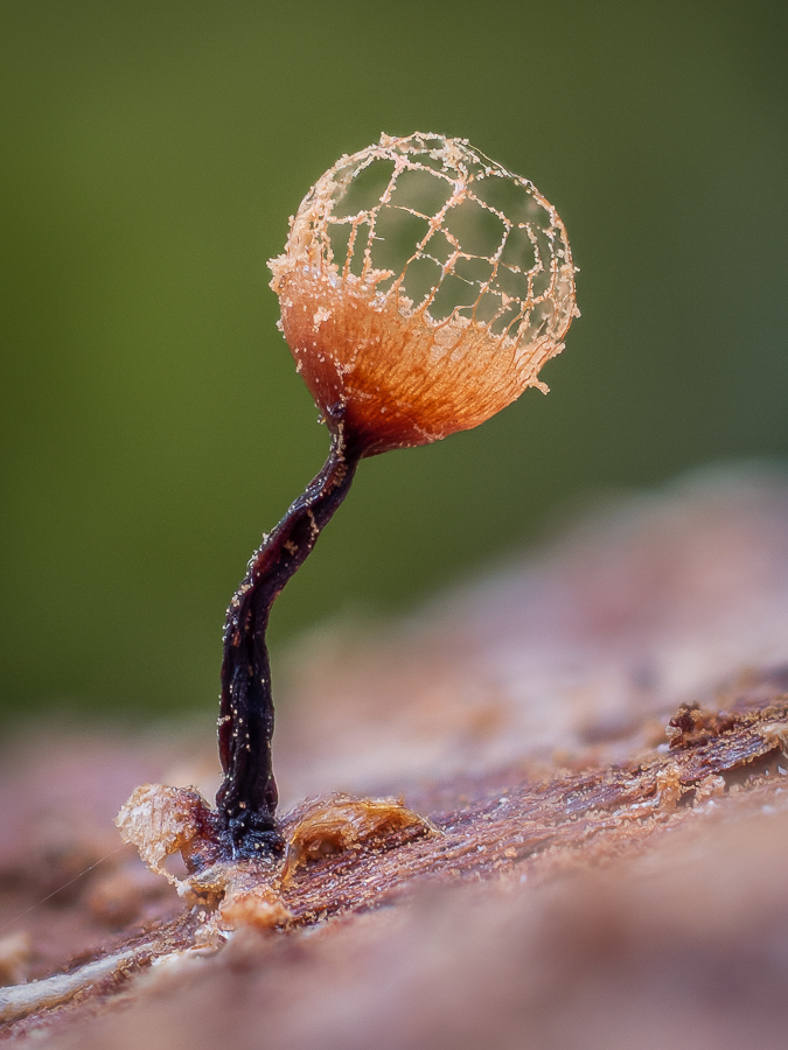
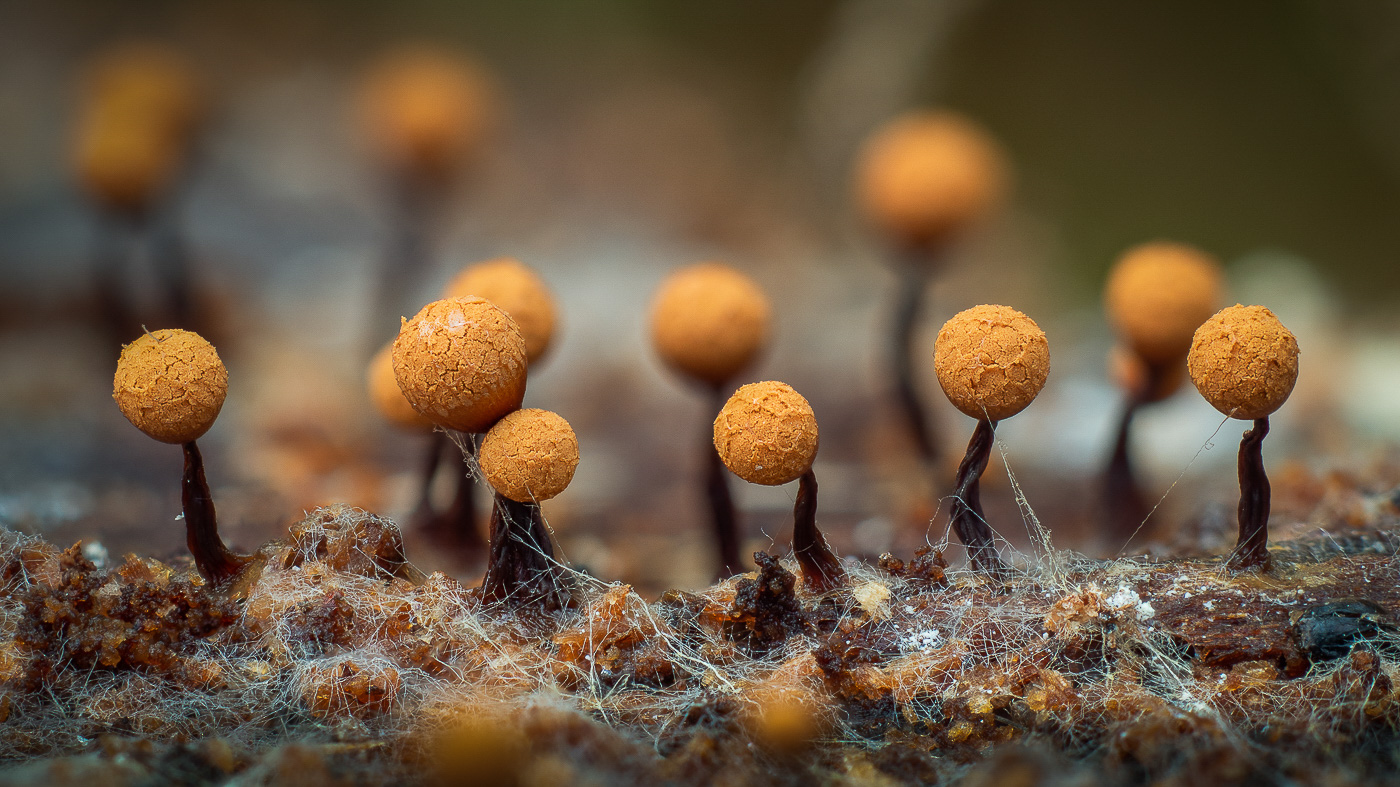



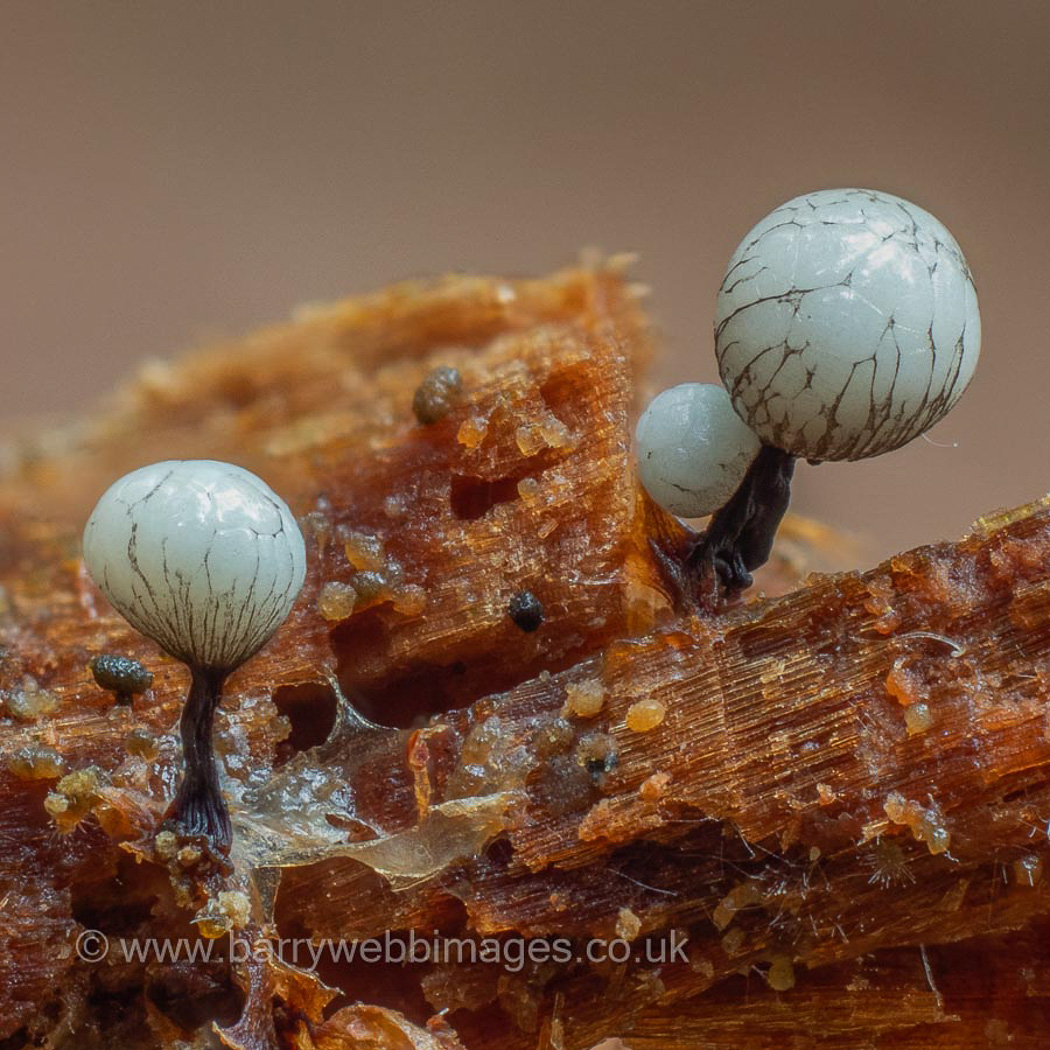 |
Cribraria rufa (a slime mould with no common name)
Sep 13, 2021. In Ivinghoe Common on rotting fallen conifer Barry Webb found these tiny white beauties, demonstrating an early stage of development before the head dries off to release its rusty spores. There are many species of Cribraria, all tiny and beautiful in their detail, nearly always on rotting conifer, and having round heads with a protective mesh / network. C. rufa has a short black stem and a widely spaced mesh, seen here just developing. See also dated July 9th; there are many more examples of the genus on Barry's separate page in Members' Finds.
Jul 9, 2021. On fallen rotting Pine in Burnham Beeches Barry Webb found this tiny but beautiful species, one which is new to the site and was new to the county when Barry found it last September in Penn Wood (see in Finds 2020 dated Sept 20th). Photo 1 clearly shows the large cup at the base from which the meshlike network spreads - typical of this species, though in photo 2, of mature fruiting heads and taken a day later, the cup is reduced and the network more pronounced.
Sep 20, 2020. In Penn Wood Barry Webb found this tiny little specimen (Photo 1) on fallen rotten Pine, the spore mass having blown away to reveal the perfect and delicate framework. About 20 species of this beautiful genus occur in the UK, mostly found on rotting conifer wood, and this one has apparently become much more common with the increase in plantations. However, we have no previous records in the county. Photo 2 is of a slightly less developed cluster found at the time. The following year Barry found further examples in Burnham Beeches on Pine where it was new to the site: Photo 3 and 4 on 10.07.2021, photo 5 on 02.08.2021. Photo 6 is of a collection from Ivinghoe Common, also on Pine, on 13.09.2021.
|
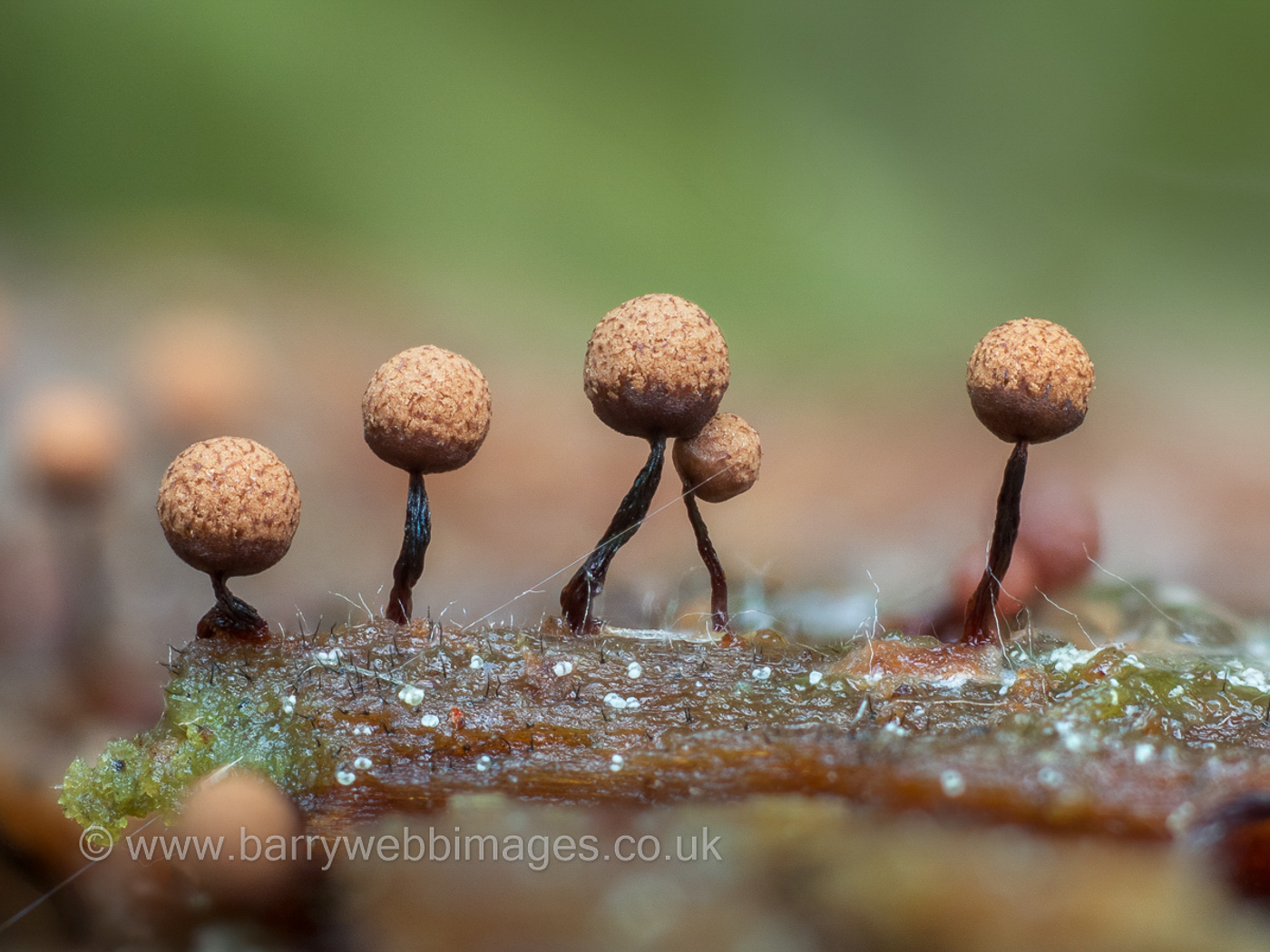
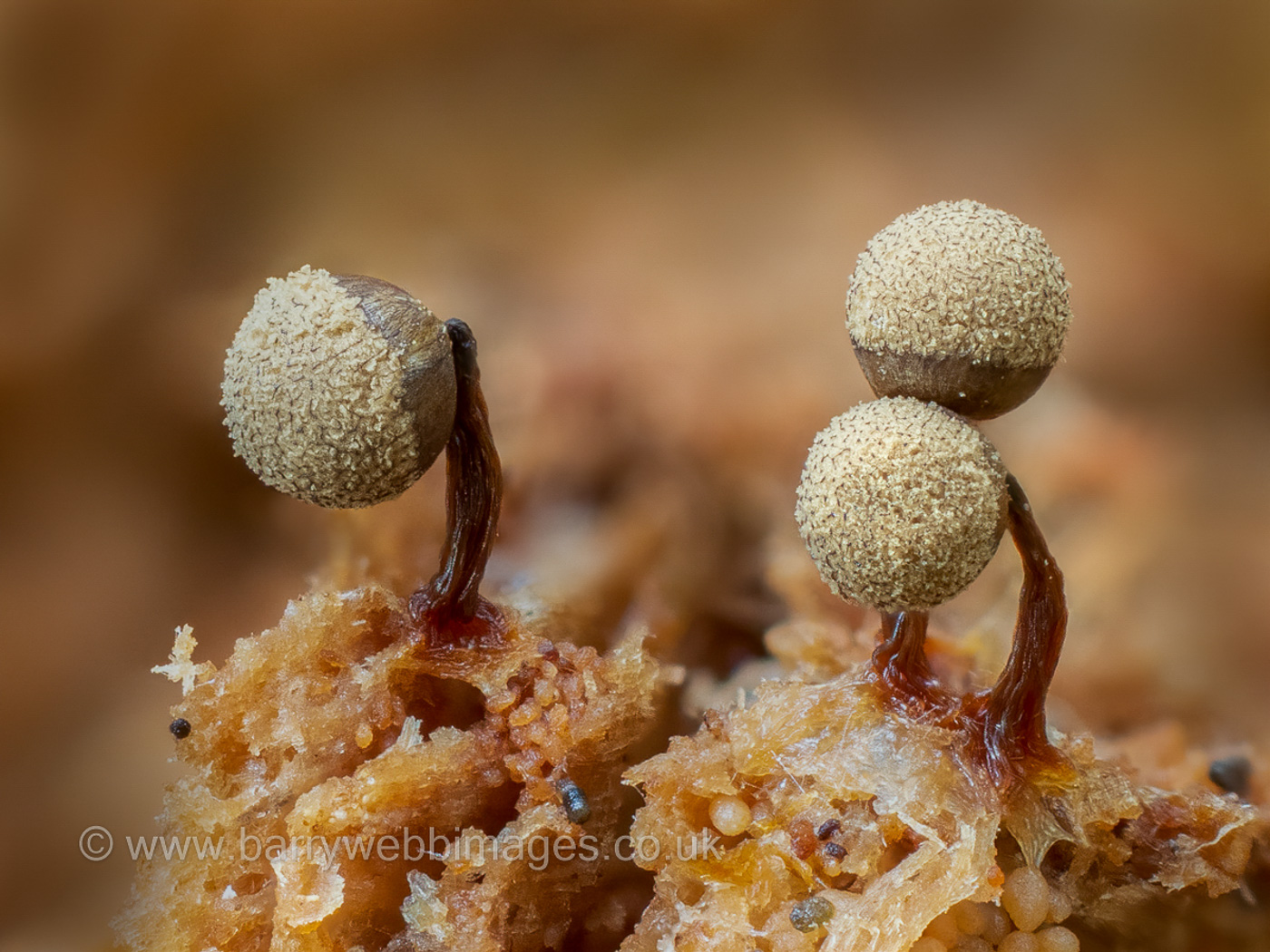
 |
Cribraria vulgaris (a slime mould with no common name)
Jun 6, 2021. In Burnham Beeches on fallen damp Pine Barry found these minute (even for a slime mould) specimens which were only 0.5 mm across! (The determination was confirmed online by Norwegian expert Edvin Johannesen.) A rare species with few national records, this was an exciting find. The single record for the county dates back to 1923 (at Burnham Beeches) with both collector and identifier as 'Anon', so probably best overlooked, making Barry's find new to Bucks. Photos 2 and 3 are of collections both verified by Penny, the first from Bernwood Forest (29.08.2021) and the second from Ivinghoe Common a week later (04.09.2021).
|
D
|
|
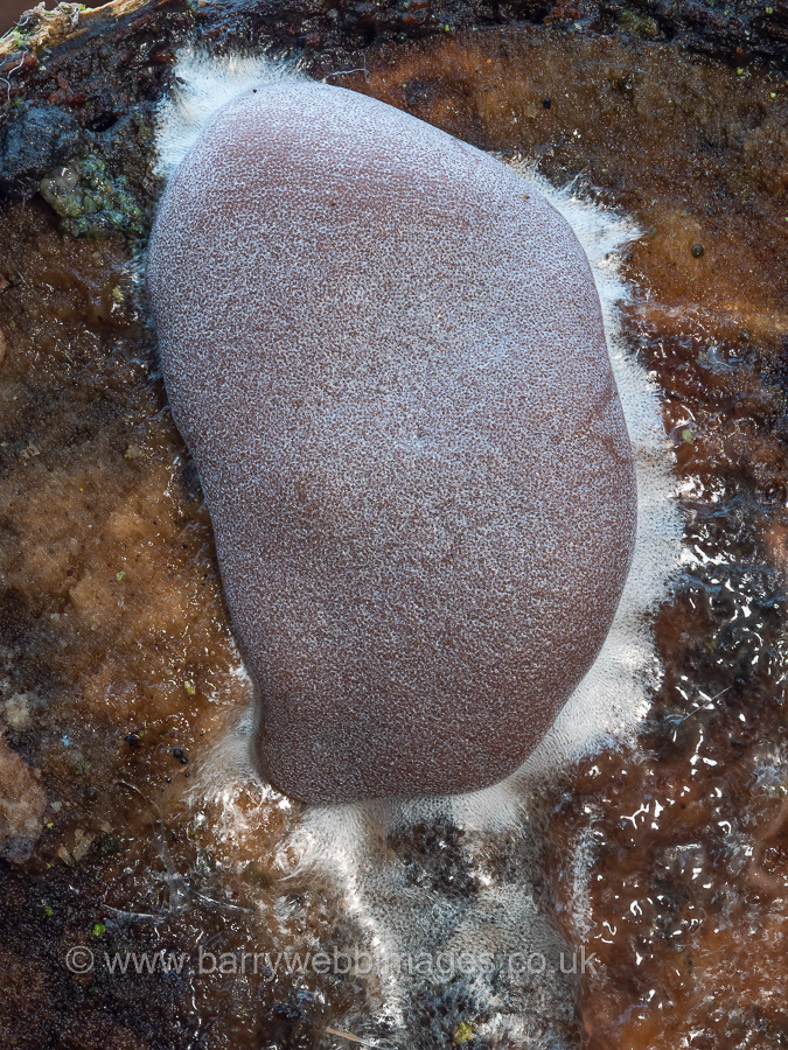
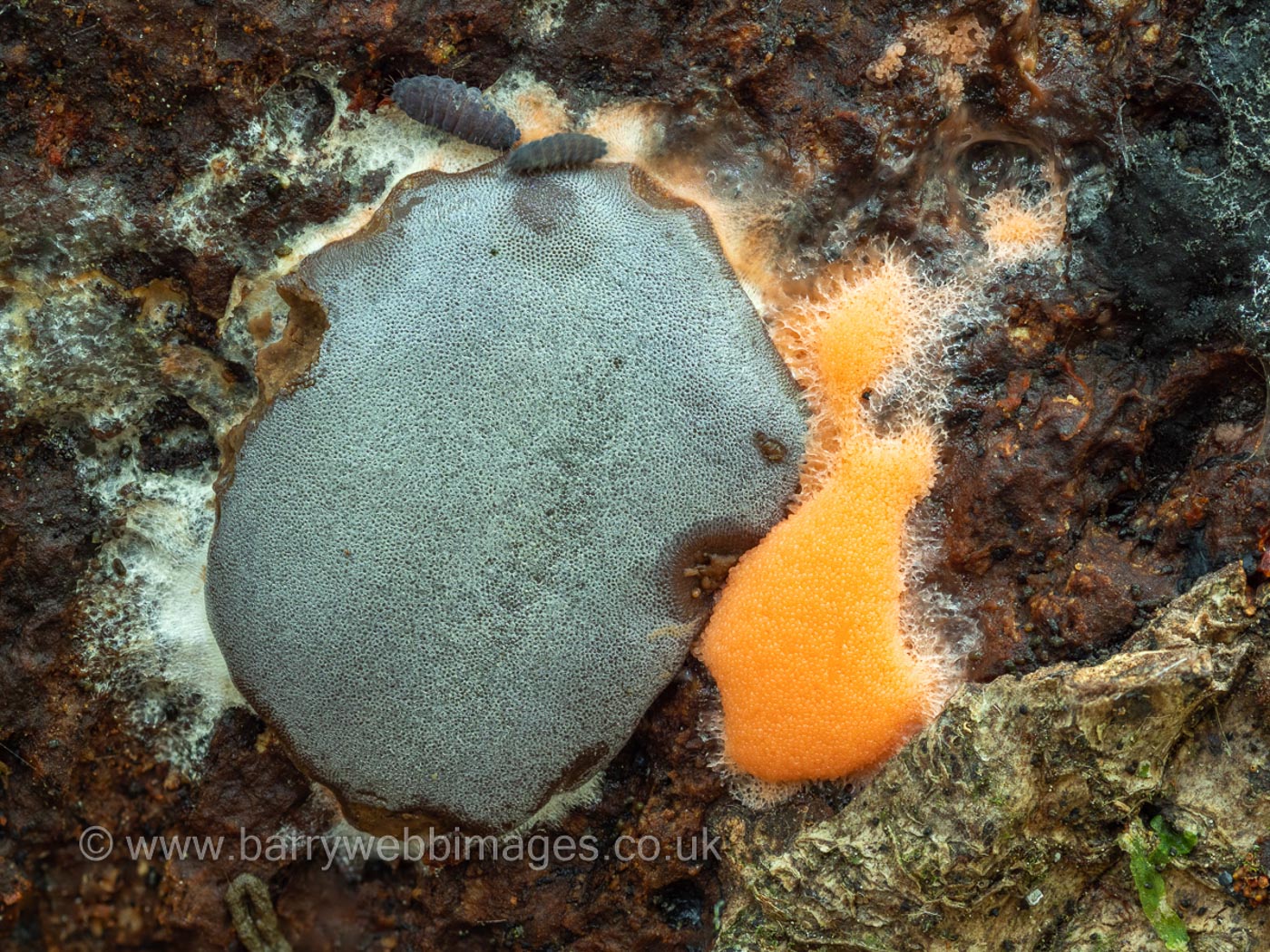 |
Dictydiaethalium plumbeum (a Slime Mould with no common name)
Dec 30, 2021.On the same Birch pile in Hodgemoor Woods Barry and Gill Webb also found this species though it is more commonly found on fallen Beech. For more notes and another image see Barry's separate page in Members' Finds.
Jun 23, 2021. In Burnham Beeches (23.06.2021) on rotting fallen Beech Barry found this unusual slime mould, one which is new to the site and with just two previous county records. It is a species with bright pink to orange plasmodium (seen here) which turns first grey (hence its Latin species name) then yellow-brown and forms flattened patches on rotting deciduous wood up to 5 cm long x 1 cm thick. It would be possible to mistake the plasmodium of this species with that of the common Tubifera ferruginosa (also bright pink orange) if one was not aware of the identity of the host wood. D. plumbeum occurs on rotting deciduous wood, especially Beech as here; T. ferruginosa occurs on rotting conifer (very occasionally on Alder or Birch).
|
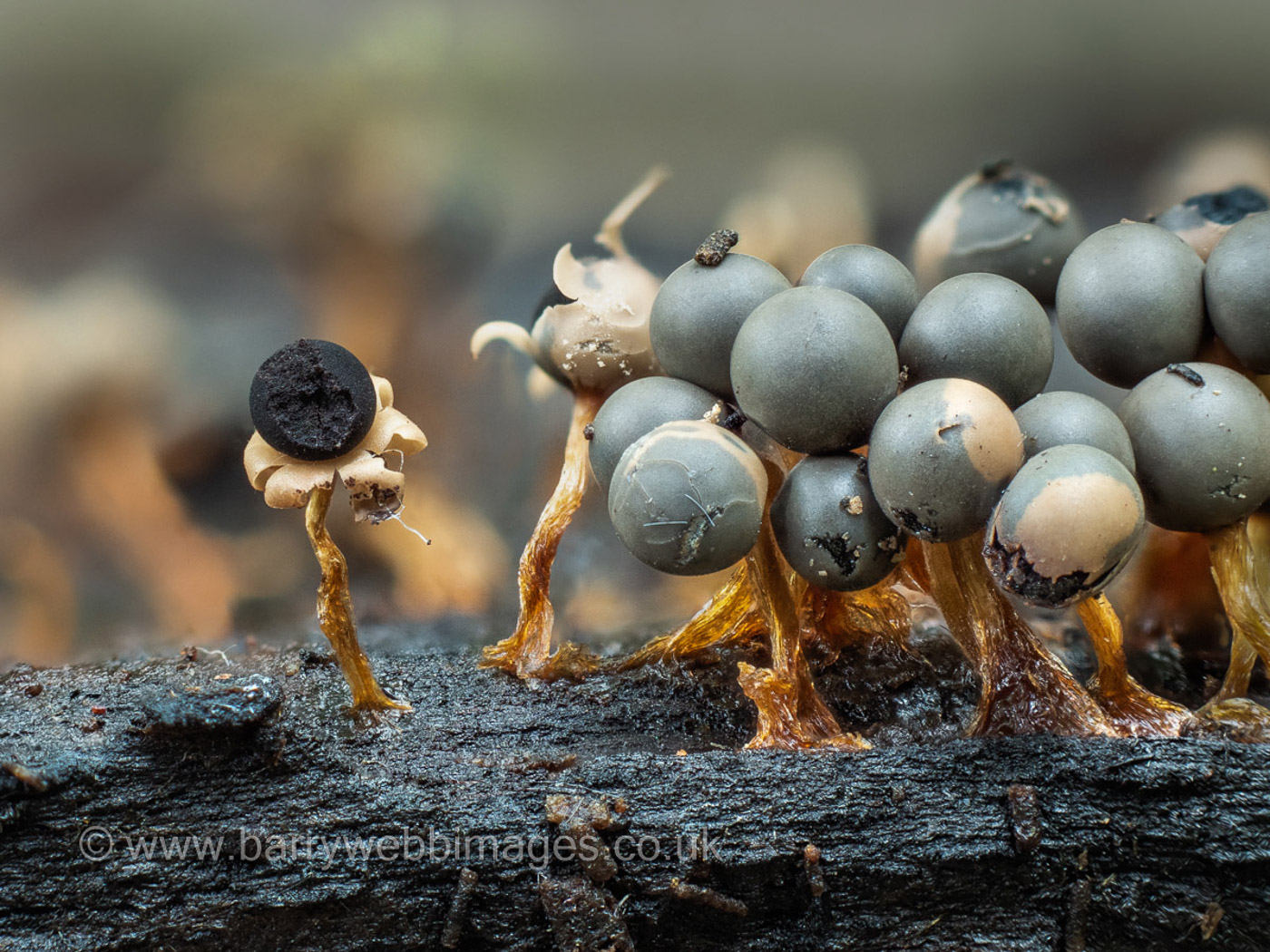
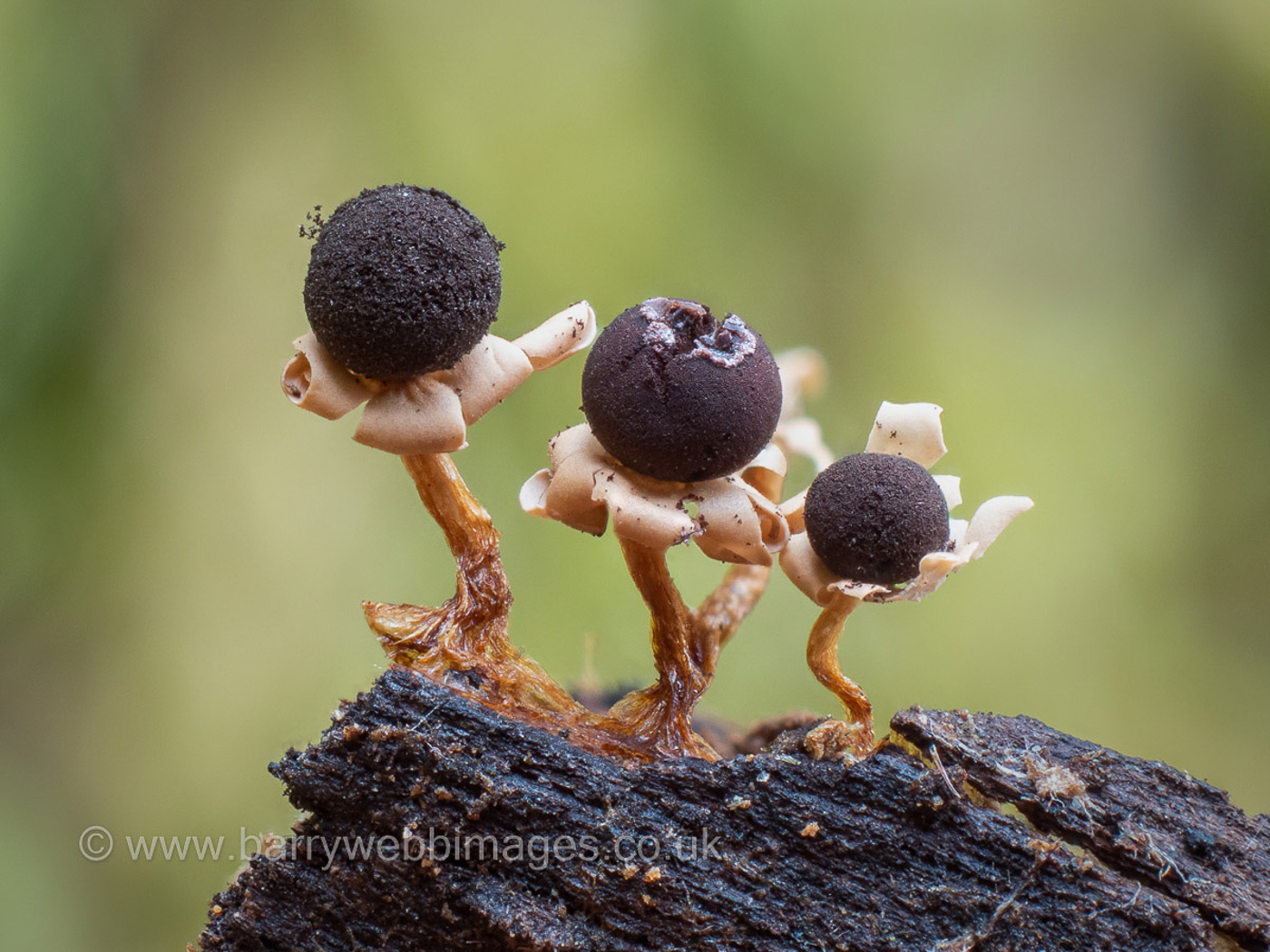 |
Diderma floriforme (a slime mould with no common name)
Sep 4, 2021. In Ivinghoe Common on our BFG walk member Stephen Plummer spotted a cluster of these tiny little beauties on a very rotten log, probably Beech - a species new to Barry with just two previous county records. The distinctive pearl grey round heads are coated with a two-tone double layer of calcareous crust (clearly visible here) which breaks open to reveal the contrasting dark ripening spore mass within.
|
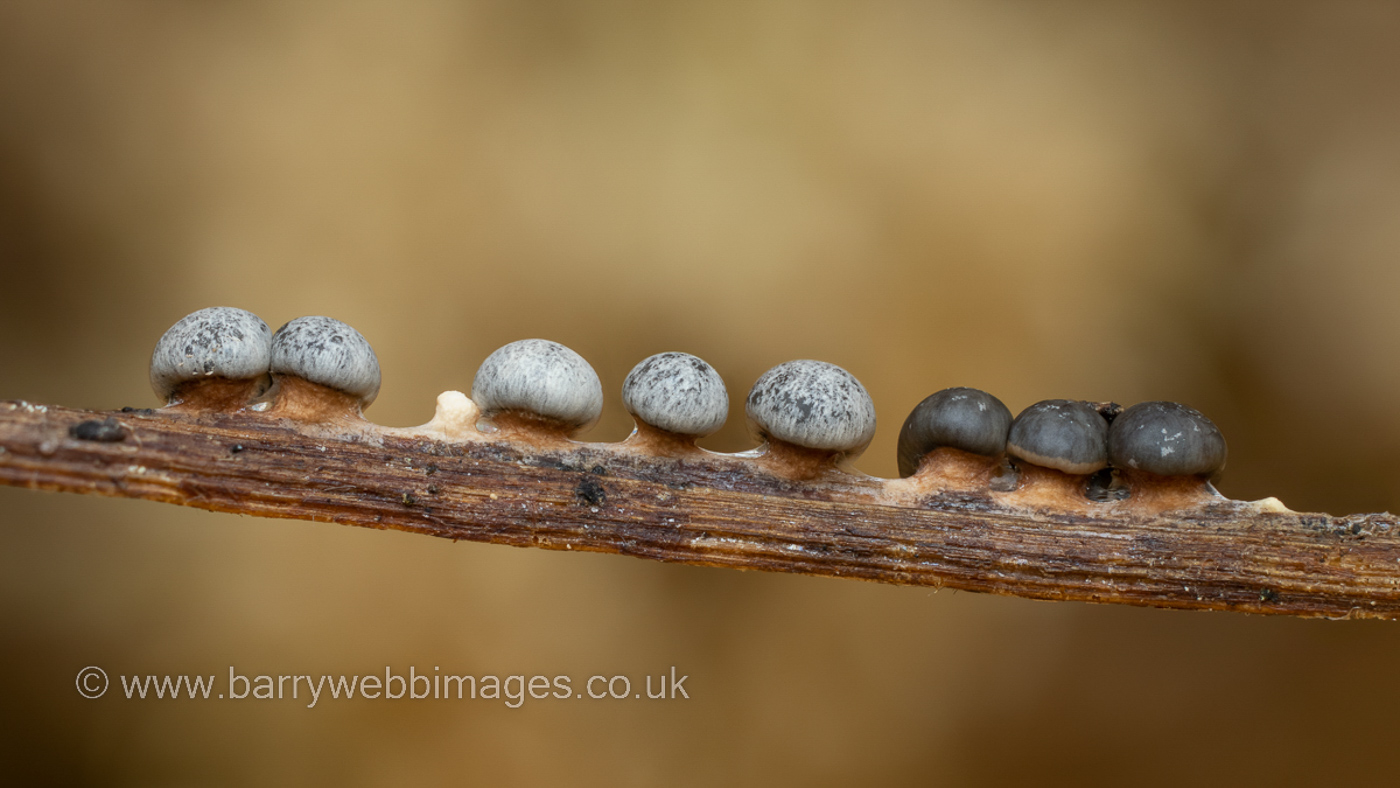
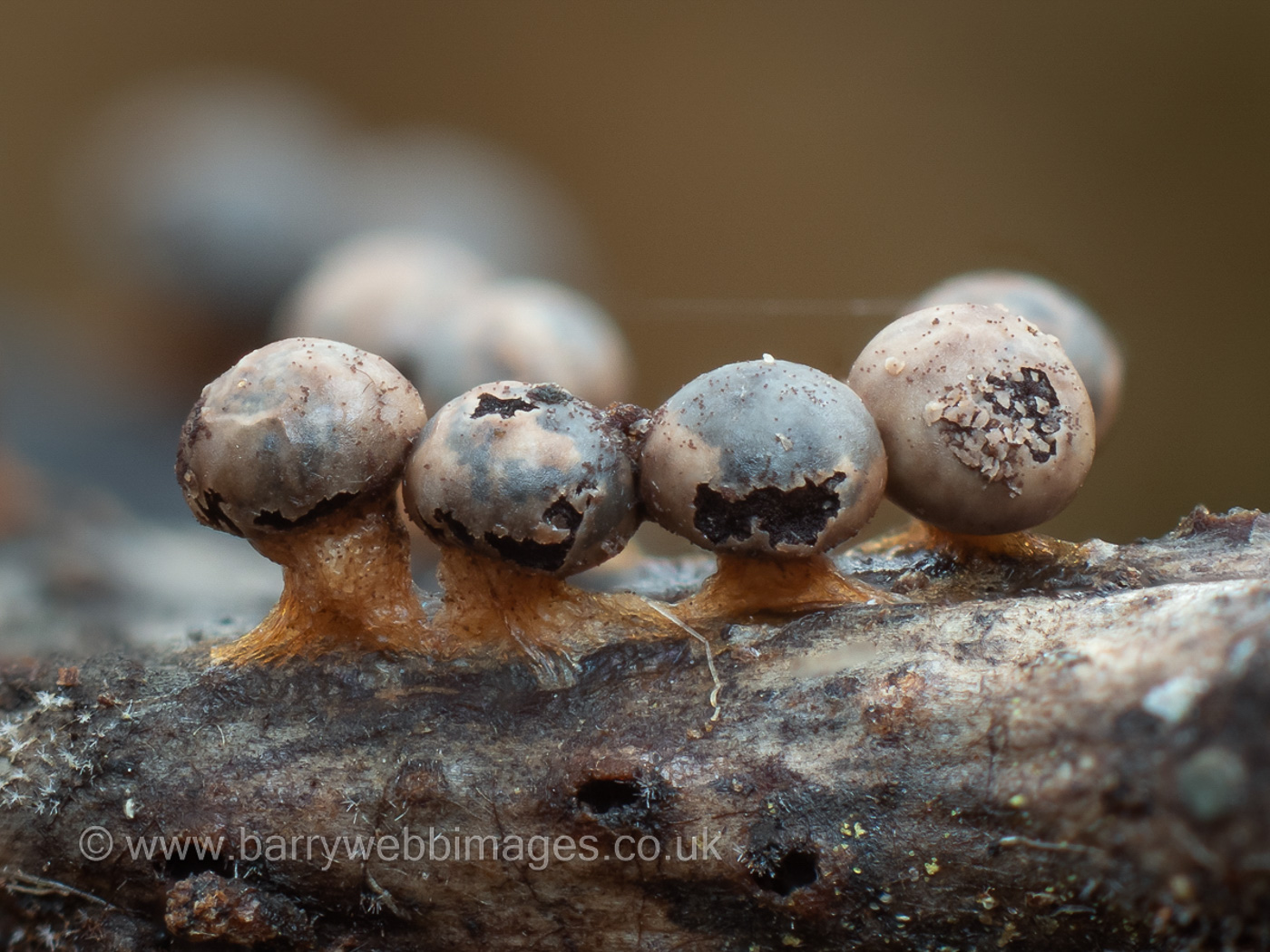 |
Diderma umbilicatum (a Slime Mould with no common name)
Nov 30, 2022. At Burnham Beeches Barry Webb found this unusual Slime mould on twigs in deciduous leaf litter, a species that was new to the county when he found it at Hodgemoor Woods earlier this year The short stout stalk help to make it recognisable in the field.
Jan 6, 2022. In Hodgemoor Woods Barry Webb found this species - not rare but still new to the county - on an oak twig in leaf litter. Diderma is a large genus of 70 odd species characterised by their crusty coating of lime crystals. Today's species is quite large for a slime mould - up to 1.3 mm across(!) - with pale shiny heads and a thick short orange umbilicate stalk beneath. (For more examples of the genus go to Barry's separate page on Finds.)
|
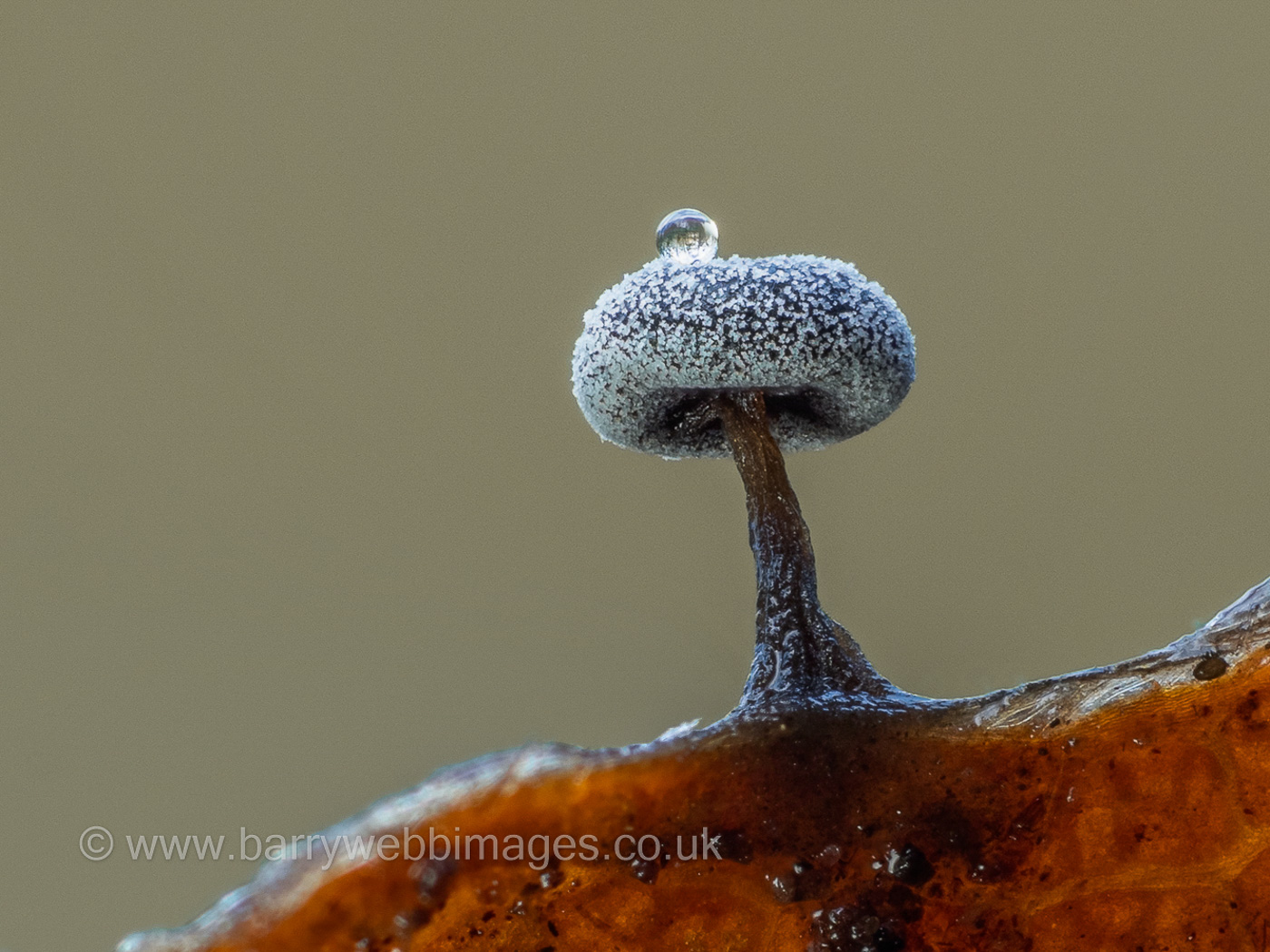 |
Didymium clavus (a slime mould with no common name)
Dec 30, 2020. Barry Webb found this tiny specimen in deciduous leaf litter in Burnham Beeches - a new record for the site and also for the county. (The determination was confirmed online by Myxo expert Edvin Johannesen.) Didymium is a large and tricky genus, many species of which look extremely similar. They are characterised by having a covering of calcium carbonate crystals, either as an egg-shell crust or a dusting as here, either with or without a stalk - the relative length of which, if present, is significant together with its shape and colour.The top spore-bearing part can be globose or discoid (more flattened) as here. Despite our lack of records, this is described as a common species on deciduous leaf litter.
|
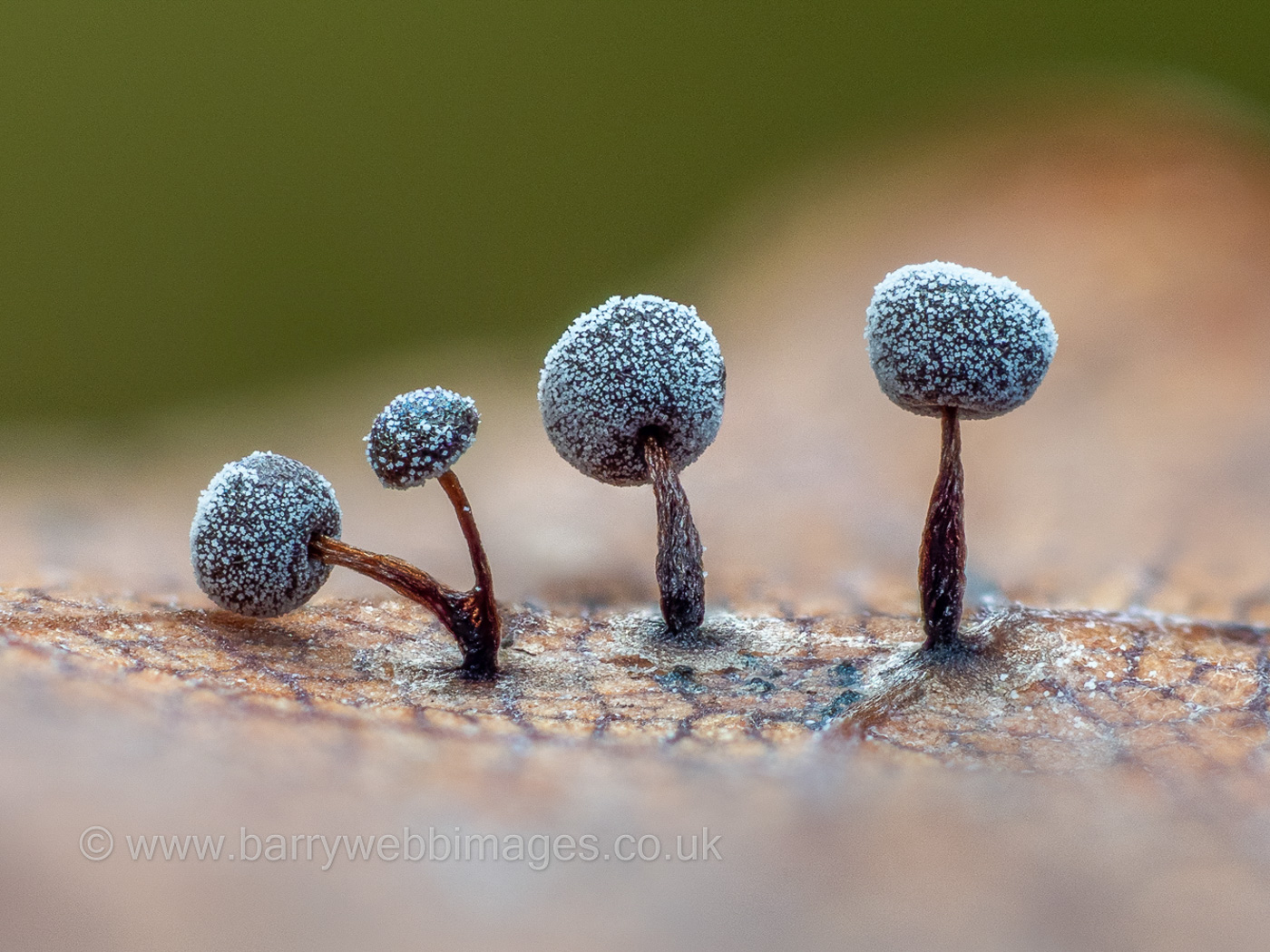 |
Didymium nigripes (a slime mould with no common name)
Sep 18, 2020. Barry Webb found this tiny slime mould in deciduous leaf litter in Burnham Beeches where it was new for the site though we have only one previous county record. (The determination was confirmed online by Myxo expert Fred Spiegel.) It is described as quite common across the country though most records seem to be from the south. See notes for D. clavus for general comments on the genus. The relatively long dark narrowing stalk and globose spore-bearing head are characteristic of this particular species.
|
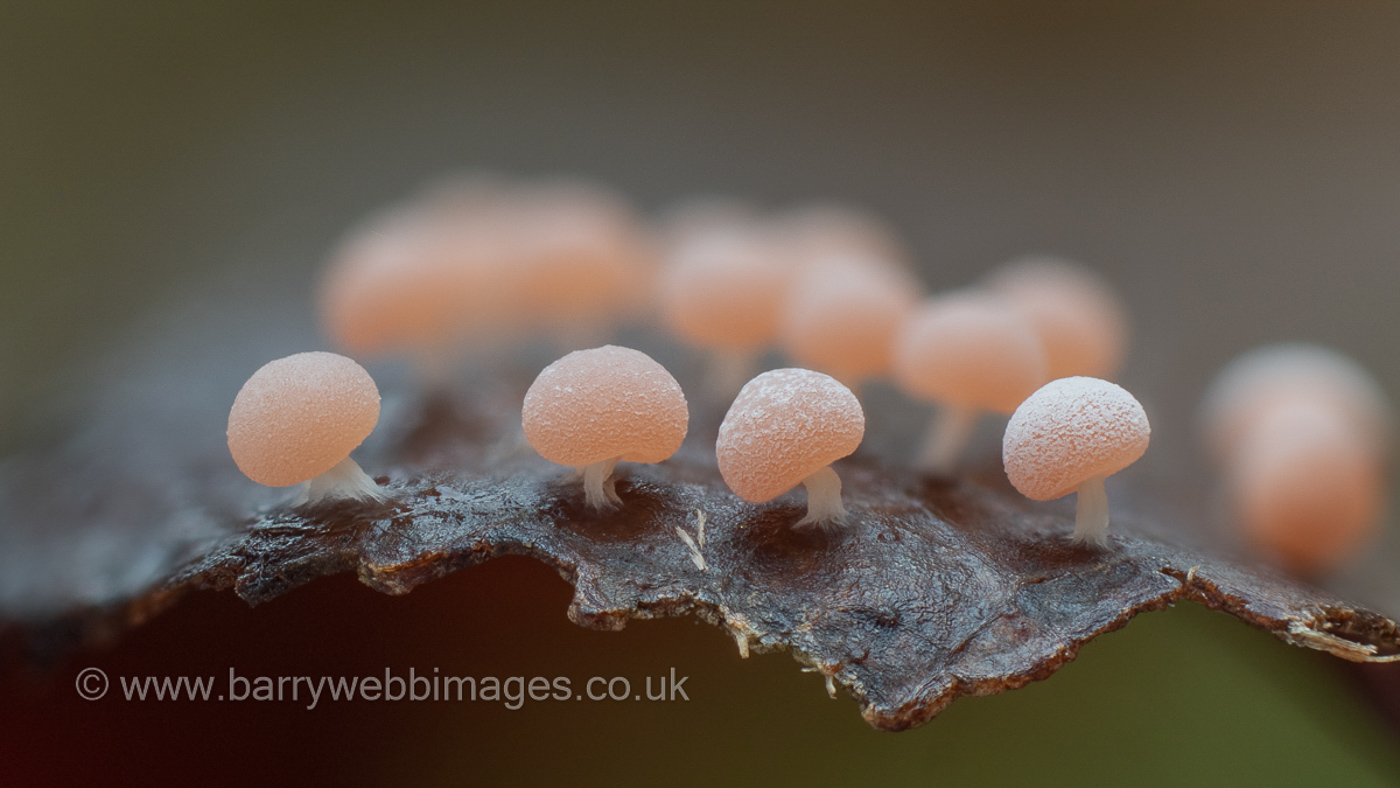
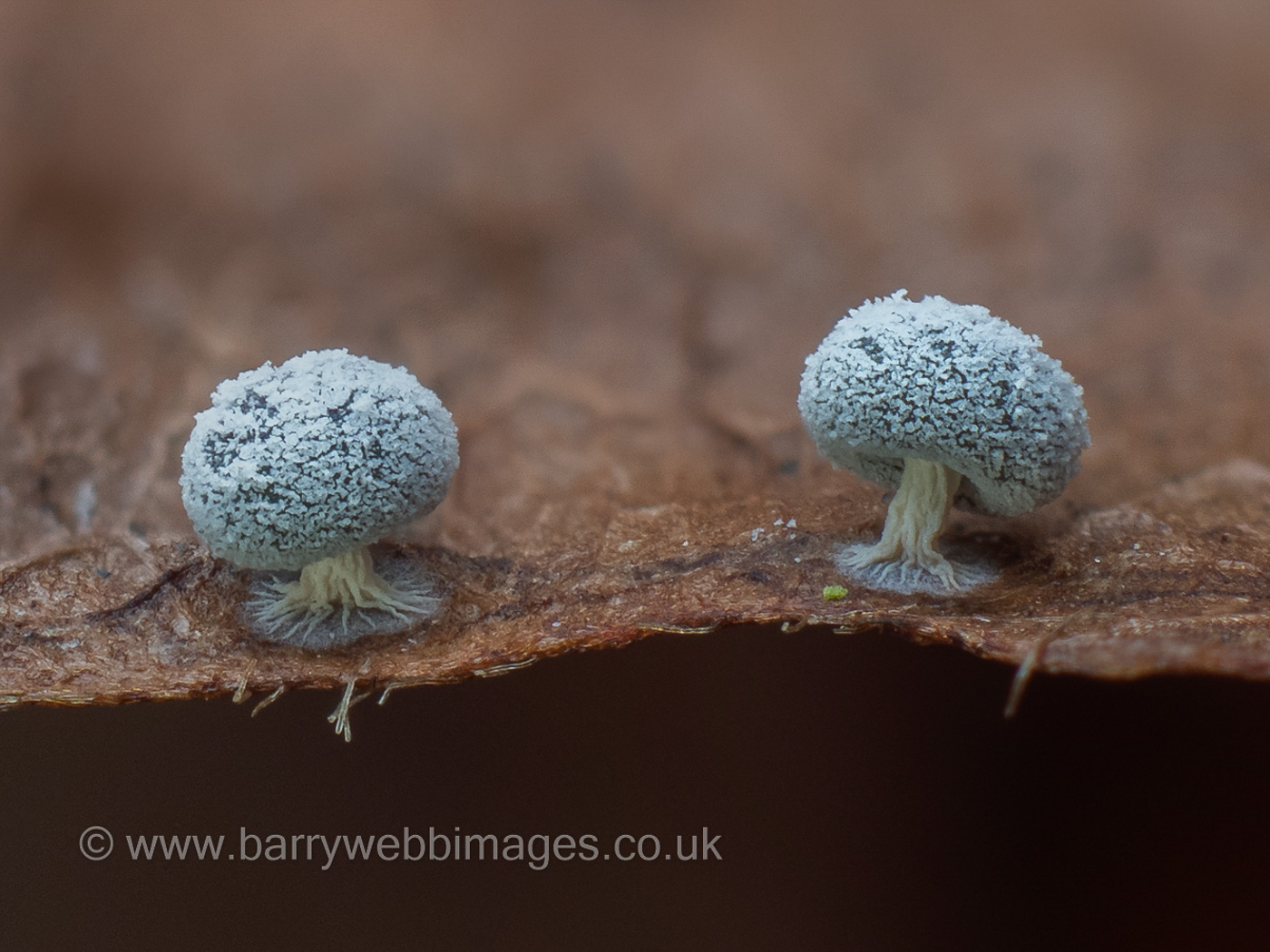
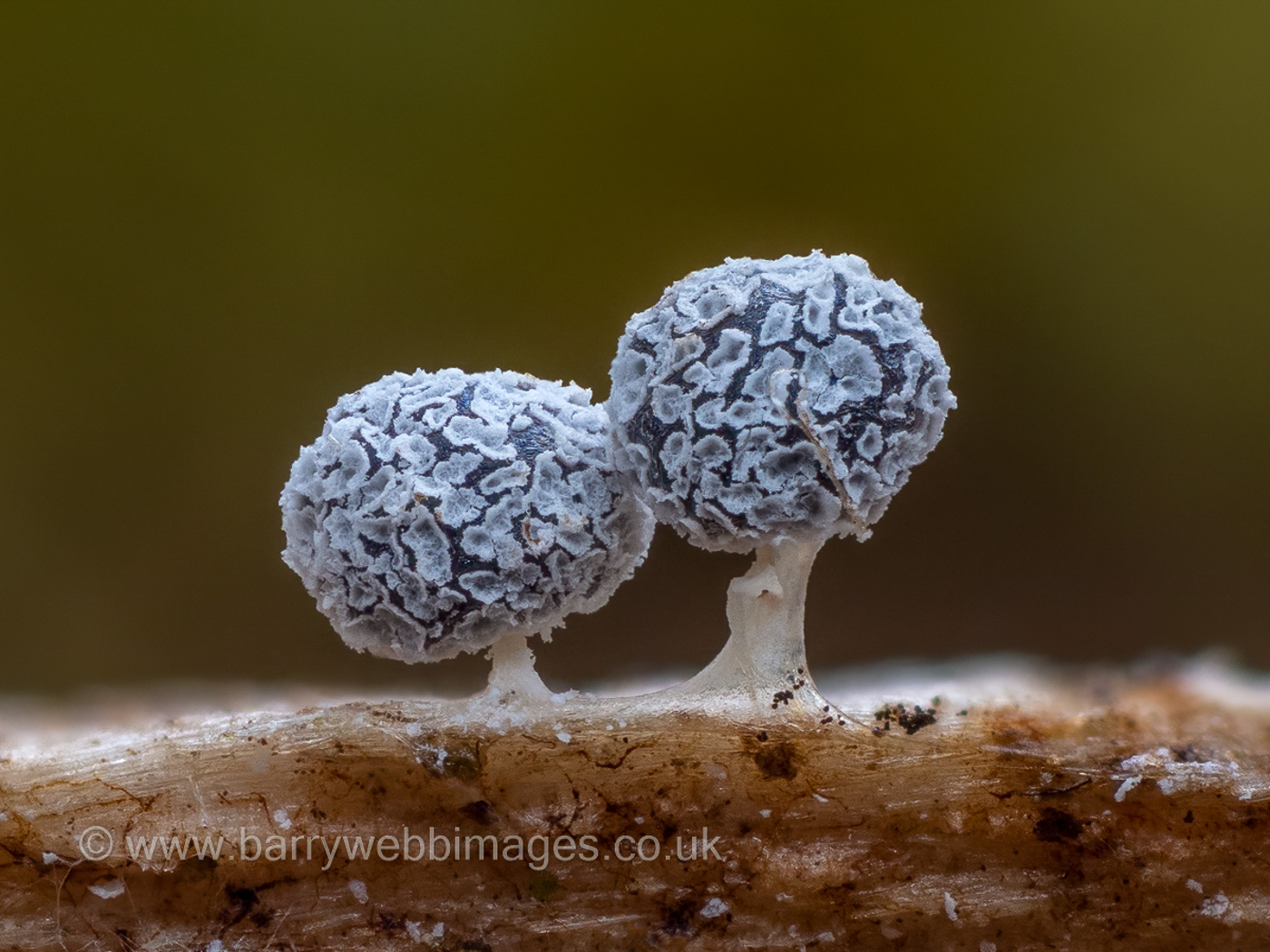 |
Didymium squamulosum (a slime mould with no common name)
Dec 30, 2021. In leaf litter under Holly in Hodgemoor Woods Barry found this immature but beautiful little species. For more notes and images see Barry's separate page in Members' Finds.
Dec 28, 2020. Barry Webb found this beautiful slime mould in deciduous leaf litter in Burnham Beeches (28.12.2020). (The determination was confirmed online by Myxo expert Paco Moreno) This is one of the commonest species of Didymium and we have plenty of county records though apparently only one previously for this site back in 1923! See notes for D. clavus for general comments on the genus. The short white stalk and subglobose spore-bearing head are characteristic of this particular species. Photo 2 is of a second collection from Burnham Beeches (09.05.2021) found by Barry on a woodchip pile.
|
E
|
|
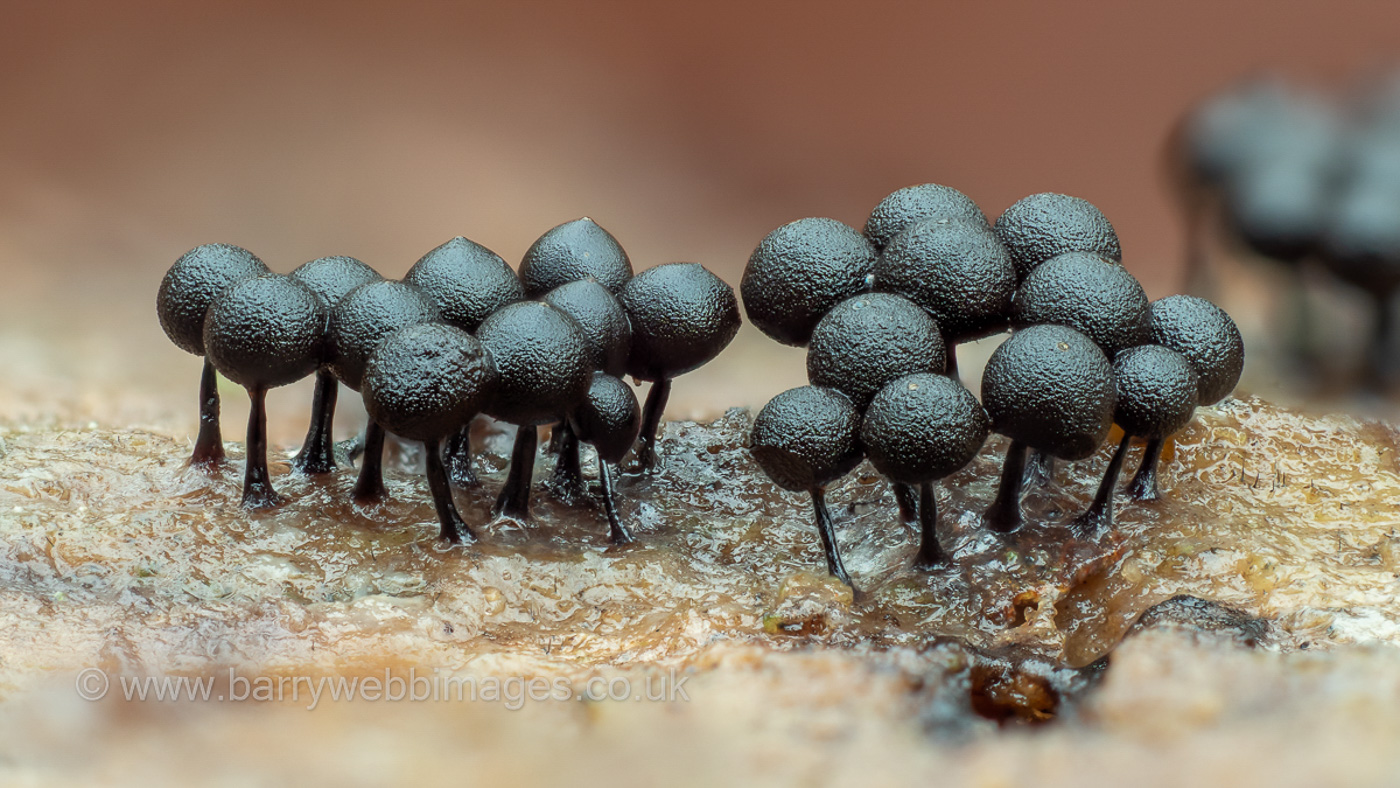
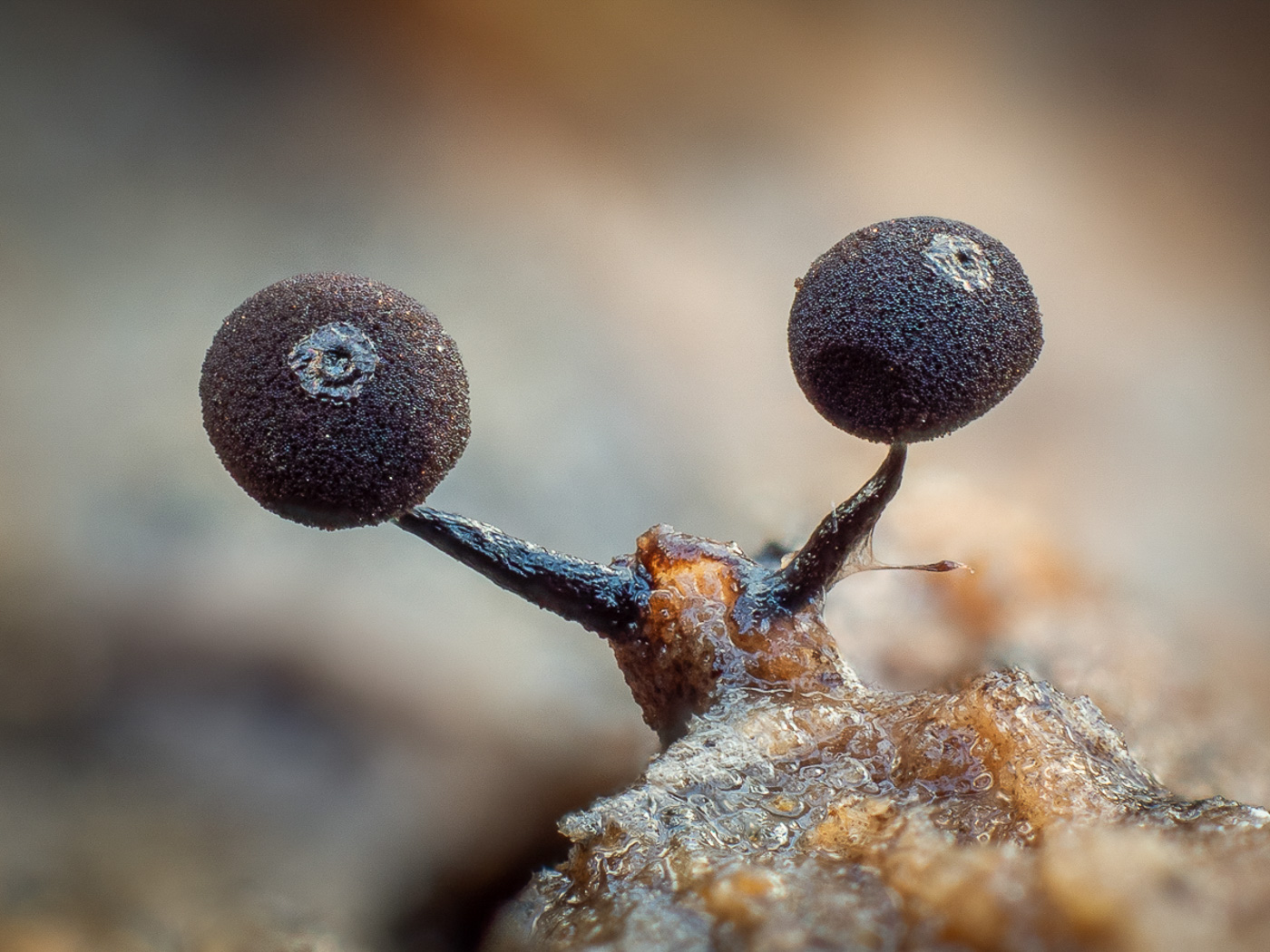
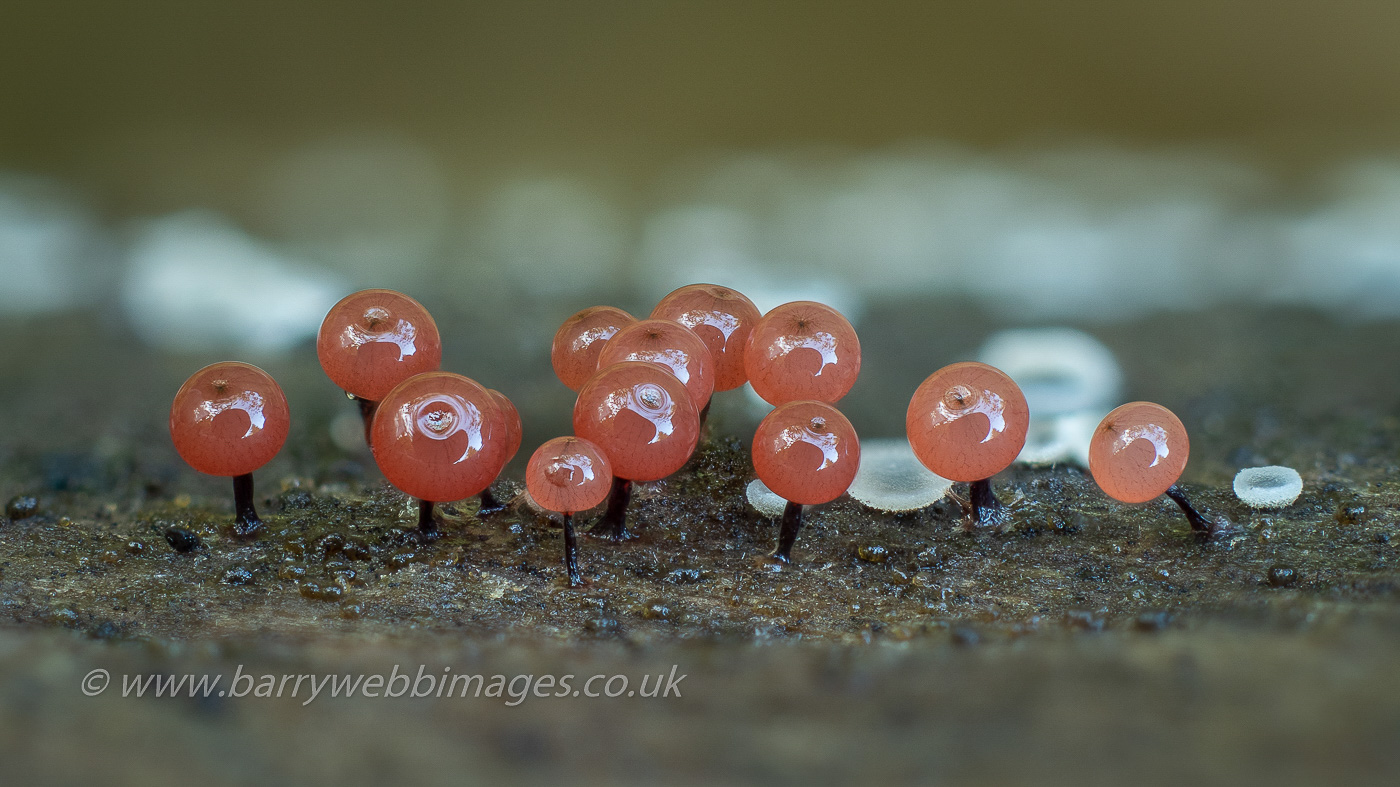 |
Enerthenema papillatum (a slime mould with no common name)
Dec 30, 2021. On a fallen Beech branch in Hodgemoor Woods Barry found this tiny species. For more notes and images see Barry's separate page in Members' Finds.
Aug 22, 2020. In Penn Wood Barry Webb found these tiny specimens growing on rotting fallen Beech. This is the only species of the genus found in the UK and though apparently common we have just three previous records from the north of the county, the most recent of which was in 2001. The distinctive flattened top with shiny central disc and black stalk narrowing at the top make this species recognisable in the field. The central disc can be seen already forming in the immature specimens in photo 2.
|
H
|
|
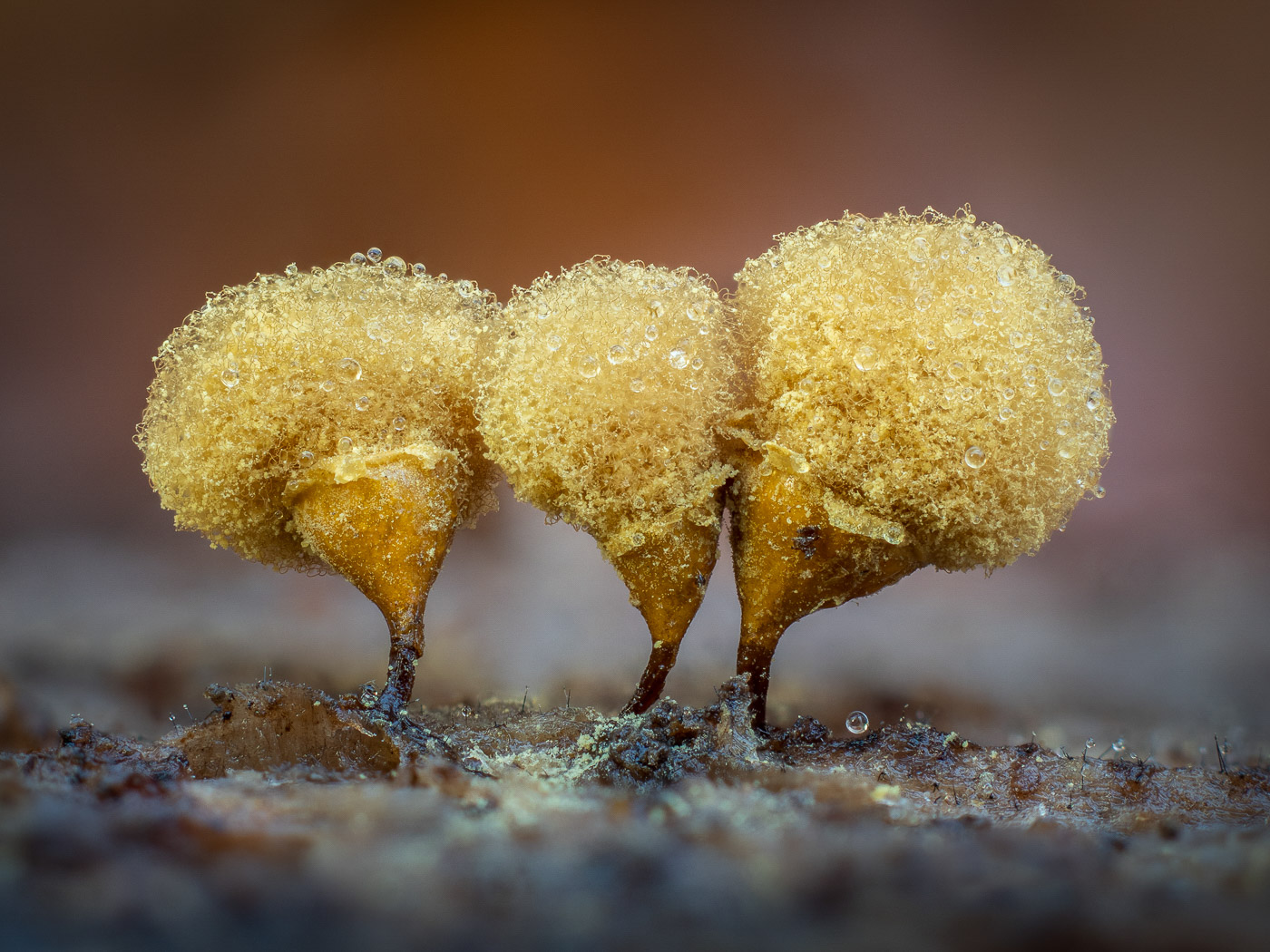
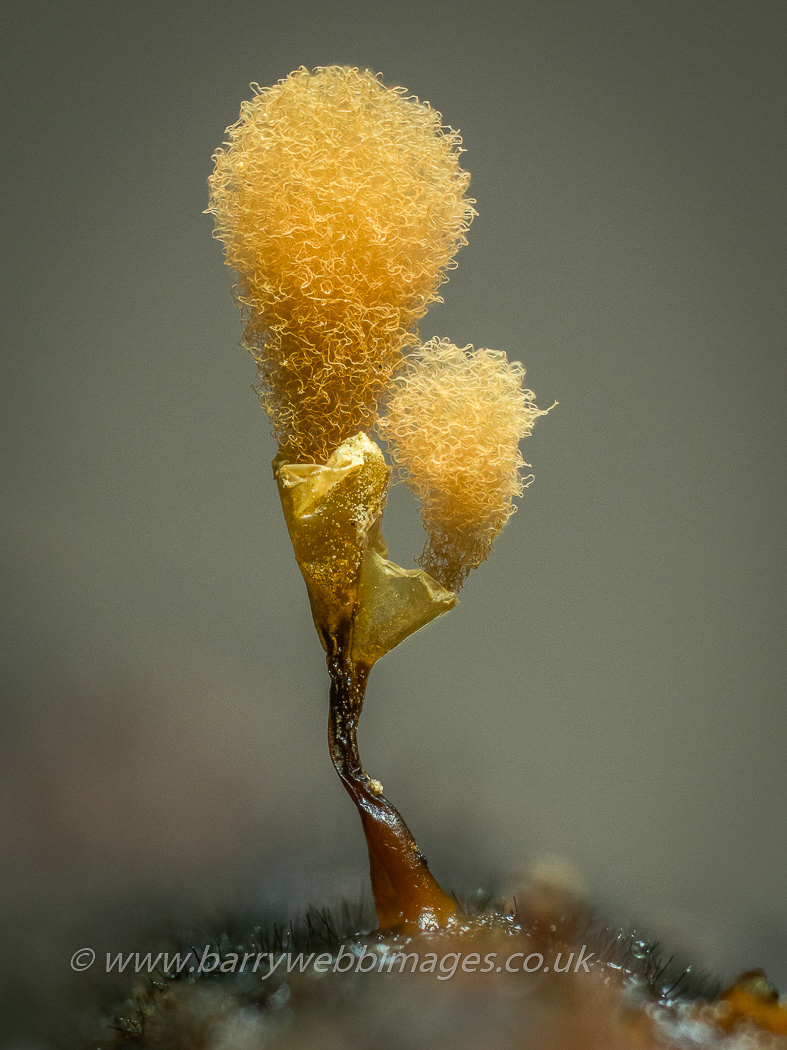 |
Hemitrichia calyculata (a slime mould with no common name)
Barry Webb found this beautiful slime mould on fallen rotting Birch in Common Wood (01.03.2021). Though described as a common species in the south, this appears to be our first county record - reflecting the general lack of local expertise and interest in slime moulds until Barry put this right and started producing his amazing photos.There are several very similar species, so Penny would have been happier to have checked the microscopic characters as it's a first for the county, but the dark solid stalk suddenly flaring out at the top together with the tear-drop shaped sporangium (spore bearing mass) having a shallow shiny cup with typically frayed edges is sufficiently diagnostic to confirm Barry's determination.
|
 |
Hemitrichia serpula (a rare Slime Mould with no common name)
Dec 1, 2022. At Hedgerley Green Barry Webb was excited to find this rare species growing on a fallen Laurel leaf. Not only new to the county, it is a species with few UK records though with climate change it is beginning to occur naturally in woodland rather than in hothouses. Its shape and form certainly make it distinctive and to Penny it is reminiscent of a tiny Cadbury's 'Curly Wurly'!
|
L
|
|
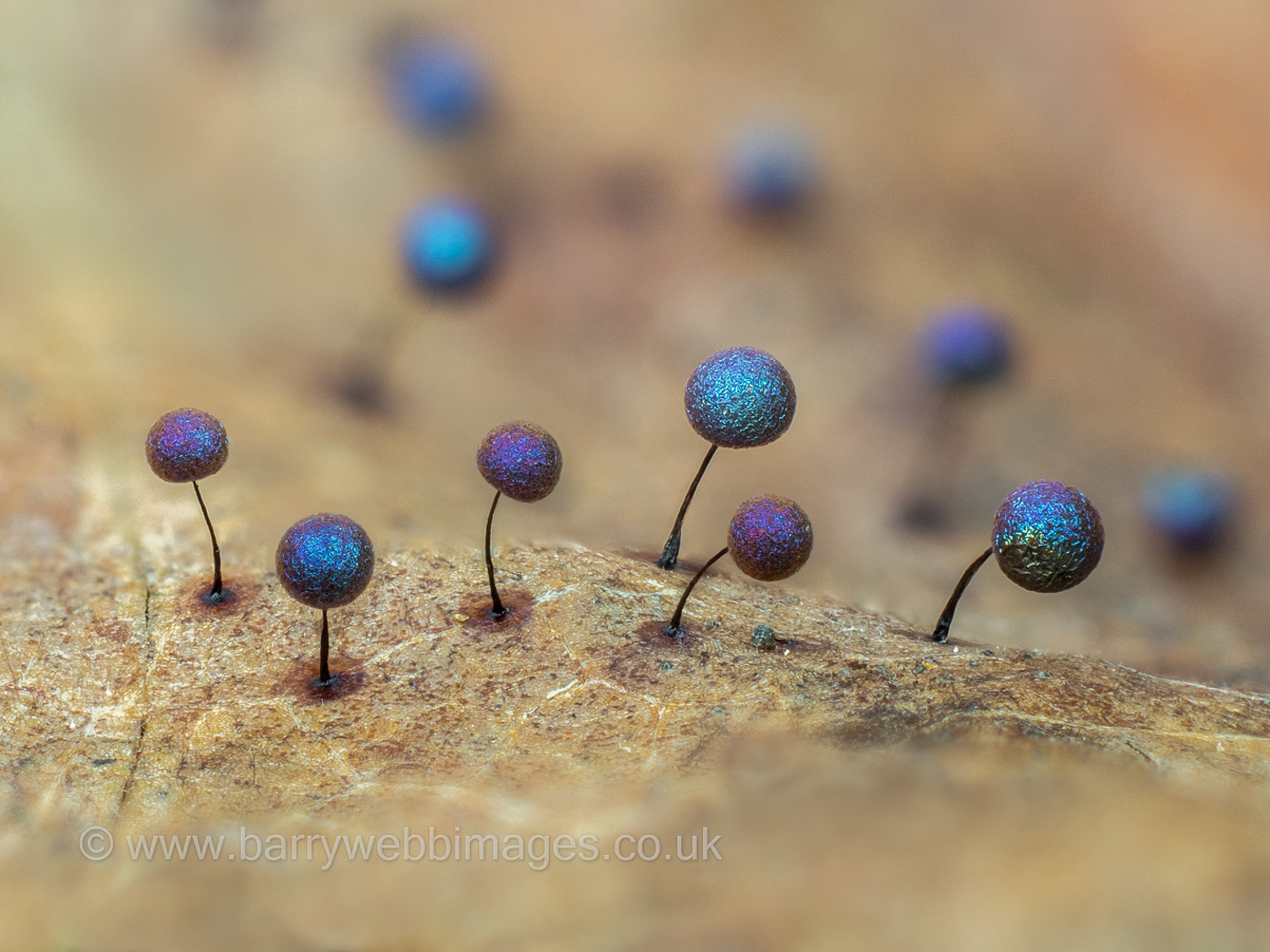 |
Lamproderma scintillans (a slime mould with no common name)
Dec 24, 2020. Barry Webb found these glistening little beauties (only 1-2 mm high) in Burnham Beeches in deciduous leaf litter. This species is not only new to the site but also to the county. (The determination was confirmed by Andy Sands from Barry's excellent photo.) The iridescent colours are typical of the genus, all species of which are very small thus often missed and presumably under-recorded also.
|
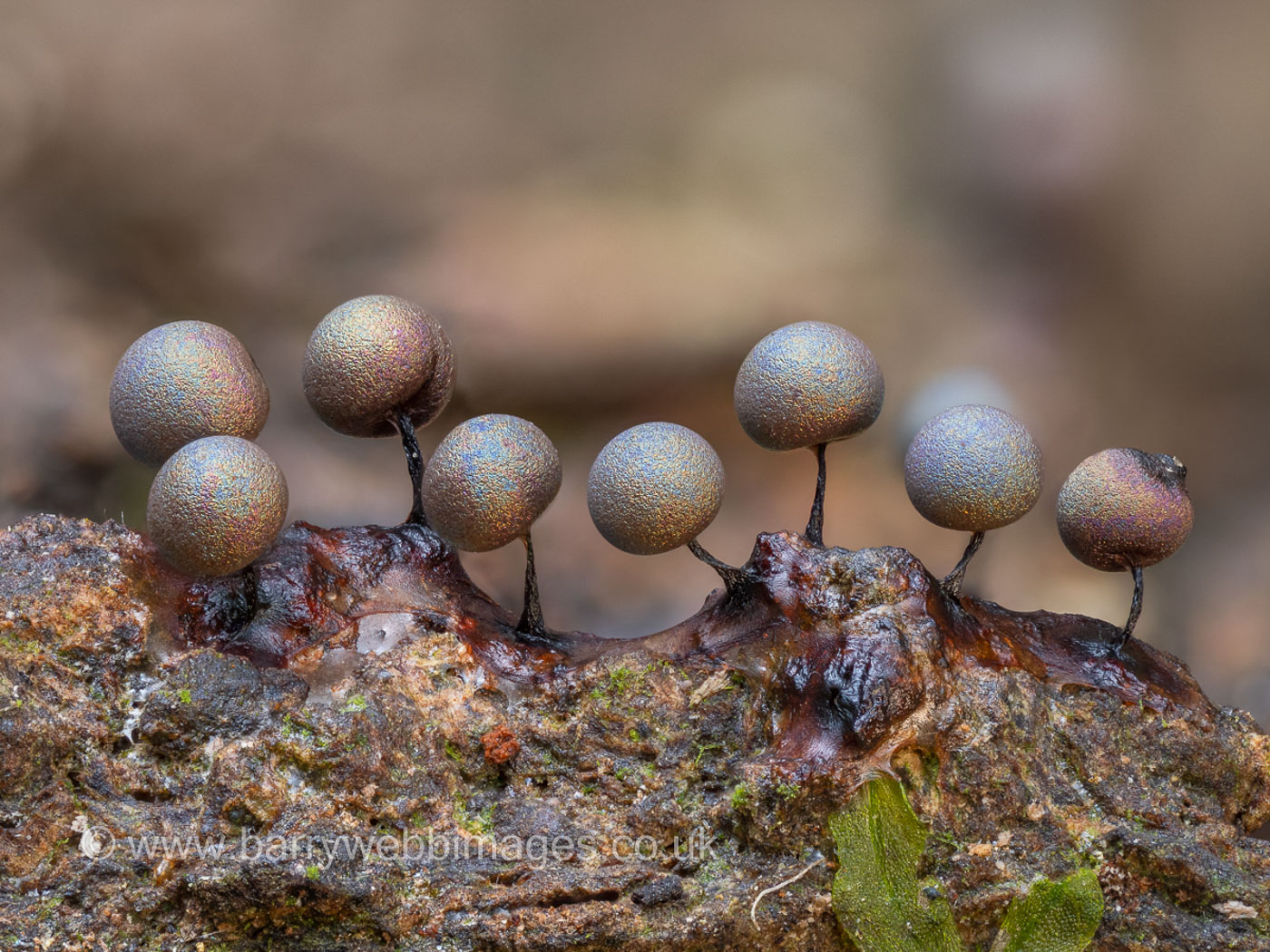
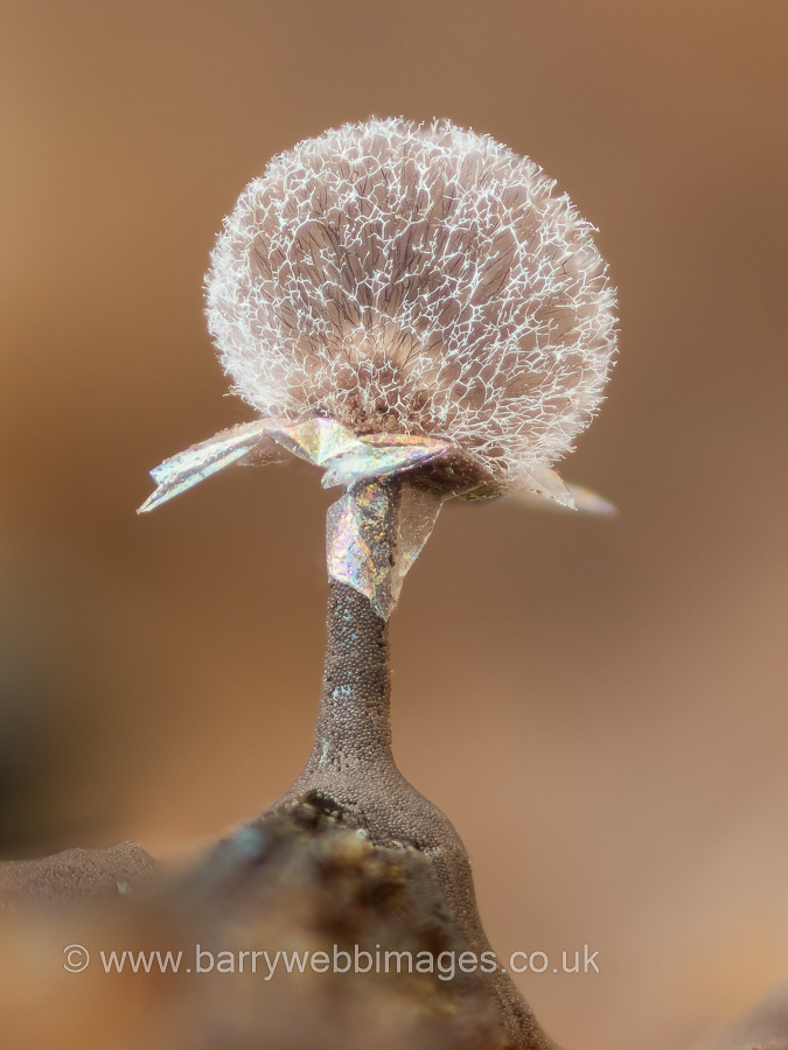 |
Lamproderma violaceum (a slime mould with no common name)
Nov 22, 2023. In Burnham Beeches on a large fallen rotten Beech Barry Webb was even more pleased to find this tiny little species which was identified for him from his photos by Myxomycete expert Edvin Johannesen. Previously L. arcyrioides it shows the typical glistening irridescence of the genus and photo 2 shows it once it splits open for spore distribution to occur (dehiscence). We have just one previous county record from Salcey Forest in 1990. This is a new entry for Finds.
|
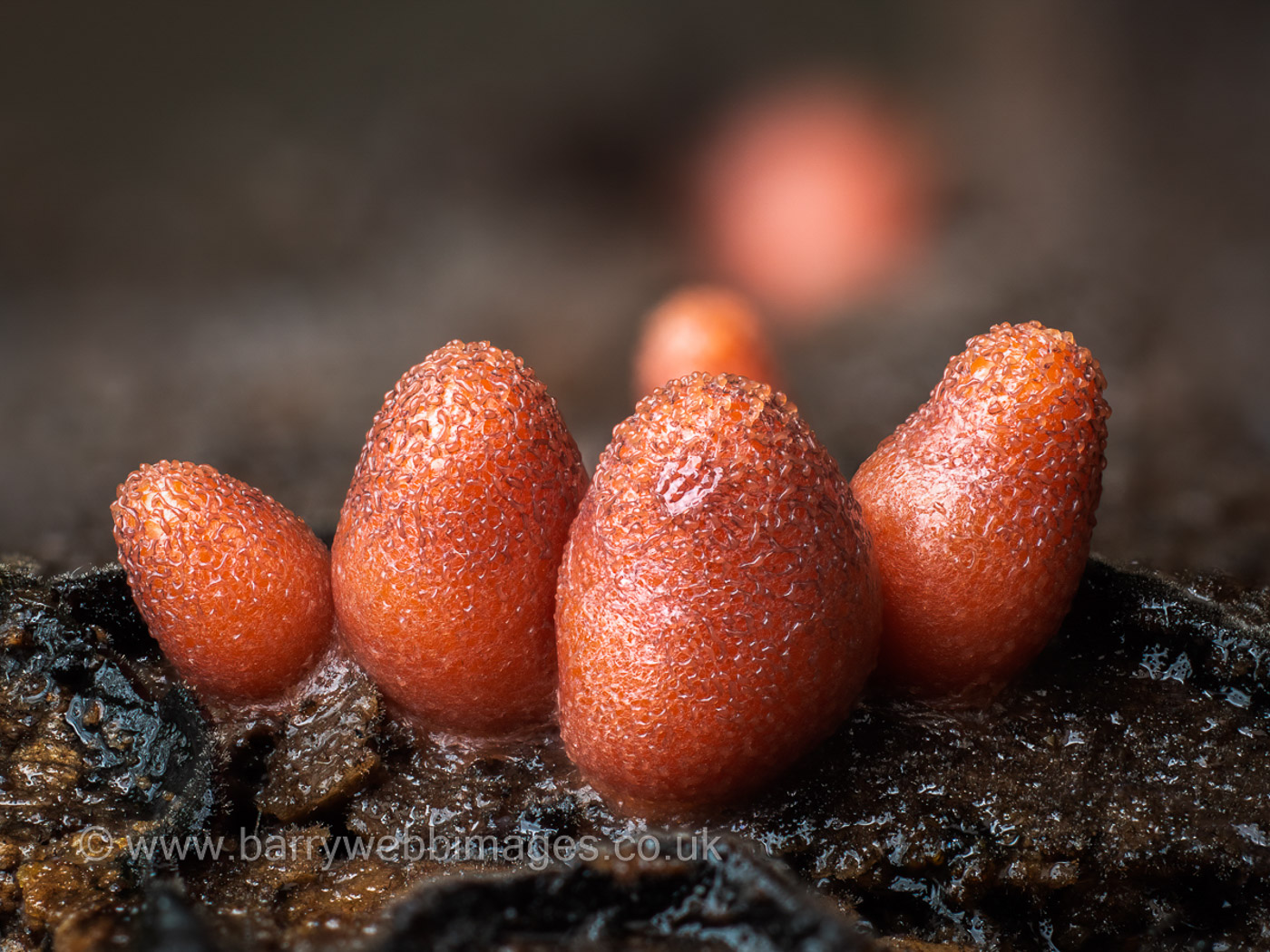
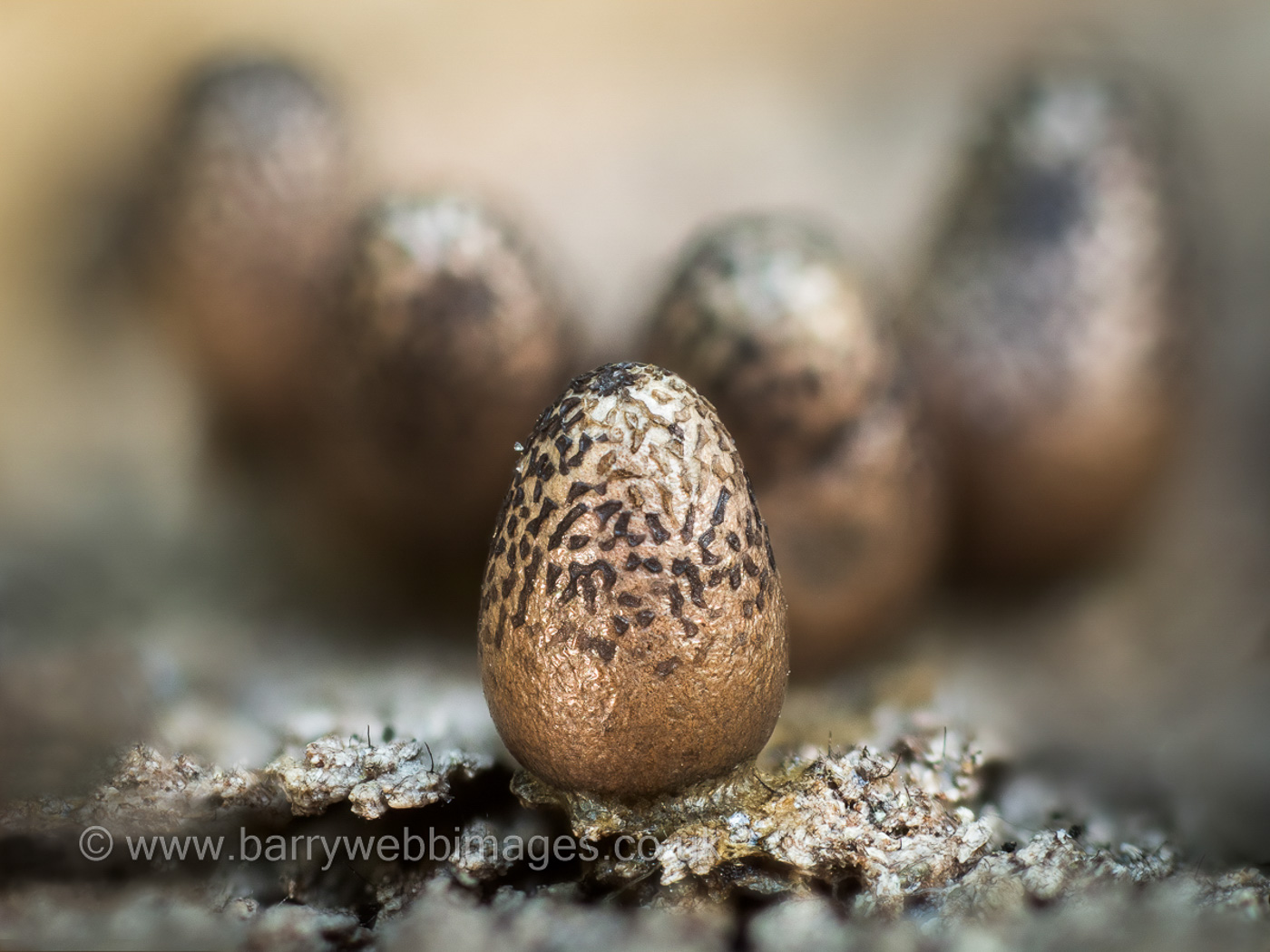 |
Lycogala conicum (a Slime Mould with no common name)
Jul 6, 2021. In Burnham Beeches on rotting fallen Birch Barry found this rare species, similar to the very common and familiar L. terrestre (Wolf's Milk) but instantly separable from it by its very distinctive conical egg shape. As with the (much) commoner species the plasmodium stage is pink, as are the developing sporocarps (fruiting bodies) which as they mature and dry off become gradually grey buff. Photo 2 (taken of a collection on a different Birch nearby found 10 days later) shows mature sporocarps. New to the site and the county, there appear to be under 20 national records of this species.
|
M
|
|
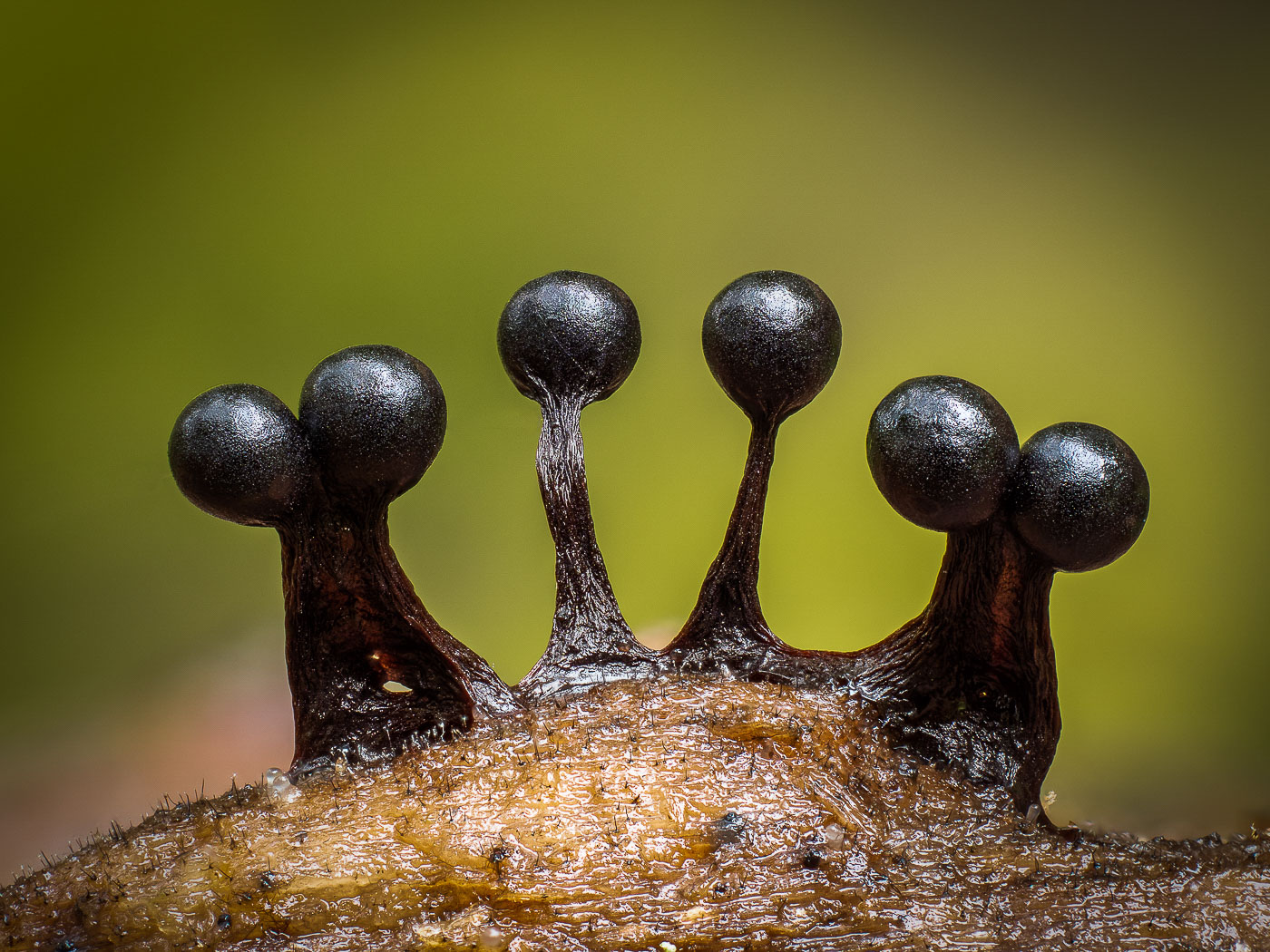
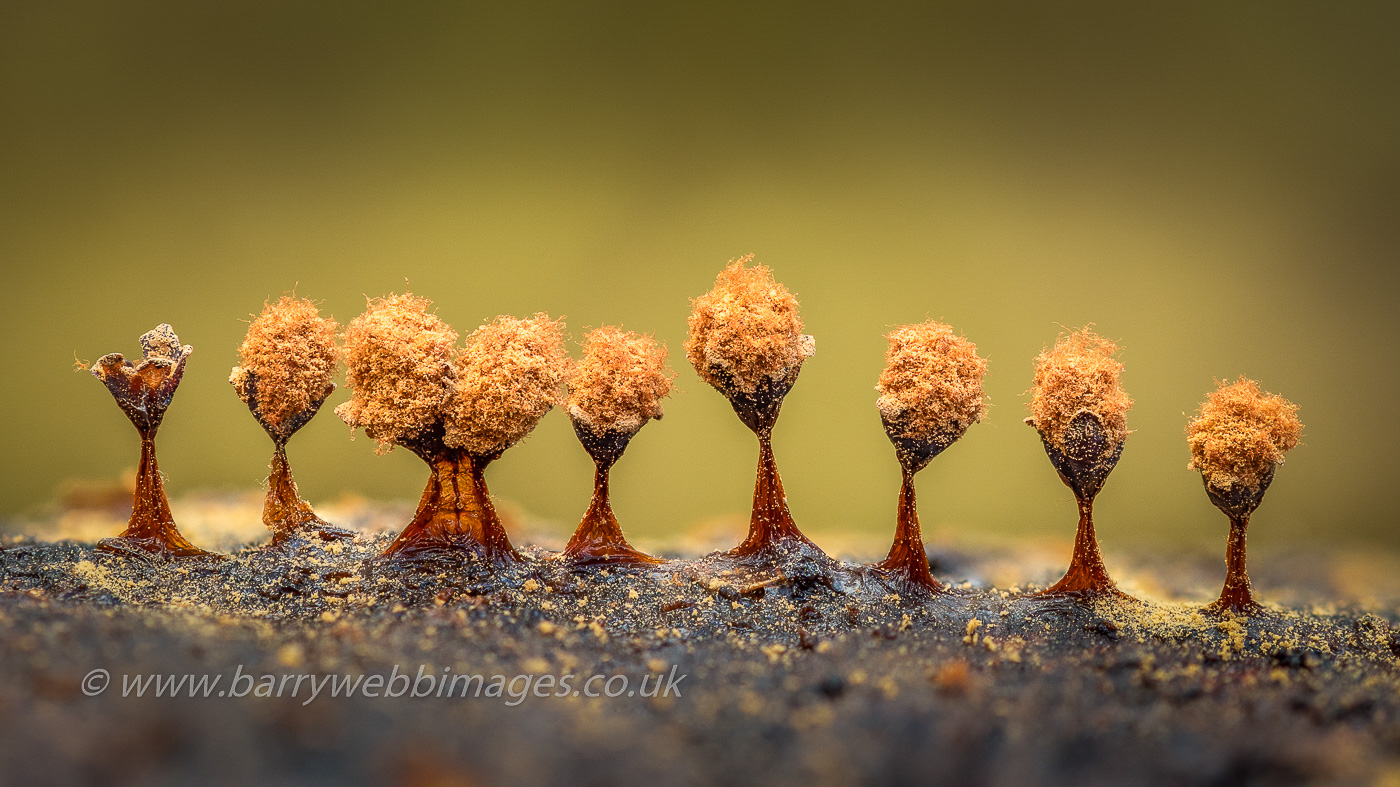
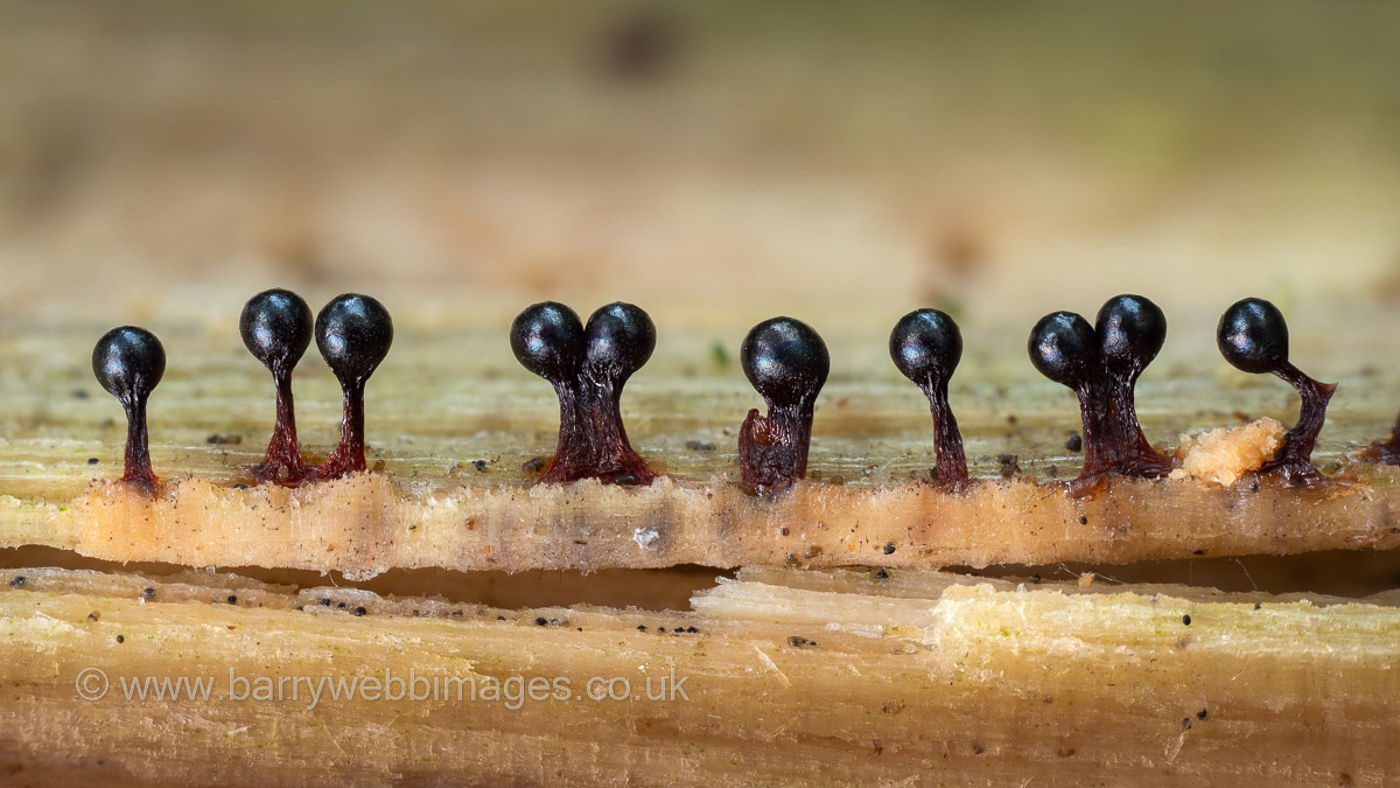
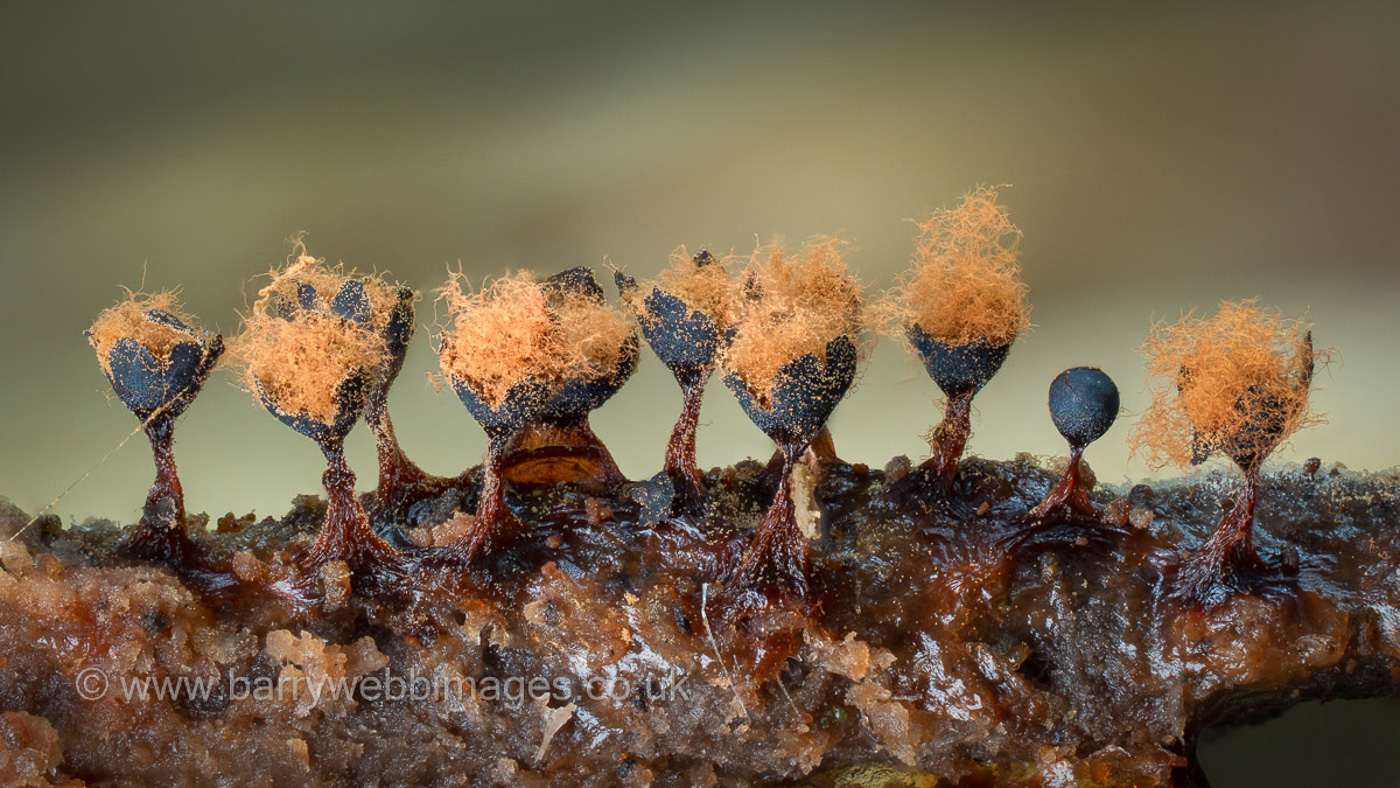 |
Metatrichia floriformis (a Slime Mould with no common name)
Oct 17, 2020. Barry Webb took the first photo in Penn Wood, part of a colony of this tiny very common slime mould which grows on rotting damp fallen wood. The plasmodium (early slimy stage) of this particular species is dark red to black, then it gradually 'mutates', developing into these black blobs on stalks less than 4 mm high which then split open forming a flower-like shape (hence its species name) and from which the orange spore mass disperses. Photo 2, found in 2019 at the same spot in Penn Wood, shows this later stage. Photos 3 and 4, also showing two stages of development, were found at Ivinghoe Common (04.09.2021).
|
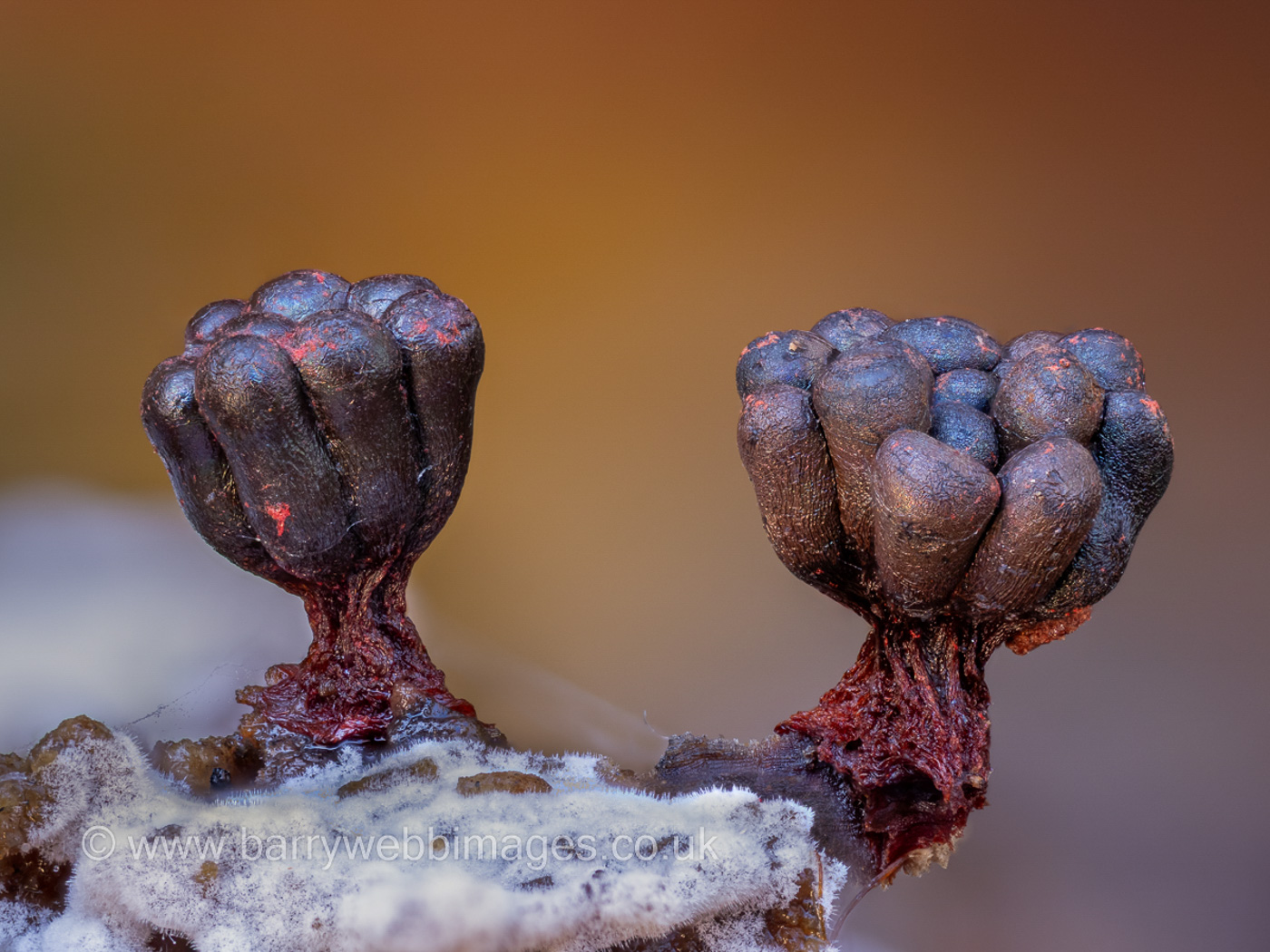 |
Metatrichia vesparium (a slime mould with no common name)
Nov 22, 2023. In Burnham Beeches on a large fallen rotten Beech Barry Webb was pleased to spot this particular species as it has been eluding him (and Penny)despite not being described as rare. He found it recently on a visit to the New Forest but this is a new record for Bucks. When mature as here it is, however, distinctive enough to be recognised and named in the field, the clustered sporangia bearing a distinct resemblance to a wasp's nest (which gives rise to its Latin species name) despite being tiny. This is a new entry for Finds.
|
P
|
|
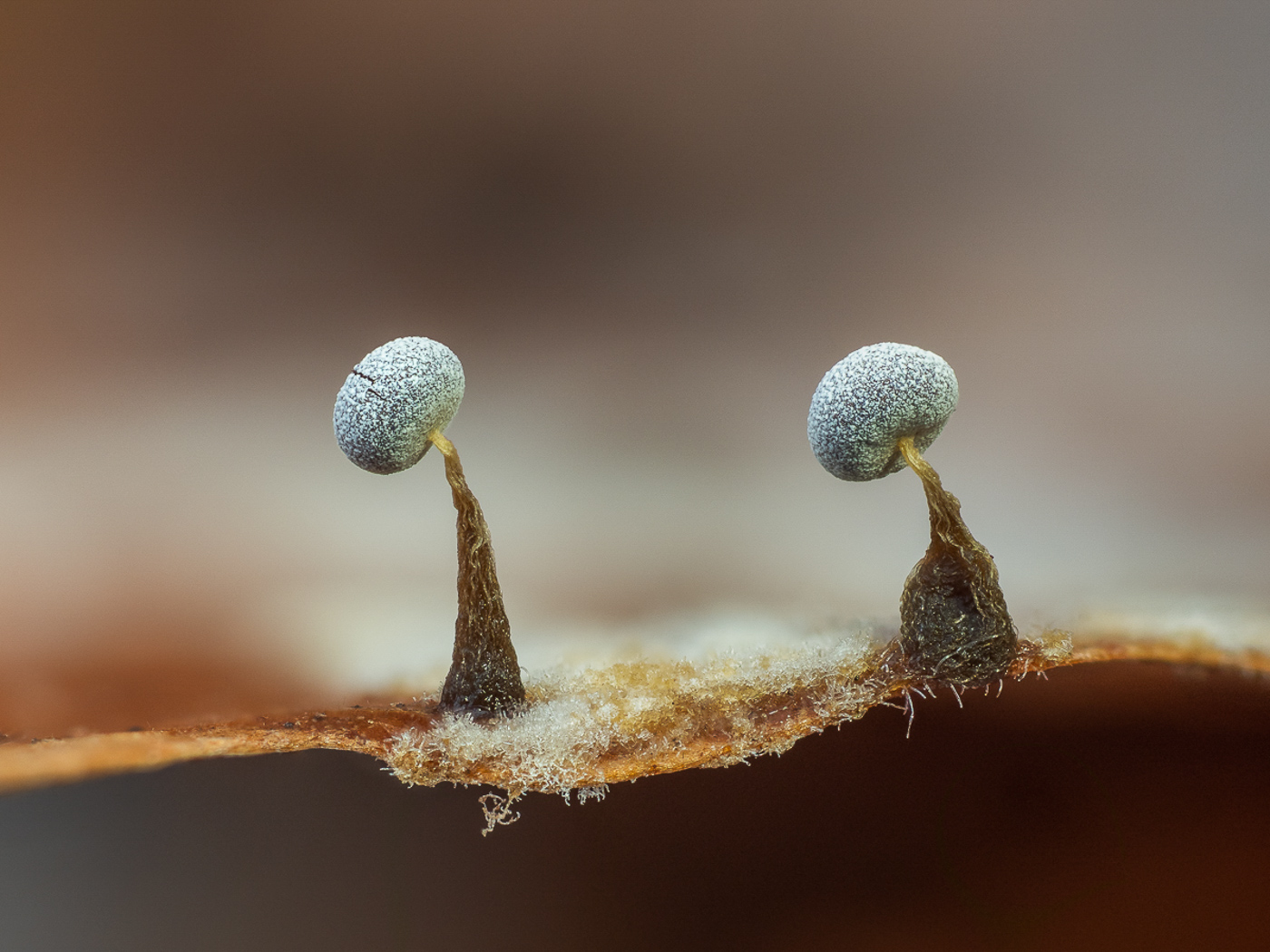
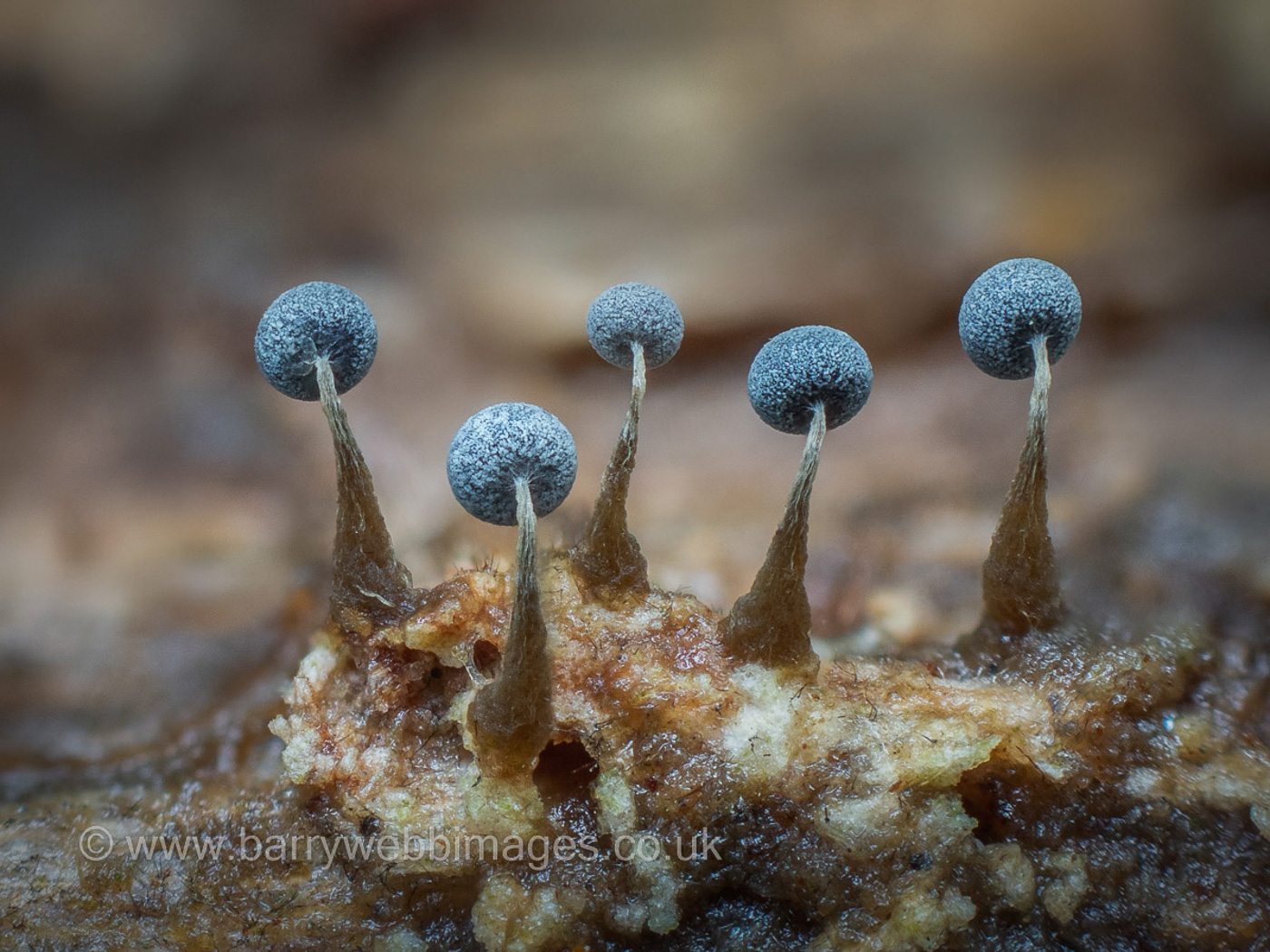 |
Physarum album (a Slime Mould with no common name)
Nov 1, 2020. Barry Webb found this quite common species (previously known as Physarum nutans) growing in Beech litter at Burnham Beeches. A member of a large and difficult genus to identify to species, this particular species can with experience be named in the field because of its 'nodding' habit: the heads, covered in white crystals, tend to droop. Found sometimes in large colonies, each sporocarp (fruiting body) is no taller than 1 cm. Photo 2 is of a collection made at Ivinghoe Common (04.09.2021).
|
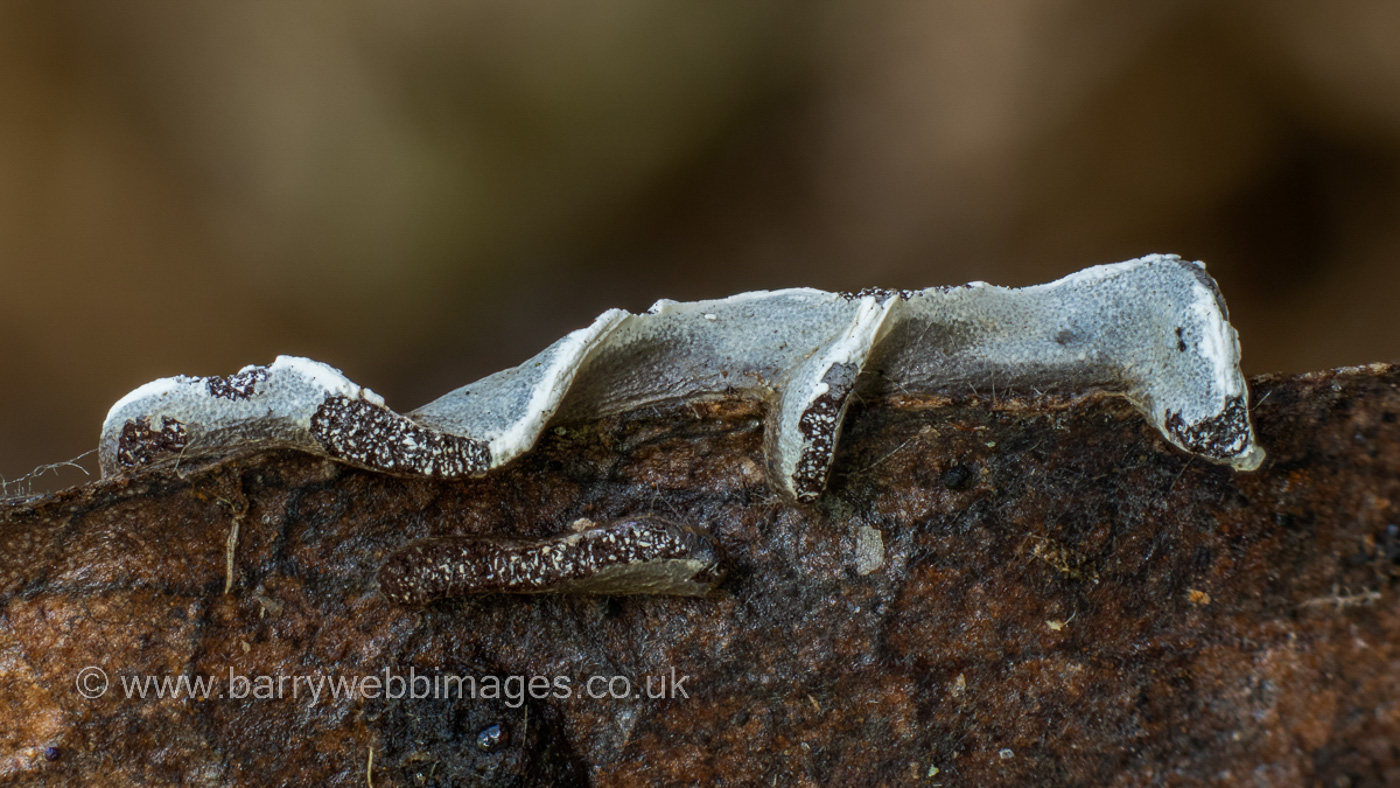 |
Physarum bivalve (an unusual Slime mould with no common name) 
Dec 8, 2022. In leaf litter at Burnham Beeches Barry Webb found this tiny strip of a slime mould species, new to him and to the site and with just one previous county record when identified by expert Bruce Ing from a specimen sent him by Penny in 2014 from Carpenters Wood. Barry's collection was identified by expert Edvin Johannesen from his macro- and microphotos.
|
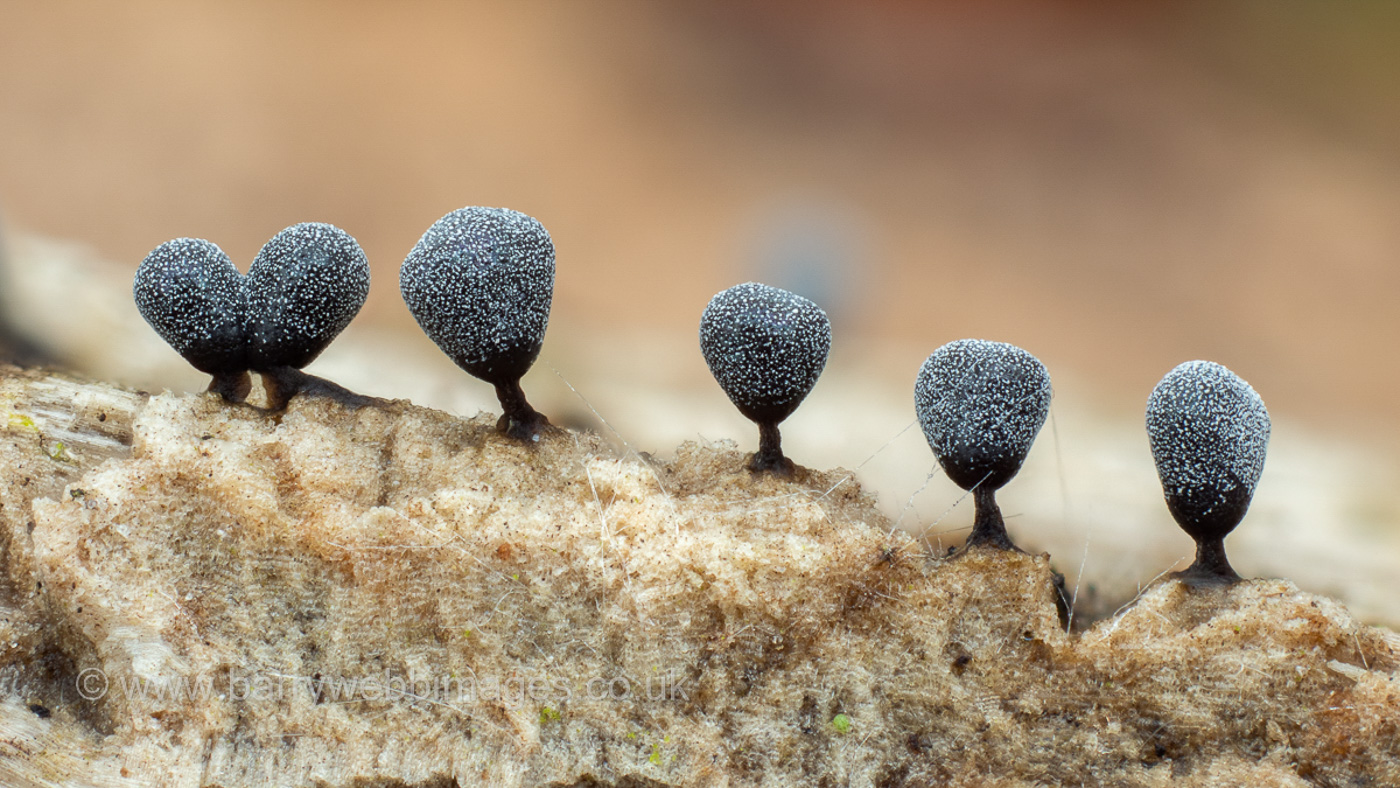
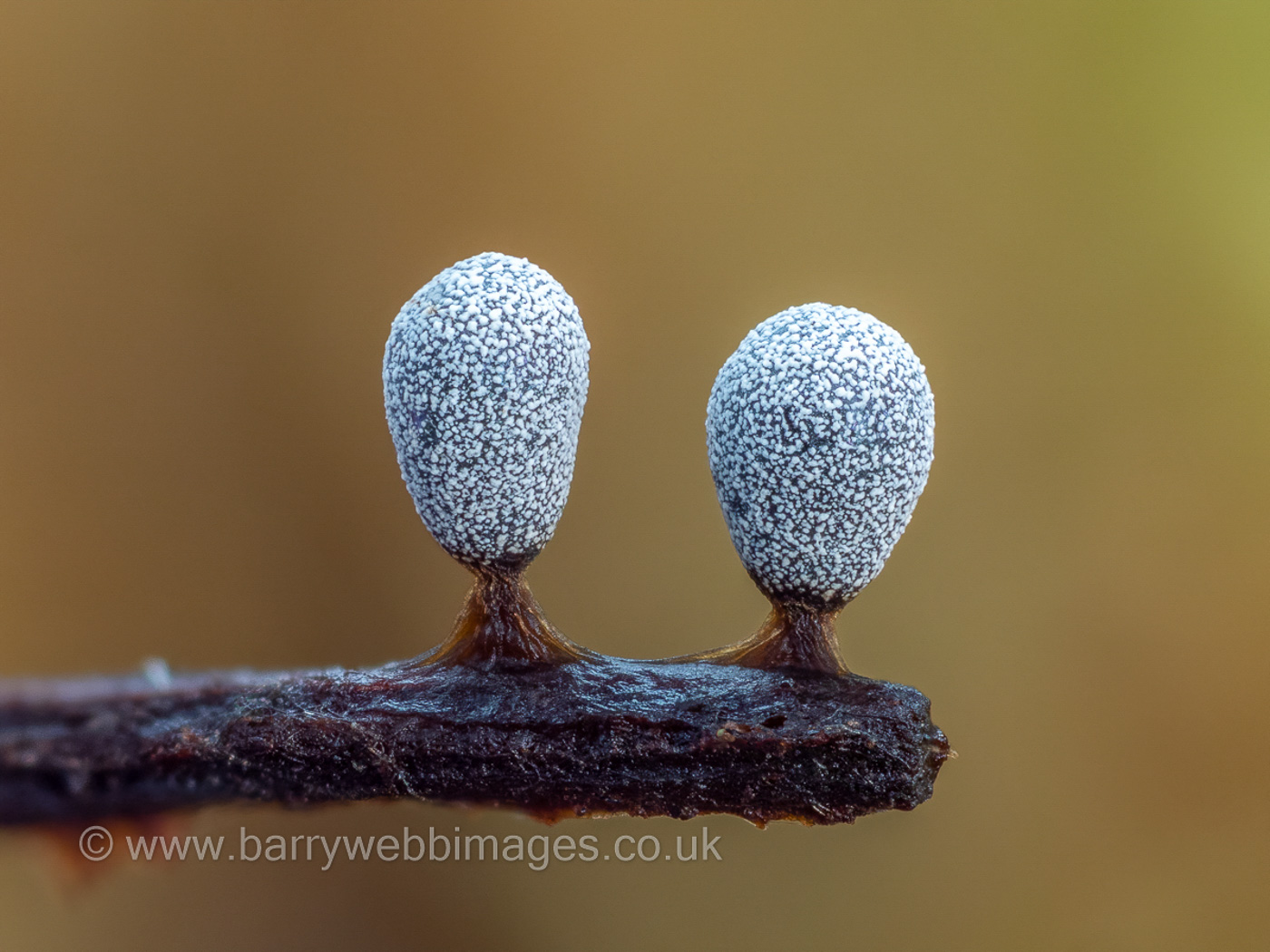 |
Physarum compressum (a slime mould with no common name)
Mar 16, 2021. Barry Webb found this delightful line of tiny blobs in Burnham Beeches on a woodchip pile. (The determination was confirmed online by Myxo expert Edvin Johannesen.) This particular species has a very dumpy short stalk (not called a stem or stipe as in fungi) and over all is no more than 1 mm tall. Though described as quite common, this is our first record for the county.
|
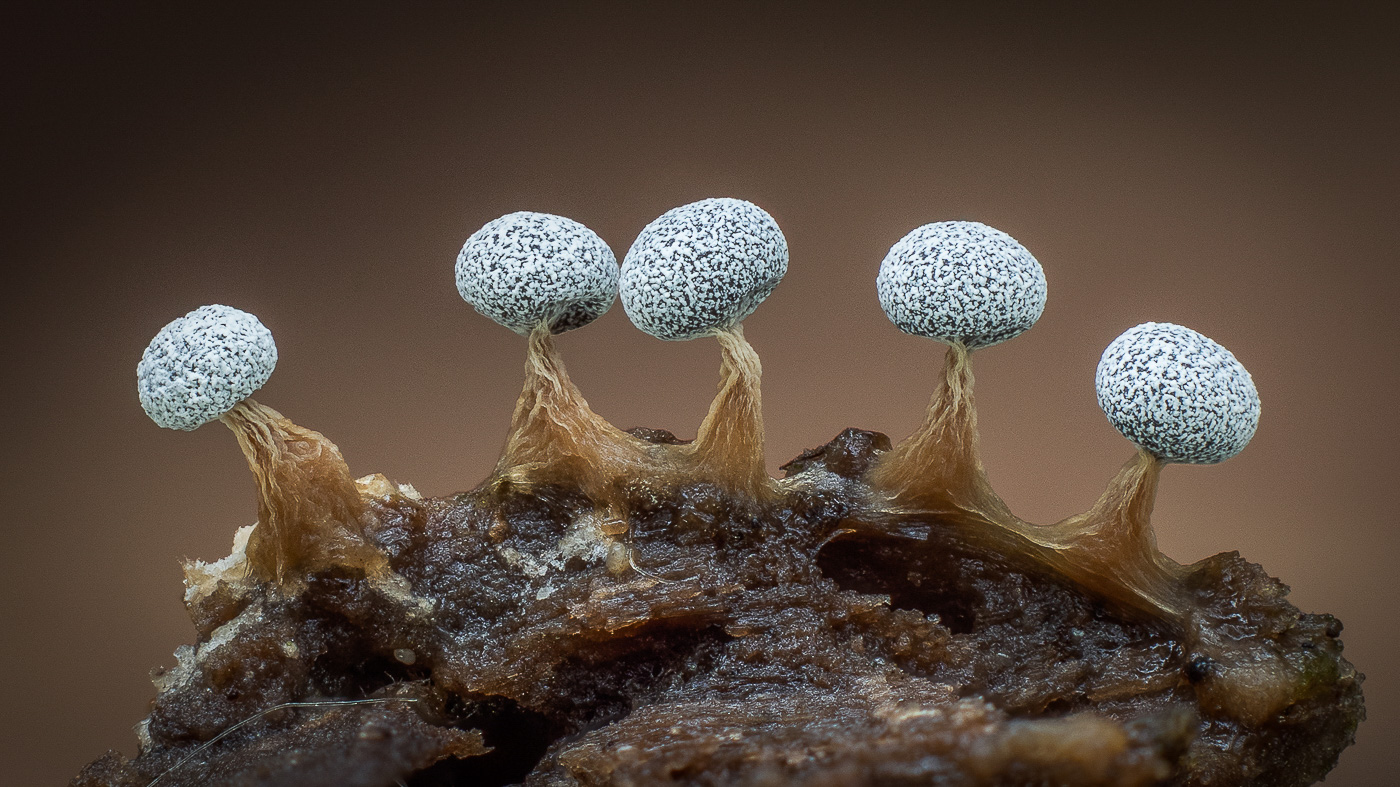 |
Physarum leucophaeum (a Slime Mould with no common name)
Oct 16, 2020. Barry Webb found these tiny gems on rotting fallen Beech in Burnham Beeches. No more than 1.5 mm high, this species is a member of a very large genus which has a protective coating of calcareous crystals or granules covering the sporangium (fruiting head), giving the appearance of being dusted with icing sugar. We have just two county records of this species, reflecting the rarity of expertise amongst recorders rather than of what is apparently a common species! (See also P. leucopus found the same day.)
|
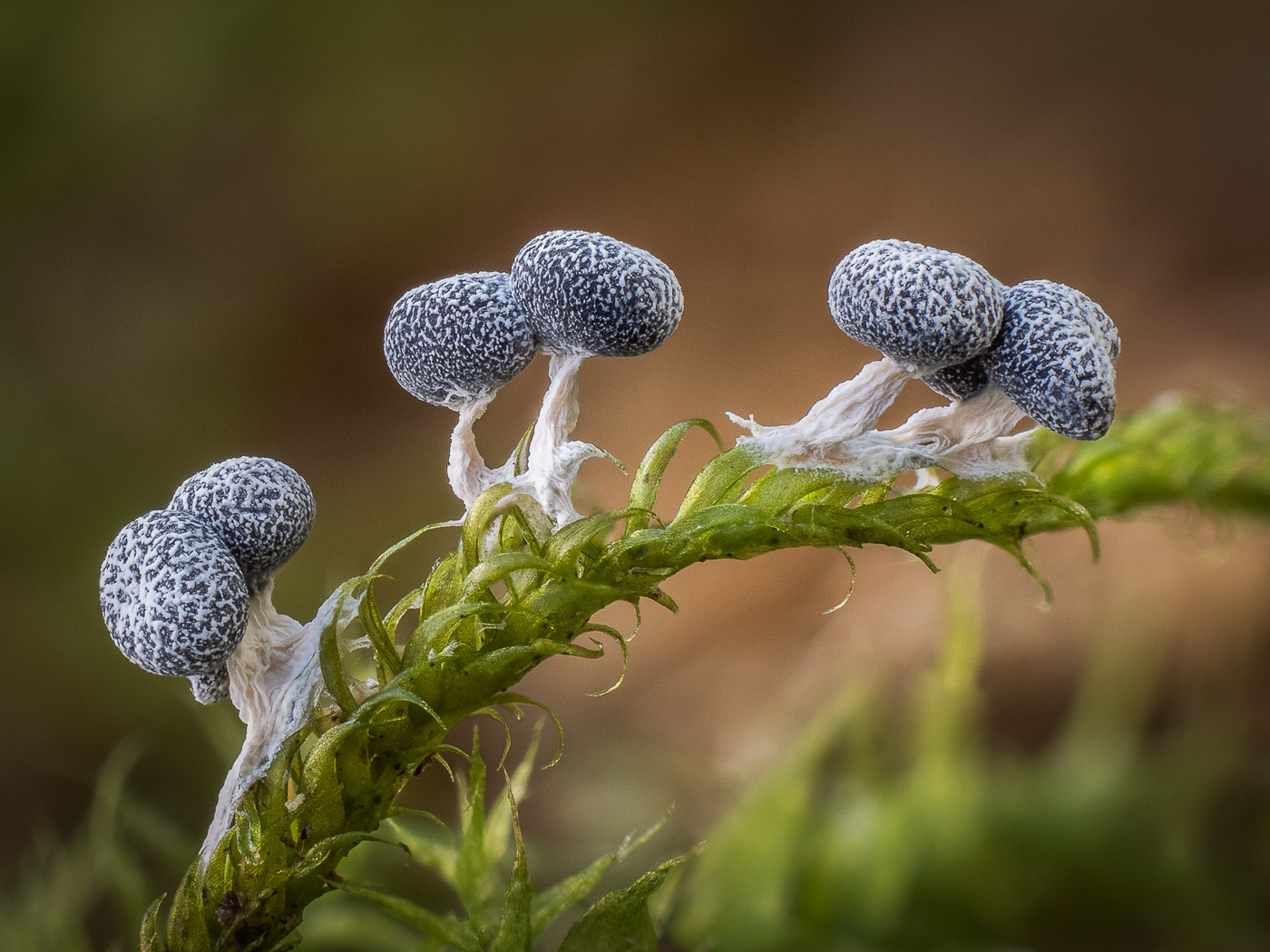 |
Physarum leucopus (a Slime Mould with no common name)
Nov 6, 2020. Barry Webb found this uncommon slime mould growing in moss on a Beech log in Burnham Beeches. (The determination was confirmed online by Myxo expert Edvin Johannesen.) Clearly very similar to P. leucophaeum, (see notes for that species), it inhabits woodland debris rather than wood itself and has a distinctive white stalk, hence its species name. This is new not only to the site but also to the county.
|

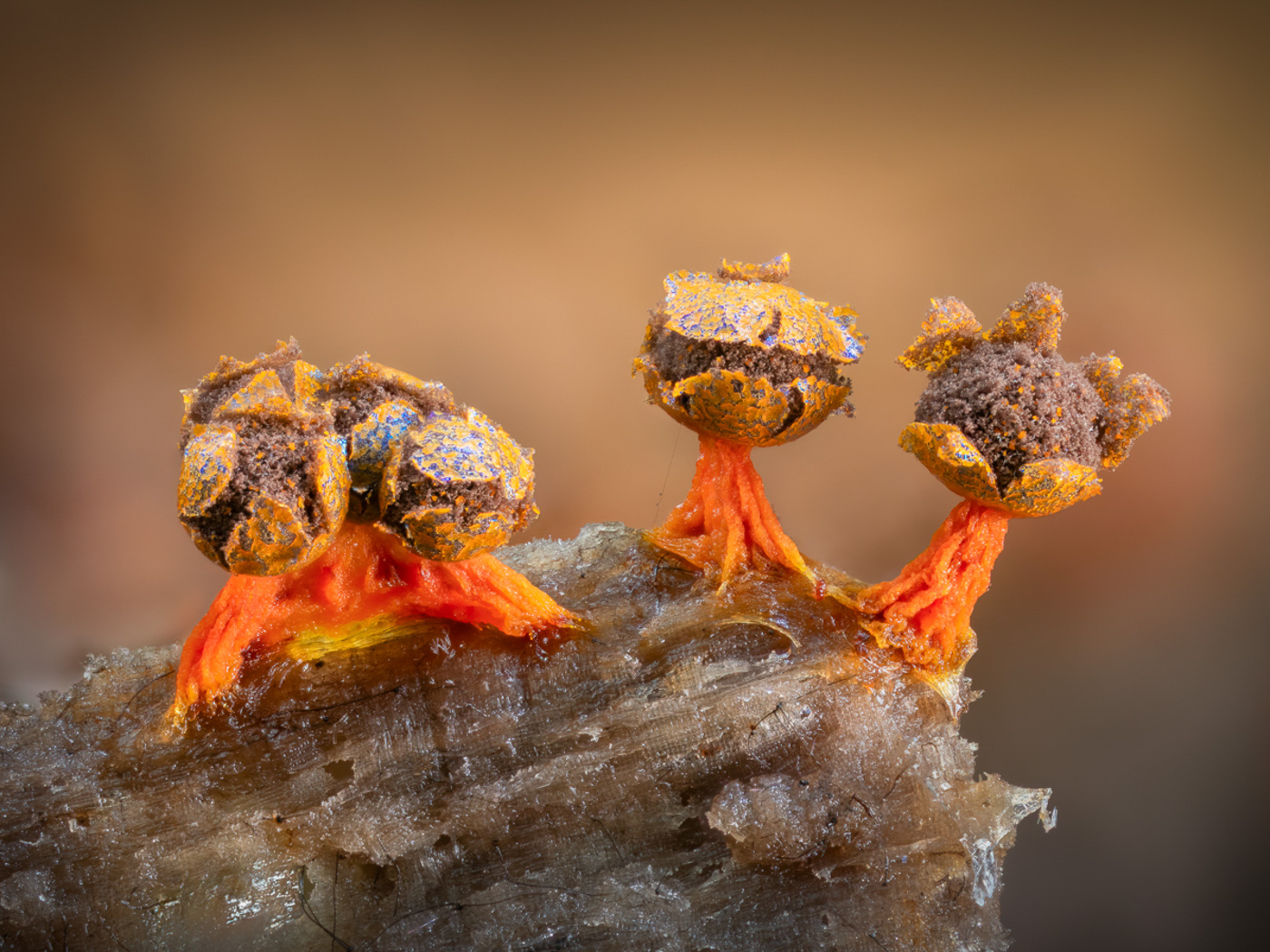 |
Physarum psittacinum (an unusual Slime Mould with no common name)
Jul 11, 2023. At Penn Wood on fallen rotting Beech, Barry Webb found this beautiful and distinctive species, new to the county. Only at most 1.2mm high, it is notable for its brilliant orange stalk, iridescent bronze sporangia with both blue and orange reflections - all these elements clearly visible in Barry's amazing photo and making it easy to recognise- the tricky bit is finding it in the first place! Photo 2 is of a second more mature find of this rarity by Barry at the same site on August 28th.
|
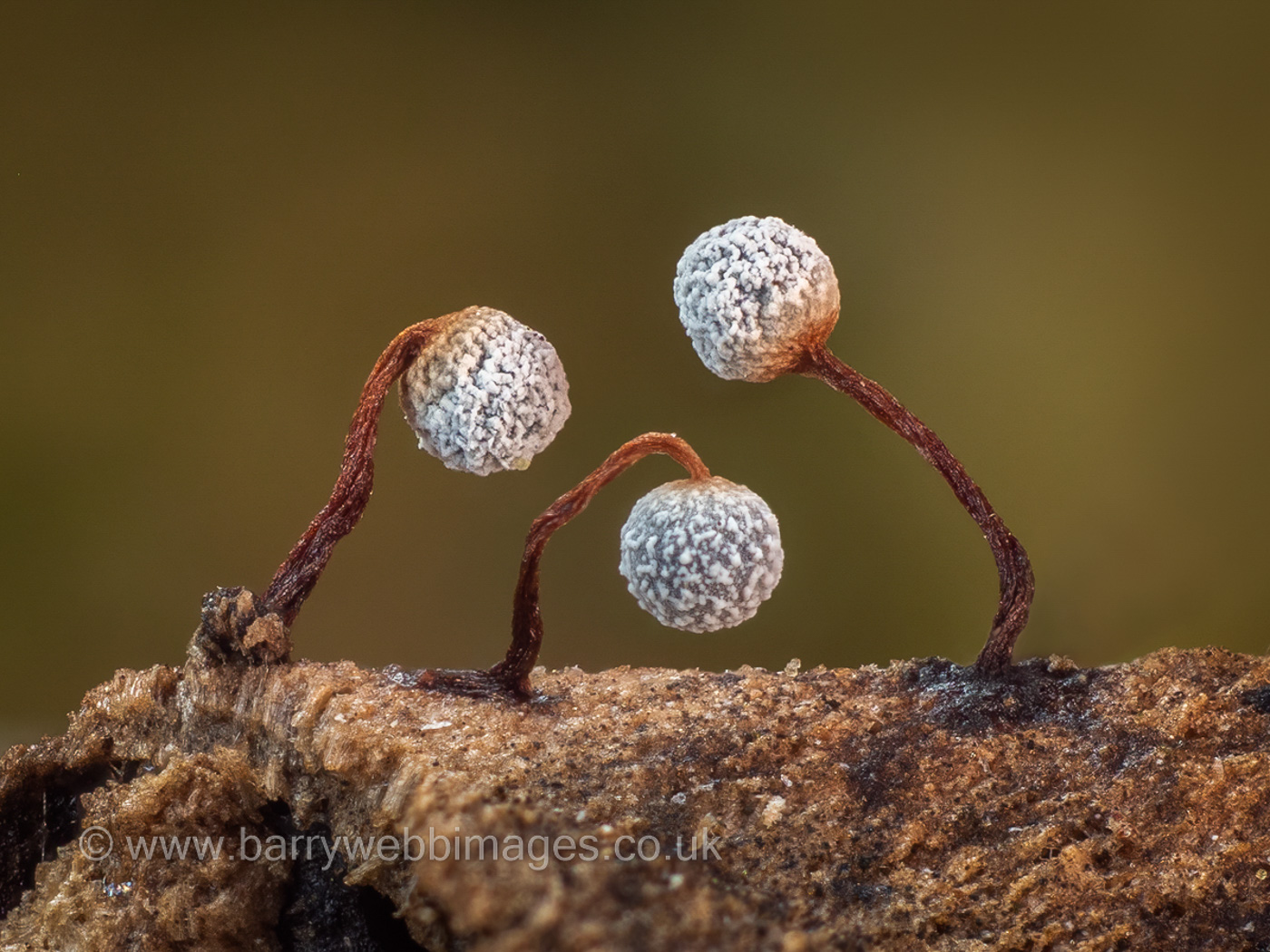
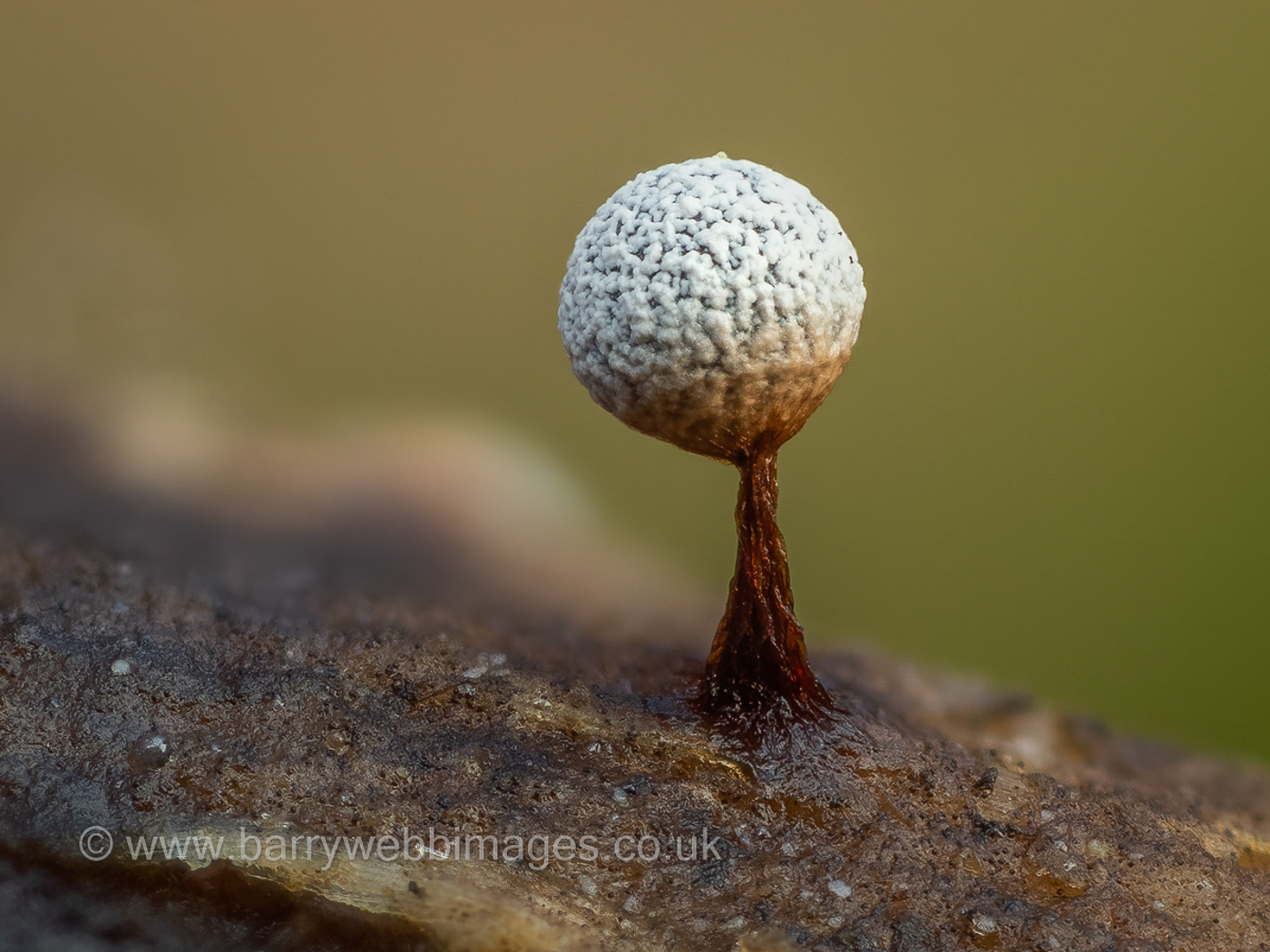 |
Physarum pusillum (a slime mould with no common name)
Mar 29, 2021. Barry Webb found this inconspicuous species in Burnham Beeches on a woodchip pile. (The determination was confirmed online by Myxo expert Edvin Johannesen.)
This particular species is distinguished by its relatively tall and slender reddish brown stalk, the whole sporangia being only up to 2mm tall. Though described as quite common, this is yet another first record for the county.
|
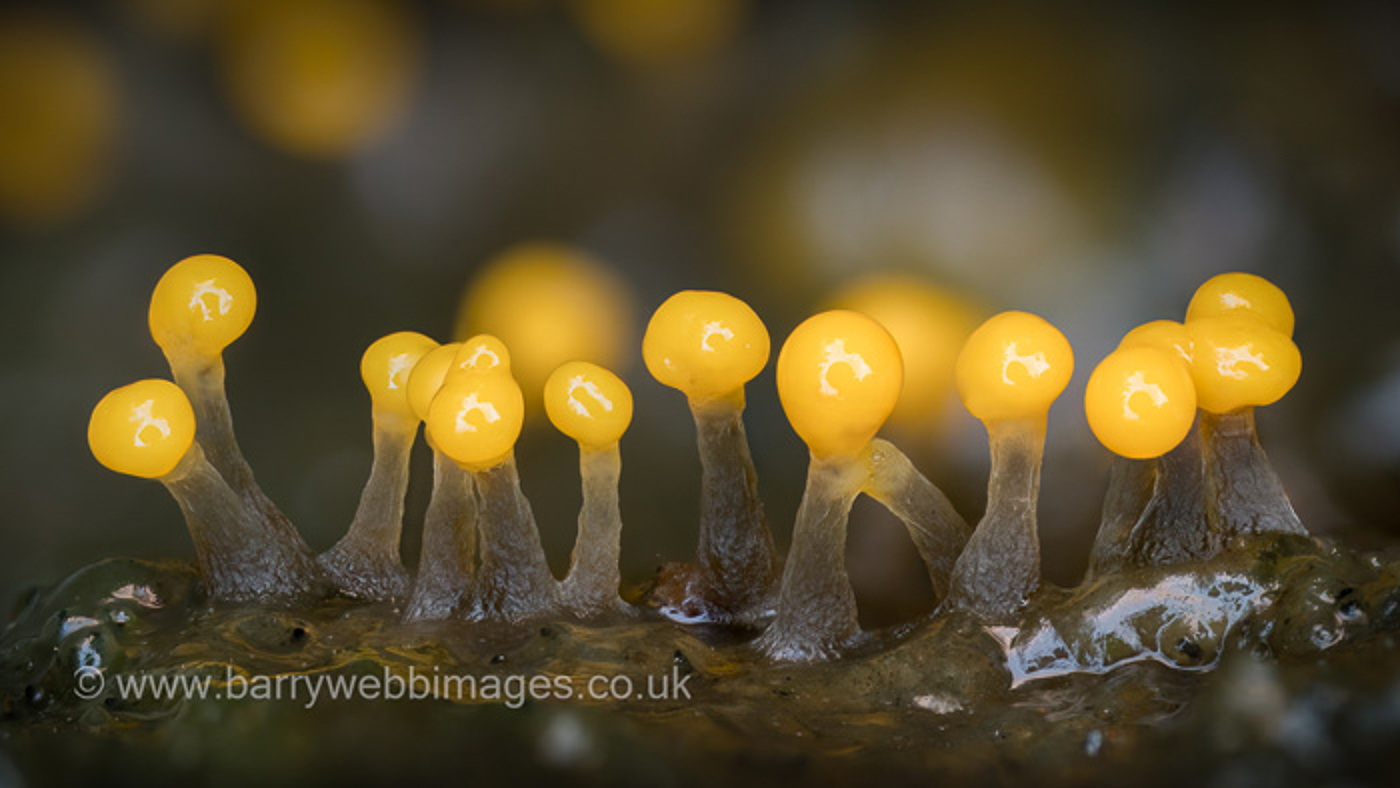
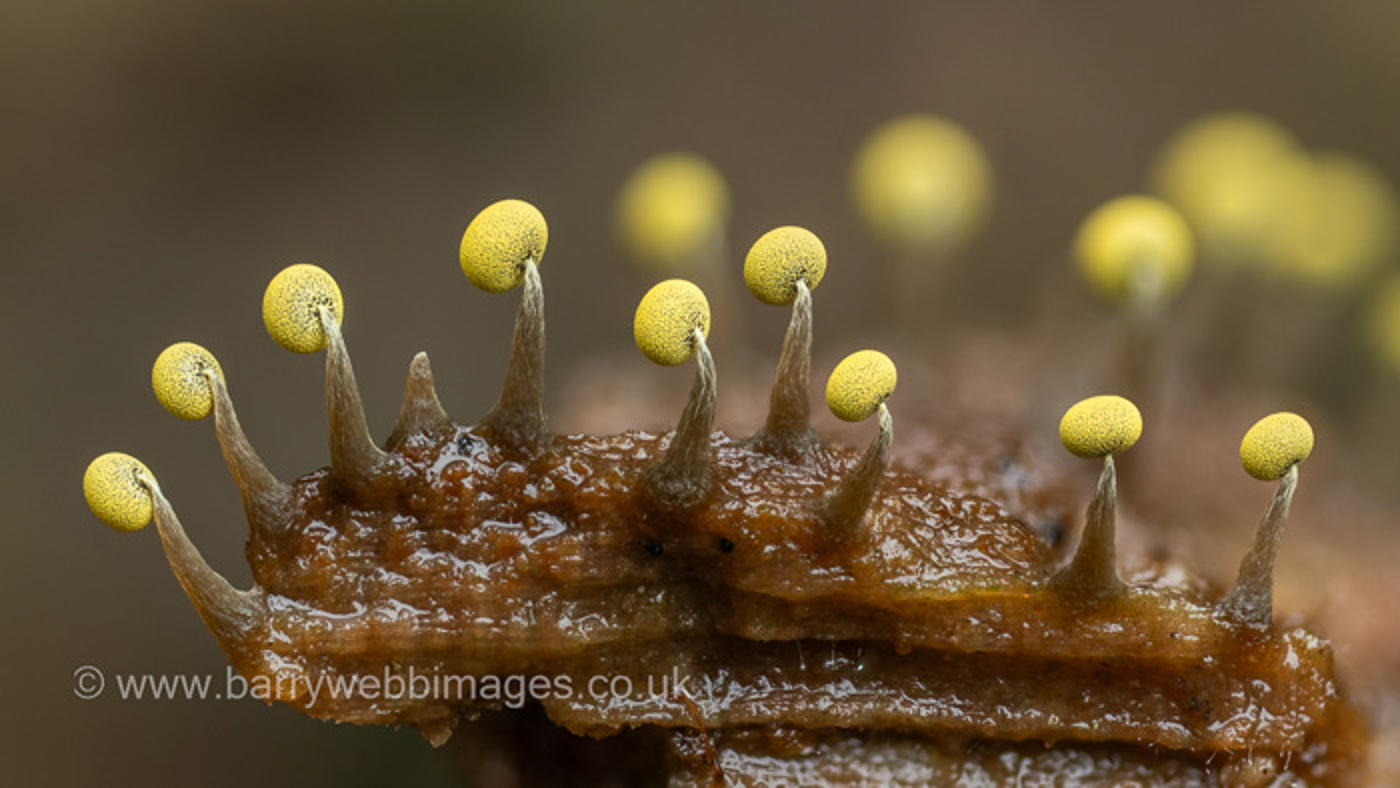
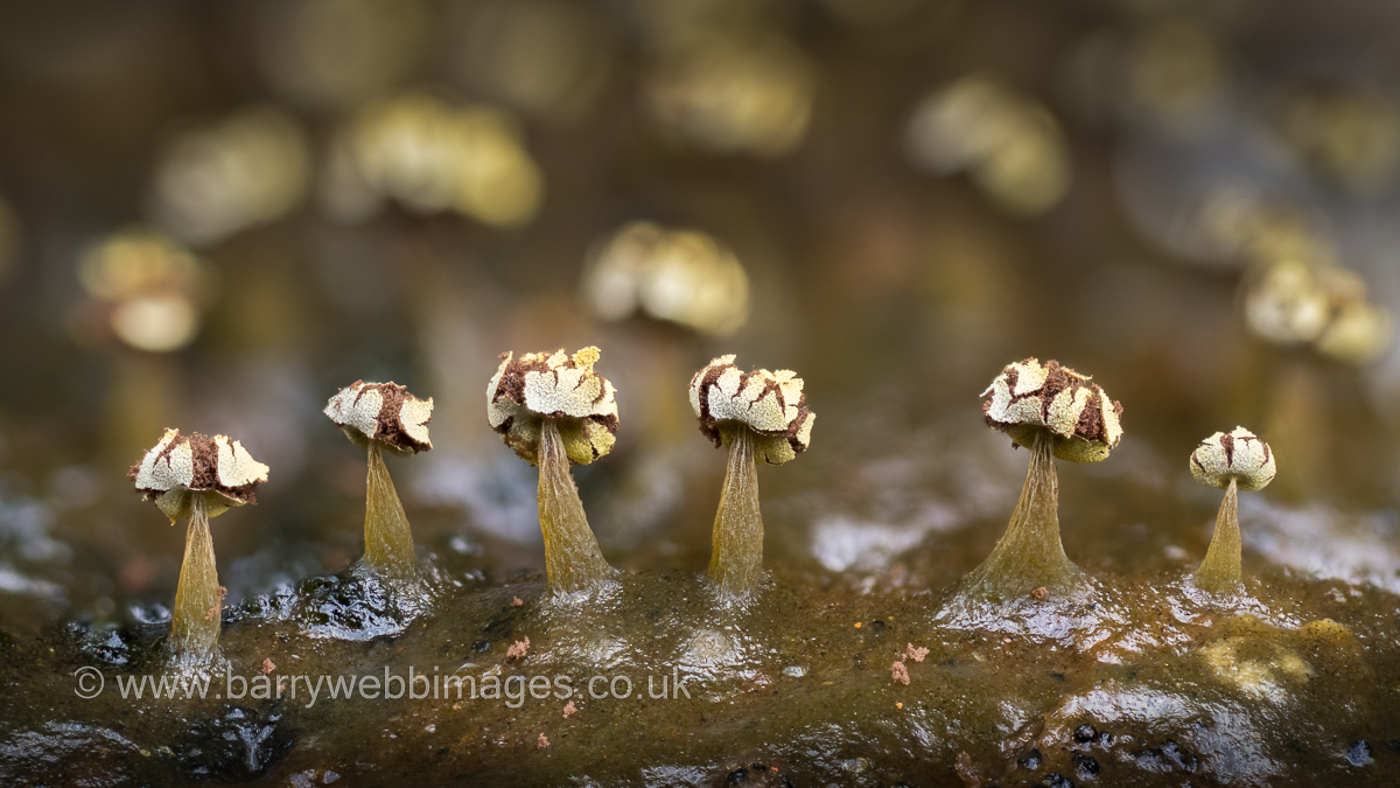
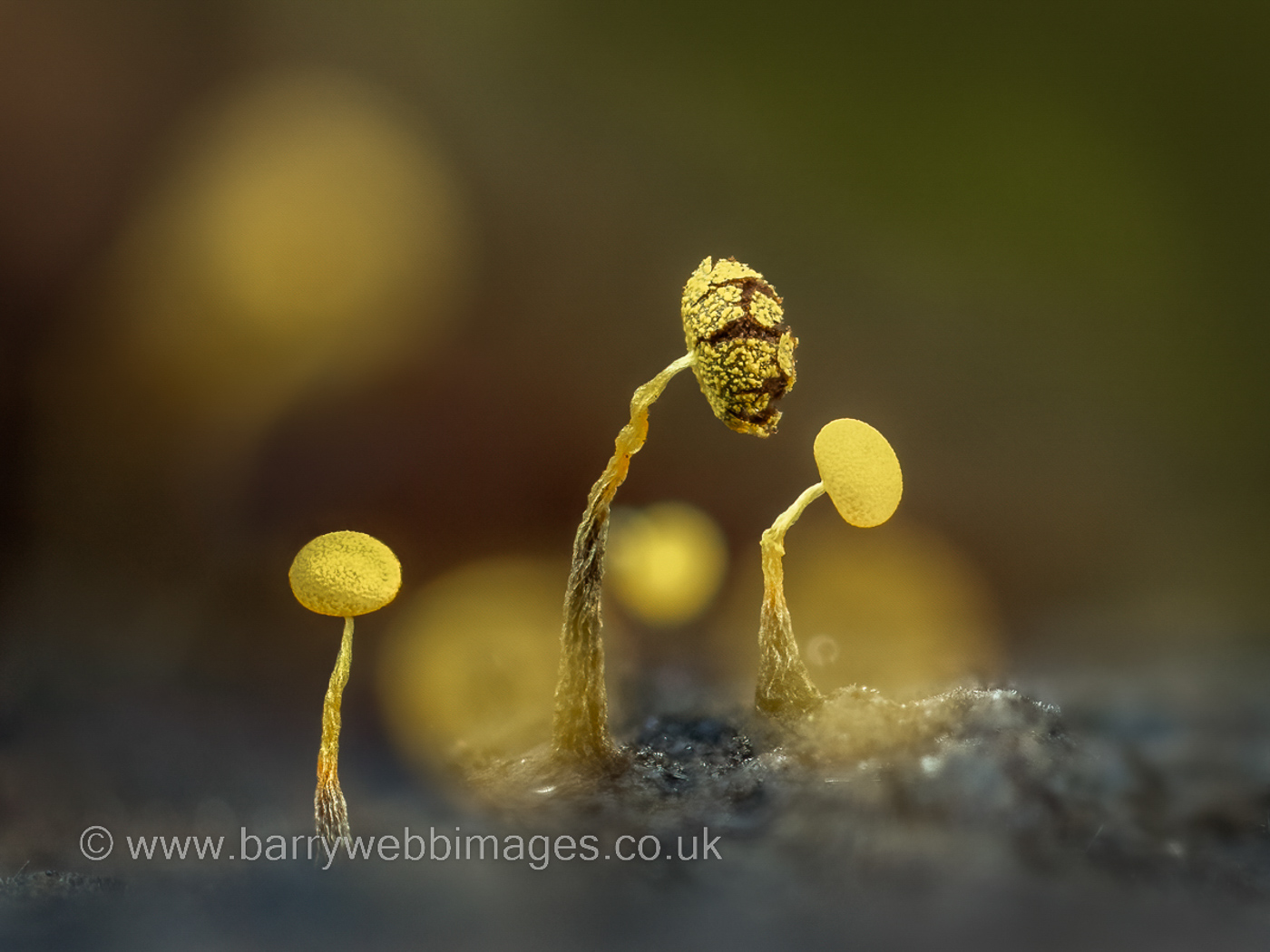 |
Physarum viride (a Slime Mould with no common name)
Jul 27, 2023. On a piece of Apple wood collected from Hedgerley Common and nurtured in his green house, Barry Webb found this unusual Slime Mould and took the photos illustrating its development as it matured. (No available literature does this!) This was new to the county when Barry found it at Burnham Beeches last year (see in Finds 2022 November 14th), so today's find is the second county record.
Nov 14, 2022. At Burnham Beeches Barry Webb found this stunning little species on a rotten Oak log - one he'd not seen before but easily recognised by its distinctive greenish yellow colour. As the only county record for the species (apparently from Burnham Beeches) was in 1923, ID anon, we'll count this as new to the county!
|
S
|
|
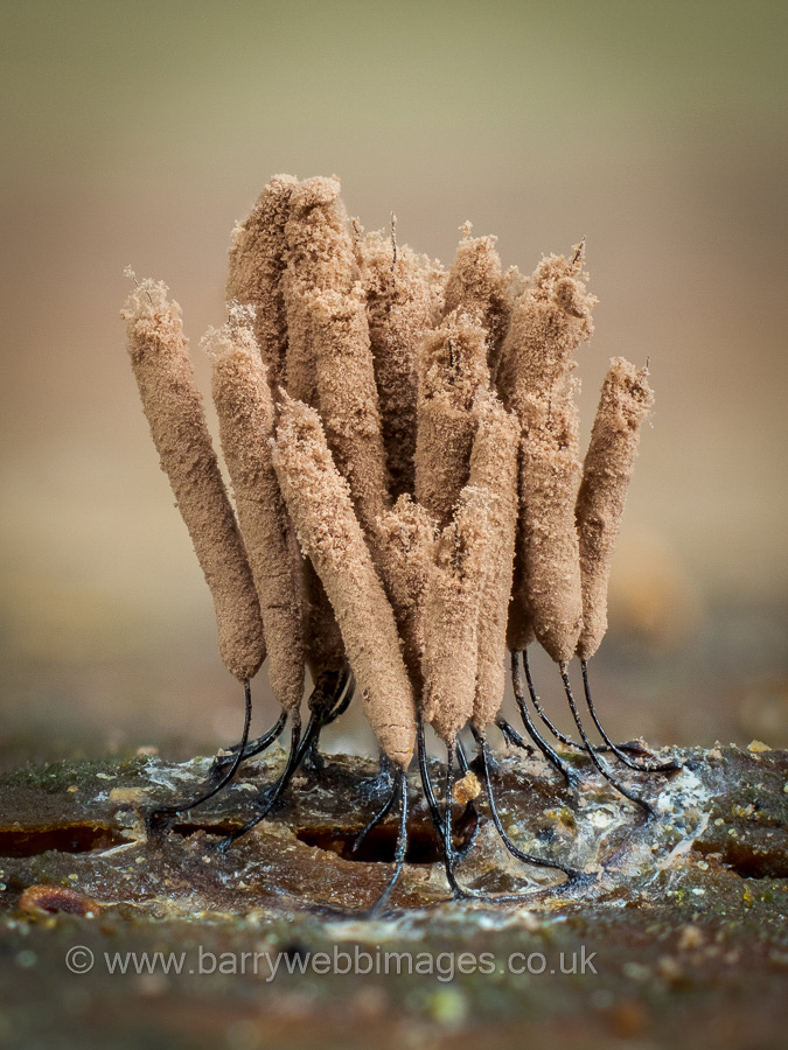 |
Stemonitis axifera (a species of 'Pipe-cleaner' Slime Mould with no common name) (Common) 
Jul 28, 2021. In Burnham Beeches on damp rotting deciduous wood Barry found this small cluster of tiny 'pipe-cleaners', the sporangia being mature enough for Penny to be able to identify it at home. The tiny smooth spores were diagnostic and though the species is not considered rare, this was new to the site and we appear to have only one previous county record.
|
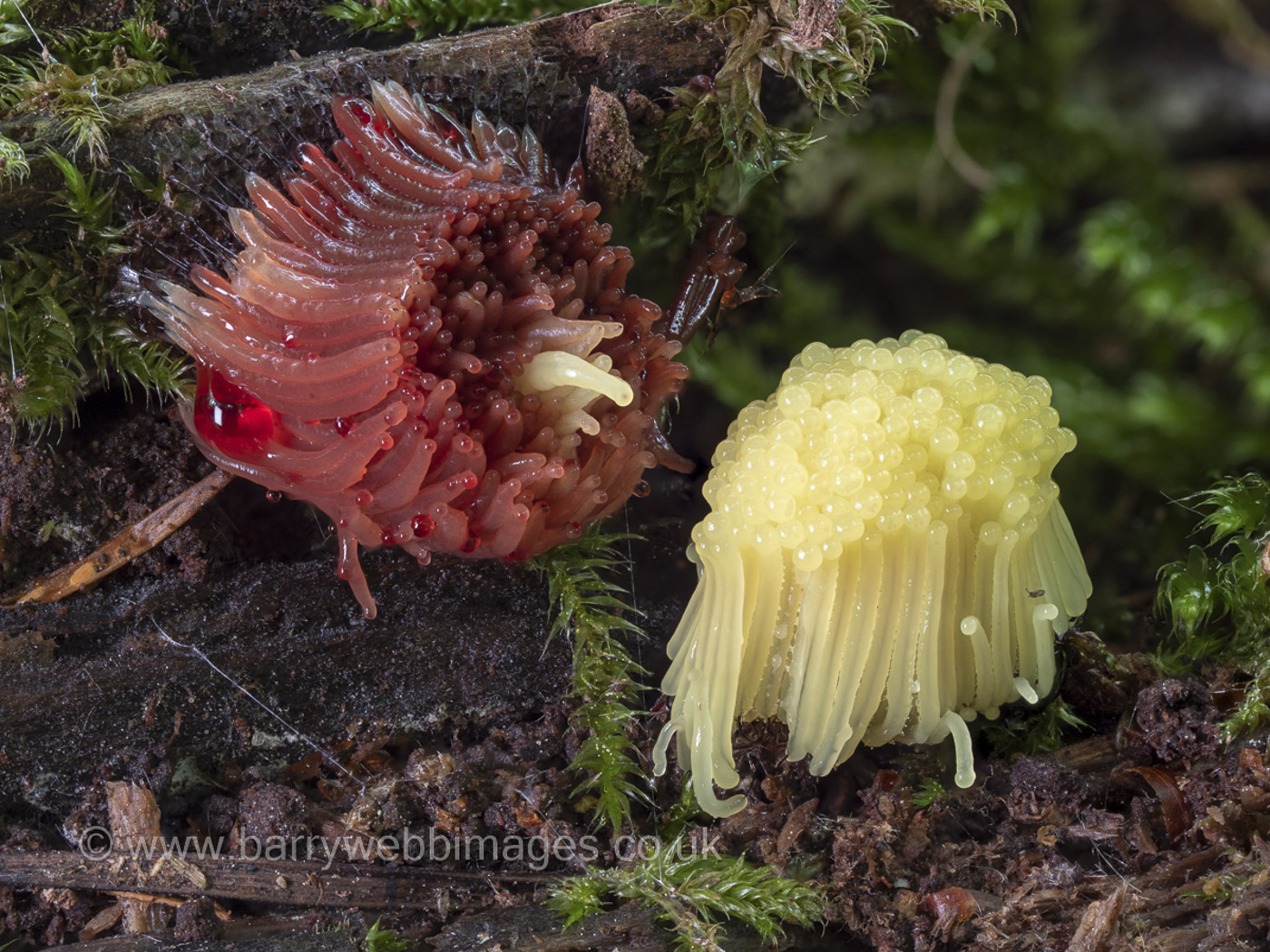
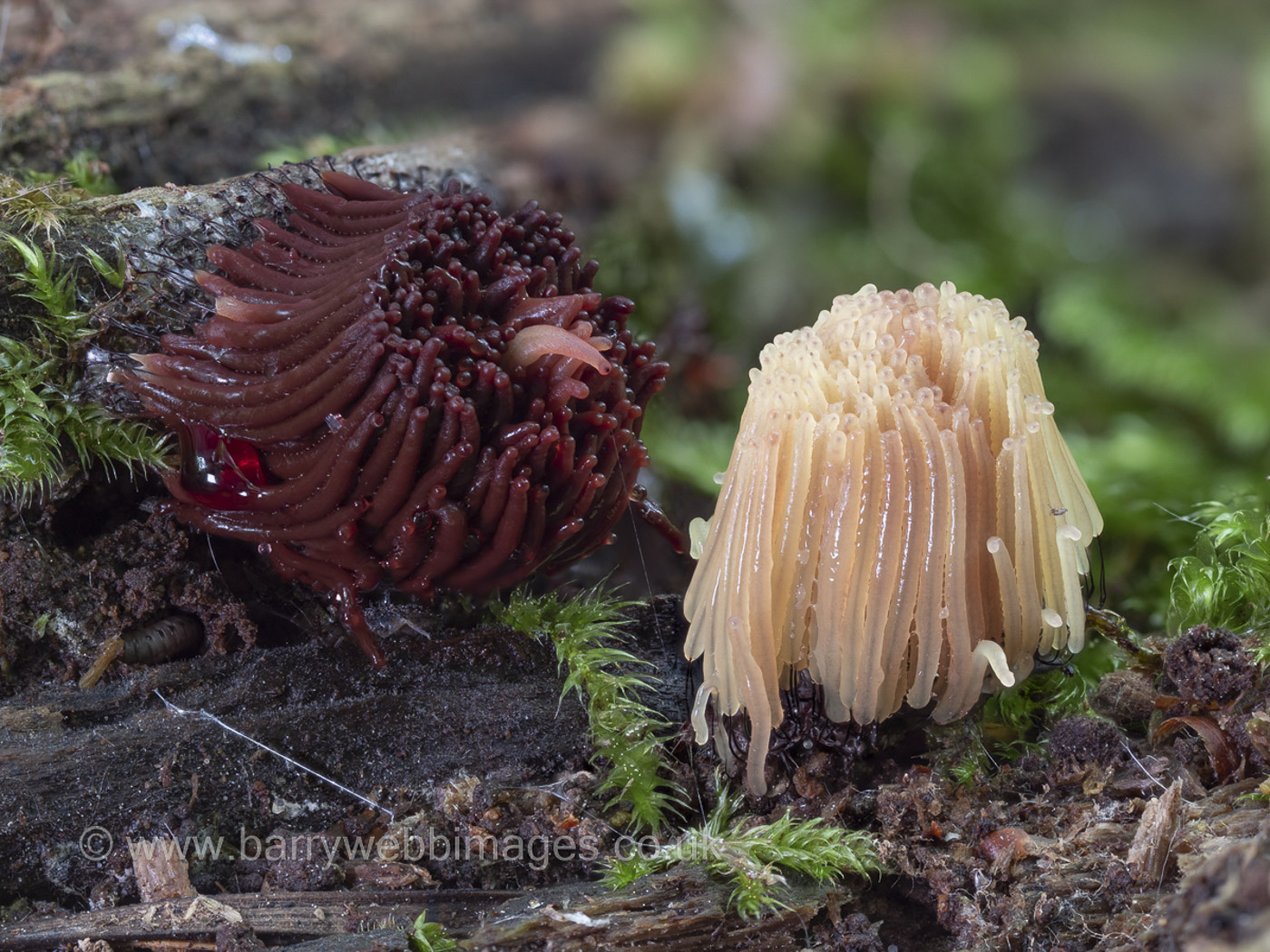
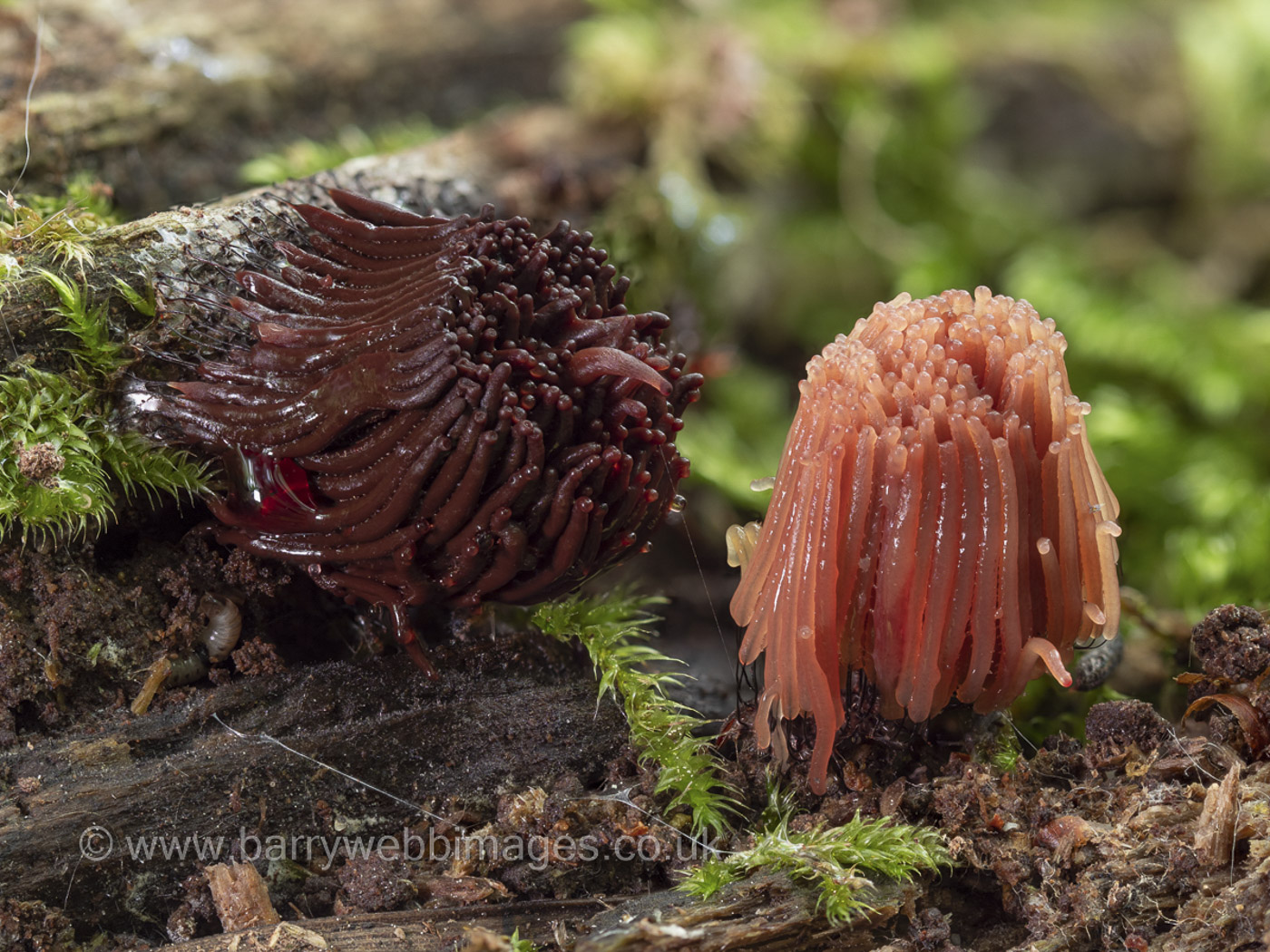
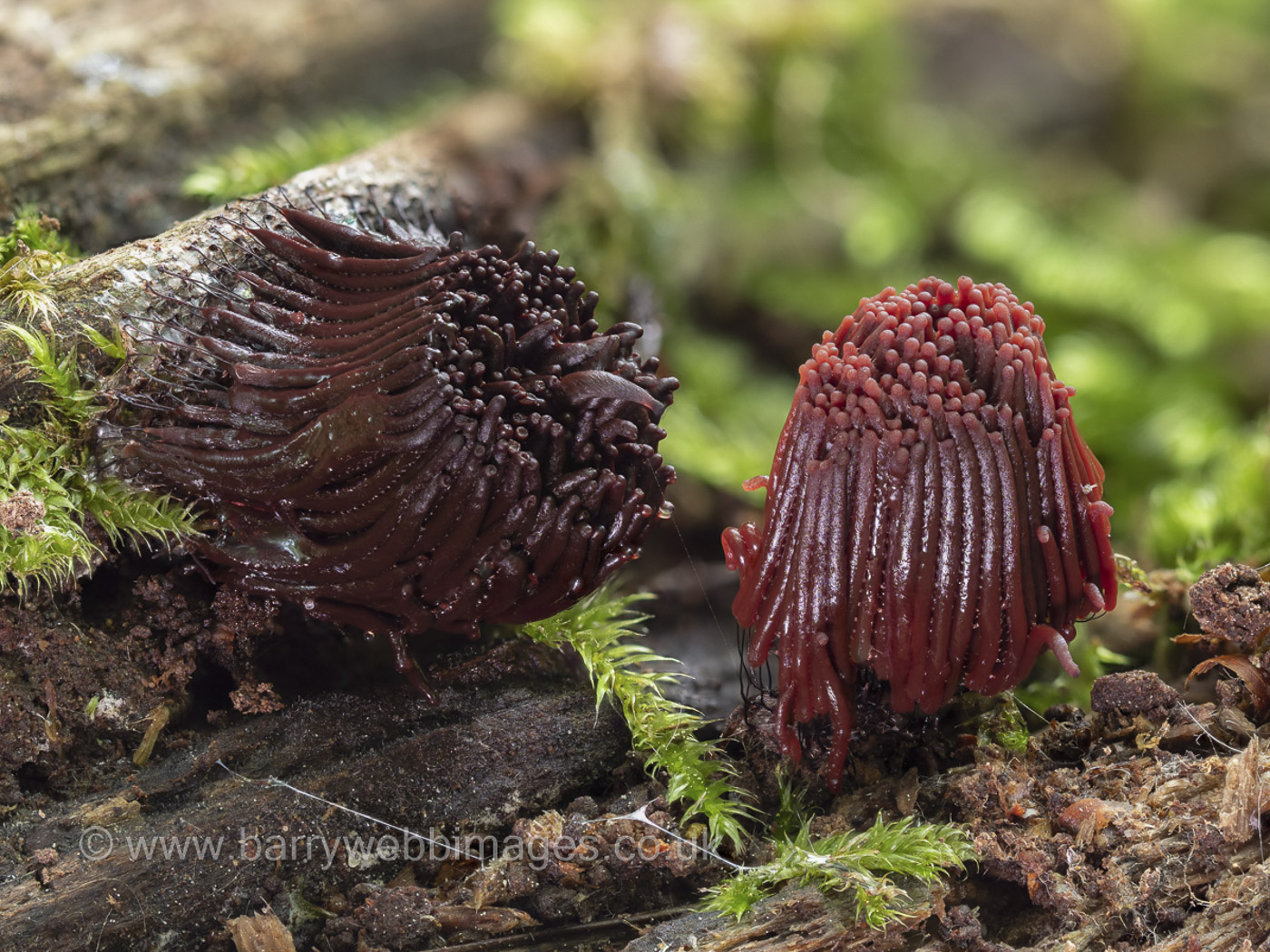
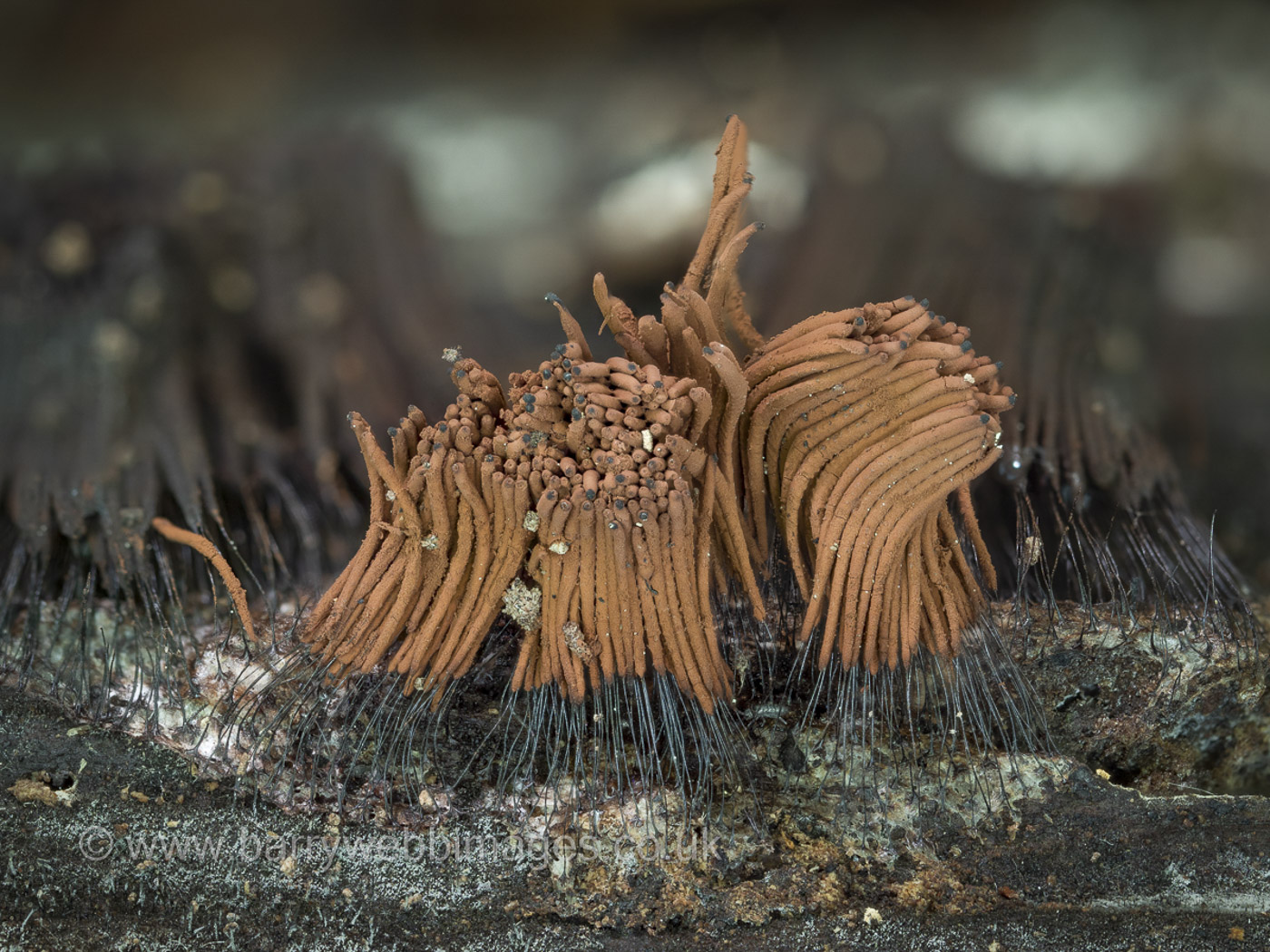 |
Stemonitis flavogenita (a species of 'Pipe-cleaner' Slime Mould with no common name) 
Sep 6, 2021. Barry Webb found a rotting fallen Birch trunk in Burnham Beeches with this Stemonitis species (at this stage unidentified) just starting to develop from the plasmodium (slimy) stage when the transformation in colour, shape and texture can be quite dramatic. He took this amazing set of photos over the space of several hours apart from the final one - taken when a group of us visited the site 4 days later when Penny took a now fully mature specimen to identify to species with a scope (only possible at this stage). S. flavogenita is alone in the genus in having bright yellow plasmodium rather than the normal white (as its Latin species name implies), but if not seen at this initial stage (just a slimy fragile shapeless mound) this useful clue is missed as all species tend to go through the same colour changes once the stalks and pipe-cleaner shape have formed: first yellowish then gradually pinkish and eventually some shade of cocoa brown - all in a matter of a few hours once it starts - before drying off completely as in the final photo here. The species is not rare but also not the commonest of the genus which is S. fusca - seen below.
|
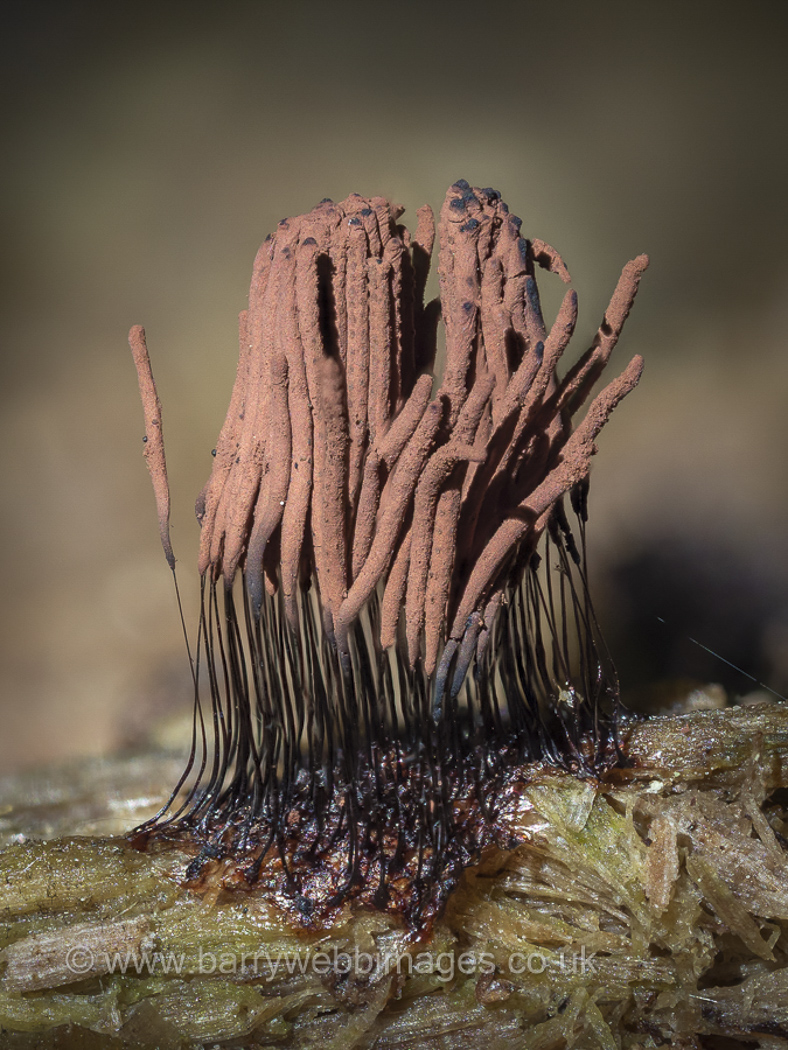 |
Stemonitis fusca (a species of 'Pipe-cleaner' Slime Mould with no common name) 
Jun 9, 2021. On a rotting bare Birch trunk in Burnham Beeches Gill Ferguson found these little clusters of chocolate pipe-cleaners. Although nearby was a trunk with Stemonitis flavogenita (seen above), it could not be assumed that this collection was the same species, so Penny collected samples of both to examine at home. This second collection turned out to be this the commonest species within the genus, characterised not just by microscopic differences but also by having a notably shiny black stalk forming up to half the total height (in S. flavogenita the stalk is less shiny and shorter). (photo by Barry Webb).
|
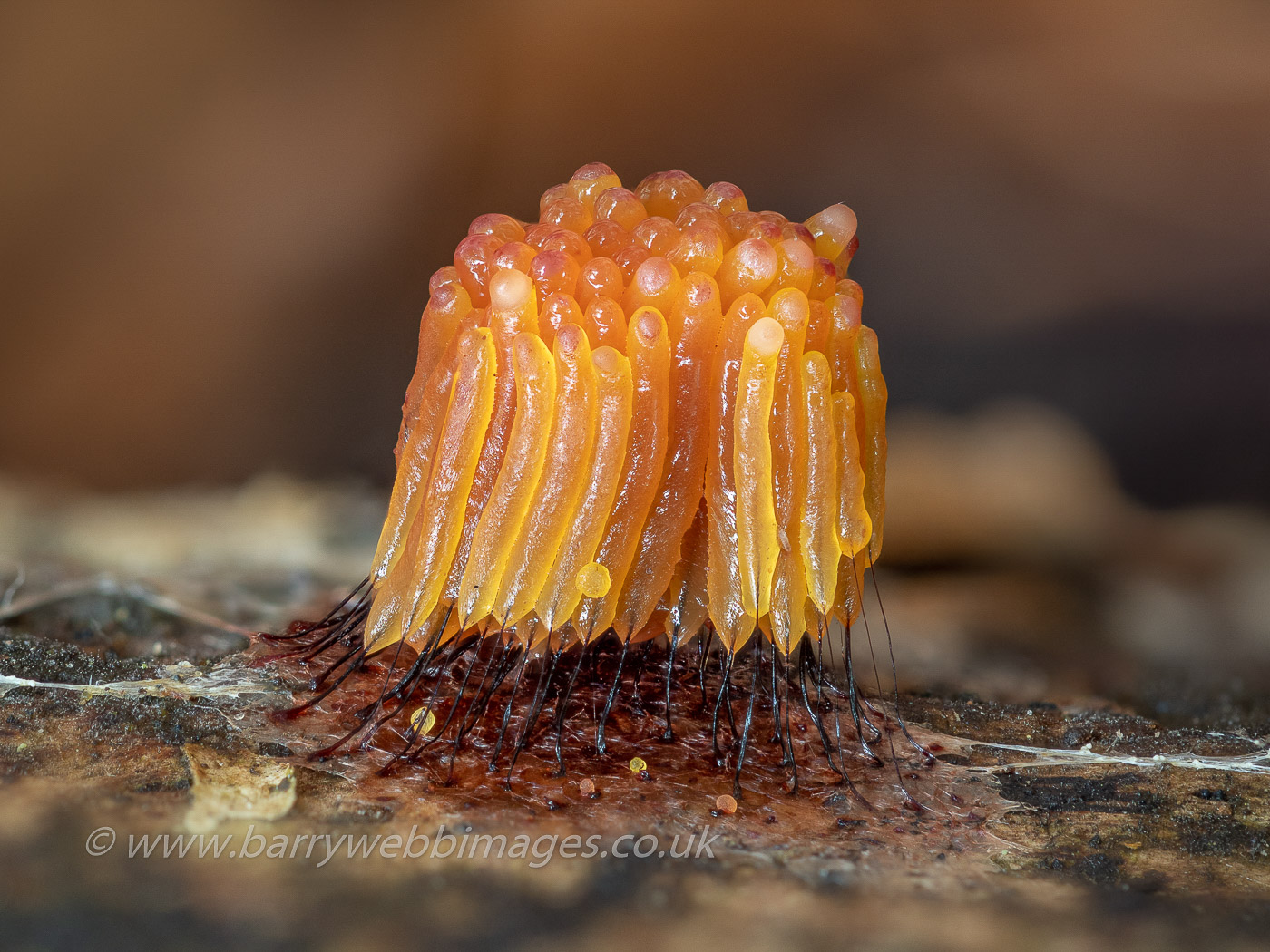 |
Stemonitis sp (an unidentified species of the Slime Mould genus Stemonitis)
Growing on fallen Beech in Burnham Beeches (28.09.2020) Barry found this typical example of a very distinctive genus of Slime Moulds. At this early stage before it has dried off and developed the brown spore mass above the stalk it is not possible to name to species but the genus is easily recognised once it forms this tight 'forest' of pipe-cleaner-like tufts.
|
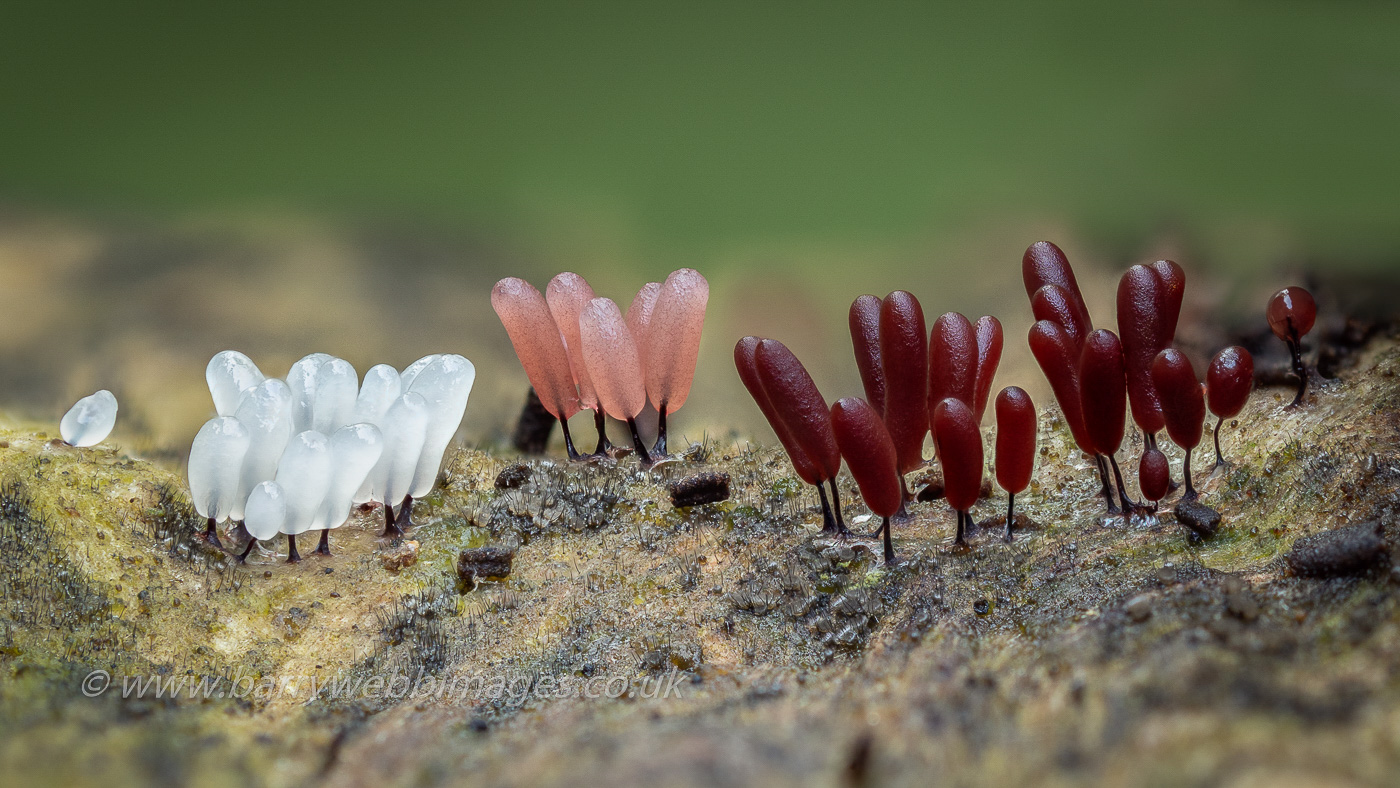 |
Stemonitopsis sp (hyperopta / amoena or maybe even Comatricha pulchella!)
Sep 15, 2020. Barry found this little collection on Apple at Hedgerley Green but all were too young to be identified. The white specimens on the left are just developing from the (presumably white) plasmodium stage. As they mature they gradually darken, becoming at first pink then later reddish brown before drying off as the spores ripen. Only at this later stage can they be examined to identify.
|
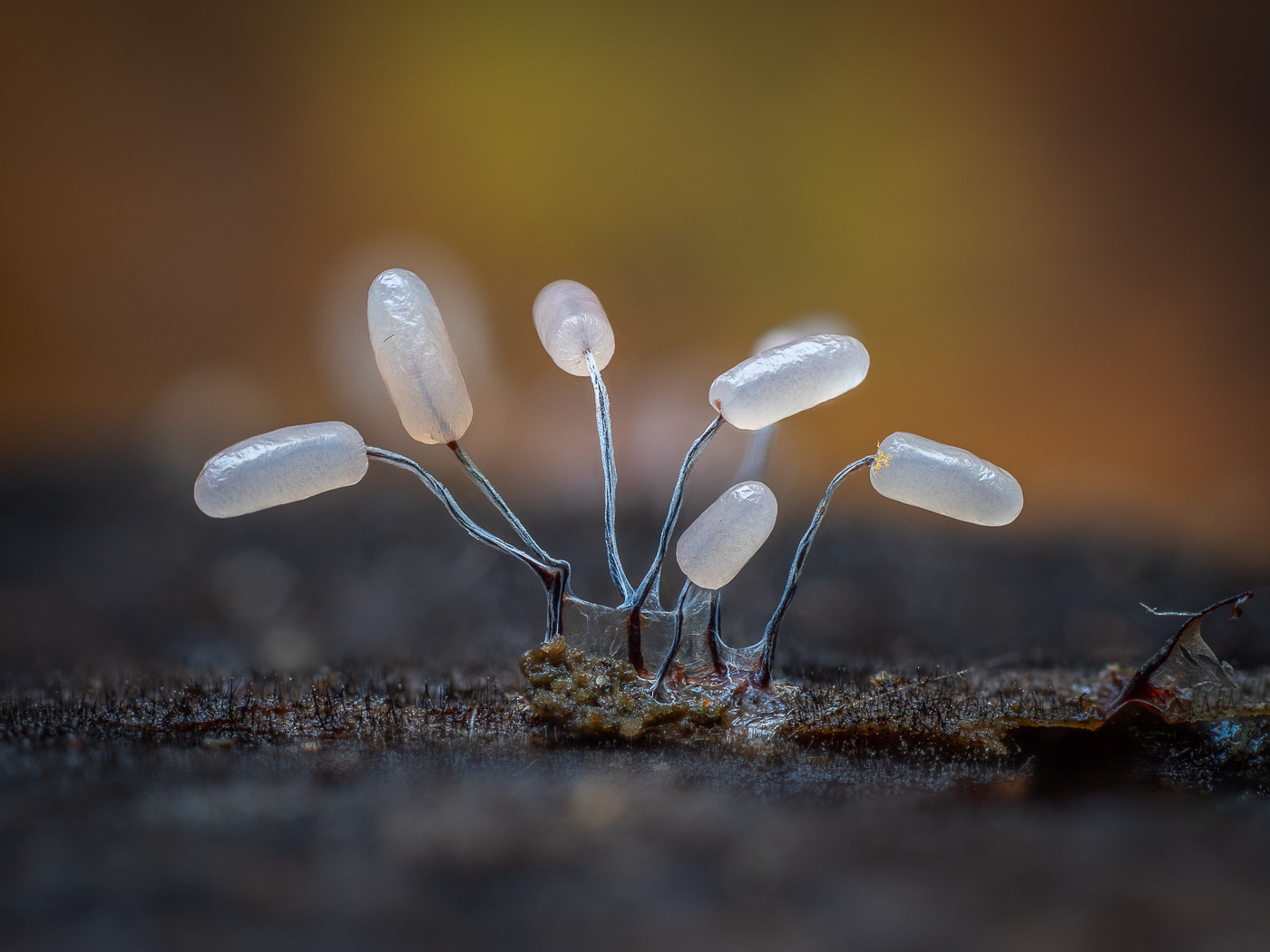 |
Stemonitopsis typhina (a Slime Mould with no common name)
Oct 19, 2020. Barry Webb took this beautiful photo of a very common slime mould found on a damp Beech branch in Burnham Beeches. Each sporocarp (fruiting body) is no more than 5 mm high and its shape resembles the similar genus Stemonitis but the species is characterised by these persistently silvery shining cylindrical heads and beneath them a stalk reminiscent of old fashioned silk stockings, the central black core looking like the seam!
|
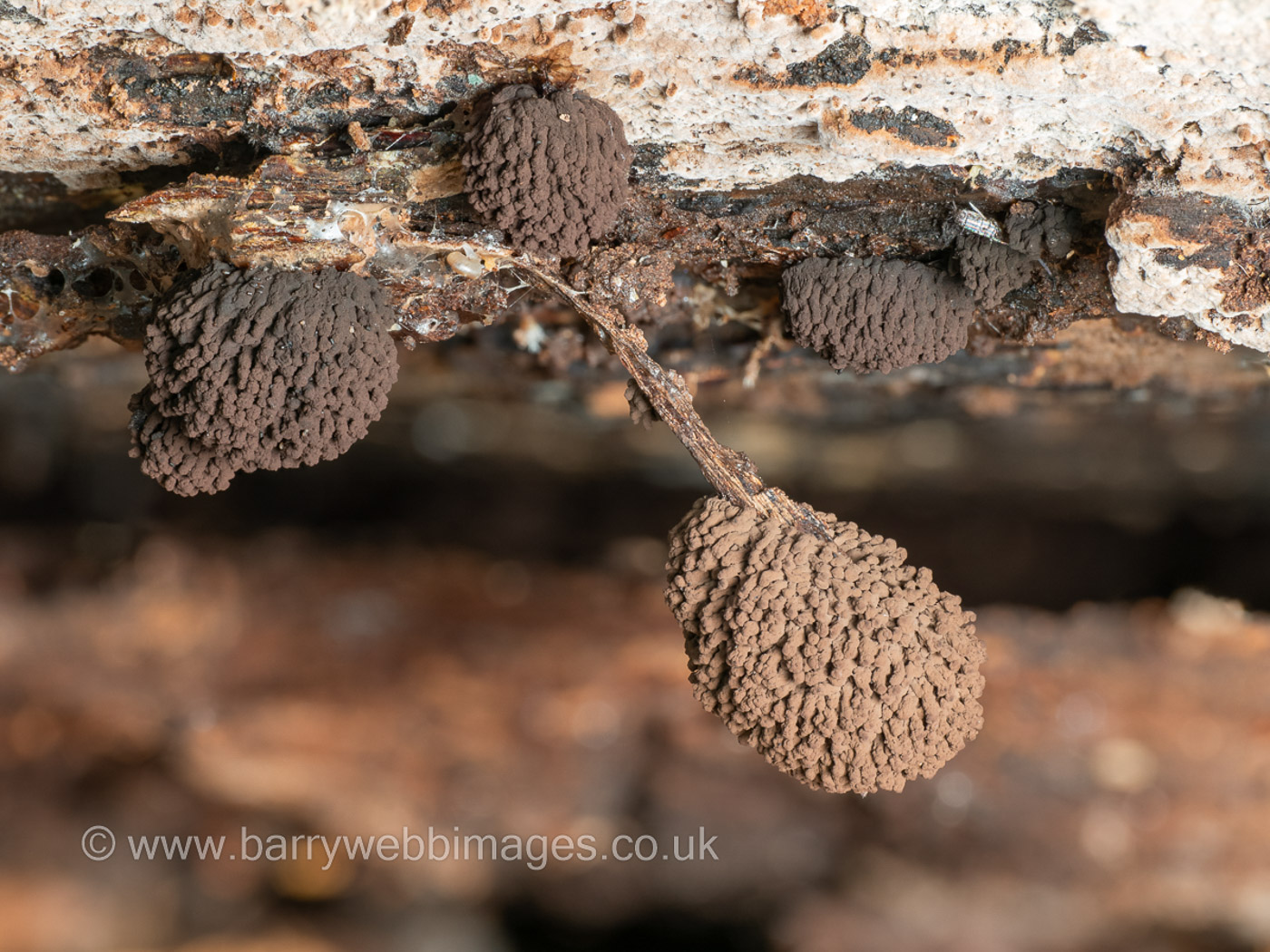 |
Symphytocarpus amaurochaetoides (a rare Slime Mould with no common name) 
Sep 13, 2023. On fallen rotting Beech at Burnham Beeches Barry Webb found this rare species, one that Penny has never heard of. As can be seen from its shape and habit, the genus is related to Stemonitis and at one stage was thought to be part of that genus but just malformed until it was realised that its few members were consistently different and species in their own right. The apparent long stalk on the lowest cluster here is in fact a sliver of wood flaking off the log - the tight clusters are stalkless and no more than 5mm tall. This was an nice find and is new to the county with few national records.
|
T
|
|
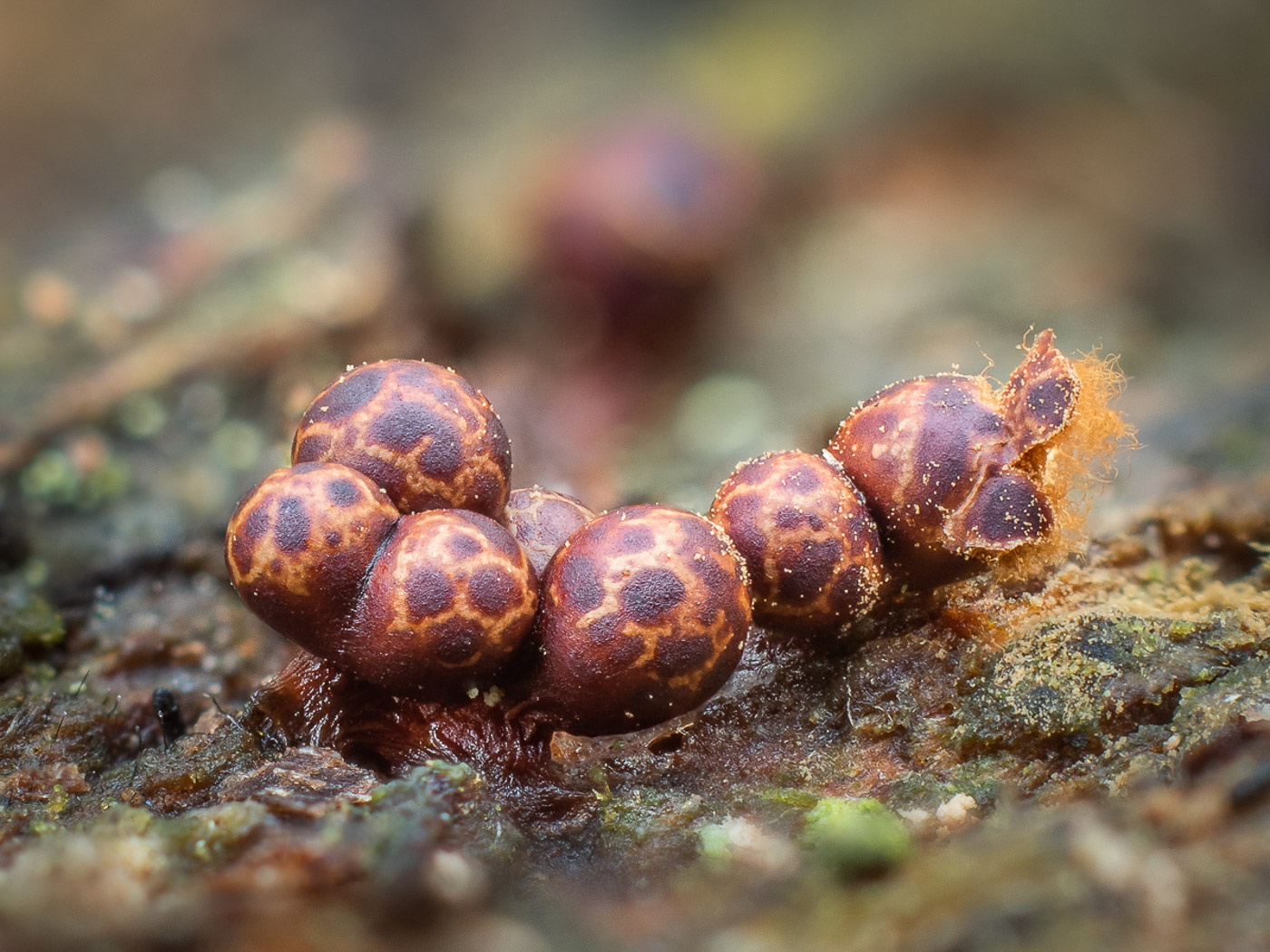 |
Trichia botrytis (a slime mould with no common name)
Nov 21, 2020. In Penn Wood Barry Webb found this cluster of tiny specimens fruiting on fallen Oak. There are many species of Trichia and a scope is nearly always needed to name them but the very distinctive mottled markings seen here are enough to separate it from others in the field.
|

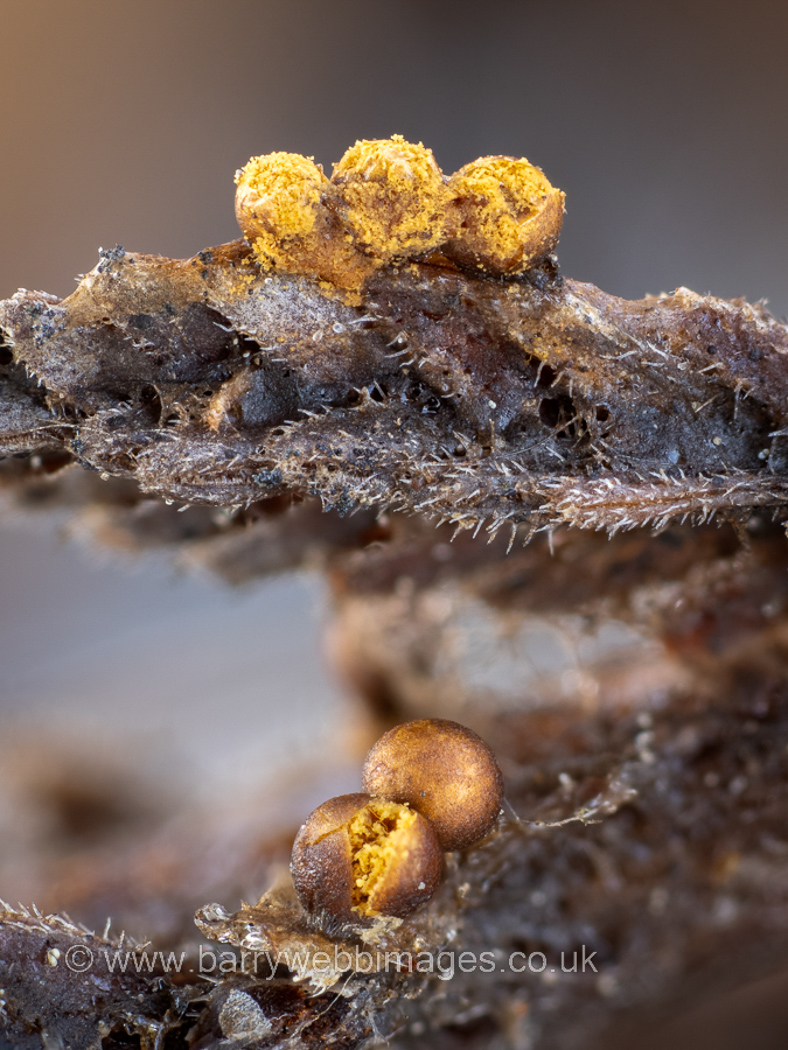 |
Trichia contorta var. attenuata (a rare Slime Mould with no common name) 
Dec 14, 2022. Barry Webb noticed this tiny species growing low down on live Heather stems at Stoke Common with snow still on the ground. He then sent both macro and micro photos to Myxomycete expert Edvin Johannesen who was able to identify it straight away from his images. We have two previous county records for T. contorta var. contorta but this is a first for this very rare variety for which there appear to be extremely few national records.
|
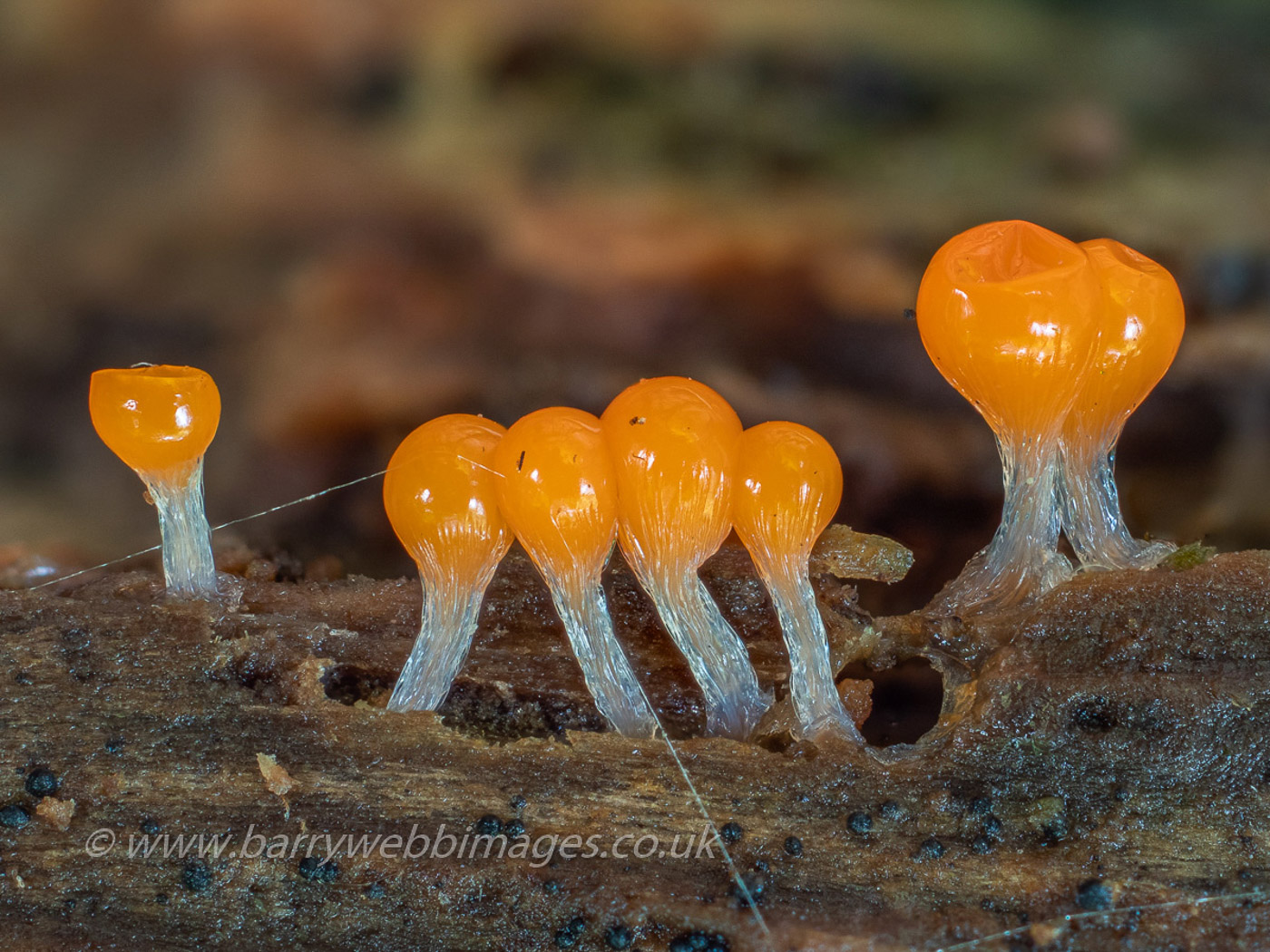
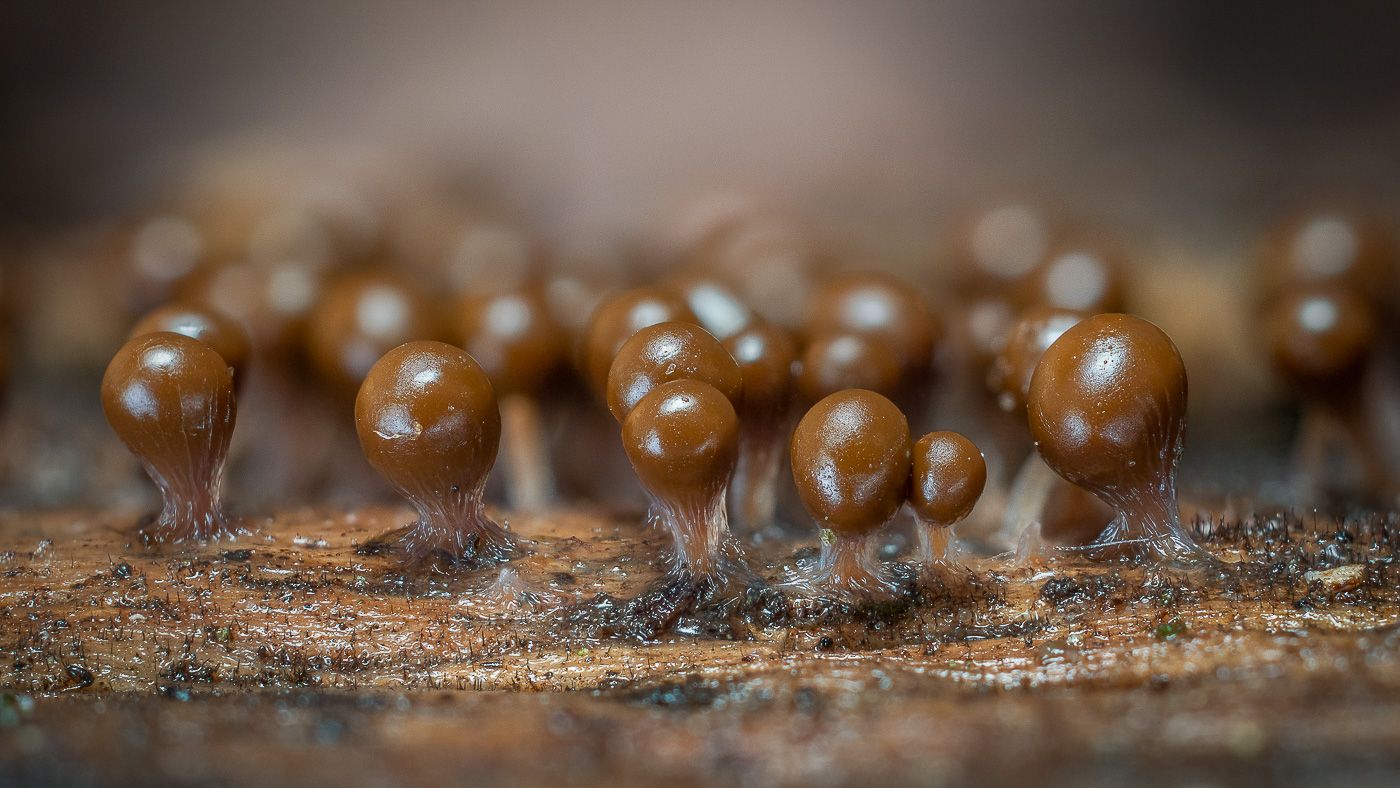 |
Trichia decipiens (a Slime Mould with no common name)
Nov 1, 2020. Barry Webb found these tiny orange blobs on stalks on rotting fallen Beech in Burnham Beeches. Most Slime Moulds have white plasmodium at this immature stage when identification even to genus is not possible, but a few species have brightly coloured plasmodium and can be named, this being one of them. There are many species of the genus Trichia but only this species has white stalks with orange to pink blobs on top when immature. Photo 2 shows a more mature example (this one from Penn Wood - 01.11.2020), when the blobs are drying off but are still not mature enough to have developed spores.
|
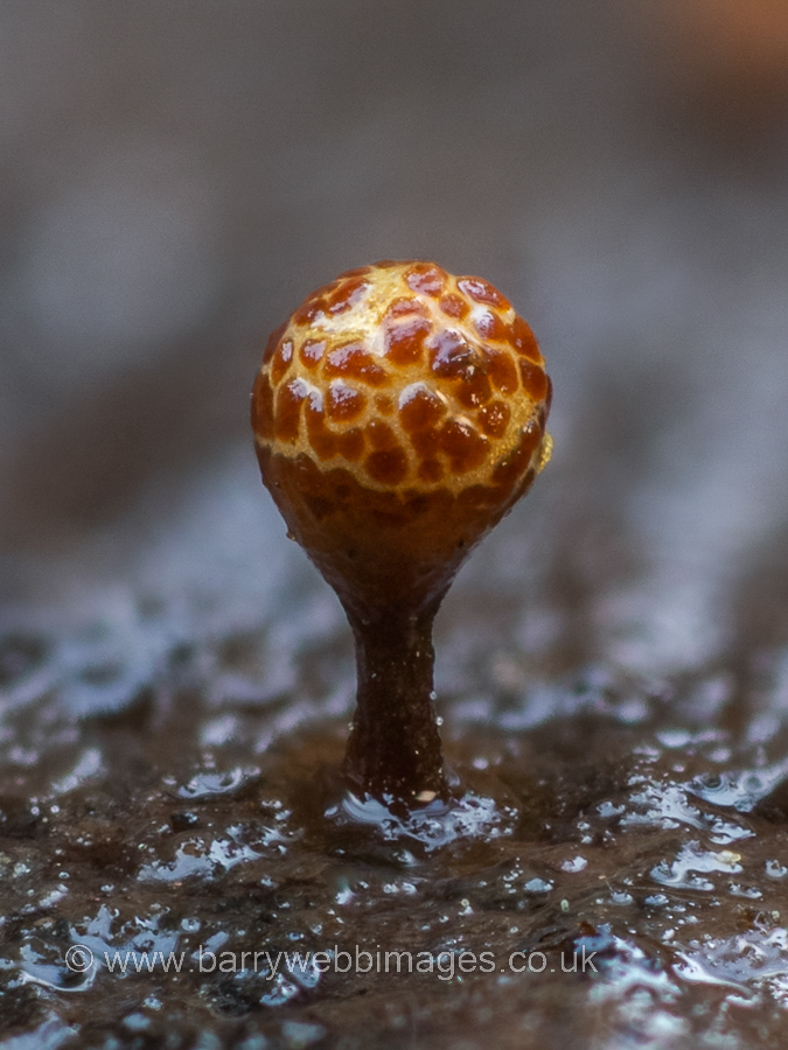 |
Trichia flavicoma (a rare slime mould with no common name) 
Dec 24, 2022. On a pile of old prunings (Osmanthus, Laurel, Yew) at Hedgerley Green Barry Webb spotted this really tiny species - less that 1mm tall. It is rarely recorded (no doubt due to its miniscule size) and is new to the county. Barry's identification was confirmed when he sent both macro- and microphotos to expert Edvin Johannesen.
|
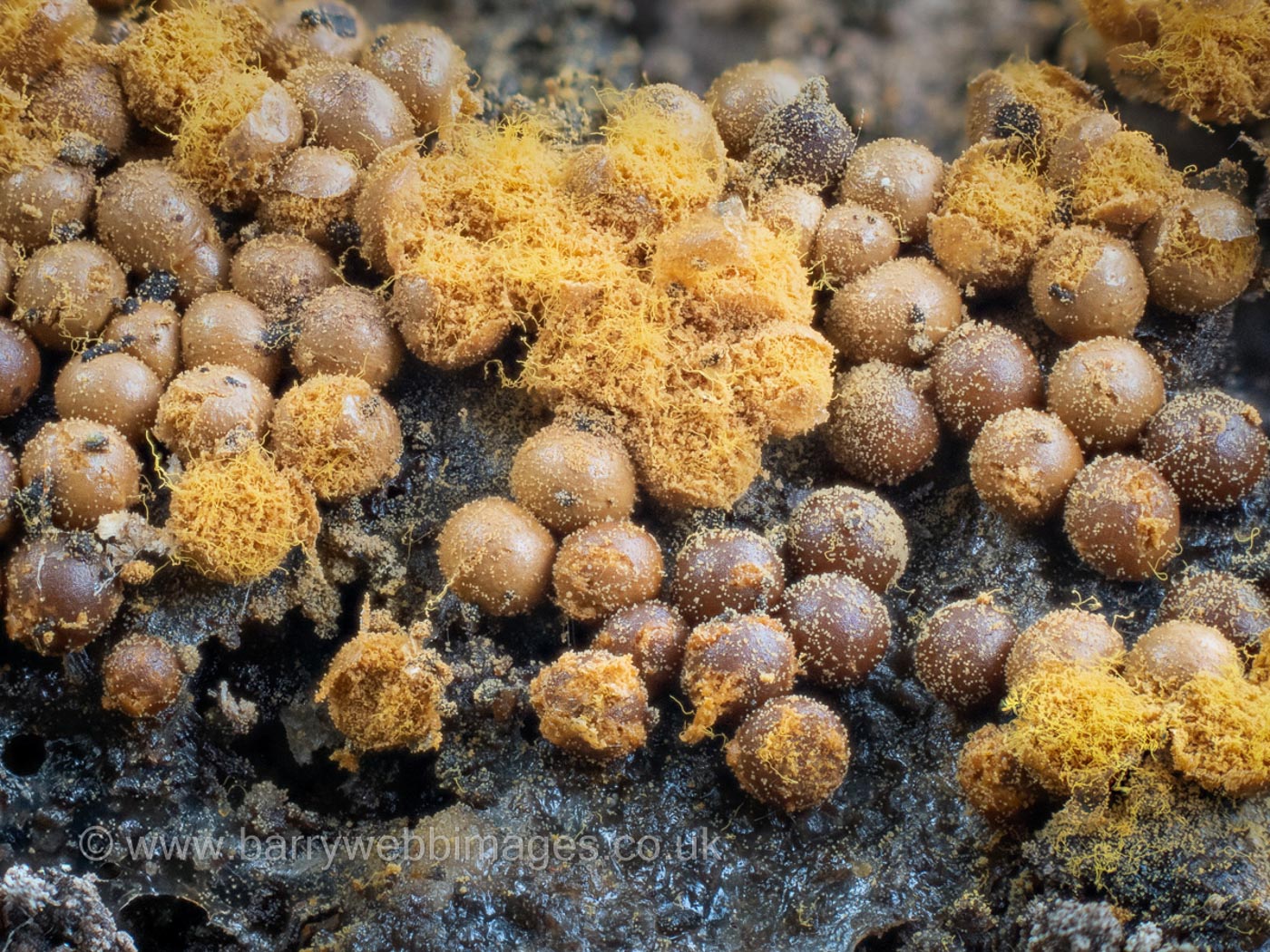 |
Trichia varia (a Slime Mould with no common name) 
Jul 28, 2021. In Burnham Beeches on damp rotting deciduous wood Barry found this colony of one of the commonest species of Trichia which was mature enough for Penny to be able to identify it at home. This is a genus with many somewhat similar species, most of which start out as a small patch of white blobby plasmodium which gradually turns yellow then dries off to form tight clusters of sporangia, some species having a short stalk (see images of T. decipiens above), some without as here.
|
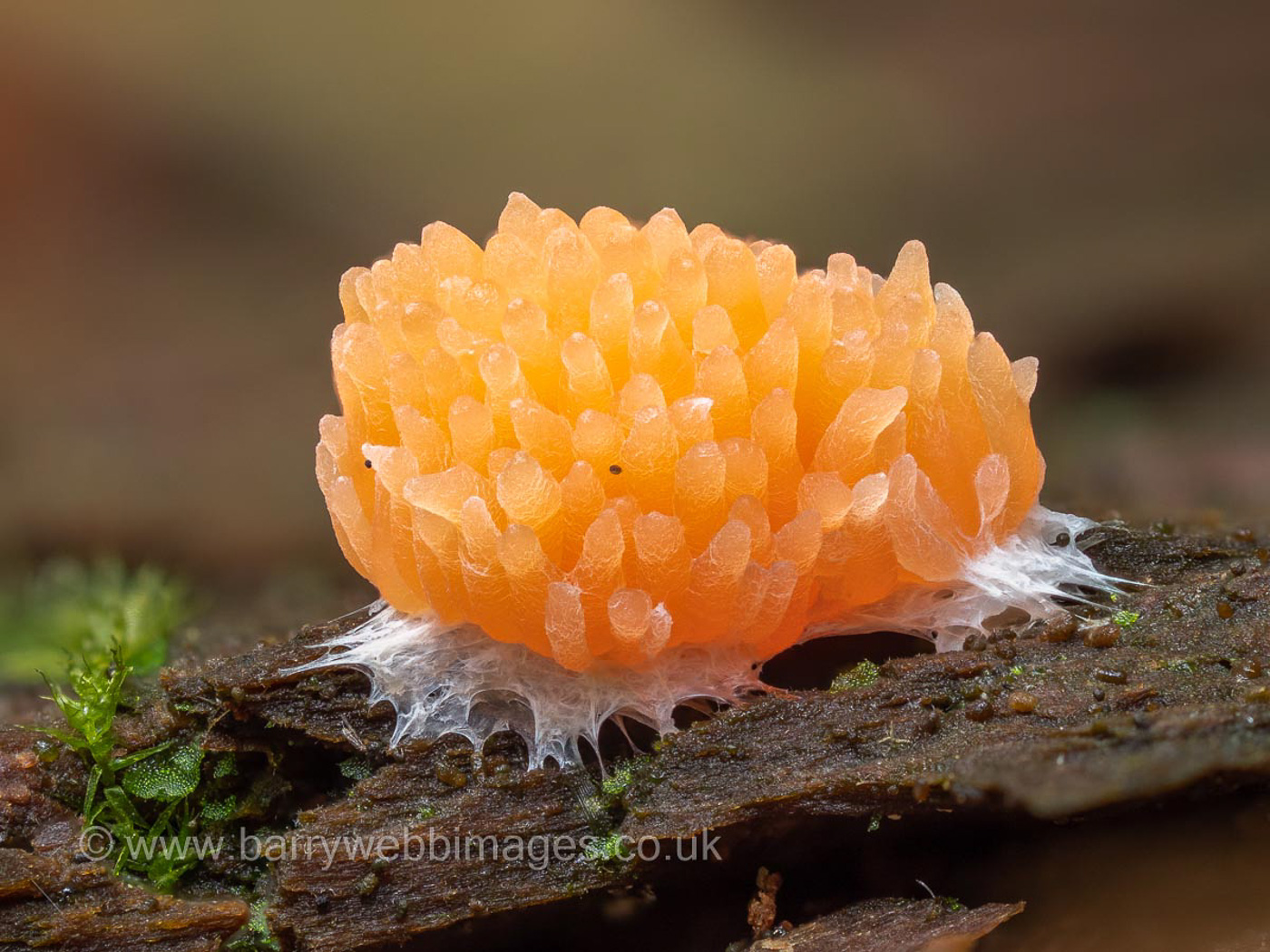
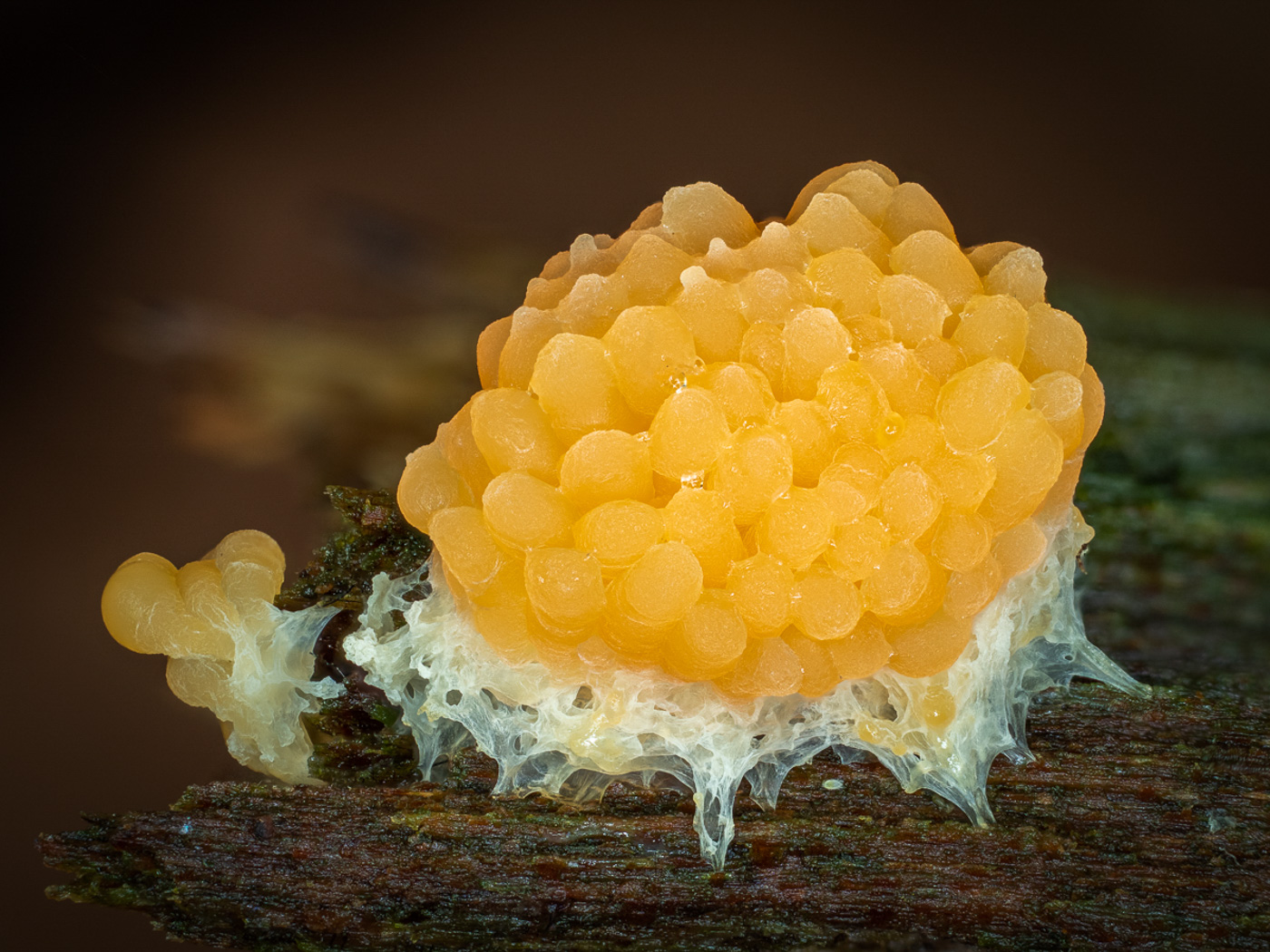
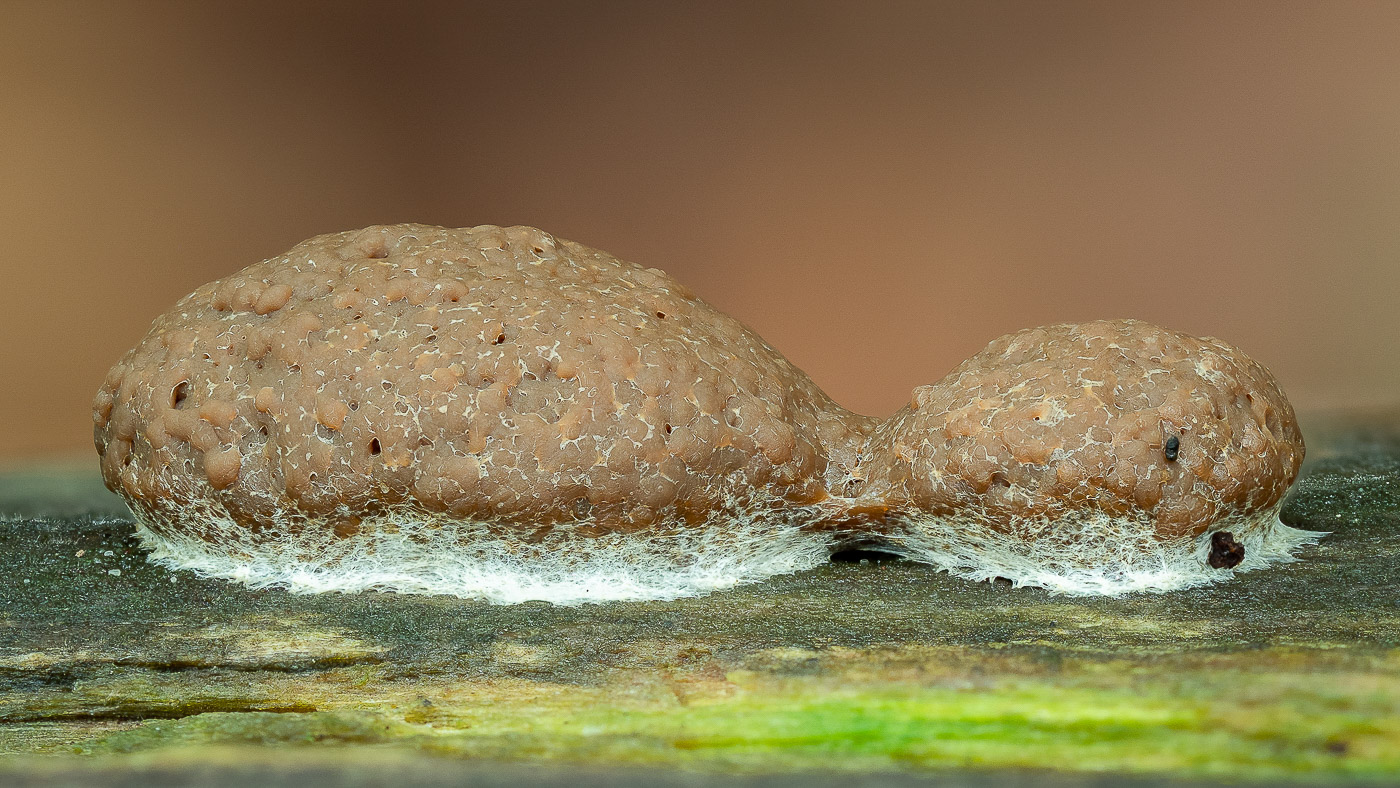
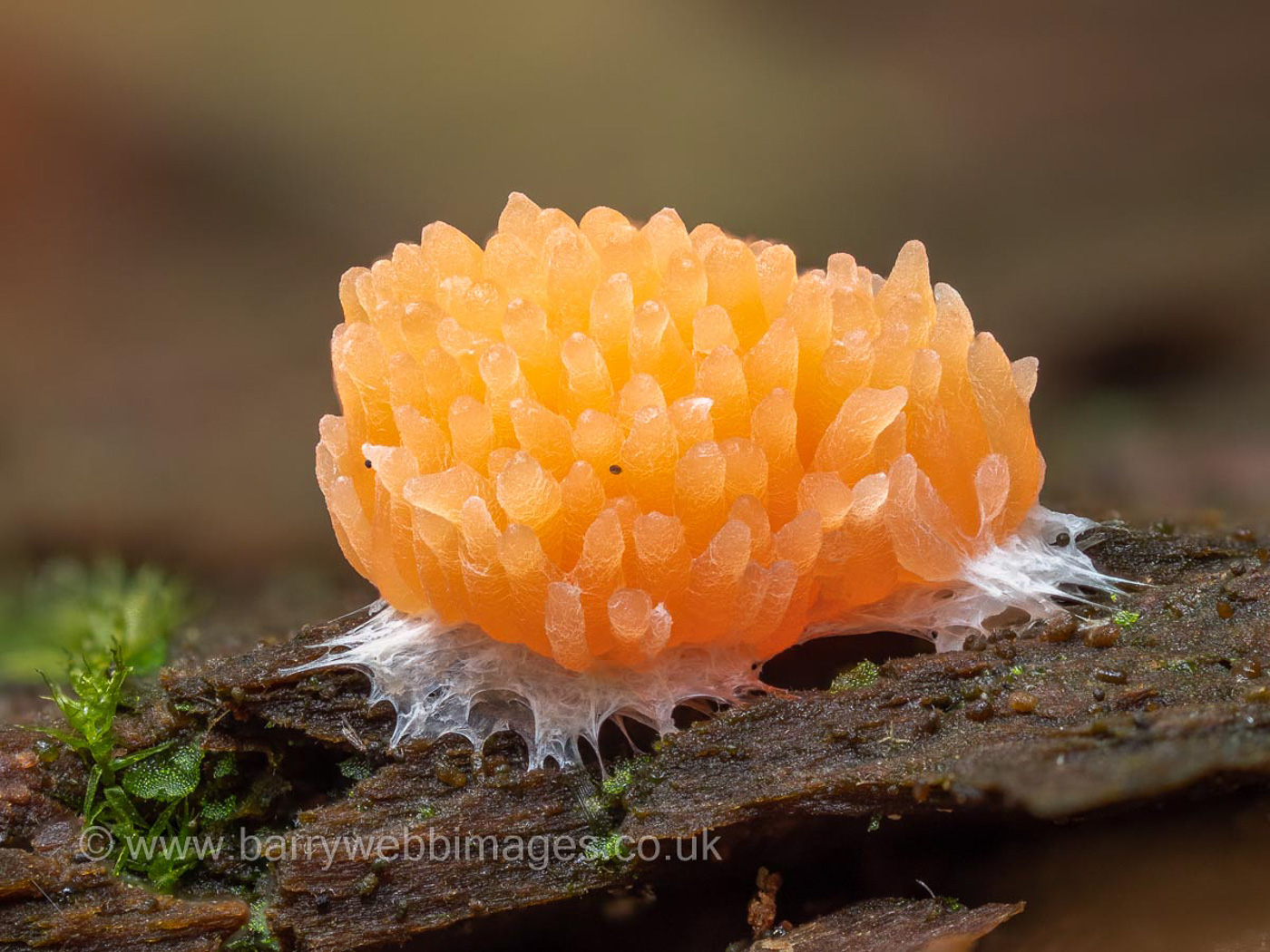 |
Tubifera ferruginosa (a Slime Mould with no common name)
Sep 13, 2021. In Ivinghoe Common on rotting fallen conifer Barry Webb found this brightly coloured little mound just beginning to develop from the 'red raspberry' mycelium stage when instantly recognisable. The vast majority of slime moulds have white mycelium (the slimy stage), this being one of very few to sport bright orange, peach, pink-red mycelium. Here it can be seen beginning to evolve the closely packed columns which turn brown when mature.
Sep 7, 2020. Barry found this very common species in Burnham Beeches on fallen Birch (07.09.2020) though it most commonly occurs on fallen Pine. It has possibly the brightest plasmodium of all slime moulds: coloured brilliant orange, apricot or pink and leaving little doubt as to species especially when found on Pine where no other slime mould is this colour. Photo 2 shows a patch rapidly maturing when it becomes dull brown and inconspicuous. Photo 3 is of a collection found at Ivinghoe Common, (13.09.2021) just beginning to form the tightly clustered columns which then turn brown.
|

